JWST (James Webb Space Telescope)
Non-EO
ESA
NASA
Operational (nominal)
Quick facts
Overview
| Mission type | Non-EO |
| Agency | ESA, NASA, CSA |
| Mission status | Operational (nominal) |
| Launch date | 25 Dec 2021 |
JWST (James Webb Space Telescope)
Concept Launch Mission Status Observatory Sensor Complement Spacecraft Bus and Sunshield Spinoff Technologies References
JWST is an orbiting optical observatory and a key element in NASA's Origins Program, optimized for observations in the infrared region of the electromagnetic spectrum. It is considered the successor mission of HST (Hubble Space Telescope) while operating over a different spectral range. At the NIR and MWIR wavelengths, it benefits from operating at intrinsically lower backgrounds than any comparably sized telescope on the ground. JWST, previously known as NGST (Next Generation Space Telescope), will be the premier space facility for astronomers in the decade following its launch. The overall objectives are to study the first stars and galaxies after the big bang. Major science goals (themes) of the mission are to find answers to the following questions: 1) 2)
• What is the shape of the Universe?
• How do galaxies evolve?
• How do stars and planetary systems form and interact?
• How did the Universe built up its present chemical/elemental composition?
• What is the nature of dark matter?
The radiation from the very distant objects to be observed is practically all in the infrared region. Many of the early events happened when the Universe was between 1 million and 1 billion years old, a period that is not known to earthlings (the dark ages of the Universe). To accomplish the goals of the science themes, the main JWST design requirement calls for the detection of objects up to 400 times fainter than those observable by current ground-based or spaceborne observatories.
Historical background: Large next-generation projects with high-performance observation requirements take about two decades (and more) from first studies to launch. Initial planning for the new mission started in 1989 (visions, conceptual studies). The goal was to have a successor mission for HST ready for launch well before 2010.
In the mid-1990s, a telescope design with an 8 m aperture was considered. The challenge was to come up with a lower cost for the large telescope than for previous much smaller space telescopes. This involved conceptual studies by industry. In 1996, a committee report was written, based on these studies: "Next Generation Space Telescope, Visiting a Time When Galaxies Were Young." This report established also a roadmap to NGST activities, defining the new building blocks and to search for enabling technologies and concepts - in particular in the fields of large-aperture lightweight mirrors that are actively controlled, of advanced detector designs, of suitable cooling techniques for all critical components, and of precision metrology to achieve the goal of measuring ultra precise stellar positions.
A broad range of talent on a national and international level and from many institutions, academia and industry was directly involved in the NGST detailed definition phase (Phase A) including simulations and feasibility studies. In 1997, an ad hoc Science Working Group was formed which came up with thematic science goals and developed a so-called "Design Reference Mission" (DRM), representing a hypothetical suite of key science observing programs [stating the expected physical properties (number density and brightness), the desired observation modes (wavelength band, spectral resolution, number of revisits), and a minimum operational life of 2.5 years to complete the mission] for NGST - which provided a yardstick for technology testing. DRM was and is the primary tool against which any JWST architectures are being measured. The shear complexity of the project and the performance requirements demanded a technology development and validation strategy to address and demonstrate a critical path to a workable design of the mission. 3) 4) 5) 6)
In 2000/1, the NGST project experienced a rescoping of the telescope size (from 8 m aperture to 6.5 m) to keep projected costs in bounds. There were also some technology maturity uncertainties.
The project started in 2002 with a Mission Definition Review. NASA began to realize that the critical technologies had reached a level of sufficient maturity to justify a go-ahead with the next phase of the project.
In September 2002, NASA renamed NGST to JWST (James Webb Space Telescope) in honor of James E. Webb (1906-1992), NASA's second administrator during the Apollo Program of the 1960s (1961-1968). At the same time in Sept. 2002, NASA awarded the prime contract of the JWST observatory development (spacecraft, telescope, integration and testing) to Northrop Grumman Space Technology (formerly TRW) of Redondo Beach, CA.
In the fall of 2003 ICR(Initial Confirmation Review) was given, starting the Phase B of the JWST project. The C/D Phase started in 2008.
The CDR (Critical Design Review) of the JWST (James Webb Space Telescope) is planned for December 2013 (Ref. 69).
Project partners: NASA leads an international partnership in the joint JWST mission that includes ESA (European Space Agency) and CSA (Canadian Space Agency). Both agencies (ESA, CSA) collaborated in the JWST project already at an early planning stage (1996). Aside from instrument contributions, ESA will also launch the JWST spacecraft on an Ariane 5 launcher as agreed to with NASA. NASA/GSFC is managing the JWST project, while STScI (Space Telescope Science Institute) of Baltimore, MD, is responsible for JWST science and mission operations, as well as ground station development (STScI is the same organization that is operating the Hubble Space Telescope). A formal JWST and LISA (Laser Interferometer Space Antenna) cooperation agreement between NASA and ESA was signed on June 18, 2007 at the International Paris Air Show at Le Bourget, France. 7) 8) 9) 10) 11)
A most interesting and valuable side effect of the technology development effort for JWST is that these new technologies will also be available to many other space projects (astronomy, space science, Earth observation, etc.) providing potentially a quantum step in observation performance.
Mission Concept
The JWST mission concept is an ambitious and most challenging development program, requiring a lot of innovative technology introduction as well as conceptual breakthroughs on various levels to meet the proposed observational performances. The objectives of the science themes can only be met by a combination of a large-aperture telescope in space (6.5 m φ ), a very low detection temperature to eliminate noise, and an ideal observing environment (elimination of stray light).
The observatory will be shielded from the sun and Earth by a large deployable sunshade, the entire telescope assembly will be passively cooled to about 37 K, giving JWST exceptional performance in the near-infrared and mid-infrared wavebands. The baseline wavelength range for the instrumentation is 0.6 - 28 µm, and the telescope will be diffraction-limited above 2 µm. The sensitivity of the telescope will be limited only by the natural zodiacal background, and should exceed that of ground-based and other space-based observatories by factors of 10 to 100,000, depending on the wavelength and type of observation. The JWST observatory will have a 5 year design life (with a goal of 10 years of operations) and will not be serviceable by astronauts (as is Hubble). The total mass of JWST at launch is estimated to be 6,500 kg.
Like Hubble, the JWST will be used by a broad astronomical community to observe targets ranging from objects within our Solar System to the most remote galaxies seen during their formation in the early universe.
Major enabling technologies are:
• Large deployable and lightweight beryllium mirrors (a folding 6.5 meter mirror made up of 18 individual segments, adjustable by cryogenic actuators). To fit inside the launch vehicle, the large space telescope prime mirror must be folded in sections for launch, then unfolded (deployed) precisely into place after launch, making it the first segmented optical system deployed in space.
• Deployment of large structures. Once in space, the multilayer sunshield that was folded over the optics during launch will deploy to its full size and keep the telescope shadowed from the sun.
• Introduction of MEMS technology to the microshutter system of the NIRSpec instrument. The programmable microshutters to allow object selection for the spectrograph.
Overview of Payload Instruments
• NIRCam (Near-Infrared Camera), funded by NASA with the University of Arizona as prime contractor. CSA is participating in the development of the NIRCam instrument.
• NIRSpec (Near-Infrared multi-object Spectrograph), funded by ESA with EADS Astrium GmbH as prime contractor (the detector arrays and a micro-shutter are supplied by NASA/GSFC)
• MIRI (Mid-Infrared Camera-Spectrograph) a joint instrument of JPL and ESA. The instrument (about 50%) is being provided by ESA member states, coordinated but not funded by ESA.
• FGS (Fine Guidance Sensor) with TFI (Tunable Filter Imager), funded by CSA (Canadian Space Agency)
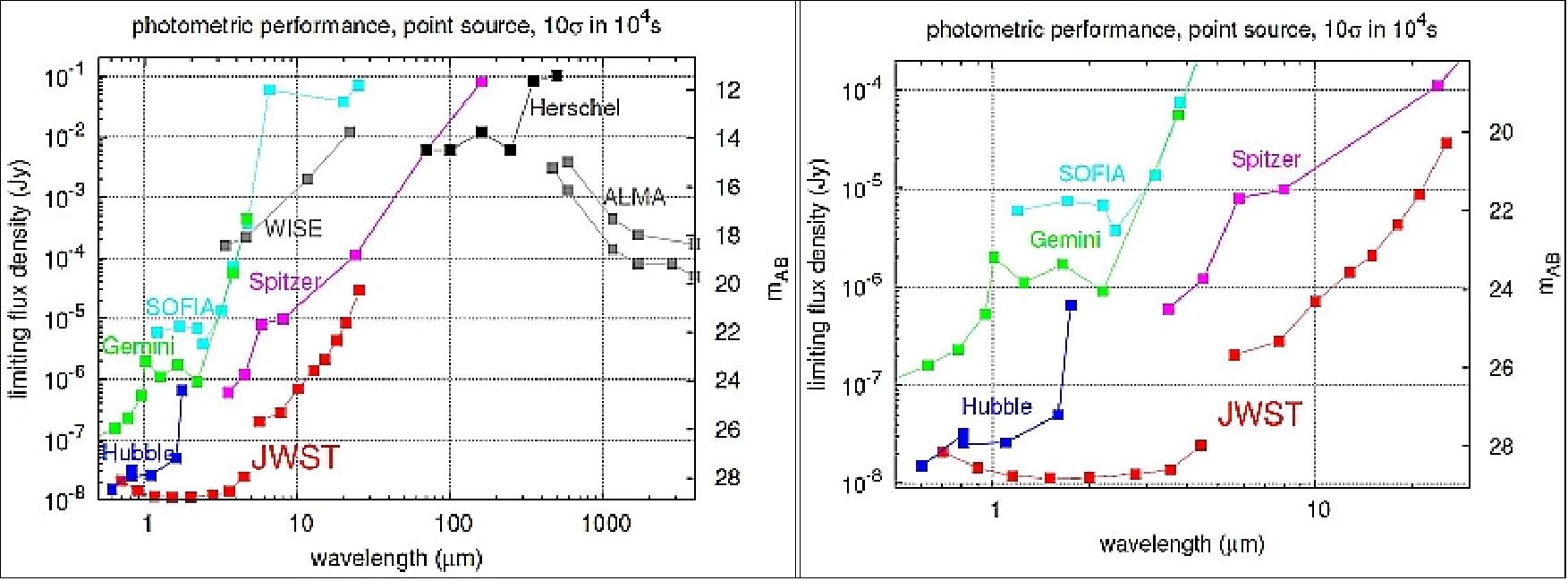
Legend to Figure 1: Plotted is the faintest flux for a point source that can be detected at 10 sigma in a 104 s integration. The fluxes are given in Janskies as well as AB magnitudes. 12)
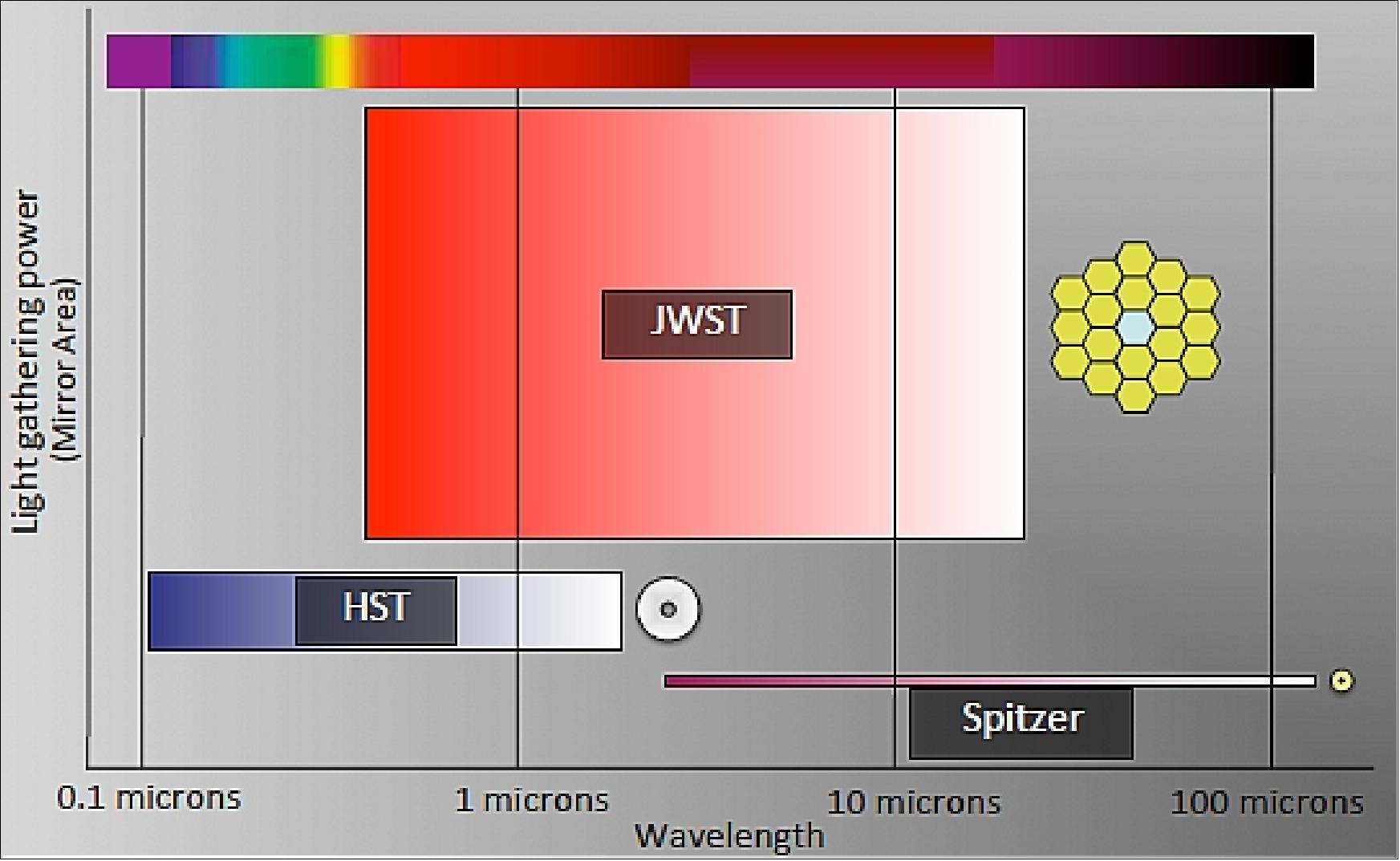
Launch
On Saturday, December 25 (Christmas), 2021 at 9:20 am local time (12:20 UTC), an Ariane 5 rocket lifted off from the Guiana Space Center, Europe's Spaceport in Kourou, French Guiana (South America), injecting the Webb Space Telescope, developed by NASA in partnership with ESA and the Canadian Space Agency (CSA), into its transfer orbit. The telescope was successfully separated from the launcher 27 minutes after liftoff. 14) 15)
The telescope now embarks on a voyage lasting 29 days to reach the second Lagrange point.
• On the third day, the heat shield will begin to deploy. On the eleventh day, the secondary mirror will begin positioning.
• Between the 13th and 14th day, the primary mirror, comprising 18 hexagonal segments and measuring 6.5 meters in diameter, will be assembled.
• The telescope is slated to arrive at its final destination, 1.5 million kilometers from Earth, approximately 29 days after launch.
The space agencies of the United States (NASA), Europe (ESA) and Canada (CSA) teamed up to develop this telescope. Europe played an important role in this mission, with ESA providing the launch onboard Ariane 5, as well as the Nirspec spectrometer built by Airbus. The astrophysics department of the Saclay-based CEA (French Alternative Energies and Atomic Energy Commission) and the Paris Observatory designed the MIRI camera. This is the most ambitious telescope ever sent into space.
"Today's launch is the mission of the decade," said Stephane Israël, Chief Executive Officer of Arianespace, "one that demonstrates the reliability of Arianespace's launch services in the eyes of the international space community. It's a great honor for us to have been chosen for this launch, which will enable humanity to take a giant step forward in its knowledge of the Universe. The mission demanded 20 years of preparation hand in hand with NASA. It's the third launch we have performed for the American space agency, clearly illustrating the advantage of large-scale international collaboration in space. I would like to thank ESA, NASA and CSA for entrusting us with their invaluable payload. To launch on Christmas morning 42 years after the takeoff of the first Ariane from this same Kourou site ... What a great end of year present for the space community gathered today for this launch.
NASA: A joint effort with ESA (European Space Agency) and the Canadian Space Agency, the Webb observatory is NASA's revolutionary flagship mission to seek the light from the first galaxies in the early universe and to explore our own solar system, as well as planets orbiting other stars, called exoplanets. 16)
"The James Webb Space Telescope represents the ambition that NASA and our partners maintain to propel us forward into the future," said NASA Administrator Bill Nelson. "The promise of Webb is not what we know we will discover; it's what we don't yet understand or can't yet fathom about our universe. I can't wait to see what it uncovers!"
Ground teams began receiving telemetry data from Webb about five minutes after launch. The Arianespace Ariane 5 rocket performed as expected, separating from the observatory 27 minutes into the flight. The observatory was released at an altitude of approximately 870 miles (1,400 km). Approximately 30 minutes after launch, Webb unfolded its solar array, and mission managers confirmed that the solar array was providing power to the observatory. After solar array deployment, mission operators will establish a communications link with the observatory via the Malindi ground station in Kenya, and ground control at the Space Telescope Science Institute in Baltimore will send the first commands to the spacecraft.
Engineers and ground controllers will conduct the first of three mid-course correction burns about 12 hours and 30 minutes after launch, firing Webb's thrusters to maneuver the spacecraft on an optimal trajectory toward its destination in orbit about 1 million miles from Earth.
"I want to congratulate the team on this incredible achievement – Webb's launch marks a significant moment not only for NASA, but for thousands of people worldwide who dedicated their time and talent to this mission over the years," said Thomas Zurbuchen, associate administrator for the Science Mission Directorate at NASA Headquarters in Washington. "Webb's scientific promise is now closer than it ever has been. We are poised on the edge of a truly exciting time of discovery, of things we've never before seen or imagined."
The world's largest and most complex space science observatory will now begin six months of commissioning in space. At the end of commissioning, Webb will deliver its first images. Webb carries four state-of-the-art science instruments with highly sensitive infrared detectors of unprecedented resolution. Webb will study infrared light from celestial objects with much greater clarity than ever before. The premier mission is the scientific successor to NASA's iconic Hubble and Spitzer space telescopes, built to complement and further the scientific discoveries of these and other missions.
"The launch of the Webb Space Telescope is a pivotal moment – this is just the beginning for the Webb mission," said Gregory L. Robinson, Webb's program director at NASA Headquarters. "Now we will watch Webb's highly anticipated and critical 29 days on the edge. When the spacecraft unfurls in space, Webb will undergo the most difficult and complex deployment sequence ever attempted in space. Once commissioning is complete, we will see awe-inspiring images that will capture our imagination."
The telescope's revolutionary technology will explore every phase of cosmic history – from within our solar system to the most distant observable galaxies in the early universe, to everything in between. Webb will reveal new and unexpected discoveries and help humanity understand the origins of the universe and our place in it.
NASA Headquarters oversees the mission for the agency's Science Mission Directorate. NASA's Goddard Space Flight Center in Greenbelt, Maryland, manages Webb for the agency and oversees work on the mission performed by the Space Telescope Science Institute, Northrop Grumman, and other mission partners. In addition to Goddard, several NASA centers contributed to the project, including the agency's Johnson Space Center in Houston, Jet Propulsion Laboratory in Southern California, Marshall Space Flight Center in Huntsville, Alabama, Ames Research Center in California's Silicon Valley, and others.
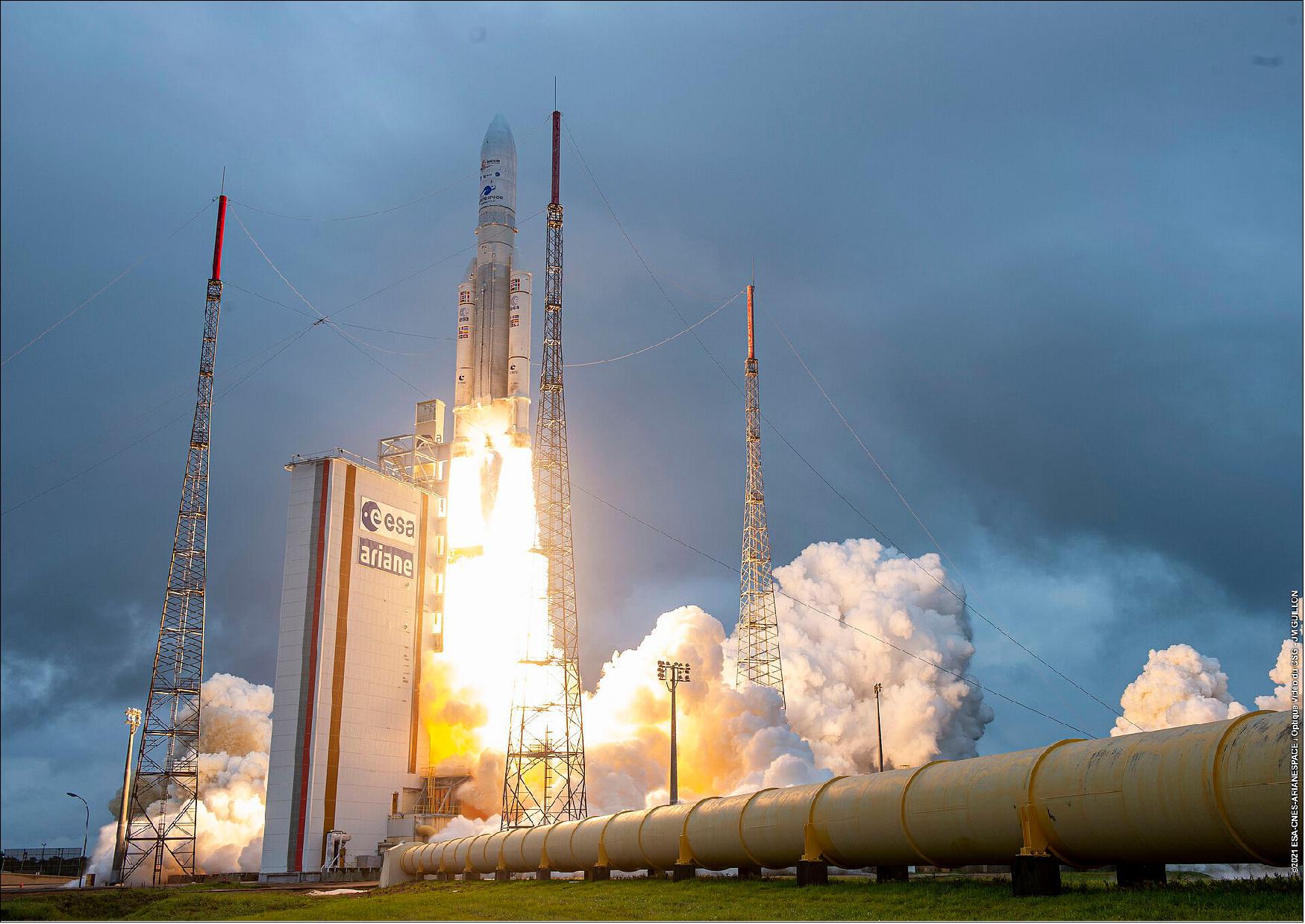
Orbit
The orbit of JWST has been selected to be at L2. The spacecraft will be in a Lissajous (or halo) orbit about the Lagrangian point L2. In the Sun‐Earth system the L2 point is on the rotating Sun-Earth axis about the same distance away as L1 (1.5 million km, representing 1/100 the distance from Earth to the Sun) but at the opposite side of the Earth. The L1 location is inside the Earth orbit while the L2 location is outside the Earth orbit.
The halo orbit of JWST is in a plane slightly out of the ecliptic plane. This orbit avoids Earth and moon eclipses of the sun. The halo orbit period is about 6 months. Nominal station keeping maneuvers will be performed every half orbit (i.e. in intervals of about 3 months).
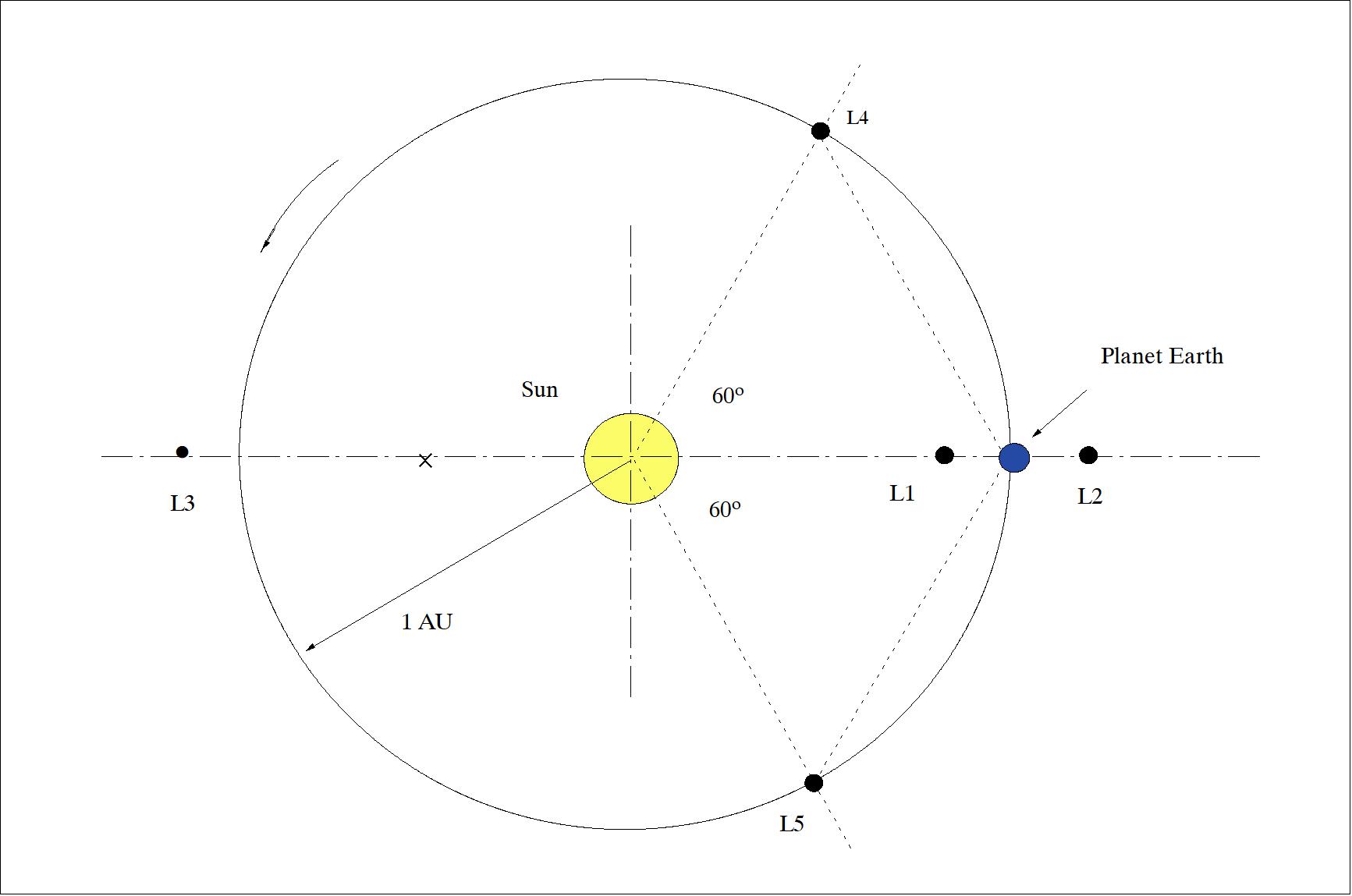
The L2 location is considered to offer the most advantageous viewing for astronomical targets (looking toward the universe) due to nearly constant lighting conditions (minimum of stray light). Another advantage of the L2 location is that it offers a stable thermal environment. The telescope is kept in perpetual shadow by looking into the deep space direction. The deep space provides a 2.7 K black body radiation. This ideal heat sink is being used to provide the passive cooling for the payload to a temperature range of about 37 K, shielded from sunlight (entering the spacecraft from the opposite direction) by a five-layer sunshield [passive cooling is the most elegant and economical method available to obtain the required operating temperatures for infrared detection].
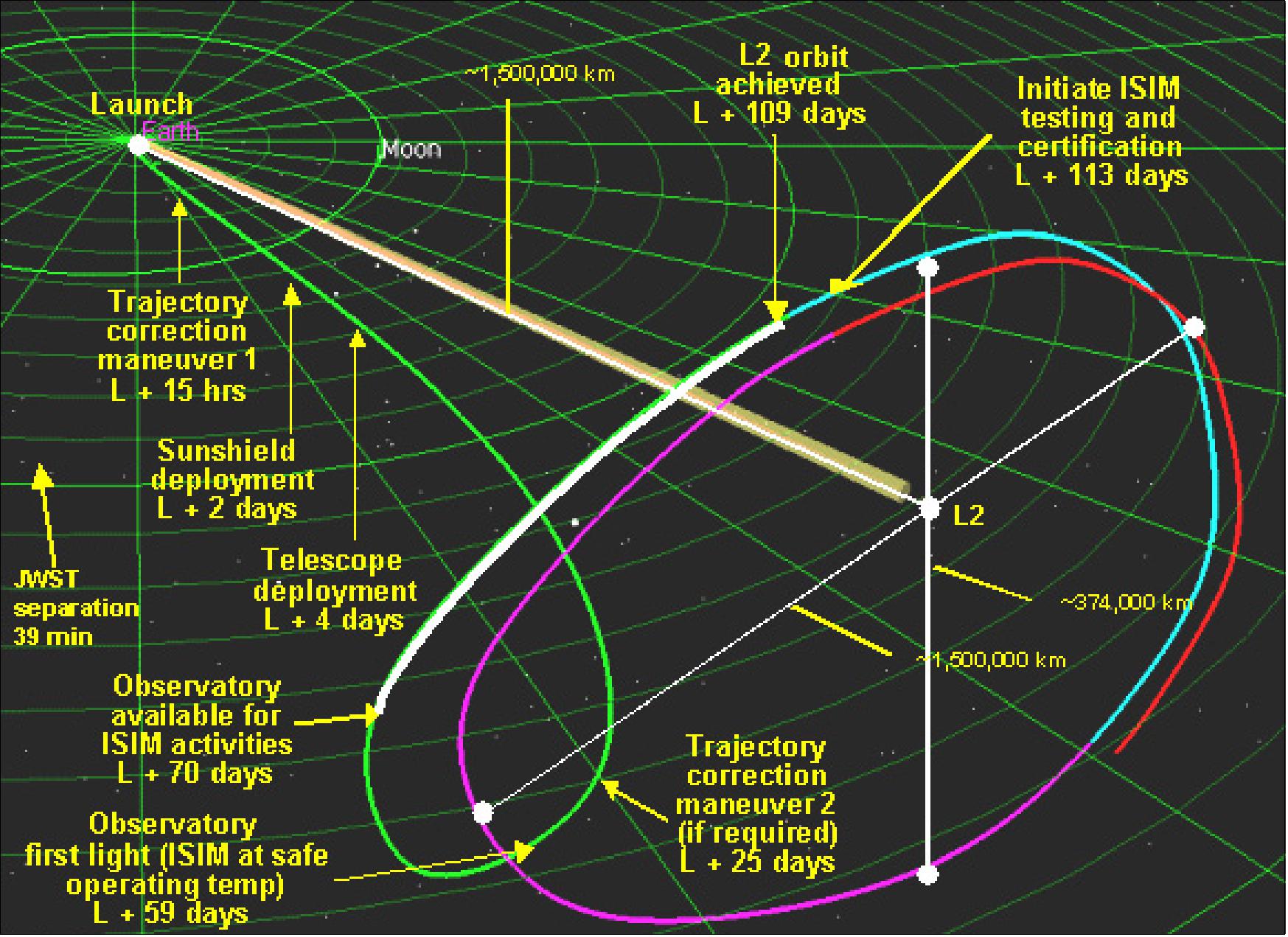
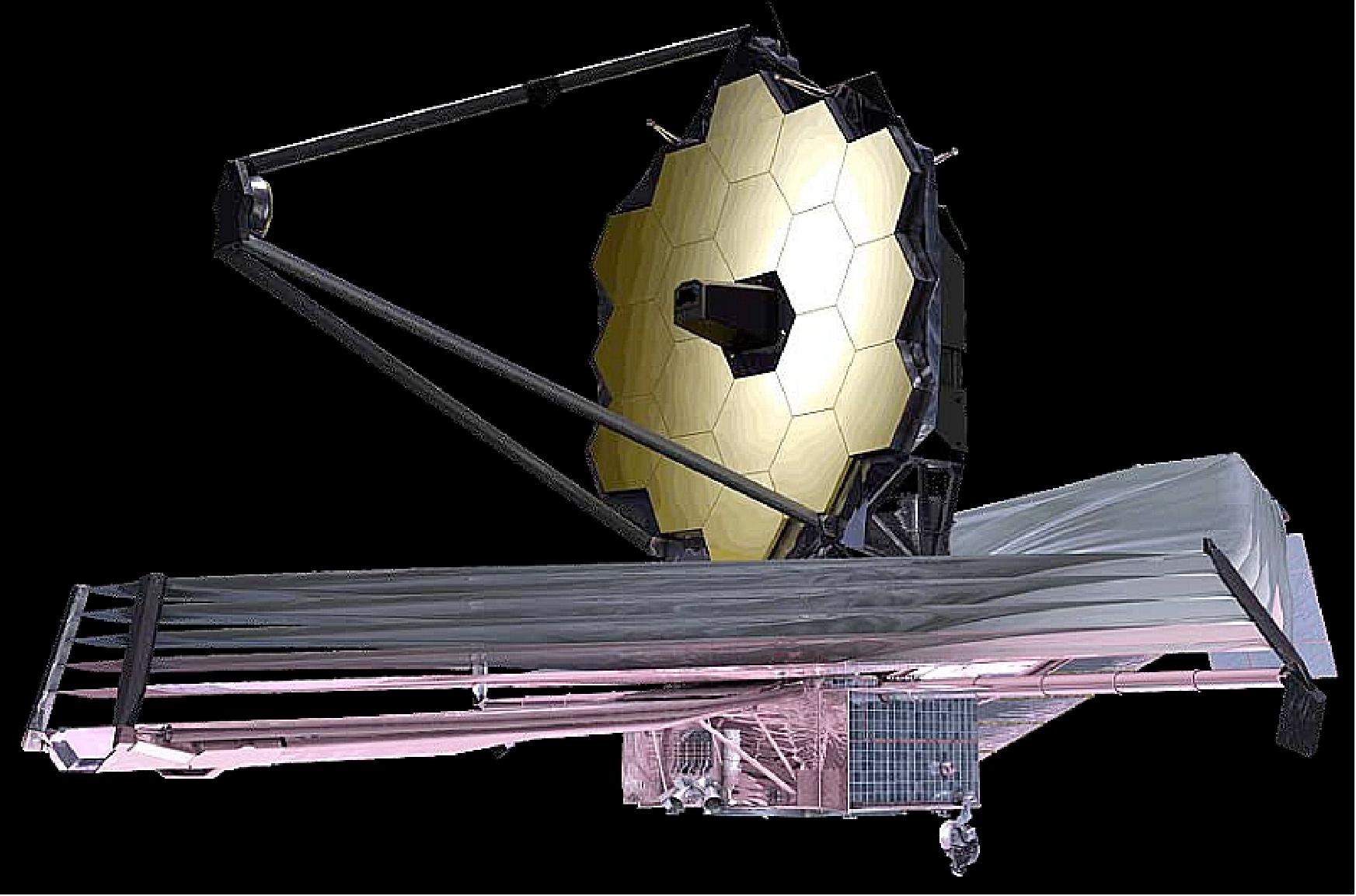
JWST Deployment Sequence
During the transfer orbit to L2 different elements of the JWST will be deployed and commissioning will start. The observatory has five deployment stages involving the following elements: 18)
1) Deployment of spacecraft appendages (solar arrays, high gain antenna)
2) Deployment of the sunshield (unfolding 2 days after launch)
3) Extension of the tower
4) Deployment of the secondary mirror (positioned on a tripod structure)
5) Deployment of the primary mirror wings
The deployment of the solar arrays and the high gain antenna is scheduled for the first day to provide the capabilities of onboard power generation and a spacecraft communications link. The unfolding of the sunshield will occur two days after launch, while the timeline for secondary and primary mirror deployment is foreseen after four days. "First light" will occur about 28 days after launch, initiating wavefront sensing and control activities to align the mirror segments. Instrument checkout will start 37 days after launch, well before the final L2 orbit insertion is obtained after 106 days. This is being followed by full commissioning procedures expected to last until about 6 months after launch. 19)

JWST Mission Status
• July 12, 2022: The dawn of a new era in astronomy is here as the world gets its first look at the full capabilities of NASA's James Webb Space Telescope, a partnership with ESA (European Space Agency) and CSA (Canadian Space Agency). 20) 21)
- "Today, we present humanity with a groundbreaking new view of the cosmos from the James Webb Space Telescope – a view the world has never seen before," said NASA Administrator Bill Nelson. "These images, including the deepest infrared view of our universe that has ever been taken, show us how Webb will help to uncover the answers to questions we don't even yet know to ask; questions that will help us better understand our universe and humanity's place within it.
- "The Webb team's incredible success is a reflection of what NASA does best. We take dreams and turn them into reality for the benefit of humanity. I can't wait to see the discoveries that we uncover – the team is just getting started!"
- NASA explores the unknown in space for the benefit of all, and Webb's first observations tell the story of the hidden universe through every phase of cosmic history – from neighboring planets outside our solar system, known as exoplanets, to the most distant observable galaxies in the early universe.
- "This is a singular and historic moment," said Thomas Zurbuchen, associate administrator for NASA's Science Mission Directorate. "It took decades of drive and perseverance to get us here, and I am immensely proud of the Webb team. These first images show us how much we can accomplish when we come together behind a shared goal, to solve the cosmic mysteries that connect us all. It's a stunning glimpse of the insights yet to come."
- "This is a singular and historic moment," said Thomas Zurbuchen, associate administrator for NASA's Science Mission Directorate. "It took decades of drive and perseverance to get us here, and I am immensely proud of the Webb team. These first images show us how much we can accomplish when we come together behind a shared goal, to solve the cosmic mysteries that connect us all. It's a stunning glimpse of the insights yet to come."
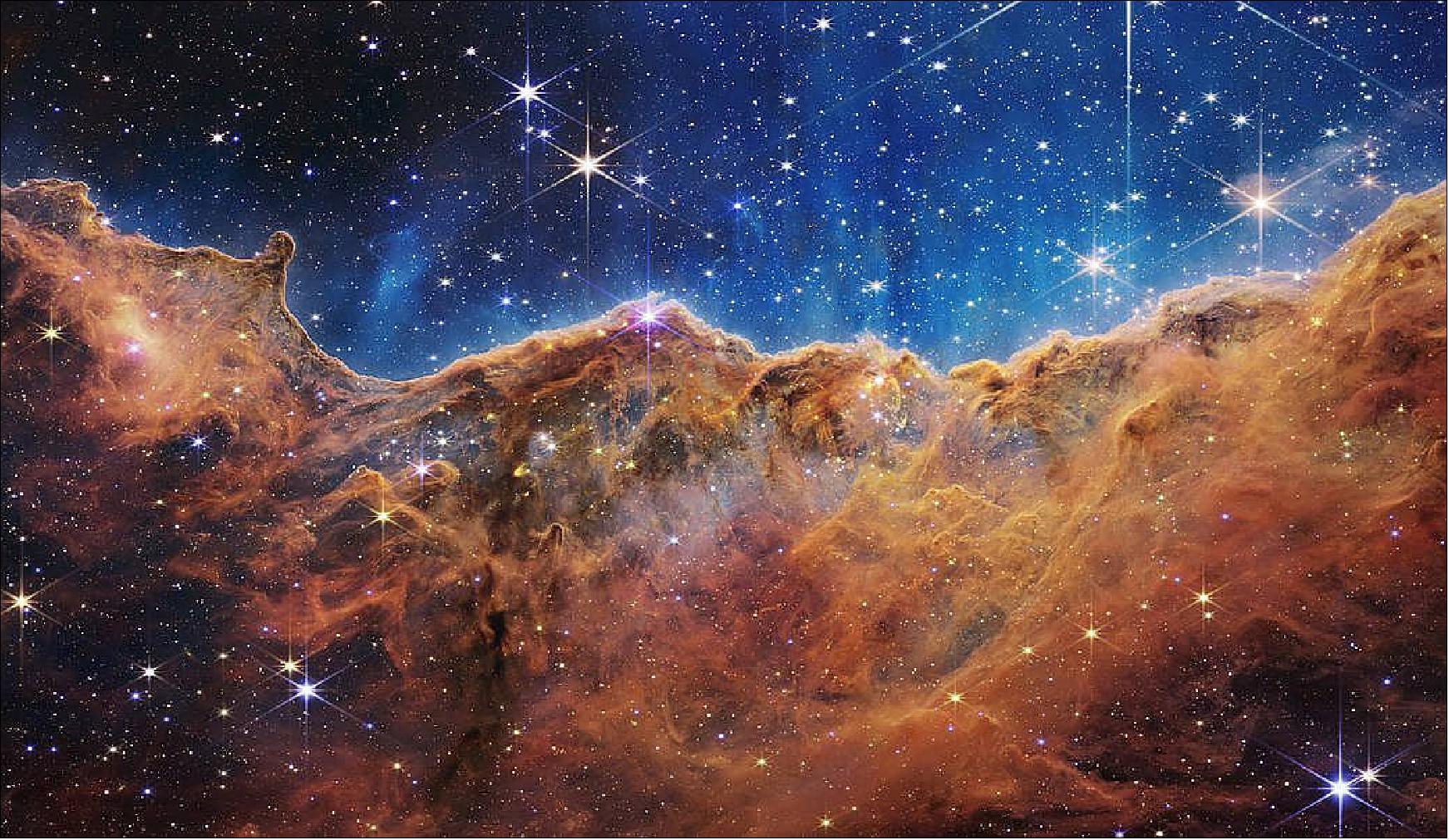
Image description continued
- Called the Cosmic Cliffs, Webb's seemingly three-dimensional picture looks like craggy mountains on a moonlit evening. In reality, it is the edge of the giant, gaseous cavity within NGC 3324, and the tallest "peaks" in this image are about 7 light-years high. The cavernous area has been carved from the nebula by the intense ultraviolet radiation and stellar winds from extremely massive, hot, young stars located in the center of the bubble, above the area shown in this image.
- The blistering, ultraviolet radiation from the young stars is sculpting the nebula's wall by slowly eroding it away. Dramatic pillars tower above the glowing wall of gas, resisting this radiation. The "steam" that appears to rise from the celestial "mountains" is actually hot, ionized gas and hot dust streaming away from the nebula due to the relentless radiation.
- Webb reveals emerging stellar nurseries and individual stars that are completely hidden in visible-light pictures. Because of Webb's sensitivity to infrared light, it can peer through cosmic dust to see these objects. Protostellar jets, which emerge clearly in this image, shoot out from some of these young stars. The youngest sources appear as red dots in the dark, dusty region of the cloud. Objects in the earliest, rapid phases of star formation are difficult to capture, but Webb's extreme sensitivity, spatial resolution, and imaging capability can chronicle these elusive events.
- These observations of NGC 3324 will shed light on the process of star formation. Star birth propagates over time, triggered by the expansion of the eroding cavity. As the bright, ionized rim moves into the nebula, it slowly pushes into the gas and dust. If the rim encounters any unstable material, the increased pressure will trigger the material to collapse and form new stars.
- Conversely, this type of disturbance may also prevent star formation as the star-making material is eroded away. This is a very delicate balance between sparking star formation and stopping it. Webb will address some of the great, open questions of modern astrophysics: What determines the number of stars that form in a certain region? Why do stars form with a certain mass?
- Webb will also reveal the impact of star formation on the evolution of gigantic clouds of gas and dust. While the effect of massive stars – with their violent winds and high energy – is often apparent, less is known about the influence of the more numerous low-mass stars. As they form, these smaller stars create narrow, opposing jets seen here, which can inject a lot of momentum and energy into the clouds. This reduces the fraction of nebular material that seeds new stars.
- Up to this point, scientists have had very little data about the influence of the multitude of young and more energetic low-mass stars. With Webb, they will be able to obtain a full census of their number and impact throughout the nebula.
- Located roughly 7,600 light-years away, NGC 3324 was imaged by Webb's Near-Infrared Camera (NIRCam) and Mid-Infrared Instrument (MIRI).
- NIRCam – with its crisp resolution and unparalleled sensitivity – unveils hundreds of previously hidden stars, and even numerous background galaxies.
- In MIRI's view, young stars and their dusty, planet-forming disks shine brightly in the mid-infrared, appearing pink and red. MIRI reveals structures that are embedded in the dust and uncovers the stellar sources of massive jets and outflows. With MIRI, the hot dust, hydrocarbons, and other chemical compounds on the surface of the ridges glow, giving the appearance of jagged rocks.
- NGC 3324 was first catalogued by James Dunlop in 1826. Visible from the Southern Hemisphere, it is located at the northwest corner of the Carina Nebula (NGC 3372), which resides in the constellation Carina. The Carina Nebula is home to the Keyhole Nebula and the active, unstable supergiant star called Eta Carinae.
• July 12, 2022: NASA's James Webb Space Telescope has cast the Southern Ring Nebula in an entirely new light. By observing the nebula in mid-infrared wavelengths, Webb has unveiled the second, dusty star at the center of the nebula in far more detail. The star closely orbits its companion as it periodically ejects layers of gas and dust. Together, the swirling duo have created a fantastic landscape of asymmetrical shells. Webb's near-infrared light image hones in on "spotlights" from the stars, where light travels through holes in the nebula's dusty ejections. 22) 23)
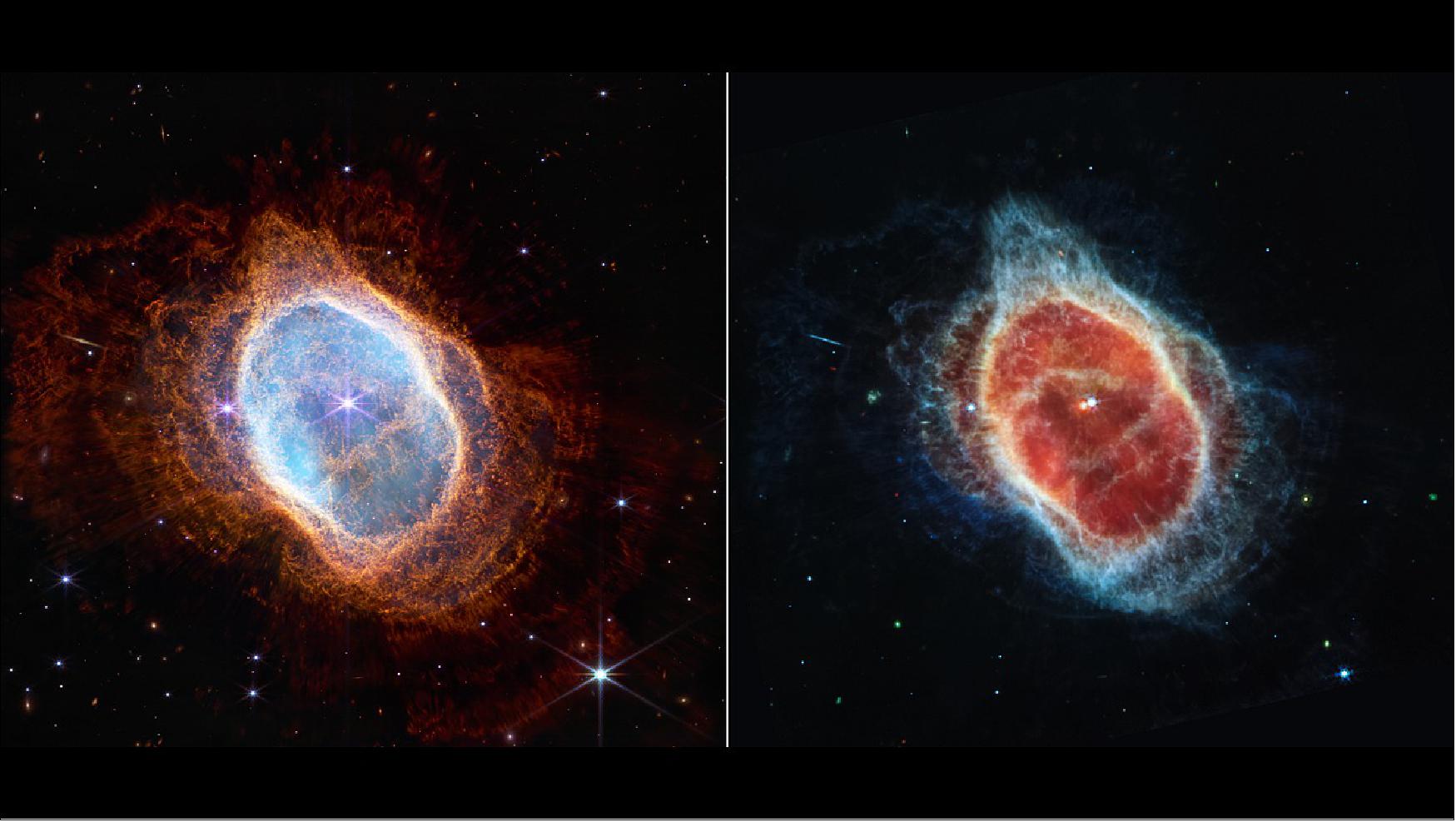
Some stars save the best for last.
- The dimmer star at the center of this scene has been sending out rings of gas and dust for thousands of years in all directions, and NASA's James Webb Space Telescope has revealed for the first time that this star is cloaked in dust.
- Two cameras aboard Webb captured the latest image of this planetary nebula, cataloged as NGC 3132, and known informally as the Southern Ring Nebula. It is approximately 2,500 light-years away.
- Webb will allow astronomers to dig into many more specifics about planetary nebulae like this one – clouds of gas and dust expelled by dying stars. Understanding which molecules are present, and where they lie throughout the shells of gas and dust will help researchers refine their knowledge of these objects.
- This observation shows the Southern Ring Nebula almost face-on, but if we could rotate it to view it edge-on, its three-dimensional shape would more clearly look like two bowls placed together at the bottom, opening away from one another with a large hole at the center.
- Two stars, which are locked in a tight orbit, shape the local landscape. Webb's infrared images feature new details in this complex system. The stars – and their layers of light – are prominent in the image from Webb's Near-Infrared Camera (NIRCam) on the left, while the image from Webb's Mid-Infrared Instrument (MIRI) on the right shows for the first time that the second star is surrounded by dust. The brighter star is in an earlier stage of its stellar evolution and will probably eject its own planetary nebula in the future.
- In the meantime, the brighter star influences the nebula's appearance. As the pair continues to orbit one another, they "stir the pot" of gas and dust, causing asymmetrical patterns.
- Each shell represents an episode where the fainter star lost some of its mass. The widest shells of gas toward the outer areas of the image were ejected earlier. Those closest to the star are the most recent. Tracing these ejections allows researchers to look into the history of the system.
- Observations taken with NIRCam also reveal extremely fine rays of light around the planetary nebula. Starlight from the central stars streams out where there are holes in the gas and dust – like sunlight through gaps in a cloud.
- Since planetary nebulae exist for tens of thousands of years, observing the nebula is like watching a movie in exceptionally slow motion. Each shell the star puffed off gives researchers the ability to precisely measure the gas and dust that are present within it.
- As the star ejects shells of material, dust and molecules form within them – changing the landscape even as the star continues to expel material. This dust will eventually enrich the areas around it, expanding into what's known as the interstellar medium. And since it's very long-lived, the dust may end up traveling through space for billions of years and become incorporated into a new star or planet.
- In thousands of years, these delicate layers of gas and dust will dissipate into surrounding space.
- NASA Headquarters oversees the mission for the agency's Science Mission Directorate. NASA's Goddard Space Flight Center in Greenbelt, Maryland, manages Webb for the agency and oversees work on the mission performed by the Space Telescope Science Institute, Northrop Grumman, and other mission partners. In addition to Goddard, several NASA centers contributed to the project, including the agency's Johnson Space Center in Houston, Jet Propulsion Laboratory in Southern California, Marshall Space Flight Center in Huntsville, Alabama, Ames Research Center in California's Silicon Valley, and others.
- NIRCam was built by a team at the University of Arizona and Lockheed Martin's Advanced Technology Center.
- MIRI was contributed by ESA and NASA, with the instrument designed and built by a consortium of nationally funded European Institutes (The MIRI European Consortium) in partnership with JPL and the University of Arizona.
• On Monday, 11 July 2022, President Joe Biden released one of the James Webb Space Telescope's first images in a preview event at the White House in Washington. NASA, in partnership with ESA (European Space Agency) and CSA (Canadian Space Agency), will release the full set of Webb's first full-color images and spectroscopic data during a televised broadcast beginning at 10:30 a.m. EDT (14:30 UTC) on Tuesday, July 12, from NASA's Goddard Space Flight Center in Greenbelt, Maryland. 24) 25)
- This first image from NASA's James Webb Space Telescope is the deepest and sharpest infrared image of the distant universe to date. Known as Webb's First Deep Field, this image of galaxy cluster SMACS 0723 is overflowing with detail. Thousands of galaxies – including the faintest objects ever observed in the infrared – have appeared in Webb's view for the first time. This slice of the vast universe covers a patch of sky approximately the size of a grain of sand held at arm's length by someone on the ground.
- This deep field, taken by Webb's Near-Infrared Camera (NIRCam), is a composite made from images at different wavelengths, totaling 12.5 hours – achieving depths at infrared wavelengths beyond the Hubble Space Telescope's deepest fields, which took weeks.
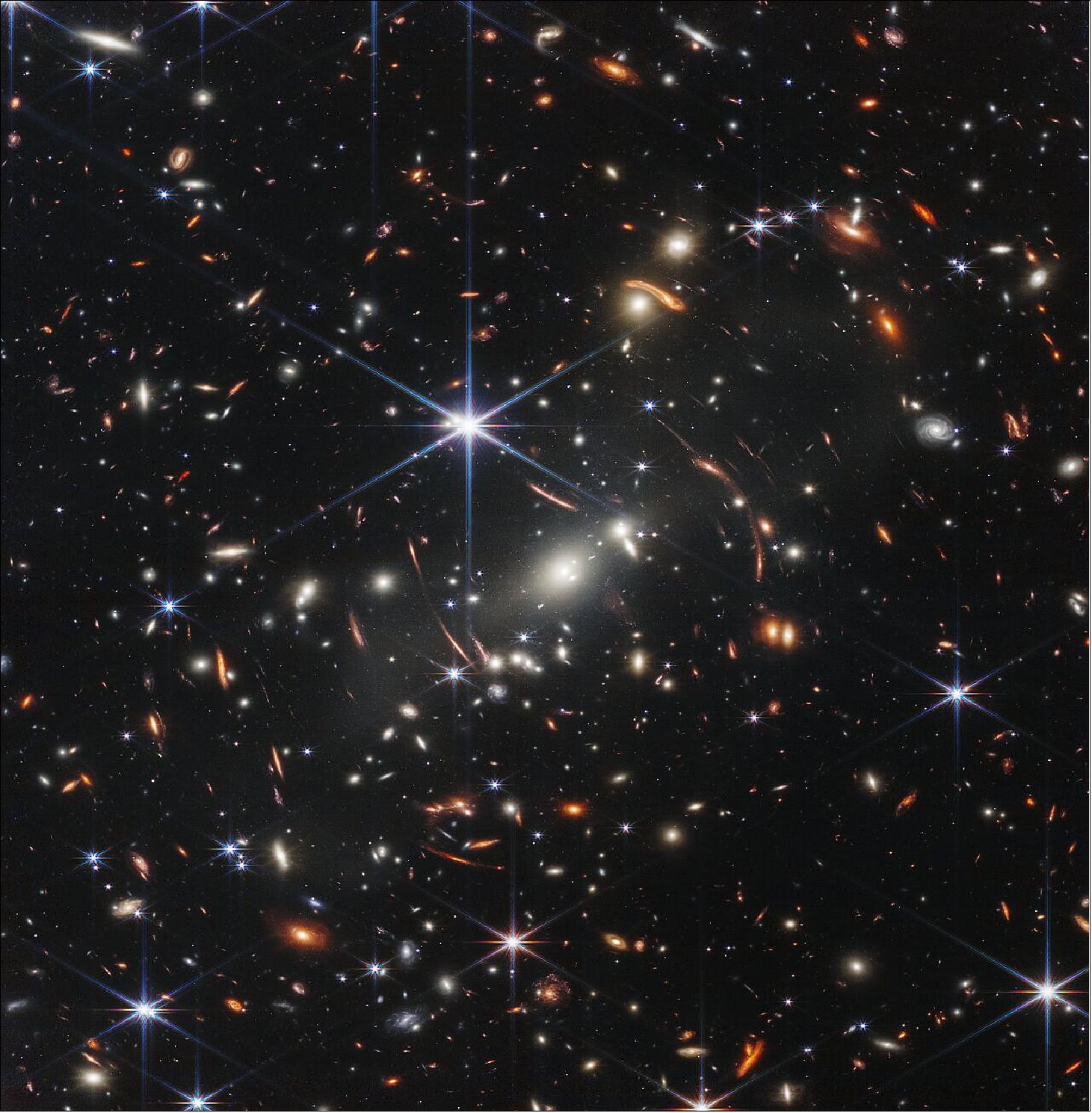
• July 12, 2022: Stephan's Quintet, a visual grouping of five galaxies, is best known for being prominently featured in the holiday classic film, "It's a Wonderful Life." Today, NASA's James Webb Space Telescope reveals Stephan's Quintet in a new light. This enormous mosaic is Webb's largest image to date, covering about one-fifth of the Moon's diameter. It contains over 150 million pixels and is constructed from almost 1,000 separate image files. The information from Webb provides new insights into how galactic interactions may have driven galaxy evolution in the early universe. 26) 27)
- With its powerful, infrared vision and extremely high spatial resolution, Webb shows never-before-seen details in this galaxy group. Sparkling clusters of millions of young stars and starburst regions of fresh star birth grace the image. Sweeping tails of gas, dust and stars are being pulled from several of the galaxies due to gravitational interactions. Most dramatically, Webb captures huge shock waves as one of the galaxies, NGC 7318B, smashes through the cluster.
- Together, the five galaxies of Stephan's Quintet are also known as the Hickson Compact Group 92 (HCG 92). Although called a "quintet," only four of the galaxies are truly close together and caught up in a cosmic dance. The fifth and leftmost galaxy, called NGC 7320, is well in the foreground compared with the other four. NGC 7320 resides 40 million light-years from Earth, while the other four galaxies (NGC 7317, NGC 7318A, NGC 7318B, and NGC 7319) are about 290 million light-years away. This is still fairly close in cosmic terms, compared with more distant galaxies billions of light-years away. Studying such relatively nearby galaxies like these helps scientists better understand structures seen in a much more distant universe.
- This proximity provides astronomers a ringside seat for witnessing the merging and interactions between galaxies that are so crucial to all of galaxy evolution. Rarely do scientists see in so much detail how interacting galaxies trigger star formation in each other, and how the gas in these galaxies is being disturbed. Stephan's Quintet is a fantastic "laboratory" for studying these processes fundamental to all galaxies.
- Tight groups like this may have been more common in the early universe when their superheated, infalling material may have fueled very energetic black holes called quasars. Even today, the topmost galaxy in the group – NGC 7319 – harbors an active galactic nucleus, a supermassive black hole 24 million times the mass of the Sun. It is actively pulling in material and puts out light energy equivalent to 40 billion Suns.
- Webb studied the active galactic nucleus in great detail with the Near-Infrared Spectrograph (NIRSpec) and Mid-Infrared Instrument (MIRI). These instruments' integral field units (IFUs) – which are a combination of a camera and spectrograph – provided the Webb team with a "data cube," or collection of images of the galactic core's spectral features.
- Much like medical magnetic resonance imaging (MRI), the IFUs allow scientists to "slice and dice" the information into many images for detailed study. Webb pierced through the shroud of dust surrounding the nucleus to reveal hot gas near the active black hole and measure the velocity of bright outflows. The telescope saw these outflows driven by the black hole in a level of detail never seen before.
- In NGC 7320, the leftmost and closest galaxy in the visual grouping, Webb was able to resolve individual stars and even the galaxy's bright core.
- As a bonus, Webb revealed a vast sea of thousands of distant background galaxies reminiscent of Hubble's Deep Fields.
- Combined with the most detailed infrared image ever of Stephan's Quintet from MIRI and the Near-Infrared Camera (NIRCam), the data from Webb will provide a bounty of valuable, new information. For example, it will help scientists understand the rate at which supermassive black holes feed and grow. Webb also sees star-forming regions much more directly, and it is able to examine emission from the dust – a level of detail impossible to obtain until now.
- Located in the constellation Pegasus, Stephan's Quintet was discovered by the French astronomer Édouard Stephan in 1877.
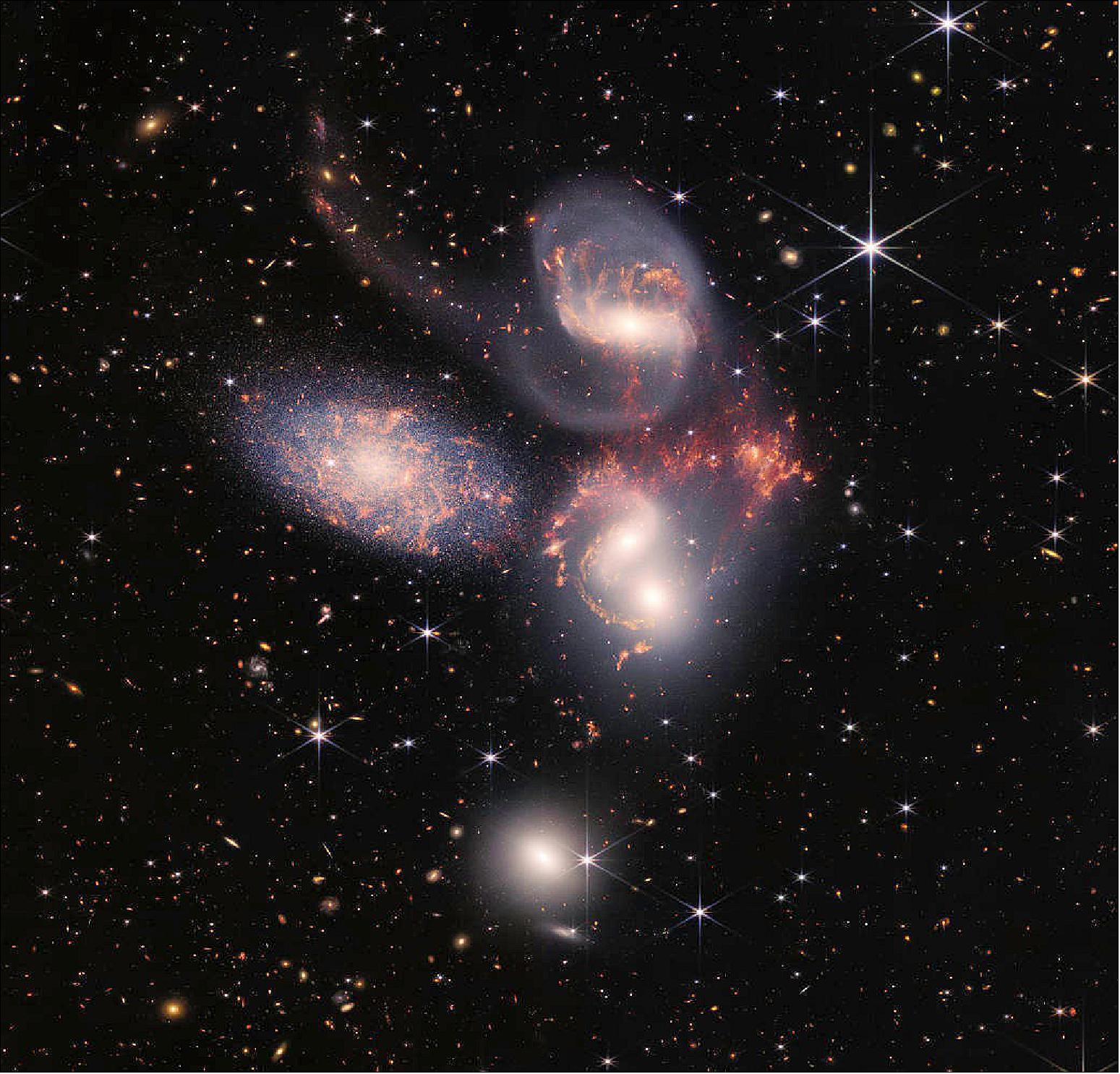
• July 12, 2022: NASA's James Webb Space Telescope has captured the distinct signature of water, along with evidence for clouds and haze, in the atmosphere surrounding a hot, puffy gas giant planet orbiting a distant Sun-like star. 28) 29)
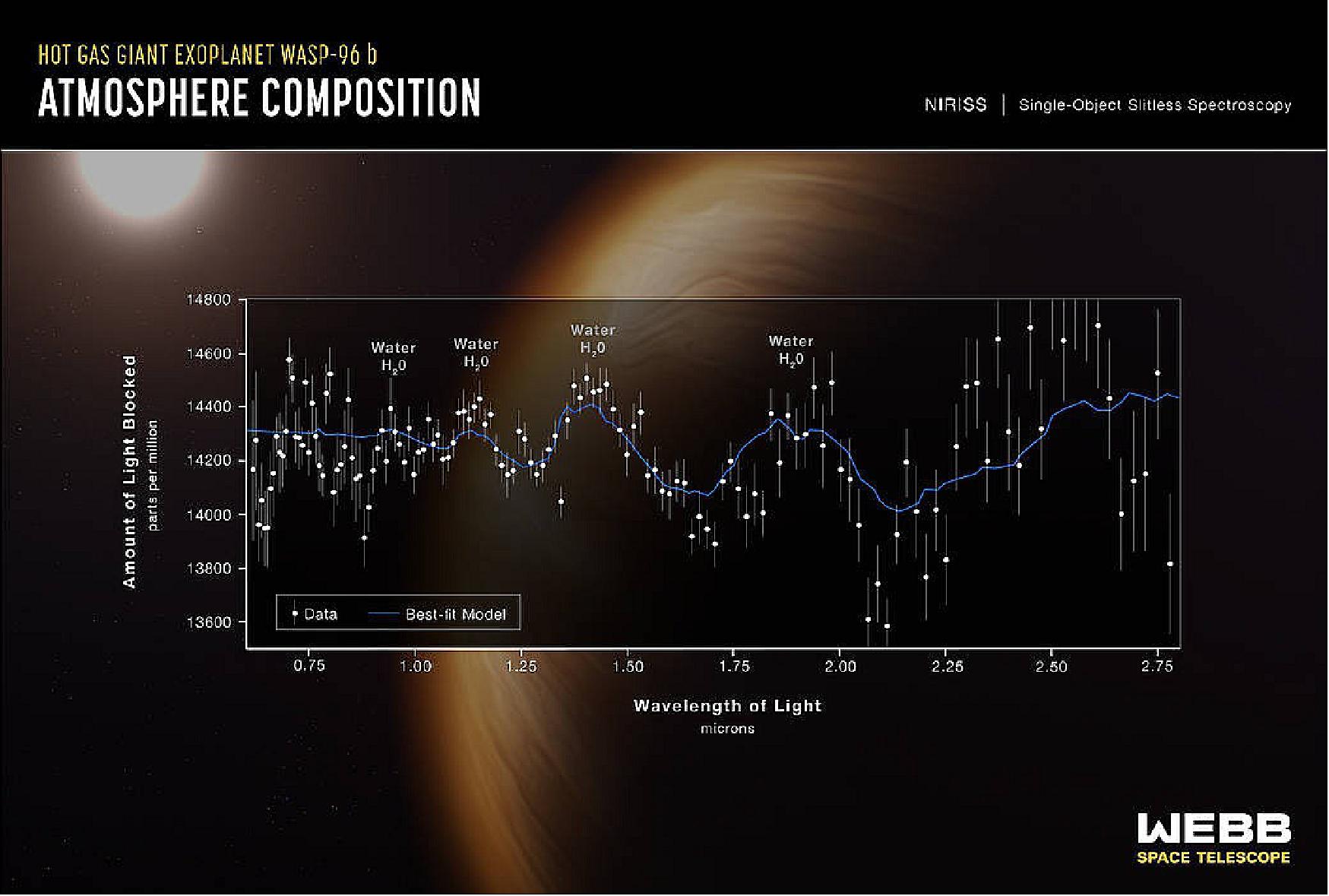
- The observation, which reveals the presence of specific gas molecules based on tiny decreases in the brightness of precise colors of light, is the most detailed of its kind to date, demonstrating Webb's unprecedented ability to analyze atmospheres hundreds of light-years away.
- While the Hubble Space Telescope has analyzed numerous exoplanet atmospheres over the past two decades, capturing the first clear detection of water in 2013, Webb's immediate and more detailed observation marks a giant leap forward in the quest to characterize potentially habitable planets beyond Earth.
- WASP-96 b is one of more than 5,000 confirmed exoplanets in the Milky Way. Located roughly 1,150 light-years away in the southern-sky constellation Phoenix, it represents a type of gas giant that has no direct analog in our solar system. With a mass less than half that of Jupiter and a diameter 1.2 times greater, WASP-96 b is much puffier than any planet orbiting our Sun. And with a temperature greater than 1000°F, it is significantly hotter. WASP-96 b orbits extremely close to its Sun-like star, just one-ninth of the distance between Mercury and the Sun, completing one circuit every 3½ Earth-days.
- The combination of large size, short orbital period, puffy atmosphere, and lack of contaminating light from objects nearby in the sky makes WASP-96 b an ideal target for atmospheric observations.
- On June 21, Webb's Near-Infrared Imager and Slitless Spectrograph (NIRISS) measured light from the WASP-96 system for 6.4 hours as the planet moved across the star. The result is a light curve showing the overall dimming of starlight during the transit, and a transmission spectrum revealing the brightness change of individual wavelengths of infrared light between 0.6 and 2.8 µm.
- While the light curve confirms properties of the planet that had already been determined from other observations – the existence, size, and orbit of the planet – the transmission spectrum reveals previously hidden details of the atmosphere: the unambiguous signature of water, indications of haze, and evidence of clouds that were thought not to exist based on prior observations.
- A transmission spectrum is made by comparing starlight filtered through a planet's atmosphere as it moves across the star to the unfiltered starlight detected when the planet is beside the star. Researchers are able to detect and measure the abundances of key gases in a planet's atmosphere based on the absorption pattern – the locations and heights of peaks on the graph. In the same way that people have distinctive fingerprints and DNA sequences, atoms and molecules have characteristic patterns of wavelengths that they absorb.
- The spectrum of WASP-96 b captured by NIRISS is not only the most detailed near-infrared transmission spectrum of an exoplanet atmosphere captured to date, but it also covers a remarkably wide range of wavelengths, including visible red light and a portion of the spectrum that has not previously been accessible from other telescopes (wavelengths longer than 1.6 microns). This part of the spectrum is particularly sensitive to water as well as other key molecules like oxygen, methane, and carbon dioxide, which are not immediately obvious in the WASP-96 b spectrum but which should be detectable in other exoplanets planned for observation by Webb.
- Researchers will be able to use the spectrum to measure the amount of water vapor in the atmosphere, constrain the abundance of various elements like carbon and oxygen, and estimate the temperature of the atmosphere with depth. They can then use this information to make inferences about the overall make-up of the planet, as well as how, when, and where it formed. The blue line on the graph is a best-fit model that takes into account the data, the known properties of WASP-96 b and its star (e.g., size, mass, temperature), and assumed characteristics of the atmosphere.
- The exceptional detail and clarity of these measurements is possible because of Webb's state-of-the-art design. Its 270-square-foot gold-coated mirror collects infrared light efficiently. Its precision spectrographs spread light out into rainbows of thousands of infrared colors. And its sensitive infrared detectors measure extremely subtle differences in brightness. NIRISS is able to detect color differences of only about one thousandth of a micron (the difference between green and yellow is about 50 microns), and differences in the brightness between those colors of a few hundred parts per million.
- In addition, Webb's extreme stability and its orbital location around Lagrange Point 2 roughly a million miles away from the contaminating effects of Earth's atmosphere makes for an uninterrupted view and clean data that can be analyzed relatively quickly.
- The extraordinarily detailed spectrum – made by simultaneously analyzing 280 individual spectra captured over the observation – provides just a hint of what Webb has in store for exoplanet research. Over the coming year, researchers will use spectroscopy to analyze the surfaces and atmospheres of several dozen exoplanets, from small rocky planets to gas- and ice-rich giants. Nearly one-quarter of Webb's Cycle 1 observation time is allocated to studying exoplanets and the materials that form them.
- This NIRISS observation demonstrates that Webb has the power to characterize the atmospheres of exoplanets—including those of potentially habitable planets—in exquisite detail.
• July 8, 2022: NASA's James Webb Space Telescope, a partnership with ESA (European Space Agency) and CSA (Canadian Space Agency), will soon reveal unprecedented and detailed views of the universe with the upcoming release of its first full-color images and spectroscopic data. 30)
- The images will include some taken by Webb's MIRI instrument, which is managed by the Jet Propulsion Laboratory for NASA.
- Below is the list of cosmic objects that Webb targeted for these first observations, which will be released in NASA's live broadcast beginning at 10:30 a.m. EDT (7:30 a.m. PDT) Tuesday, July 12. Each image will simultaneously be made available on social media as well as on the agency's website.
- These listed targets below represent the first wave of full-color scientific images and spectra the observatory has gathered, and the official beginning of Webb's general science operations. They were selected by an international committee of representatives from NASA, ESA, CSA, and the Space Telescope Science Institute.
a) Carina Nebula: The Carina Nebula is one of the largest and brightest nebulae in the sky, located approximately 7,600 light-years away in the southern constellation Carina. Nebulae are stellar nurseries where stars form. The Carina Nebula is home to many massive stars several times larger than the Sun.
b) WASP-96b (spectrum): WASP-96b is a giant planet outside our solar system, composed mainly of gas. The planet, located nearly 1,150 light-years from Earth, orbits its star every 3.4 days. It has about half the mass of Jupiter, and its discovery was announced in 2014.
c) Southern Ring Nebula: The Southern Ring, or "Eight-Burst" nebula, is a planetary nebula – an expanding cloud of gas surrounding a dying star. It is nearly half a light-year in diameter and is located approximately 2,000 light-years away from Earth.
d) Stephan's Quintet: About 290 million light-years away, Stephan's Quintet is located in the constellation Pegasus. It is notable for being the first compact galaxy group ever discovered in 1787. Four of the five galaxies within the quintet are locked in a cosmic dance of repeated close encounters.
e) SMACS 0723: Massive foreground galaxy clusters magnify and distort the light of objects behind them, permitting a deep field view into both the extremely distant and intrinsically faint galaxy populations.
- The release of these first images marks the official beginning of Webb's science operations, which will continue to explore the mission's key science themes. Teams have already applied through a competitive process for time to use the telescope, in what astronomers call its first "cycle," or first year of observations.
- More information on how to join NASA for the release of Webb's first images is available online. For more about Webb's status, visit the "Where Is Webb?" tracker.
- The James Webb Space Telescope is the world's premier space science observatory. Webb will solve mysteries in our solar system, look beyond to distant worlds around other stars, and probe the mysterious structures and origins of our universe and our place in it.
• July 7, 2022: Three of the four science instruments on NASA's James Webb Space Telescope have completed their commissioning activities and are ready for science. 31)
- Each of Webb's instruments has multiple modes of operation, which need to be tested, calibrated, and ultimately verified before they can begin to conduct science. The latest instrument to complete this process, the Near-Infrared Spectrograph (NIRSpec), has four key modes the team officially confirmed as ready to go.
- "We made it: NIRSpec is ready for science! This is an amazing moment, the result of the hard work of so many JWST and NIRSpec people and teams over more than two decades. I am just so proud of everyone," said Pierre Ferruit, Webb project scientist with ESA (European Space Agency) and principal investigator for NIRSpec. "Now is time for science, and I am eager to see the first scientific results coming from NIRSpec observations. I have no doubt they will be fantastic. Big thanks to all who made this possible across the years – great job!"
- The final mode verified for NIRSpec was the multi-object spectroscopy mode, a key capability that allows Webb to capture spectra, or rainbows of infrared light, from hundreds of different cosmic targets at once. In multi-object spectroscopy mode, NIRSpec can individually open and close about 250,000 small shutters, all just the width of a human hair, to view some portions of the sky while blocking others. By controlling this "microshutter array," Webb can observe multiple specific targets while reducing interference from others.
- The confirmation of NIRSpec's multi-object spectroscopy mode marks the first time this capability has been verified for use from space. It will allow NIRSpec to characterize everything from the faintest objects in the universe to the formation of galaxies and star clusters.
- NIRSpec was built for ESA by a consortium of European companies led by Airbus Defence and Space, with NASA's Goddard Space Flight Center in Greenbelt, Maryland, providing its detector and microshutter subsystems.
- Out of 17 total instrument modes across Webb's four instruments, only one mode remains to be verified, for the Near-Infrared Camera (NIRCam). When the team confirms this remaining mode, the months-long process of preparing Webb for science will formally be complete.
- Webb's commissioning process culminates on July 12, with the release of the telescope's first full-color images and spectroscopic data, and the official beginning of its science mission.

• July 6, 2022: We are less than one week away from the release of the first full-color images from NASA's James Webb Space Telescope, but how does the observatory find and lock onto its targets? Webb's Fine Guidance Sensor (FGS) – developed by the Canadian Space Agency – was designed with this particular question in mind. Recently it captured a view of stars and galaxies that provides a tantalizing glimpse at what the telescope's science instruments will reveal in the coming weeks, months, and years. 32)
- FGS has always been capable of capturing imagery, but its primary purpose is to enable accurate science measurements and imaging with precision pointing. When it does capture imagery, the imagery is typically not kept: Given the limited communications bandwidth between L2 and Earth, Webb only sends data from up to two science instruments at a time. But during a week-long stability test in May, it occurred to the team that they could keep the imagery that was being captured because there was available data transfer bandwidth.
- The resulting engineering test image has some rough-around-the-edges qualities to it. It was not optimized to be a science observation; rather, the data was taken to test how well the telescope could stay locked onto a target, but it does hint at the power of the telescope. It carries a few hallmarks of the views Webb has produced during its postlaunch preparations. Bright stars stand out with their six, long, sharply defined diffraction spikes – an effect due to Webb's six-sided mirror segments. Beyond the stars, galaxies fill nearly the entire background.
- The result – using 72 exposures over 32 hours – is among the deepest images of the universe ever taken, according to Webb scientists. When FGS' aperture is open, it is not using color filters like the other science instruments – meaning it is impossible to study the age of the galaxies in this image with the rigor needed for scientific analysis. But even when capturing unplanned imagery during a test, FGS is capable of producing stunning views of the cosmos.
- "With the Webb telescope achieving better-than-expected image quality, early in commissioning we intentionally defocused the guiders by a small amount to help ensure they met their performance requirements. When this image was taken, I was thrilled to clearly see all the detailed structure in these faint galaxies. Given what we now know is possible with deep broad-band guider images, perhaps such images, taken in parallel with other observations where feasible, could prove scientifically useful in the future," said Neil Rowlands, program scientist for Webb's Fine Guidance Sensor, at Honeywell Aerospace.
- Because this image was not created with a science result in mind, there are a few features that are quite different than the full-resolution images that will be released July 12. Those images will include what will be – for a short time at least – the deepest image of the universe ever captured, as NASA Administrator Bill Nelson announced on June 29.
- The FGS image is colored using the same reddish color scheme that has been applied to Webb's other engineering images throughout commissioning. In addition, there was no "dithering" during these exposures. Dithering is when the telescope repositions slightly between each exposure. In addition, the centers of bright stars appear black because they saturate Webb's detectors, and the pointing of the telescope didn't change over the exposures to capture the center from different pixels within the camera's detectors. The overlapping frames of the different exposures can also be seen at the image's edges and corners.
- In this engineering test, the purpose was to lock onto one star and to test how well Webb could control its "roll" – literally, Webb's ability to roll to one side like an aircraft in flight. That test was performed successfully – in addition to producing an image that sparks the imagination of scientists who will be analyzing Webb's science data, said Jane Rigby, Webb's operations scientist at NASA's Goddard Space Flight Center in Greenbelt, Maryland.
- "The faintest blobs in this image are exactly the types of faint galaxies that Webb will study in its first year of science operations," Rigby said.
- While Webb's four science instruments will ultimately reveal the telescope's new view of the universe, the Fine Guidance Sensor is the one instrument that will be used in every single Webb observation over the course of the mission's lifetime. FGS has already played a crucial role in aligning Webb's optics. Now, during the first real science observations made in June and once science operations begin in mid-July, it will guide each Webb observation to its target and maintain the precision necessary for Webb to produce breakthrough discoveries about stars, exoplanets, galaxies, and even moving targets within our solar system.
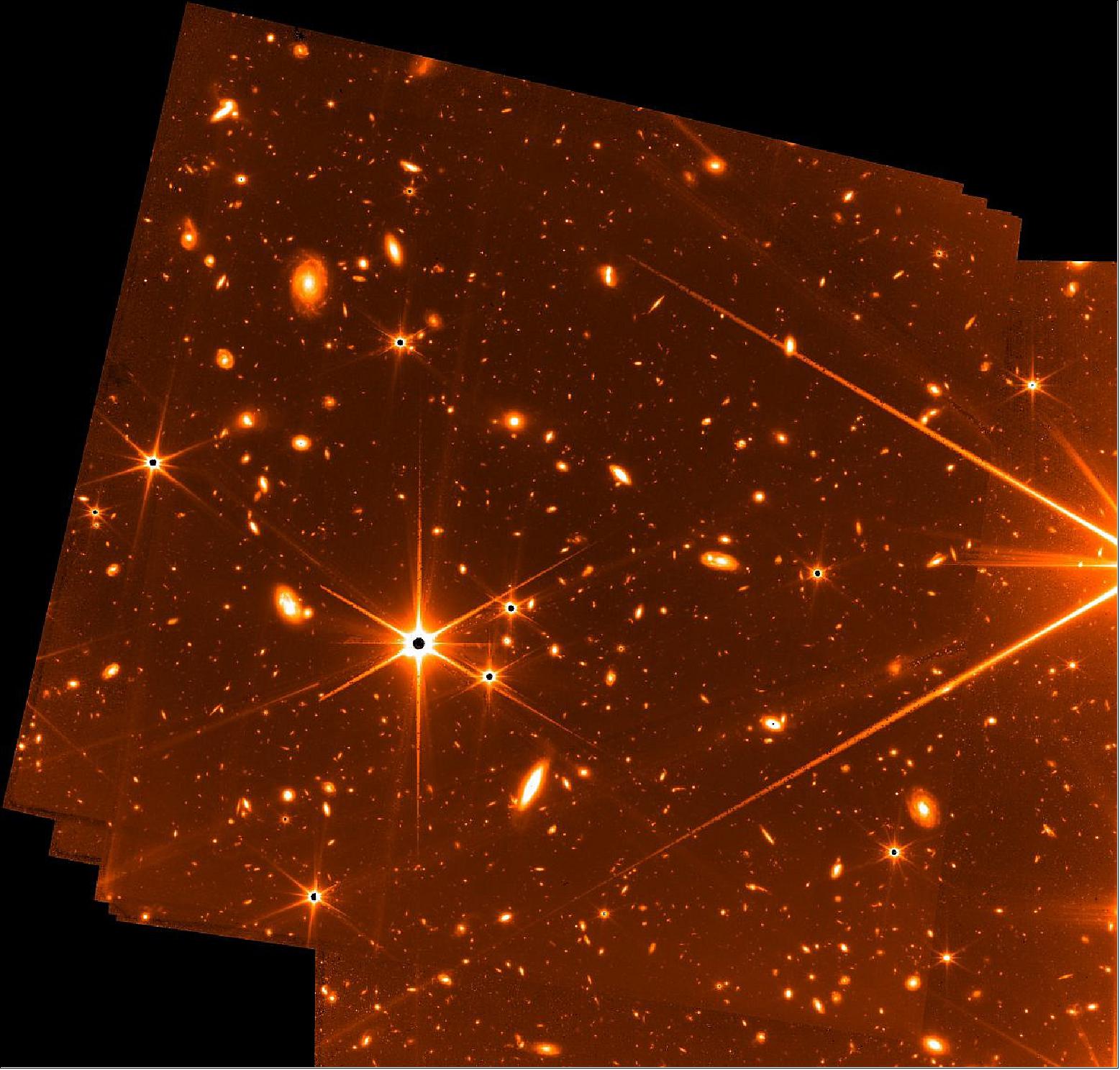
• June 22, 2022: Two research teams will use the telescope's powerful instruments to capture and characterize some of the earliest galaxies in the universe. 33)
- The universe was a very different place for several hundred million years after the big bang. It wasn't yet transparent like it is today – neutral gas made it semi-opaque. This is a period when the first galaxies in the universe were beginning to form. Telescopes have spotted many distant galaxies – but none earlier than 400 million years after the big bang. What were galaxies that existed even earlier like? Two research teams using the James Webb Space Telescope will wield its state-of-the-art instruments to reveal an untold number of details about this early period in the universe for the first time – and revise what we know about some of the earliest chapters of galaxy evolution.
- For decades, telescopes have helped us capture light from galaxies that formed as far back as 400 million years after the big bang – incredibly early in the context of the universe's 13.8-billion-year history. But what were galaxies like that existed even earlier, when the universe was semi-transparent at the beginning of a period known as the Era of Reionization? NASA's next flagship observatory, the James Webb Space Telescope, is poised to add new riches to our wealth of knowledge not only by capturing images from galaxies that existed as early as the first few hundred million years after the big bang, but also by giving us detailed data known as spectra. With Webb's observations, researchers will be able to tell us about the makeup and composition of individual galaxies in the early universe for the first time.
- The Next Generation Deep Extragalactic Exploratory Public (NGDEEP) Survey, co-led by Steven L. Finkelstein, an associate professor at the University of Texas at Austin, will target the same two regions that make up the Hubble Ultra Deep Field – locations in the constellation Fornax where Hubble spent more than 11 days taking deep exposures. To produce its observations, the Hubble Space Telescope targeted nearby areas of the sky simultaneously with two instruments – slightly offset from one another – known as a primary and a parallel field. "We have the same advantage with Webb," Finkelstein explained. "We're using two science instruments at once, and they will observe continuously." They will point Webb's Near-Infrared Imager and Slitless Spectrograph (NIRISS) on the primary Hubble Ultra Deep Field, and Webb's Near-Infrared Camera (NIRCam) on the parallel field, getting twice the bang for their "buck" of telescope time.
- For the imaging with NIRCam, they'll observe for over 125 hours. With each passing minute, they'll obtain more and more information from deeper and deeper in the universe. What do they seek? Some of the earliest galaxies that formed. "We have really good indications from Hubble that there are galaxies in place at a time 400 million years after the big bang," Finkelstein said. "The ones we see with Hubble are pretty big and very bright. It's highly likely there are smaller, fainter galaxies that formed even earlier that are waiting to be found."
- This program will use only about one-third of the time Hubble has spent to date on similar investigations. Why? In part, this is because Webb's instruments were designed to capture infrared light. As light travels through space toward us, it stretches into longer, redder wavelengths due to the expansion of the universe. "Webb will help us push all the boundaries," said Jennifer Lotz, a coinvestigator on the proposal and director of the Gemini Observatory, part of the National Science Foundation's NOIRLab (National Optical-Infrared Astronomy Research Laboratory). "And we're going to release the data immediately to benefit all researchers."
- These researchers will also focus on identifying the metal content in each galaxy, especially in smaller and dimmer galaxies that haven't yet been thoroughly examined – specifically with the spectra Webb's NIRISS instrument delivers. "One of the fundamental ways that we trace evolution across cosmic time is by the amount of metals that are in a galaxy," explained Danielle Berg, an assistant professor at the University of Texas at Austin and a co-investigator on the proposal. When the universe began, there was only hydrogen and helium. New elements were formed by successive generations of stars. By cataloging the contents of each galaxy, the researchers will be able to plot out precisely when various elements existed and update models that project how galaxies evolved in the early universe.
![Figure 16: This Hubble Space Telescope image, known as the Hubble Ultra Deep Field, reveals about 10,000 galaxies and combines ultraviolet, visible, and near-infrared light. Two programs that will use the James Webb Space Telescope will add more detail to this image, capturing thousands of additional galaxies in a fuller range of infrared light. Webb will return both imagery and data known as spectra, providing more details about some of the earliest galaxies to exist in the universe for the first time [image credits: Science: NASA, ESA, Steven V.W. Beckwith (STScI), HUDF Team (STScI)]](https://www.eoportal.org/ftp/satellite-missions/j/JWST_130722/JWST_Auto55.jpeg)
Peeling Back New Layers
- Another program, led by Michael Maseda, an assistant professor at the University of Wisconsin-Madison, will examine the primary Hubble Ultra Deep Field using the microshutter array within Webb's Near-Infrared Spectrograph (NIRSpec). This instrument returns spectra for specific objects depending on which miniature shutters researchers open. "These galaxies existed during the first billion years in the history of the universe, which we have very little information about to date," Maseda explained. "Webb will provide the first large sample that will give us the chance to understand them in detail."
- We know these galaxies exist because of extensive observations this team has made – along with an international research team – with the ground-based Very Large Telescope's Multi Unit Spectroscopic Explorer (MUSE) instrument. Although MUSE is the "scout," identifying smaller, fainter galaxies in this deep field, Webb will be the first telescope to fully characterize their chemical compositions.
- These extremely distant galaxies have important implications for our understanding of how galaxies formed in the early universe. "Webb will open a new space for discovery," explained Anna Feltre, a research fellow at the National Institute for Astrophysics in Italy and a co-investigator. "Its data will help us learn precisely what happens as a galaxy forms, including which metals they contain, how quickly they grow, and if they already have black holes."
- This research will be conducted as part of Webb's General Observer (GO) programs, which are competitively selected using a dual-anonymous review, the same system that is used to allocate time on the Hubble Space Telescope.
• June 1, 2022: NASA's James Webb Space Telescope, a partnership with ESA (European Space Agency) and the Canadian Space Agency (CSA), will release its first full-color images and spectroscopic data on July 12, 2022. As the largest and most complex observatory ever launched into space, Webb has been going through a six-month period of preparation before it can begin science work, calibrating its instruments to its space environment and aligning its mirrors. This careful process, not to mention years of new technology development and mission planning, has built up to the first images and data: a demonstration of Webb at its full power, ready to begin its science mission and unfold the infrared universe. 34)
- "As we near the end of preparing the observatory for science, we are on the precipice of an incredibly exciting period of discovery about our universe. The release of Webb's first full-color images will offer a unique moment for us all to stop and marvel at a view humanity has never seen before," said Eric Smith, Webb program scientist at NASA Headquarters in Washington. "These images will be the culmination of decades of dedication, talent, and dreams – but they will also be just the beginning."
Behind the Scenes: Creating Webb's First Images
- Deciding what Webb should look at first has been a project more than five years in the making, undertaken by an international partnership between NASA, ESA, CSA, and the Space Telescope Science Institute (STScI) in Baltimore, home to Webb's science and mission operations.
- "Our goals for Webb's first images and data are both to showcase the telescope's powerful instruments and to preview the science mission to come," said astronomer Klaus Pontoppidan, Webb project scientist at STScI. "They are sure to deliver a long-awaited ‘wow' for astronomers and the public."
- Once each of Webb's instruments has been calibrated, tested, and given the green light by its science and engineering teams, the first images and spectroscopic observations will be made. The team will proceed through a list of targets that have been preselected and prioritized by an international committee to exercise Webb's powerful capabilities. Then the production team will receive the data from Webb's instrument scientists and process it into images for astronomers and the public.
- "I feel very privileged to be a part of it," said Alyssa Pagan, a science visuals developer at STScI. "Typically, the process from raw telescope data to final, clean image that communicates scientific information about the universe can take anywhere from weeks to a month," Pagan said.
What Will We See?
- While careful planning for Webb's first full-color images has been underway for a long time, the new telescope is so powerful that it is difficult to predict exactly how the first images will look. "Of course, there are things we are expecting and hoping to see, but with a new telescope and this new high-resolution infrared data, we just won't know until we see it," said STScI's lead science visuals developer Joseph DePasquale.
- Early alignment imagery has already demonstrated the unprecedented sharpness of Webb's infrared view. However, these new images will be the first in full color and the first to showcase Webb's full science capabilities. In addition to imagery, Webb will be capturing spectroscopic data – detailed information astronomers can read in light. The first images package of materials will highlight the science themes that inspired the mission and will be the focus of its work: the early universe, the evolution of galaxies through time, the lifecycle of stars, and other worlds. All of Webb's commissioning data – the data taken while aligning the telescope and preparing the instruments – will also be made publicly available.
What's Next?
- Science! After capturing its first images, Webb's scientific observations will begin, continuing to explore the mission's key science themes. Teams have already applied through a competitive process for time to use the telescope, in what astronomers call its first "cycle," or first year of observations. Observations are carefully scheduled to make the most efficient use of the telescope's time.
- These observations mark the official beginning of Webb's general science operations – the work it was designed to do. Astronomers will use Webb to observe the infrared universe, analyze the data collected, and publish scientific papers on their discoveries.
- Beyond what is already planned for Webb, there are the unexpected discoveries astronomers can't anticipate. One example: In 1990 when the Hubble Space Telescope launched, dark energy was completely unknown. Now it is one of the most exciting areas of astrophysics. What will Webb discover?
- The James Webb Space Telescope is the world's premier space science observatory. Webb will solve mysteries in our solar system, look beyond to distant worlds around other stars, and probe the mysterious structures and origins of our universe and our place in it. Webb is an international program led by NASA with its partners, ESA (European Space Agency) and the Canadian Space Agency.
• May 26, 2022: Researchers will train Webb's high-precision spectrographs on two intriguing rocky exoplanets. 35)
- With its mirror segments beautifully aligned and its scientific instruments undergoing calibration, NASA's James Webb Space Telescope is just weeks away from full operation. Soon after the first observations are revealed this summer, Webb's in-depth science will begin.
- Among the investigations planned for the first year are studies of two hot exoplanets classified as "super-Earths" for their size and rocky composition: the lava-covered 55 Cancri e and the airless LHS 3844 b. Researchers will train Webb's high-precision spectrographs on these planets with a view to understanding the geologic diversity of planets across the galaxy, and the evolution of rocky planets like Earth.
Super-Hot Super-Earth 55 Cancri e
- 55 Cancri e orbits less than 1.5 million miles from its Sun-like star (one twenty-fifth of the distance between Mercury and the Sun), completing one circuit in less than 18 hours. With surface temperatures far above the melting point of typical rock-forming minerals, the day side of the planet is thought to be covered in oceans of lava.
- Planets that orbit this close to their star are assumed to be tidally locked, with one side facing the star at all times. As a result, the hottest spot on the planet should be the one that faces the star most directly, and the amount of heat coming from the day side should not change much over time.
- But this doesn't seem to be the case. Observations of 55 Cancri e from NASA's Spitzer Space Telescope suggest that the hottest region is offset from the part that faces the star most directly, while the total amount of heat detected from the day side does vary.
![Figure 18: The illustration is showing what exoplanet 55 Cancri e could look like, based on current understanding of the planet. 55 Cancri e is a rocky planet with a diameter almost twice that of Earth orbiting just 0.015 astronomical units from its Sun-like star. Because of its tight orbit, the planet is extremely hot, with dayside temperatures reaching 4,400º Fahrenheit (about 2,400º Celsius). Although previous studies have ruled out a thick hydrogen, carbon dioxide, or water atmosphere, it is possible that the planet has a substantial atmosphere made of oxygen or nitrogen, or a very thin atmosphere of mineral vapor, such as silicon oxide. - Researchers think that if the planet is tidally locked, the lit surface must be permanently molten. If the planet is not locked, it would experience day-night cycles, with the surface heating up and melting during the day, and cooling and solidifying at night. The extreme heat during the day would also cause some of the molten rock to vaporize, forming a very tenuous mineral vapor atmosphere. In the evening, this vapor would condense and fall as a rain of lava back onto the surface, where it would turn solid overnight. - Spectroscopic observations using Webb's Near-Infrared Camera (NIRCam) and Mid-Infrared Instrument (MIRI) will help determine whether or not the planet has an atmosphere, and if so, what that atmosphere is made of. The observations will also help determine whether or not the planet is tidally locked [image credit: ARTWORK: NASA, ESA, CSA, Dani Player (STScI)]](https://www.eoportal.org/ftp/satellite-missions/j/JWST_130722/JWST_Auto54.jpeg)
Does 55 Cancri e Have a Thick Atmosphere?
- One explanation for these observations is that the planet has a dynamic atmosphere that moves heat around. "55 Cancri e could have a thick atmosphere dominated by oxygen or nitrogen," explained Renyu Hu of NASA's Jet Propulsion Laboratory in Southern California, who leads a team that will use Webb's Near-Infrared Camera (NIRCam) and Mid-Infrared Instrument (MIRI) to capture the thermal emission spectrum of the day side of the planet. "If it has an atmosphere, [Webb] has the sensitivity and wavelength range to detect it and determine what it is made of," Hu added.
Or Is It Raining Lava in the Evening on 55 Cancri e?
- Another intriguing possibility, however, is that 55 Cancri e is not tidally locked. Instead, it may be like Mercury, rotating three times for every two orbits (what's known as a 3:2 resonance). As a result, the planet would have a day-night cycle.
- "That could explain why the hottest part of the planet is shifted," explained Alexis Brandeker, a researcher from Stockholm University who leads another team studying the planet. "Just like on Earth, it would take time for the surface to heat up. The hottest time of the day would be in the afternoon, not right at noon."
- Brandeker's team plans to test this hypothesis using NIRCam to measure the heat emitted from the lit side of 55 Cancri e during four different orbits. If the planet has a 3:2 resonance, they will observe each hemisphere twice and should be able to detect any difference between the hemispheres.
- In this scenario, the surface would heat up, melt, and even vaporize during the day, forming a very thin atmosphere that Webb could detect. In the evening, the vapor would cool and condense to form droplets of lava that would rain back to the surface, turning solid again as night falls.
Somewhat Cooler Super-Earth LHS 3844 b
- While 55 Cancri e will provide insight into the exotic geology of a world covered in lava, LHS 3844 b affords a unique opportunity to analyze the solid rock on an exoplanet surface.
- Like 55 Cancri e, LHS 3844 b orbits extremely close to its star, completing one revolution in 11 hours. However, because its star is relatively small and cool, the planet is not hot enough for the surface to be molten. Additionally, Spitzer observations indicate that the planet is very unlikely to have a substantial atmosphere.
What Is the Surface of LHS 3844 b Made of?
- While we won't be able to image the surface of LHS 3844 b directly with Webb, the lack of an obscuring atmosphere makes it possible to study the surface with spectroscopy.
- "It turns out that different types of rock have different spectra," explained Laura Kreidberg at the Max Planck Institute for Astronomy. "You can see with your eyes that granite is lighter in color than basalt. There are similar differences in the infrared light that rocks give off."
- Kreidberg's team will use MIRI to capture the thermal emission spectrum of the day side of LHS 3844 b, and then compare it to spectra of known rocks, like basalt and granite, to determine its composition. If the planet is volcanically active, the spectrum could also reveal the presence of trace amounts of volcanic gases.
- The importance of these observations goes far beyond just two of the more than 5,000 confirmed exoplanets in the galaxy. "They will give us fantastic new perspectives on Earth-like planets in general, helping us learn what the early Earth might have been like when it was hot like these planets are today," said Kreidberg.
- These observations of 55 Cancri e and LHS 3844 b will be conducted as part of Webb's Cycle 1 General Observers program. General Observers programs were competitively selected using a dual-anonymous review system, the same system used to allocate time on Hubble.
- The James Webb Space Telescope is the world's premier space science observatory. Webb will solve mysteries in our solar system, look beyond to distant worlds around other stars, and probe the mysterious structures and origins of our universe and our place in it. Webb is an international program led by NASA with its partners, ESA (European Space Agency) and the Canadian Space Agency.
• May 9, 2022: The James Webb Space Telescope is aligned across all four of its science instruments, as seen in a previous engineering image showing the observatory's full field of view. Now, we take a closer look at that same image, focusing on Webb's coldest instrument: the Mid-Infrared Instrument (MIRI).
- For example, Webb's MIRI image shows the interstellar gas in unprecedented detail. Here, you can see the emission from ‘polycyclic aromatic hydrocarbons' – molecules of carbon and hydrogen that play an important role in the thermal balance and chemistry of interstellar gas. When Webb is ready to begin science observations, studies such as these with MIRI will help give astronomers new insights into the birth of stars and protoplanetary systems.
- In the meantime, the Webb team has begun the process of setting up and testing Webb's instruments to begin science observations this summer. Today at 17:00 CEST, Webb experts will preview these next two months of instrument preparations in a teleconference for media. Listen to the audio stream live at nasa.gov/live.
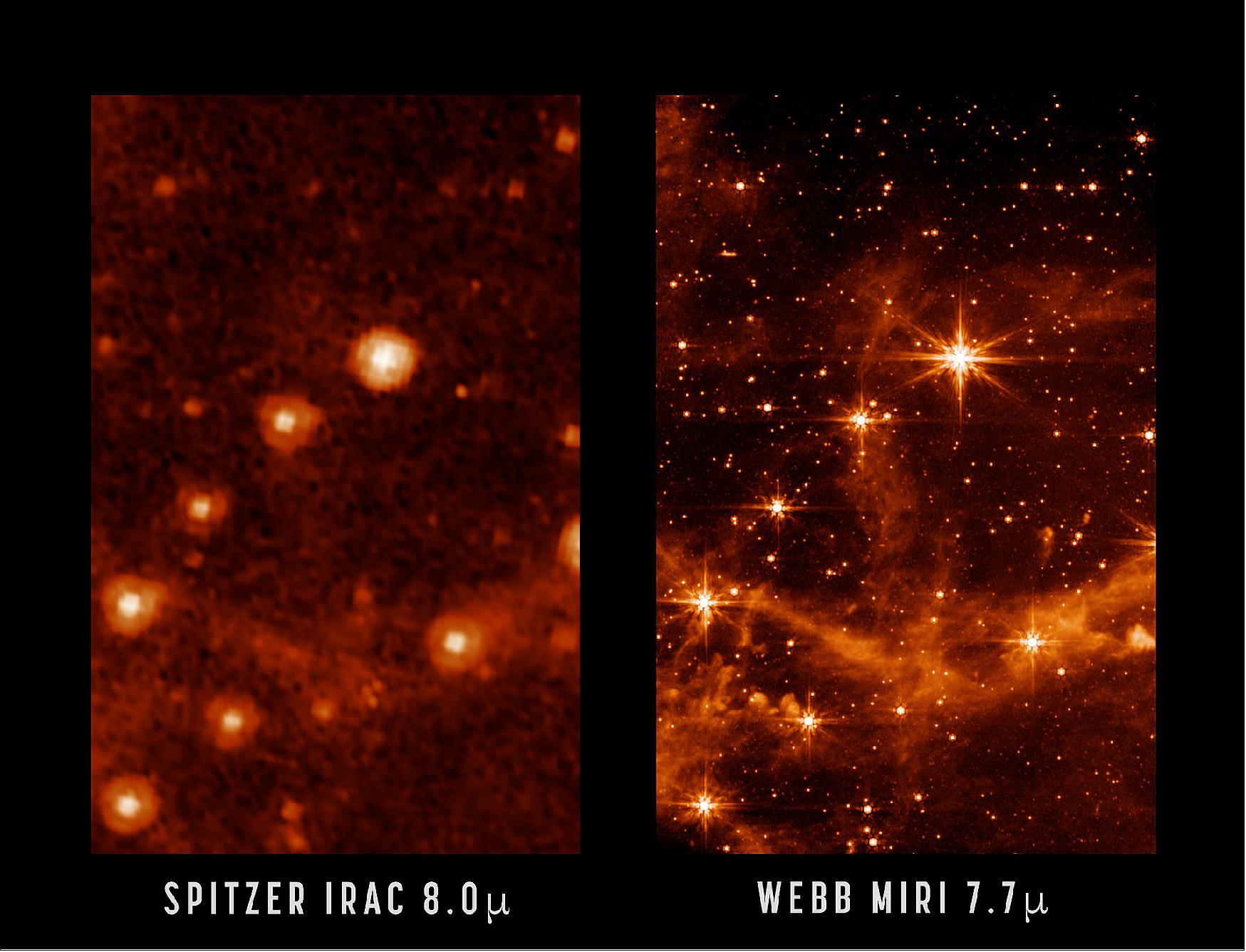
• May 5, 2022: NASA's James Webb Space Telescope is now experiencing all seasons – from hot to cold – as it undergoes the thermal stability test. Meanwhile, activities are underway for the final phase of commissioning: digging into the details of the science instruments, the heart of Webb. To complete commissioning, we will measure the detailed performance of the science instruments before we start routine science operations in the summer. 36)
- Today, the lead commissioning scientist for Webb, Scott Friedman of the Space Telescope Science Institute (STScI), gives us all the details on this final phase of commissioning.
- "With the telescope beautifully aligned and the observatory near its final cryogenic temperature, we are ready to begin the last group of activities before the science observations start: science instrument commissioning. Here I describe just a few of those activities.
- "The instruments, the Near-Infrared Camera (NIRCam), Near-Infrared Spectrometer (NIRSpec), Near-Infrared Imager and Slitless Spectrometer (NIRISS), Mid-Infrared Instrument (MIRI), and the Fine Guidance Sensor (FGS) have been powered up and safely cooled. We have operated their mechanisms and detectors, including filter wheels, grating wheels, and the NIRSpec microshutter assembly. The Webb optics team used images of isolated stars taken with each of the instruments to align the primary and secondary mirrors of the observatory. But we have more work to do before Webb is fully ready to embark on the ambitious science observations that will reveal the secrets of the universe.
- "We will now begin an extensive suite of calibrations and characterizations of the instruments using a rich variety of astronomical sources. We will measure the instruments' throughput – how much of the light that enters the telescope reaches the detectors and is recorded. There is always some loss with each reflection by the mirrors of the telescope and within each instrument, and no detector records every photon that arrives. We will measure this throughput at multiple wavelengths of light by observing standard stars whose light emission is known from data obtained with other observatories combined with theoretical calculations.
- "The astrometric calibration of each instrument maps the pixels on the detectors to the precise locations on the sky, to correct the small but unavoidable optical distortions that are present in every optical system. We do this by observing the Webb astrometric field, a small patch of sky in a nearby galaxy, the Large Magellanic Cloud. This field was observed by the Hubble Space Telescope to establish the coordinates of about 200,000 stars to an accuracy of 1 milliarcsec (less than 0.3 millionths of a degree). Calibrating this distortion is required to precisely place the science targets on the instruments' field of view. For example, to get the spectra of a hundred galaxies simultaneously using the NIRSpec microshutter assembly, the telescope must be pointed so that each galaxy is in the proper shutter, and there are a quarter of a million shutters!
- "We will also measure the sharpness of the stellar images, what astronomers call the ‘point spread function.' We already know the telescope is delivering to the instruments image quality that exceeds our prelaunch expectations, but each instrument has additional optics. These optics perform a function, such as passing the light through filters to get color information about the astronomical target or using a diffraction grating to spread the incoming light into its constituent colors. Measuring the point spread function within each instrument at different wavelengths provides an important calibration for interpreting the data.
- "We will test target acquisition for each instrument. For some observations, it is sufficient to point the telescope using the position of a guide star in the Fine Guidance Sensor and know the location of the science target relative to that guide star. This places the science target to an accuracy of a few tenths of an arcsecond. However, in some cases more precision is necessary, approximately a hundredth of an arcsecond. For example, for coronagraphy, the star has to be placed behind a mask so its light is blocked, allowing the nearby exoplanet to shine through. In time series observations, we measure how an exoplanet's atmosphere absorbs the stellar light during the hours it takes to pass in front of its star, allowing us to measure the properties and constituents of the planet's atmosphere. Both of these applications require that the instrument send corrections to the telescope pointing control system to put the science target precisely in the correct location within the instrument's field of view.
- "A final example of our instrument commissioning activities is observations of moving targets. Most astronomical objects are so far away that they appear to be stationary on the sky. However, this is not true of the planets, satellites and rings, asteroids, and comets within our own solar system. Observing these requires that the observatory change its pointing direction relative to the background guide stars during the observation. We will test this capability by observing asteroids of different apparent speeds using each instrument.
- "We are now in the last two months of Webb's commissioning before it is fully ready for its scientific mission. We still have important properties and capabilities of the instruments to test, measure, and demonstrate. When these are complete, we will be ready to begin the great science programs that astronomers and the public alike have been eagerly awaiting. We are almost there."
• April 28, 2022: Alignment of NASA's James Webb Space Telescope is now complete. After full review, the observatory has been confirmed to be capable of capturing crisp, well-focused images with each of its four powerful onboard science instruments. Upon completing the seventh and final stage of telescope alignment, the team held a set of key decision meetings and unanimously agreed that Webb is ready to move forward into its next and final series of preparations, known as science instrument commissioning. This process will take about two months before scientific operations begin in the summer. 37) 38)
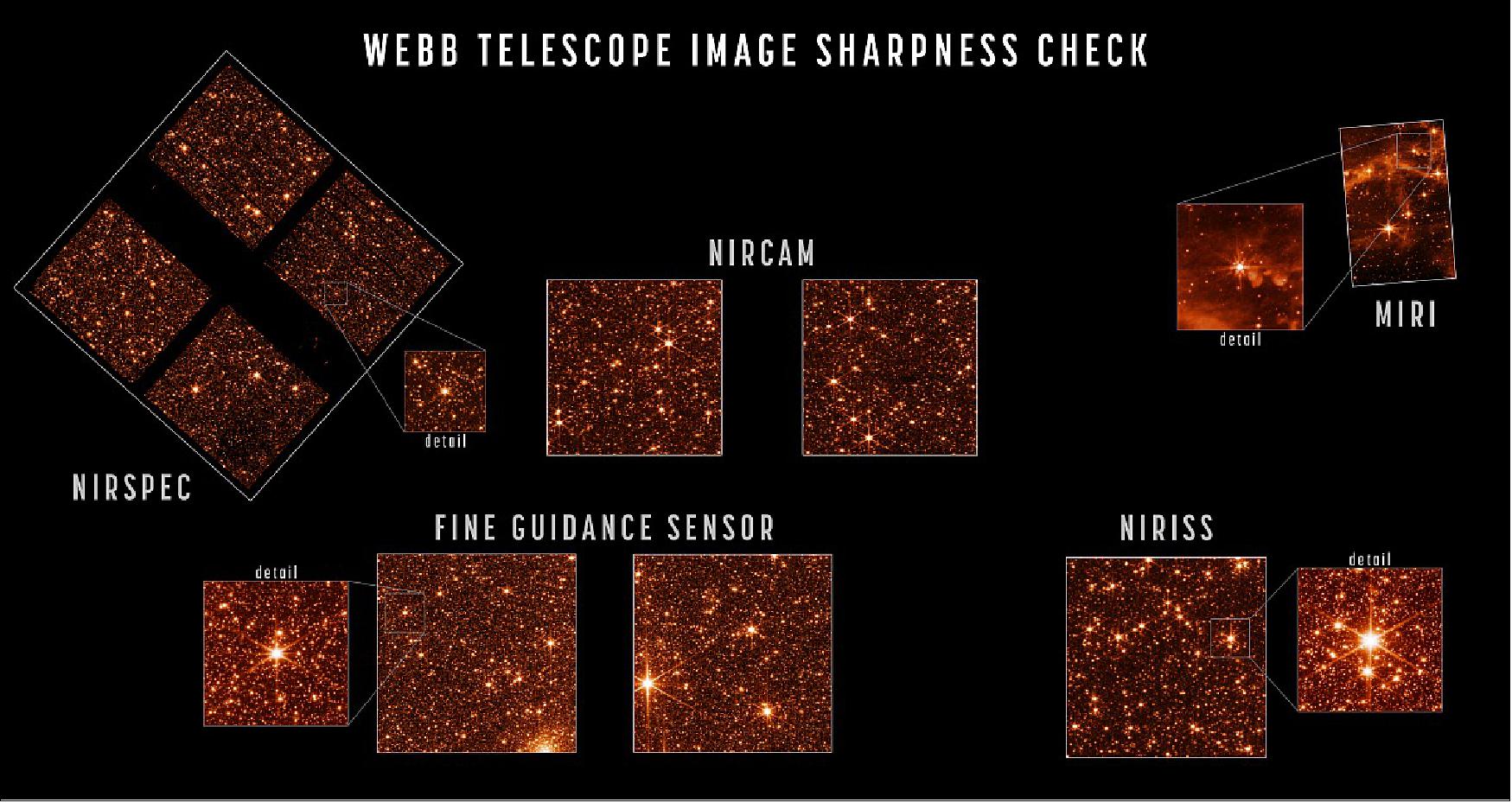
- The alignment of the telescope across all of Webb's instruments can be seen in a series of images that captures the observatory's full field of view.
- "These remarkable test images from a successfully aligned telescope demonstrate what people across countries and continents can achieve when there is a bold scientific vision to explore the universe," said Lee Feinberg, Webb optical telescope element manager at NASA's Goddard Space Flight Center.
- The optical performance of the telescope continues to be better than the engineering team's most optimistic predictions. Webb's mirrors are now directing fully focused light collected from space down into each instrument, and each instrument is successfully capturing images with the light being delivered to them. The image quality delivered to all instruments is "diffraction-limited," meaning that the fineness of detail that can be seen is as good as physically possible given the size of the telescope. From this point forward the only changes to the mirrors will be very small, periodic adjustments to the primary mirror segments.
- "With the completion of telescope alignment and half a lifetime's worth of effort, my role on the James Webb Space Telescope mission has come to an end," said Scott Acton, Webb wavefront sensing and controls scientist, Ball Aerospace. "These images have profoundly changed the way I see the universe. We are surrounded by a symphony of creation; there are galaxies everywhere! It is my hope that everyone in the world can see them."
- Now, the Webb team will turn its attention to science instrument commissioning. Each instrument is a highly sophisticated set of detectors equipped with unique lenses, masks, filters, and customized equipment that helps it perform the science it was designed to achieve. The specialized characteristics of these instruments will be configured and operated in various combinations during the instrument commissioning phase to fully confirm their readiness for science. With the formal conclusion of telescope alignment, key personnel involved with the commissioning of each instrument have arrived at the Mission Operations Center at the Space Telescope Science Institute in Baltimore, and some personnel involved with telescope alignment have concluded their duties.
- Though telescope alignment is complete, some telescope calibration activities remain: As part of scientific instrument commissioning, the telescope will be commanded to point to different areas in the sky where the total amount of solar radiation hitting the observatory will vary to confirm thermal stability when changing targets. Furthermore, ongoing maintenance observations every two days will monitor the mirror alignment and, when needed, apply corrections to keep the mirrors in their aligned locations.
• April 13, 2022: NASA's James Webb Space Telescope will see the first galaxies to form after the big bang, but to do that its instruments first need to get cold – really cold. On April 7, Webb's Mid-Infrared Instrument (MIRI) – a joint development by NASA and ESA (European Space Agency) – reached its final operating temperature below 7 kelvins (minus 447º Fahrenheit, or minus 266º Celsius). 39) 40)
- Along with Webb's three other instruments, MIRI initially cooled off in the shade of Webb's tennis-court-size sunshield, dropping to about 90 kelvins (minus 298º F, or minus 183º C). But dropping to less than 7 kelvins required an electrically powered cryocooler. Last week, the team passed a particularly challenging milestone called the "pinch point," when the instrument goes from 15 kelvins (minus 433º F, or minus 258º C) to 6.4 kelvins (minus 448º F, or minus 267º C).
- The low temperature is necessary because all four of Webb's instruments detect infrared light – wavelengths slightly longer than those that human eyes can see. Distant galaxies, stars hidden in cocoons of dust, and planets outside our solar system all emit infrared light. But so do other warm objects, including Webb's own electronics and optics hardware. Cooling down the four instruments' detectors and the surrounding hardware suppresses those infrared emissions. MIRI detects longer infrared wavelengths than the other three instruments, which means it needs to be even colder.
- Another reason Webb's detectors need to be cold is to suppress something called dark current, or electric current created by the vibration of atoms in the detectors themselves. Dark current mimics a true signal in the detectors, giving the false impression that they have been hit by light from an external source. Those false signals can drown out the real signals astronomers want to find. Since temperature is a measurement of how fast the atoms in the detector are vibrating, reducing the temperature means less vibration, which in turn means less dark current.
- MIRI's ability to detect longer infrared wavelengths also makes it more sensitive to dark current, so it needs to be colder than the other instruments to fully remove that effect. For every degree the instrument temperature goes up, the dark current goes up by a factor of about 10.
- Once MIRI reached a frigid 6.4 kelvins, scientists began a series of checks to make sure the detectors were operating as expected. Like a doctor searching for any sign of illness, the MIRI team looks at data describing the instrument's health, then gives the instrument a series of commands to see if it can execute tasks correctly. This milestone is the culmination of work by scientists and engineers at multiple institutions in addition to JPL, including Northrop Grumman, which built the cryocooler, and NASA's Goddard Space Flight Center, which oversaw the integration of MIRI and the cooler to the rest of the observatory.
- "We spent years practicing for that moment, running through the commands and the checks that we did on MIRI," said Mike Ressler, project scientist for MIRI at JPL. "It was kind of like a movie script: Everything we were supposed to do was written down and rehearsed. When the test data rolled in, I was ecstatic to see it looked exactly as expected and that we have a healthy instrument."
- There are still more challenges that the team will have to face before MIRI can start its scientific mission. Now that the instrument is at operating temperature, team members will take test images of stars and other known objects that can be used for calibration and to check the instrument's operations and functionality. The team will conduct these preparations alongside calibration of the other three instruments, delivering Webb's first science images this summer.
- "I am immensely proud to be part of this group of highly motivated, enthusiastic scientists and engineers drawn from across Europe and the U.S.," said Alistair Glasse, MIRI instrument scientist at the UK Astronomy Technology Centre (ATC) in Edinburgh, Scotland. "This period is our ‘trial by fire' but it is already clear to me that the personal bonds and mutual respect that we have built up over the past years is what will get us through the next few months to deliver a fantastic instrument to the worldwide astronomy community."
- MIRI was developed through a 50-50 partnership between NASA and ESA. JPL leads the U.S. efforts for MIRI, and a multinational consortium of European astronomical institutes contributes for ESA. George Rieke with the University of Arizona is the MIRI science team lead. Gillian Wright is the MIRI European principal investigator.
- Laszlo Tamas with UK ATC manages the European Consortium. The MIRI cryocooler development was led and managed by JPL, in collaboration with Northrop Grumman in Redondo Beach, California, and NASA's Goddard Space Flight Center in Greenbelt, Maryland.
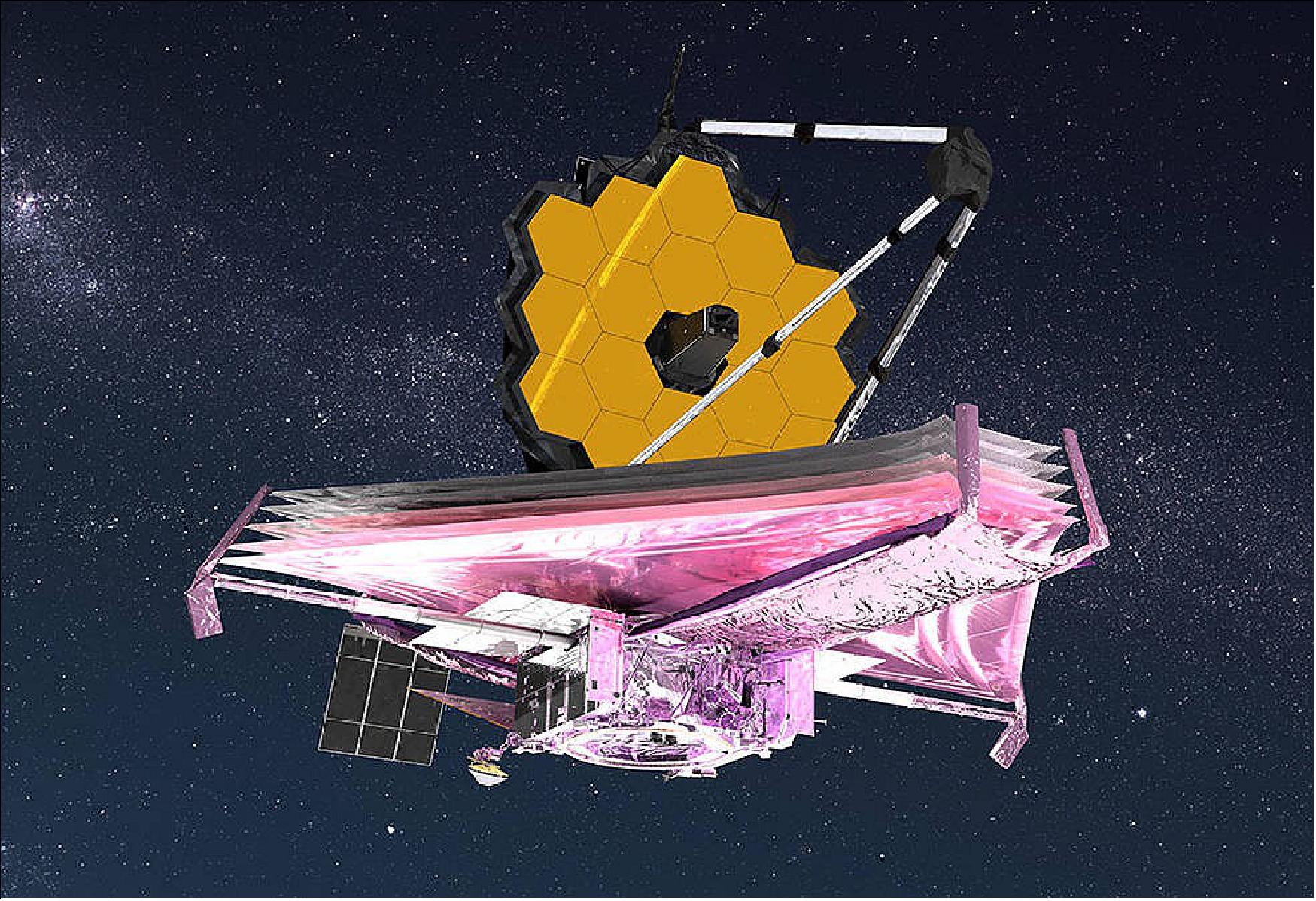
• April 11, 2022: The James Webb Space Telescope will explore the infrared Universe. It will use four cutting-edge instruments, including the Mid-InfraRed Instrument. MIRI is one of Europe's contributions to the James Webb Space Telescope. 41)
- MIRI supports all of Webb's science goals. It will image the Universe, study planets around our own and other stars and investigate stars and galaxies across cosmic history.
• April 1, 2022: The sixth stage of aligning NASA's James Webb Space Telescope's mirrors to its scientific instruments so they will create the most accurate and focused images possible has concluded. While the Mid-Infrared Instrument (MIRI) continues its cooldown, optics teams have successfully aligned the rest of the observatory's onboard instruments to Webb's mirrors. Previous alignment efforts were so accurate that the team concluded no additional adjustments to the secondary mirror are necessary until the seventh and final stage, which will involve MIRI when it has fully cooled. 42)
- "As a general rule, the commissioning process starts with coarse corrections and then moves into fine corrections. The early secondary mirror coarse corrections, however, were so successful that the fine corrections in the first iteration of Phase Six were unnecessary," said Chanda Walker, Webb wavefront sensing and control scientist, Ball Aerospace. "This accomplishment was due to many years of planning and great teamwork among the wavefront sensing team."
- Throughout the majority of the alignment process, Webb's 18 hexagonal mirrors and secondary mirror were focused into alignment to the Near-Infrared Camera (NIRCam) instrument only. Upon completing this most recent step, the observatory is now aligned to the Fine Guidance Sensor (FGS), the Near-Infrared Slitless Spectrograph (NIRISS), and the Near-Infrared Spectrometer (NIRSpec) as well as NIRCam.
- Once MIRI fully cools to its cryogenic operating temperature in the weeks ahead, a second multi-instrument alignment will occur to make final adjustments to the instruments and mirrors if needed. When the telescope is fully aligned and able to deliver focused light to each instrument, a key decision meeting will occur to confirm the end of aligning the James Webb Space Telescope. The team will then transition from alignment efforts to commissioning each instrument for scientific operations, which are expected to begin this summer.
• March 16, 2022: Following the completion of critical mirror alignment steps, NASA's James Webb Space Telescope team expects that Webb's optical performance will be able to meet or exceed the science goals the observatory was built to achieve. 43)
- On March 11, the Webb team completed the stage of alignment known as "fine phasing." At this key stage in the commissioning of Webb's Optical Telescope Element, every optical parameter that has been checked and tested is performing at, or above, expectations. The team also found no critical issues and no measurable contamination or blockages to Webb's optical path. The observatory is able to successfully gather light from distant objects and deliver it to its instruments without issue.
- Although there are months to go before Webb ultimately delivers its new view of the cosmos, achieving this milestone means the team is confident that Webb's first-of-its-kind optical system is working as well as possible.
- "More than 20 years ago, the Webb team set out to build the most powerful telescope that anyone has ever put in space and came up with an audacious optical design to meet demanding science goals," said Thomas Zurbuchen, associate administrator for NASA's Science Mission Directorate in Washington. "Today we can say that design is going to deliver."
- While some of the largest ground-based telescopes on Earth use segmented primary mirrors, Webb is the first telescope in space to use such a design. The 21-foot, 4-inch (6.5-meter) primary mirror – much too big to fit inside a rocket fairing – is made up of 18 hexagonal, beryllium mirror segments. It had to be folded up for launch and then unfolded in space before each mirror was adjusted – to within nanometers – to form a single mirror surface.
- "In addition to enabling the incredible science that Webb will achieve, the teams that designed, built, tested, launched, and now operate this observatory have pioneered a new way to build space telescopes," said Lee Feinberg, Webb optical telescope element manager at NASA's Goddard Space Flight Center in Greenbelt, Maryland.
- With the fine phasing stage of the telescope's alignment complete, the team has now fully aligned Webb's primary imager, the Near-Infrared Camera, to the observatory's mirrors.
- "We have fully aligned and focused the telescope on a star, and the performance is beating specifications. We are excited about what this means for science," said Ritva Keski-Kuha, deputy optical telescope element manager for Webb at NASA Goddard. "We now know we have built the right telescope."
- Over the next six weeks, the team will proceed through the remaining alignment steps before final science instrument preparations. The team will further align the telescope to include the Near-Infrared Spectrograph, Mid-Infrared Instrument, and Near InfraRed Imager and Slitless Spectrograph. In this phase of the process, an algorithm will evaluate the performance of each instrument and then calculate the final corrections needed to achieve a well-aligned telescope across all science instruments. Following this, Webb's final alignment step will begin, and the team will adjust any small, residual positioning errors in the mirror segments.
- The team is on track to conclude all aspects of Optical Telescope Element alignment by early May, if not sooner, before moving on to approximately two months of science instrument preparations. Webb's first full-resolution imagery and science data will be released in the summer.
- Webb is the world's premier space science observatory and once fully operational, will help solve mysteries in our solar system, look beyond to distant worlds around other stars, and probe the mysterious structures and origins of our universe and our place in it. Webb is an international program led by NASA with its partners at ESA (European Space Agency) and the Canadian Space Agency.
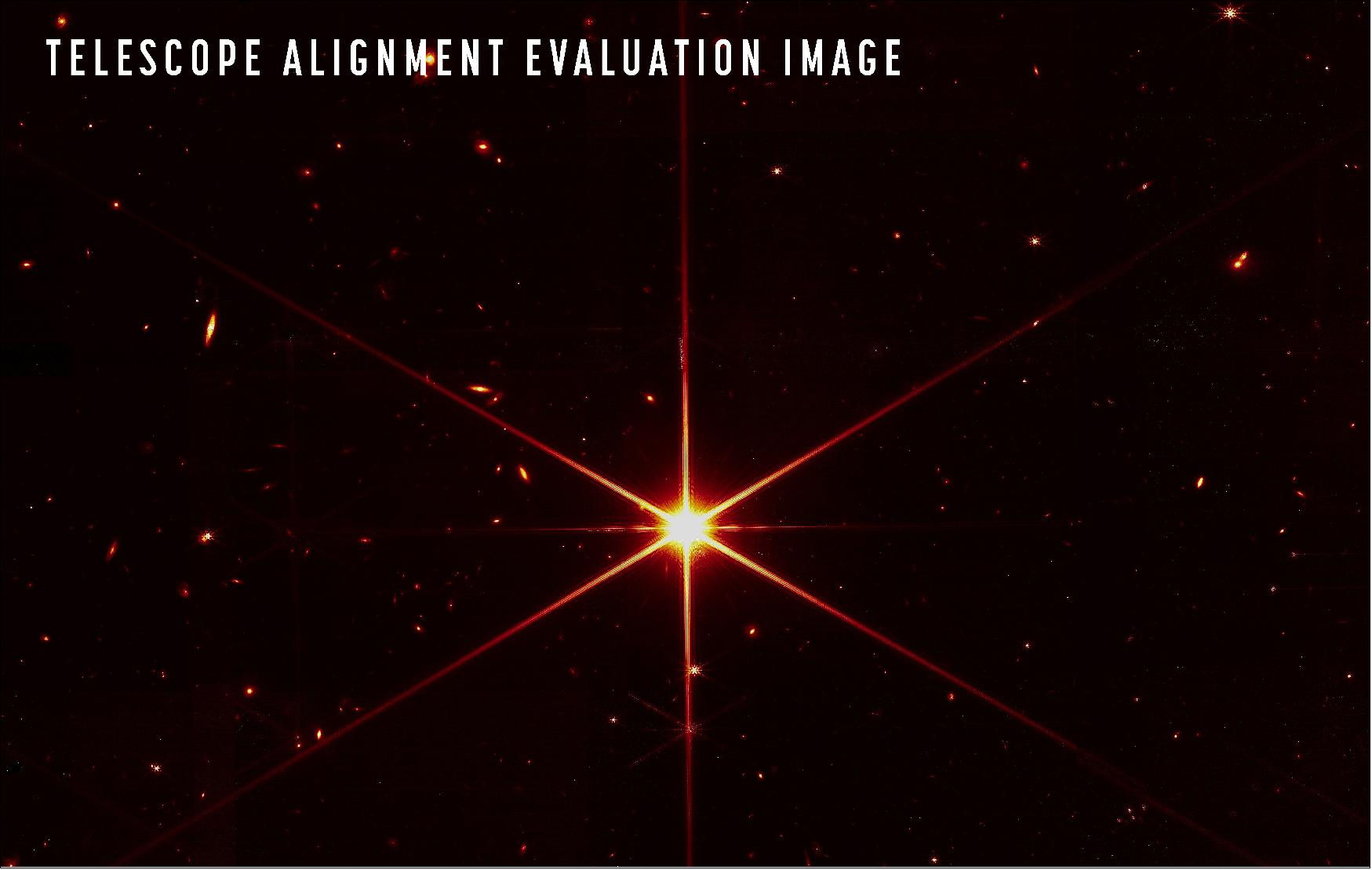
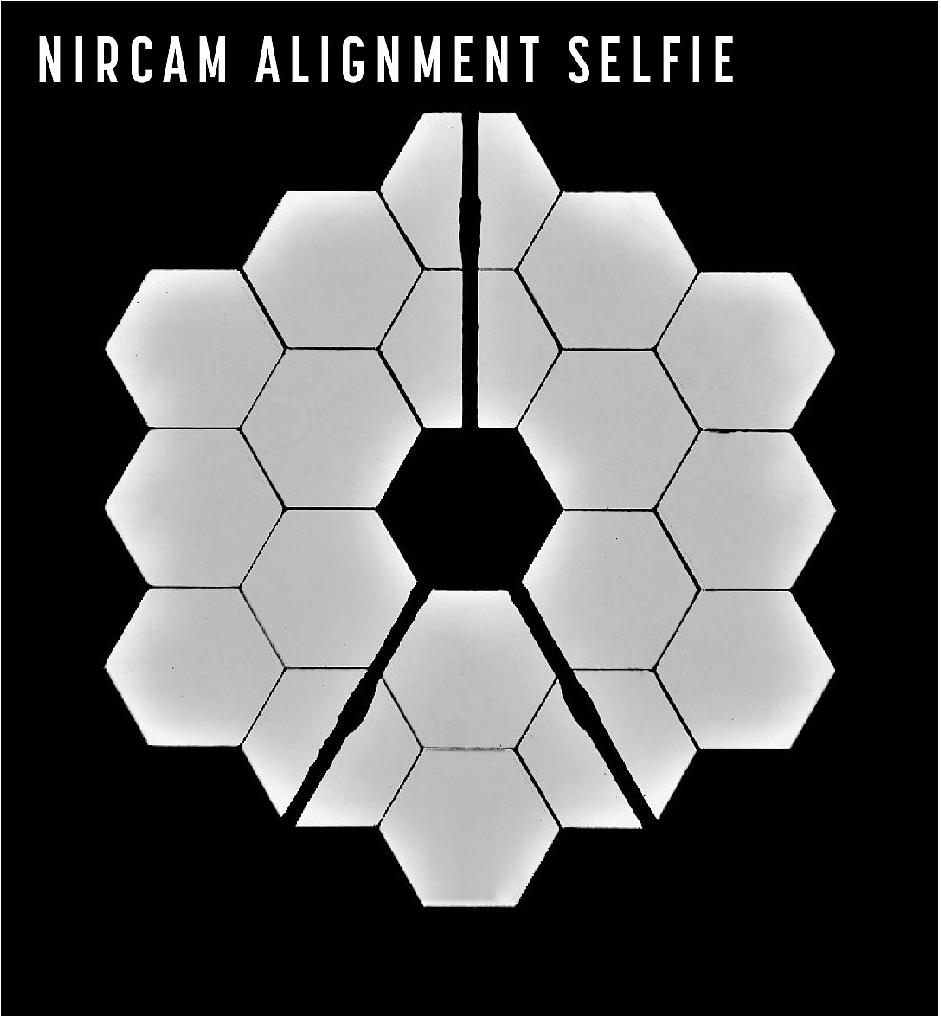
• March 11, 2022: Spectroscopy is an instrument application that astronomers use to better understand the physics of objects in space. 44)
- The spectrographs on board the James Webb Space Telescope (Webb) provide scientists with the data needed to analyse the materials that make up stars, nebulae, galaxies and the atmospheres of planets.
- Light that enters the telescope is split into its different wavelengths by a grating or a prism, forming a spectrum. This spectrum is then focused onto a detector. Light from each chemical element has a unique spectrum, like a fingerprint. The spectrum's pattern is analysed by astronomers to decipher which atoms and molecules are present in the source of light, and understand the physical and chemical characteristics of the source.
- Webb is an international partnership between NASA, the European Space Agency (ESA) and the Canadian Space Agency (CSA).
• March 3, 2022: This week, the Webb team has been working on the fourth stage of mirror alignment, called Coarse Phasing, which measures and corrects smaller height differences between the mirror segments. 45)
- In the meantime this past week, Webb's Near-Infrared Spectrograph (NIRSpec) team successfully finished the check-out and initial characterization of three crucial onboard mechanisms. Today, members of the team join us to share more about the inner workings of this instrument, which was contributed by ESA (European Space Agency):
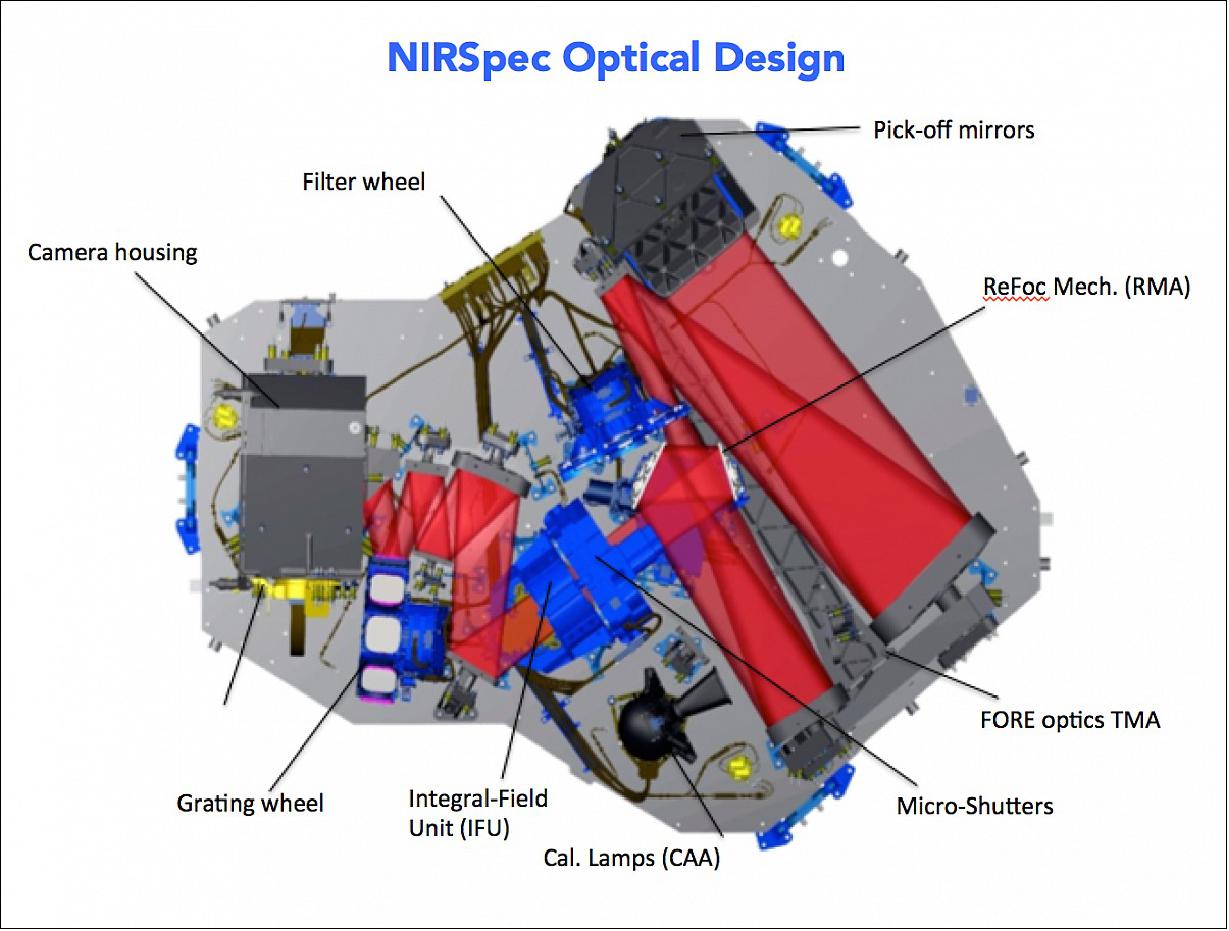
- "To work properly as a spectrograph, NIRSpec has three mechanisms: a Filter Wheel Assembly (FWA), a Grating Wheel Assembly (GWA), and a Refocus Mechanism Assembly (RMA). The gratings in the GWA spread the incoming light over its colors or wavelengths to make a spectrum. The filters in the FWA block the wavelengths that are outside the range of interest to prevent contamination between different optical paths, or ‘orders.' The RMA adjusts the instrument focus.
- "We operated the Filter Wheel Assembly first, cycling it through all eight of its positions in both forward and reverse directions. Those eight filter wheel positions include five long-pass order-separation filters, two finite-band target acquisition filters, and an ‘opaque' position that serves as the instrument shutter. At each position, we recorded a set of reference data. This data showed us how well the wheel was moving and how accurately it settled into each position. Between each FWA position, we downloaded ‘high-capacity buffer' data from the positioning sensors, and the NIRSpec team analyzed the data. The data showed that the wheel moved very well even in the first attempt.
- "We then used a very similar procedure for the Grating Wheel Assembly, which also performed excellently the first time. The GWA is shaped like a miniature Ferris wheel and holds eight optical elements, consisting of six diffraction gratings, one prism, and a mirror. These dispersers separate the incoming light by wavelength, generating spectra that are detected by NIRSpec's sensor chips.
- "The Refocus Mechanism Assembly includes a linear translation stage that holds two flat mirrors. It will be used to fine-tune the instrument focus, compensating for any change in the overall focus position of the Webb telescope that may occur throughout the observatory's lifetime. After various initial retrievals of the RMA telemetry acquisition chain, the mechanism was moved forward a few hundred steps from launch position. Just like with the FWA and GWA, we used high-capacity buffer readouts to collect reference datasets. After the initial move, we commanded the RMA mirrors to their previous best focus position; successful completions of this test showed us that the RMA is a well-behaved and healthy mechanism.
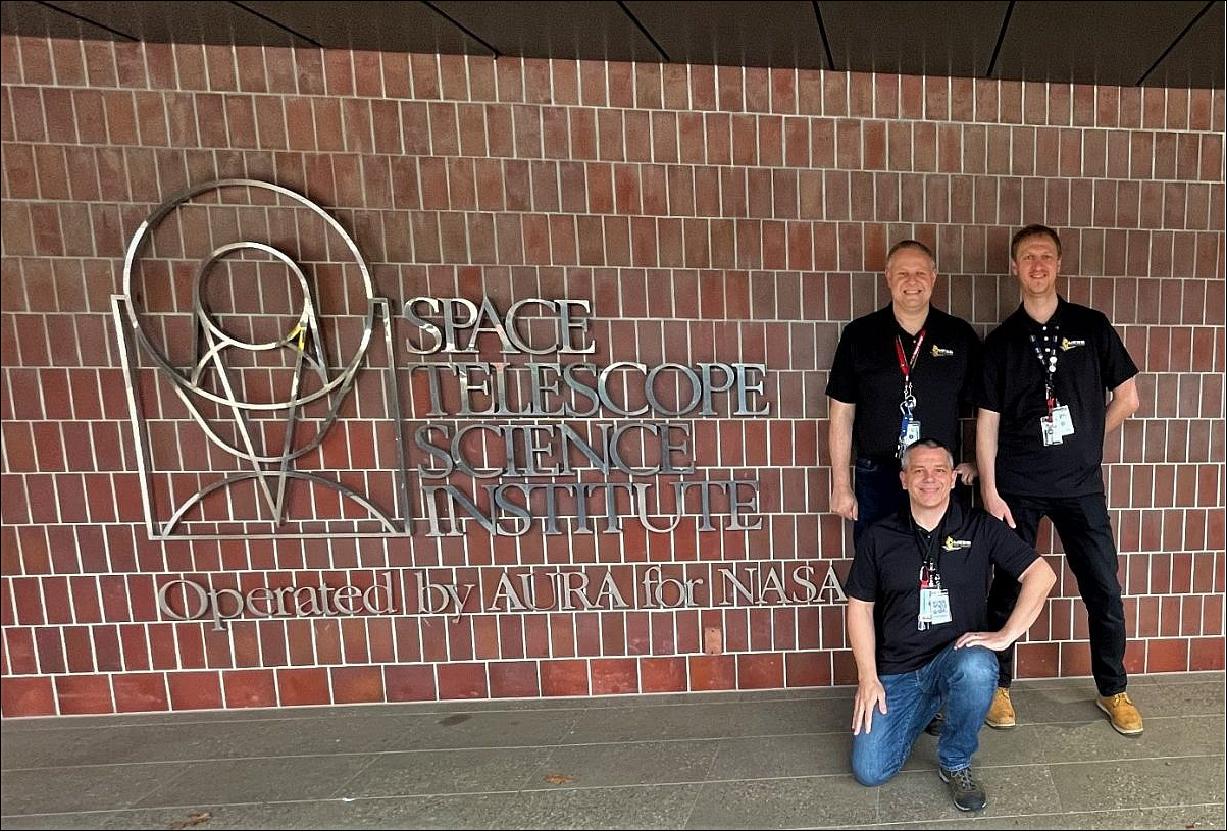
• February 25, 2022: Webb continues on its path to becoming a focused observatory. The team has successfully worked through the second and third out of seven total phases of mirror alignment. With the completion of these phases, called Segment Alignment and Image Stacking, the team will now begin making smaller adjustments to the positions of Webb's mirrors. 46)
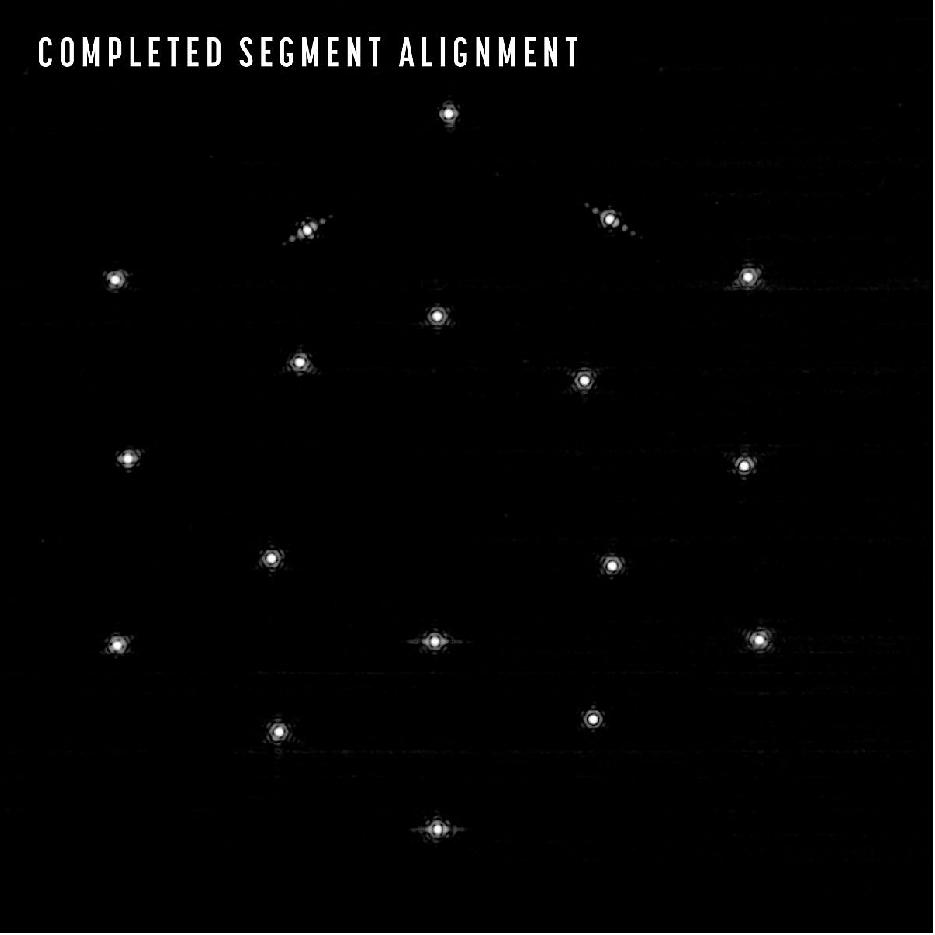
- After moving what were 18 scattered dots of starlight into Webb's signature hexagonal formation, the team refined each mirror segment's image by making minor adjustments, while also changing the alignment of Webb's secondary mirror. The completion of this process, known as Segment Alignment, was a key step prior to overlapping the light from all the mirrors so that they can work in unison.
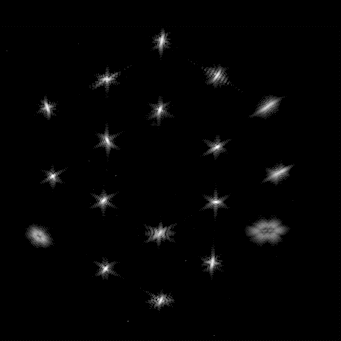
- Once Segment Alignment was achieved, the focused dots reflected by each mirror were then stacked on top of each other, delivering photons of light from each segment to the same location on NIRCam's sensor. During this process, called Image Stacking, the team activated sets of six mirrors at a time and commanded them to repoint their light to overlap, until all dots of starlight overlapped with each other.
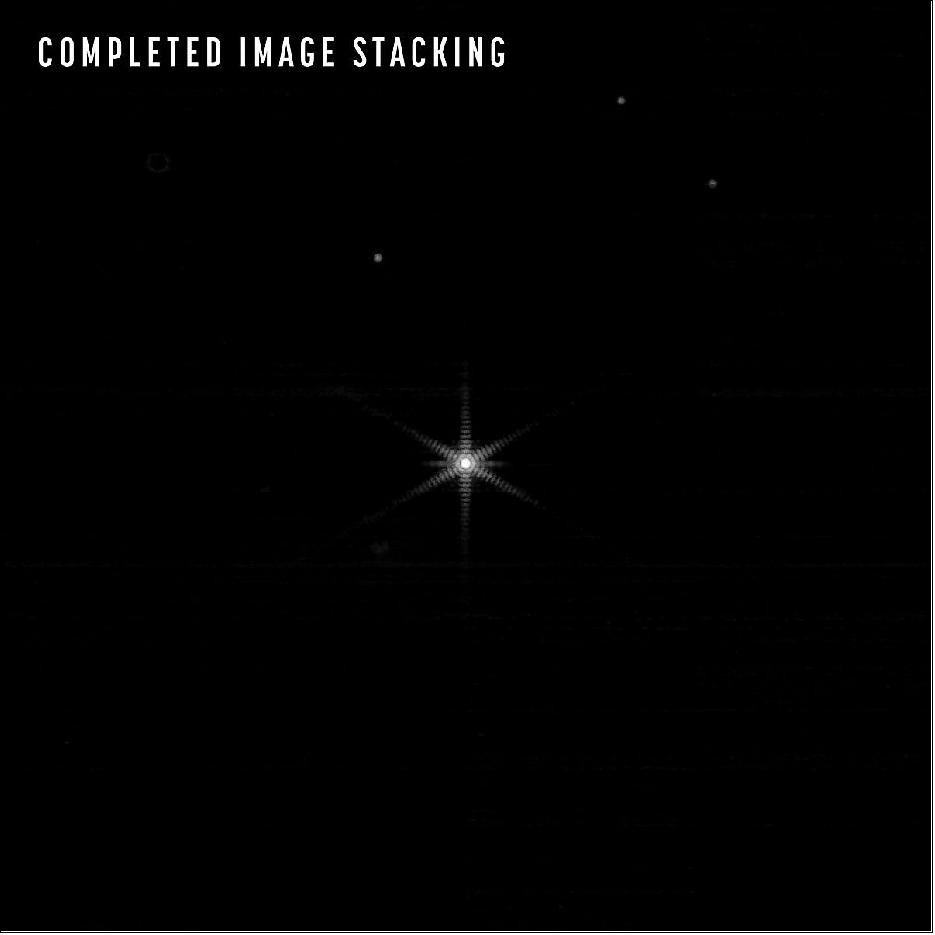
- "We still have work to do, but we are increasingly pleased with the results we're seeing," said Lee Feinberg, optical telescope element manager for Webb at NASA's Goddard Space Flight Center. "Years of planning and testing are paying dividends, and the team could not be more excited to see what the next few weeks and months bring."
- Although Image Stacking put all the light from a star in one place on NIRCam's detector, the mirror segments are still acting as 18 small telescopes rather than one big one. The segments now need to be lined up to each other with an accuracy smaller than the wavelength of the light.
- The team is now starting the fourth phase of mirror alignment, known as Coarse Phasing, where NIRCam is used to capture light spectra from 20 separate pairings of mirror segments. This helps the team identify and correct vertical displacement between the mirror segments, or small differences in their heights. This will make the single dot of starlight progressively sharper and more focused in the coming weeks.
• February 11, 2022: The James Webb Space Telescope is nearing completion of the first phase of the months-long process of aligning the observatory's primary mirror using the Near Infrared Camera (NIRCam) instrument. 47) 48)
- The team's challenge was twofold: confirm that NIRCam was ready to collect light from celestial objects, and then identify starlight from the same star in each of the 18 primary mirror segments. The result is an image mosaic of 18 randomly organized dots of starlight, the product of Webb's unaligned mirror segments all reflecting light from the same star back at Webb's secondary mirror and into NIRCam's detectors.
- "The entire Webb team is ecstatic at how well the first steps of taking images and aligning the telescope are proceeding. We were so happy to see that light makes its way into NIRCam," said Marcia Rieke, principal investigator for the NIRCam instrument and regents professor of astronomy, University of Arizona, USA.
- During the image capturing process that began on 2 February, Webb was repointed to 156 different positions around the predicted location of the star and generated 1560 images using NIRCam's 10 detectors, amounting to 54 gigabytes of raw data. The entire process lasted nearly 25 hours, but notedly the observatory was able to locate the target star in each of its mirror segments within the first six hours and 16 exposures. These images were then stitched together to produce a single, large mosaic that captures the signature of each primary mirror segment in one frame. The images shown here are only a center portion of that larger mosaic, a huge image with over 2 billion pixels.
- "This initial search covered an area about the size of the full Moon because the segment dots could potentially have been that spread out on the sky," said Marshall Perrin, deputy telescope scientist for Webb and astronomer at the Space Telescope Science Institute in Baltimore, USA. "Taking so much data right on the first day required all of Webb's science operations and data processing systems here on Earth working smoothly with the observatory in space right from the start. And we found light from all 18 segments very near the center early in that search! This is a great starting point for mirror alignment."
- Each unique dot visible in the image mosaic is the same star as imaged by each of Webb's 18 primary mirror segments, a treasure trove of detail that optics experts and engineers will use to align the entire telescope. This activity determined the post-deployment alignment positions of every mirror segment, which is the critical first step in bringing the entire observatory into a functional alignment for scientific operations.
- NIRCam is the observatory's wavefront sensor and a key imager. It was intentionally selected to be used for Webb's initial alignment steps because it has a wide field of view and the unique capability to safely operate at higher temperatures than the other instruments. It is also packed with customized components that were designed to specifically aid in the process. NIRCam will be used throughout nearly the entire alignment of the telescope's mirrors. It is, however, important to note that NIRCam is operating far above its ideal temperature while capturing these initial engineering images, and visual artifacts can be seen in the mosaic. The impact of these artifacts will lessen significantly as Webb draws closer to its ideal cryogenic operating temperatures.
- "Launching Webb to space was of course an exciting event, but for scientists and optical engineers, this is a pinnacle moment, when light from a star is successfully making its way through the system down onto a detector," said Michael McElwain, Webb observatory project scientist, NASA's Goddard Space Flight Center.
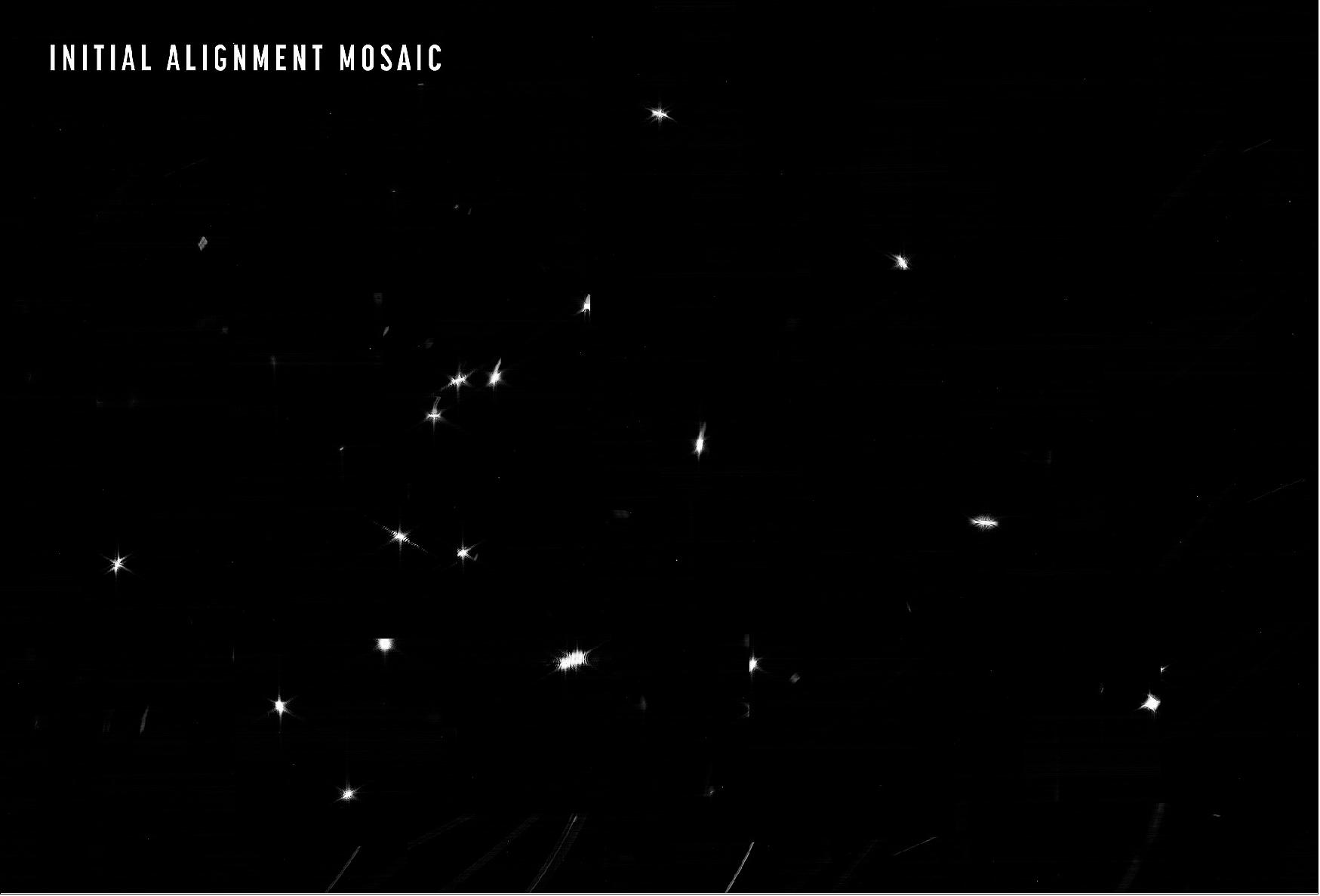
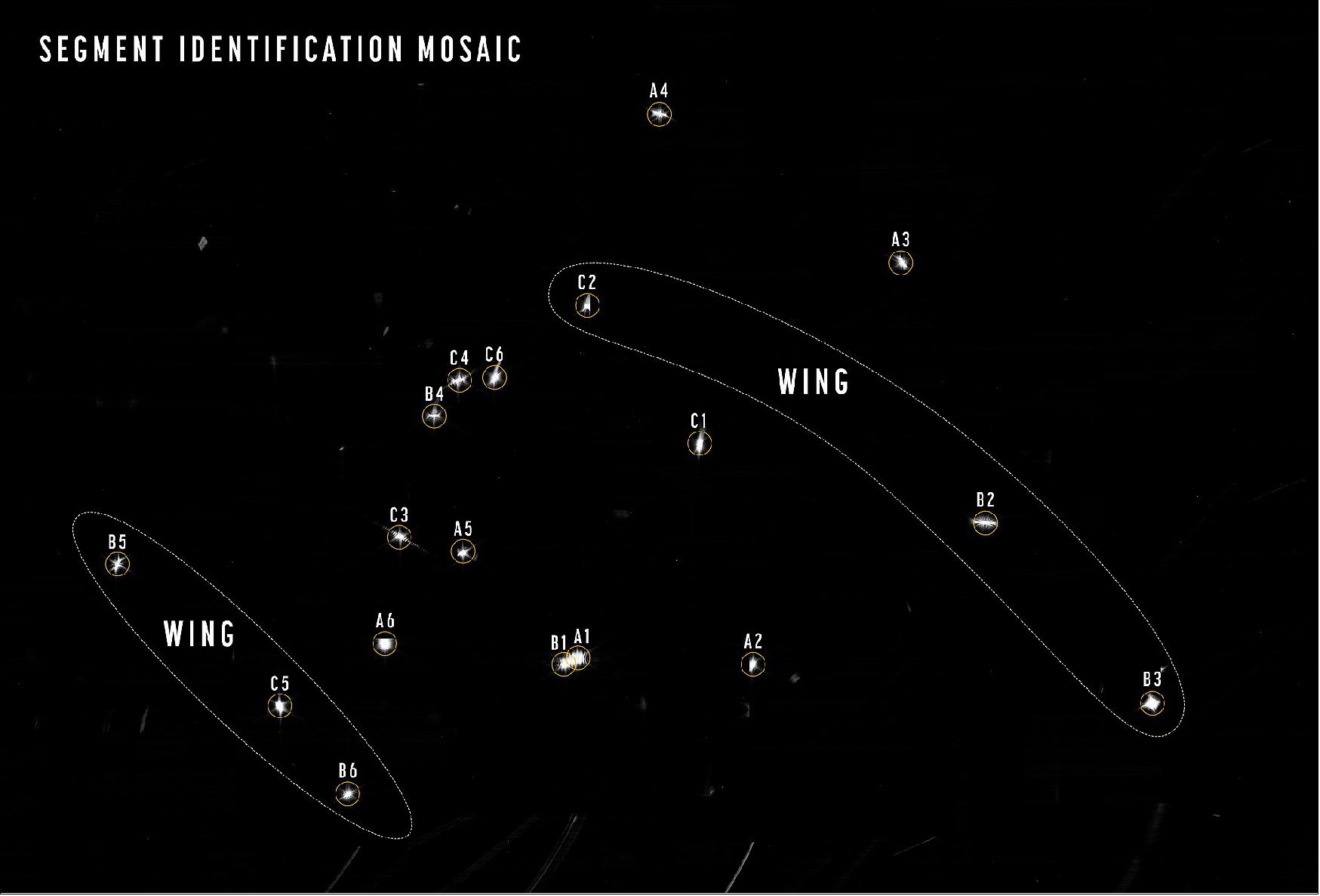
- Moving forward, Webb's images will only become clearer, more detail-laden, and more intricate as its other three instruments arrive at their intended cryogenic operating temperatures and begin capturing data. The first scientific images are expected to be delivered to the world in the summer. Though this is a big moment, confirming that Webb is a functional telescope, there is much ahead to be done in the coming months to prepare the observatory for full scientific operations using all four of its instruments.
• January 31, 2022: Following Webb's arrival at its orbital destination around Lagrange Point 2 (L2) on Jan. 24, the mission operations team began working its way through a critical series of steps: powering on all the science instruments, turning off heaters to begin a long cooldown process, and ultimately capturing the first photons on Webb's primary camera to enable a months-long alignment of the telescope. 49)
- While the MIRI instrument and some instrument components were powered on in the weeks after Webb's Dec. 25 launch, the team didn't finish turning on the remaining three instruments – NIRCam, NIRSpec, and FGS/NIRISS – until the past few days.
- The mission operations team's next major step is to turn off instrument heaters. The heaters were necessary to keep critical optics warm to prevent the risk of water and ice condensation. As the instruments meet pre-defined criteria for overall temperatures, the team is shutting off these heaters to allow the instruments to restart the months-long process of cooling to final temperatures.
- When NIRCam reaches 120 kelvins (approximately -244 degrees Fahrenheit, or -153 degrees Celsius), Webb's optics team will be ready to begin meticulously moving the 18 primary mirror segments to form a single mirror surface. The team has selected the star HD 84406 as its target to begin this process. It will be the first object NIRCam "sees" when photons of light hit the instrument's powered-on detectors. The process will essentially create an image of 18 random, blurry points of light. For the first few weeks of mirror alignment, the team will keep the instrument trained on the star while they make microscopic adjustments to the mirror segments; ultimately that collection of 18 blurry dots will become a focused image of a single star. Cooling of the telescope and instruments will also continue over the next month, with the near-infrared instruments ultimately reaching 37-39 kelvins. The cryocooler will cool MIRI to 6 kelvins in the following months.
• January 24, 2022: Today, at 2 p.m. EST, Webb fired its onboard thrusters for nearly five minutes (297 seconds) to complete the final postlaunch course correction to Webb's trajectory. This mid-course correction burn inserted Webb toward its final orbit around the second Sun-Earth Lagrange point, or L2, nearly 1 million miles away from the Earth. 50)
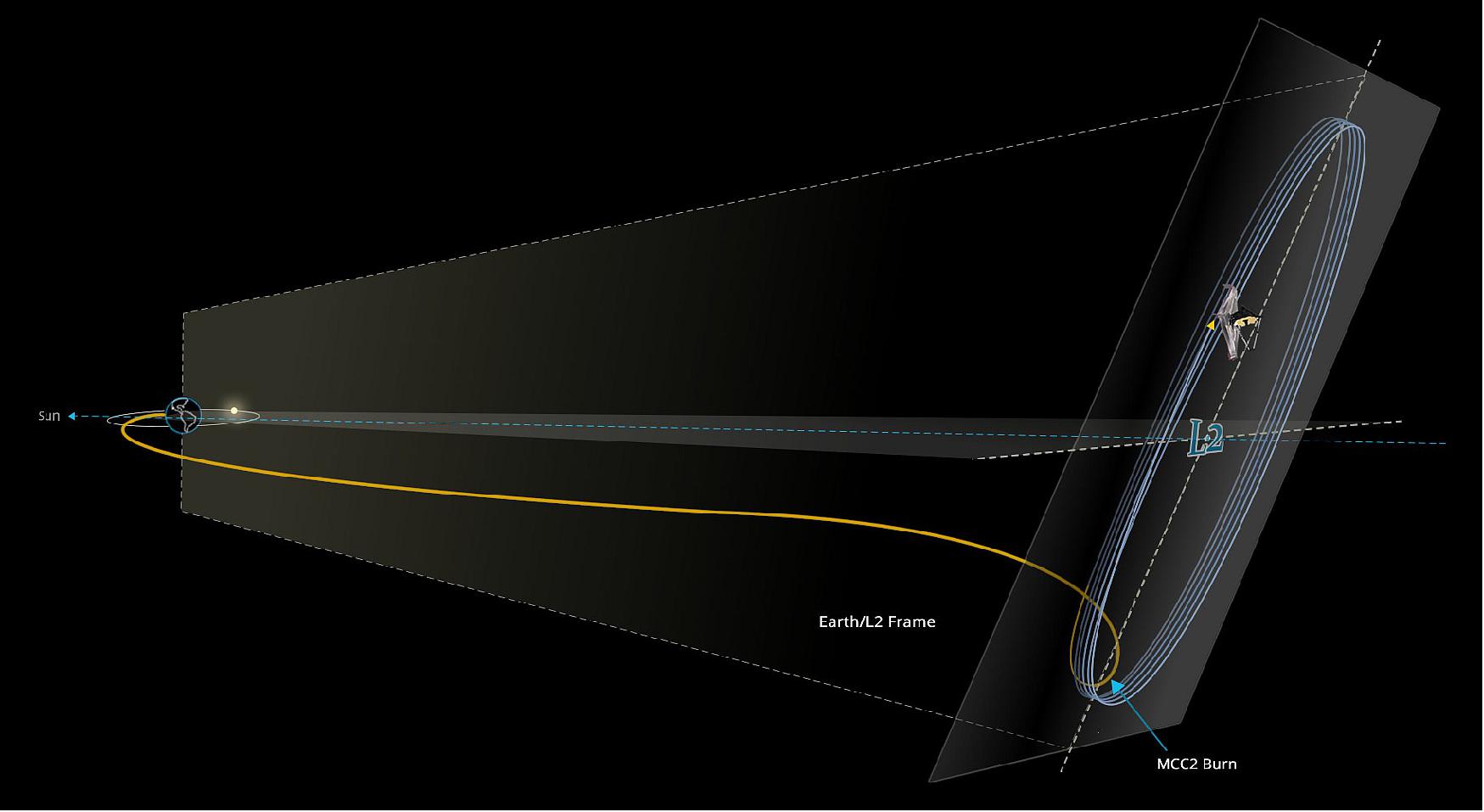
- "Webb, welcome home!" said NASA Administrator Bill Nelson. "Congratulations to the team for all of their hard work ensuring Webb's safe arrival at L2 today. We're one step closer to uncovering the mysteries of the universe. And I can't wait to see Webb's first new views of the universe this summer!"
- Webb's orbit will allow it a wide view of the cosmos at any given moment, as well as the opportunity for its telescope optics and scientific instruments to get cold enough to function and perform optimal science. Webb has used as little propellant as possible for course corrections while it travels out to the realm of L2, to leave as much remaining propellant as possible for Webb's ordinary operations over its lifetime: station-keeping (small adjustments to keep Webb in its desired orbit) and momentum unloading (to counteract the effects of solar radiation pressure on the huge sunshield).
- "During the past month, JWST has achieved amazing success and is a tribute to all the folks who spent many years and even decades to ensure mission success," said Bill Ochs, Webb project manager at NASA's Goddard Space Flight Center. "We are now on the verge of aligning the mirrors, instrument activation and commissioning, and the start of wondrous and astonishing discoveries."
- Now that Webb's primary mirror segments and secondary mirror have been deployed from their launch positions, engineers will begin the sophisticated three-month process of aligning the telescope's optics to nearly nanometer precision.
• January 12. 2022: Webb has begun the detailed process of fine-tuning its individual optics into one huge, precise telescope. 51)
- Engineers first commanded actuators – 126 devices that will move and shape the primary mirror segments, and six devices that will position the secondary mirror – to verify that all are working as expected after launch. The team also commanded actuators that guide Webb's fine steering mirror to make minor movements, confirming they are working as expected. The fine steering mirror is critical to the process of image stabilization.
- Ground teams have now begun instructing the primary mirror segments and secondary mirror to move from their stowed-for-launch configuration, off of snubbers that kept them snug and safe from rattling from vibration. These movements will take at least ten days, after which engineers can begin the three-month process of aligning the segments to perform as a single mirror.
• January 8, 2022: NASA's James Webb Space Telescope team fully deployed its 21-foot (6.4 m), gold-coated primary mirror, successfully completing the final stage of all major spacecraft deployments to prepare for science operations. 52)
- A joint effort with the European Space Agency (ESA) and Canadian Space Agency, the Webb mission will explore every phase of cosmic history – from within our solar system to the most distant observable galaxies in the early universe.
- "Today, NASA achieved another engineering milestone decades in the making. While the journey is not complete, I join the Webb team in breathing a little easier and imagining the future breakthroughs bound to inspire the world," said NASA Administrator Bill Nelson. "The James Webb Space Telescope is an unprecedented mission that is on the precipice of seeing the light from the first galaxies and discovering the mysteries of our universe. Each feat already achieved and future accomplishment is a testament to the thousands of innovators who poured their life's passion into this mission."
- The two wings of Webb's primary mirror had been folded to fit inside the nose cone of an Arianespace Ariane 5 rocket prior to launch. After more than a week of other critical spacecraft deployments, the Webb team began remotely unfolding the hexagonal segments of the primary mirror, the largest ever launched into space. This was a multi-day process, with the first side deployed Jan. 7 and the second Jan. 8.
- Mission Operations Center ground control at the Space Telescope Science Institute in Baltimore began deploying the second side panel of the mirror at 8:53 a.m. EST. Once it extended and latched into position at 1:17 p.m. EST, the team declared all major deployments successfully completed.
- The world's largest and most complex space science telescope will now begin moving its 18 primary mirror segments to align the telescope optics. The ground team will command 126 actuators on the backsides of the segments to flex each mirror – an alignment that will take months to complete. Then the team will calibrate the science instruments prior to delivering Webb's first images this summer.
- "I am so proud of the team – spanning continents and decades – that delivered this first-of-its kind achievement," said Thomas Zurbuchen, associate administrator for the Science Mission Directorate in NASA Headquarters in Washington. "Webb's successful deployment exemplifies the best of what NASA has to offer: the willingness to attempt bold and challenging things in the name of discoveries still unknown."
- Soon, Webb will also undergo a third mid-course correction burn – one of three planned to place the telescope precisely in orbit around the second Lagrange point, commonly known as L2, nearly 1 million miles from Earth. This is Webb's final orbital position, where its sunshield will protect it from light from the Sun, Earth, and Moon that could interfere with observations of infrared light. Webb is designed to peer back over 13.5 billion years to capture infrared light from celestial objects, with much higher resolution than ever before, and to study our own solar system as well as distant worlds.
- "The successful completion of all of the Webb Space Telescope's deployments is historic," said Gregory L. Robinson, Webb program director at NASA Headquarters. "This is the first time a NASA-led mission has ever attempted to complete a complex sequence to unfold an observatory in space – a remarkable feat for our team, NASA, and the world."
- NASA's Science Mission Directorate oversees the mission. NASA's Goddard Space Flight Center in Greenbelt, Maryland, manages the project for the agency and oversees the Space Telescope Science Institute, Northrop Grumman, and other mission partners. In addition to Goddard, several NASA centers contributed to the project, including Johnson Space Center in Houston, the Jet Propulsion Laboratory in Pasadena, Marshall Space Flight Center in Huntsville, Alabama, Ames Research Center in Silicon Valley, and others.

• January 5, 2022: While the Webb team was tensioning the sunshield, other activities were also taking place among the instruments. One milestone: unlocking the Mid-Infrared Instrument (MIRI) Contamination Control Cover. We've asked Gillian Wright, European principal investigator for MIRI, to tell us about it. 53)
- "MIRI has a Contamination Control Cover, because the constraints of its extra-cold operating temperature mean that it is not possible to include other means of dealing with ice contamination, such as heaters for sensitive components. For launch it was safest to have this cover locked, and the timing for operating it is driven by the temperatures of the observatory.
- "To unlock the cover, we first had to power on our Instrument Control Electronics and confirm that they were functioning correctly. Then the commands to the cover could be sent. After successfully completing the tests and unlocking the cover, the instrument control electronics were then powered off before the next steps on the sunshield tensioning activities. This key step for MIRI was monitored remotely by team members in Europe, ready to provide assistance if it were needed.
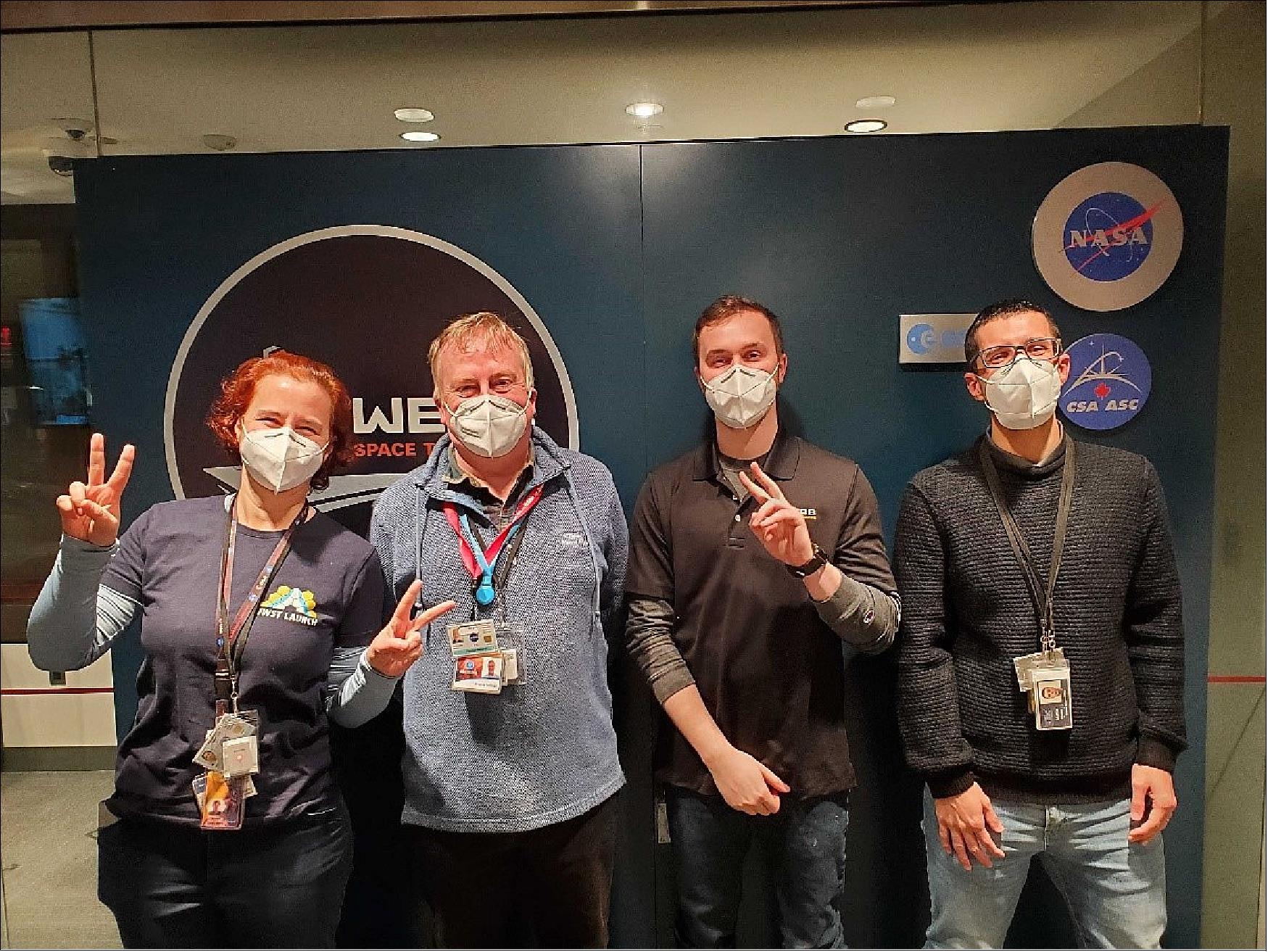
• January 5, 2022: Today, Webb teams successfully deployed the observatory's secondary mirror support structure. When light from the distant universe hits Webb's iconic 18 gold primary mirrors, it will reflect off and hit the smaller, 2.4-foot (0.74 m) secondary mirror, which will direct the light into its instruments. The secondary mirror is supported by three lightweight deployable struts that are each almost 25 feet long and are designed to withstand the space environment. Specialized heating systems were used to warm up the joints and motors needed for seamless operation. 54)
- "Another banner day for JWST," said Bill Ochs, Webb project manager at NASA's Goddard Space Flight Center, as he congratulated the secondary mirror deployment team at the Mission Operations Center in Baltimore. "This is unbelievable…We're about 600,000 miles from Earth, and we actually have a telescope."
- The deployment process began at approximately 9:52 a.m. EST, and the secondary mirror finished moving into its extended position at about 11:28 a.m. EST. The secondary mirror support structure was then latched at about 11:51 a.m. EST. At approximately 12:23 p.m. EST, engineers confirmed that the structure was fully secured and locked into place and the deployment was complete.
- "The world's most sophisticated tripod has deployed," said Lee Feinberg, optical telescope element manager for Webb at Goddard. "That's really the way one can think of it. Webb's secondary mirror had to deploy in microgravity, and in extremely cold temperatures, and it ultimately had to work the first time without error. It also had to deploy, position, and lock itself into place to a tolerance of about one and a half millimeters, and then it has to stay extremely stable while the telescope points to different places in the sky – and that's all for a secondary mirror support structure that is over 7 meters in length."
- Next Webb will deploy an important radiator system known as the aft deployable instrument radiator (ADIR), which helps shed heat away from its instruments and mirrors.
• January 4, 2022: The James Webb Space Telescope team has fully deployed the spacecraft's 70-foot sunshield, a key milestone in preparing it for science operations. 55) 56)
- The sunshield – about the size of a tennis court at full size – was folded to fit inside the payload area of an Arianespace Ariane 5 rocket's nose cone prior to launch. The Webb team began remotely deploying the sunshield Dec. 28, 2021, three days after launch.
- "This is the first time anyone has ever attempted to put a telescope this large into space," said Thomas Zurbuchen, associate administrator for NASA's Science Mission Directorate at the agency's headquarters in Washington. "Webb required not only careful assembly but also careful deployments. The success of its most challenging deployment – the sunshield – is an incredible testament to the human ingenuity and engineering skill that will enable Webb to accomplish its science goals."
- The five-layered sunshield will protect the telescope from the light and heat of the Sun, Earth, and Moon. Each plastic sheet is about as thin as a human hair and coated with reflective metal, providing protection on the order of more than SPF 1 million. Together, the five layers reduce exposure from the Sun from over 200 kW of solar energy to a fraction of a watt.
- This protection is crucial to keep Webb's scientific instruments at temperatures of 40 kelvins, or under minus 380 degrees Fahrenheit – cold enough to see the faint infrared light that Webb seeks to observe.
- "Unfolding Webb's sunshield in space is an incredible milestone, crucial to the success of the mission," said Gregory L. Robinson, Webb's program director at NASA Headquarters. "Thousands of parts had to work with precision for this marvel of engineering to fully unfurl. The team has accomplished an audacious feat with the complexity of this deployment – one of the boldest undertakings yet for Webb."
- The unfolding occurred in the following order, over the course of eight days:
a) Two pallet structures – forward and aft – unfolded to bring the observatory to its full 70-foot length
b) The Deployable Tower Assembly deployed to separate the telescope and instruments from the sunshield and the main body of the spacecraft, allowing room for the sunshield to fully deploy
c) The aft momentum flap and membrane covers were released and deployed
d) The mid-booms deployed, expanding perpendicular to the pallet structures and allowing the sunshield to extend to its full width of 47 feet
e) Finally, at approximately 11:59 a.m. EST Tuesday (Jan. 4), the sunshield was fully tensioned and secured into position, marking the completion of the sunshield deployment.
- The unfolding and tensioning of the sunshield involved 139 of Webb's 178 release mechanisms, 70 hinge assemblies, eight deployment motors, roughly 400 pulleys, and 90 individual cables totaling roughly one quarter of a mile in length. The team also paused deployment operations for a day to work on optimizing Webb's power systems and tensioning motors, to ensure Webb was in prime condition before beginning the major work of sunshield tensioning.
- "The sunshield is remarkable as it will protect the telescope on this historic mission," said Jim Flynn, sunshield manager at Northrop Grumman, NASA's primary contractor for Webb. "This milestone represents the pioneering spirit of thousands of engineers, scientists, and technicians who spent significant portions of their careers developing, designing, manufacturing, and testing this first-of-its-kind space technology."
- The world's largest and most complex space science observatory has another 5 1/2 months of setup still to come, including deployment of the secondary mirror and primary mirror wings, alignment of the telescope optics, and calibration of the science instruments. After that, Webb will deliver its first images.
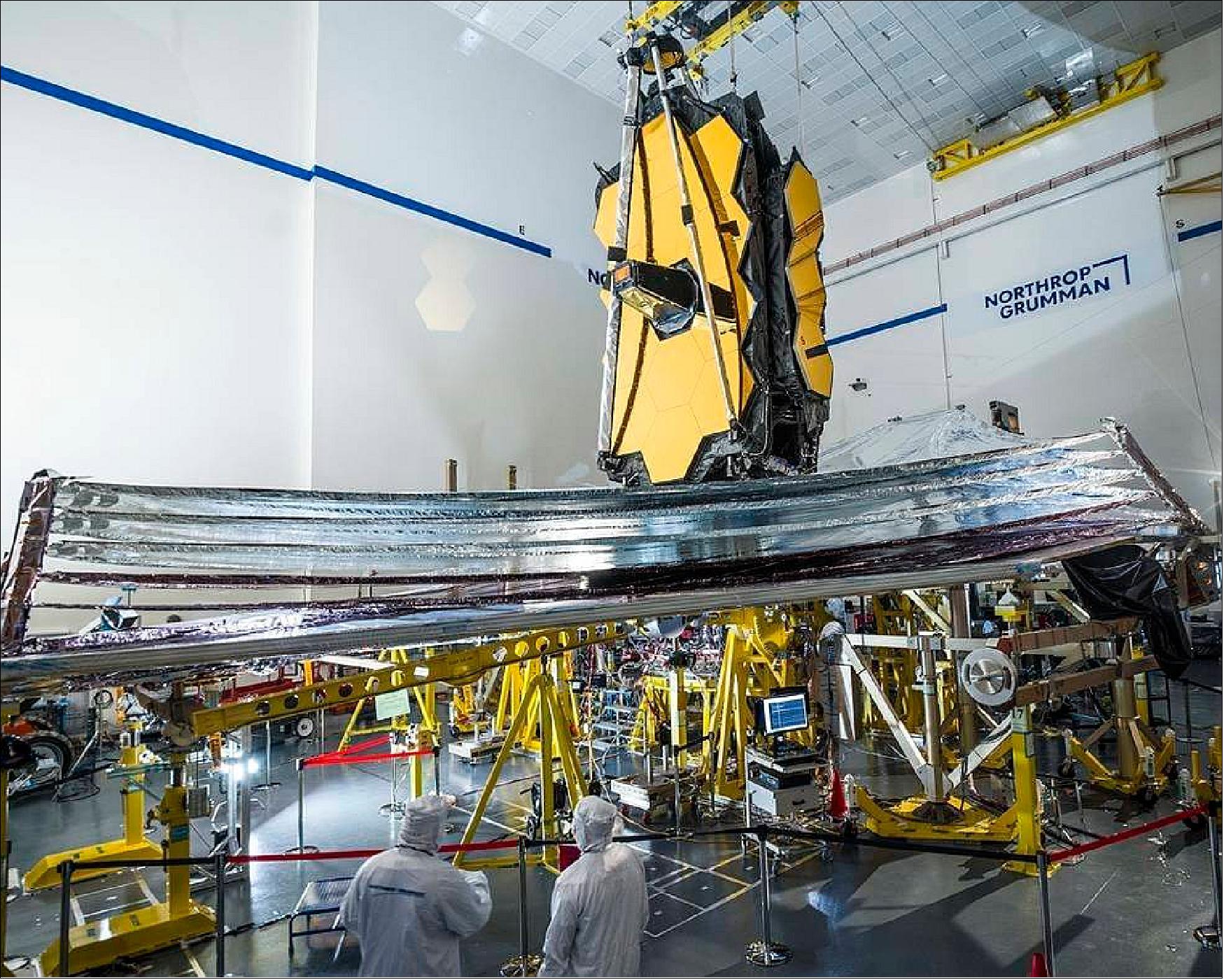
- The telescope's revolutionary technology will explore every phase of cosmic history – from within our solar system to the most distant observable galaxies in the early universe, to everything in between. Webb will reveal new and unexpected discoveries and help humanity understand the origins of the universe and our place in it.
- The James Webb Space Telescope is an international partnership with the ESA (European Space Agency) and the Canadian Space Agency. NASA Headquarters oversees the mission. NASA's Goddard Space Flight Center in Greenbelt, Maryland, manages Webb for the agency and oversees work on the mission performed by the Space Telescope Science Institute, Northrop Grumman, and other mission partners. In addition to Goddard, several NASA centers contributed to the project, including the agency's Johnson Space Center in Houston, Jet Propulsion Laboratory in Southern California, Marshall Space Flight Center in Huntsville, Alabama, Ames Research Center in California's Silicon Valley, and others.
• January 4, 2022: Spacecraft controllers started the final steps in the deployment of the sunshield of the James Webb Space Telescope Jan. 3 after fixing two minor issues with the spacecraft. 57)
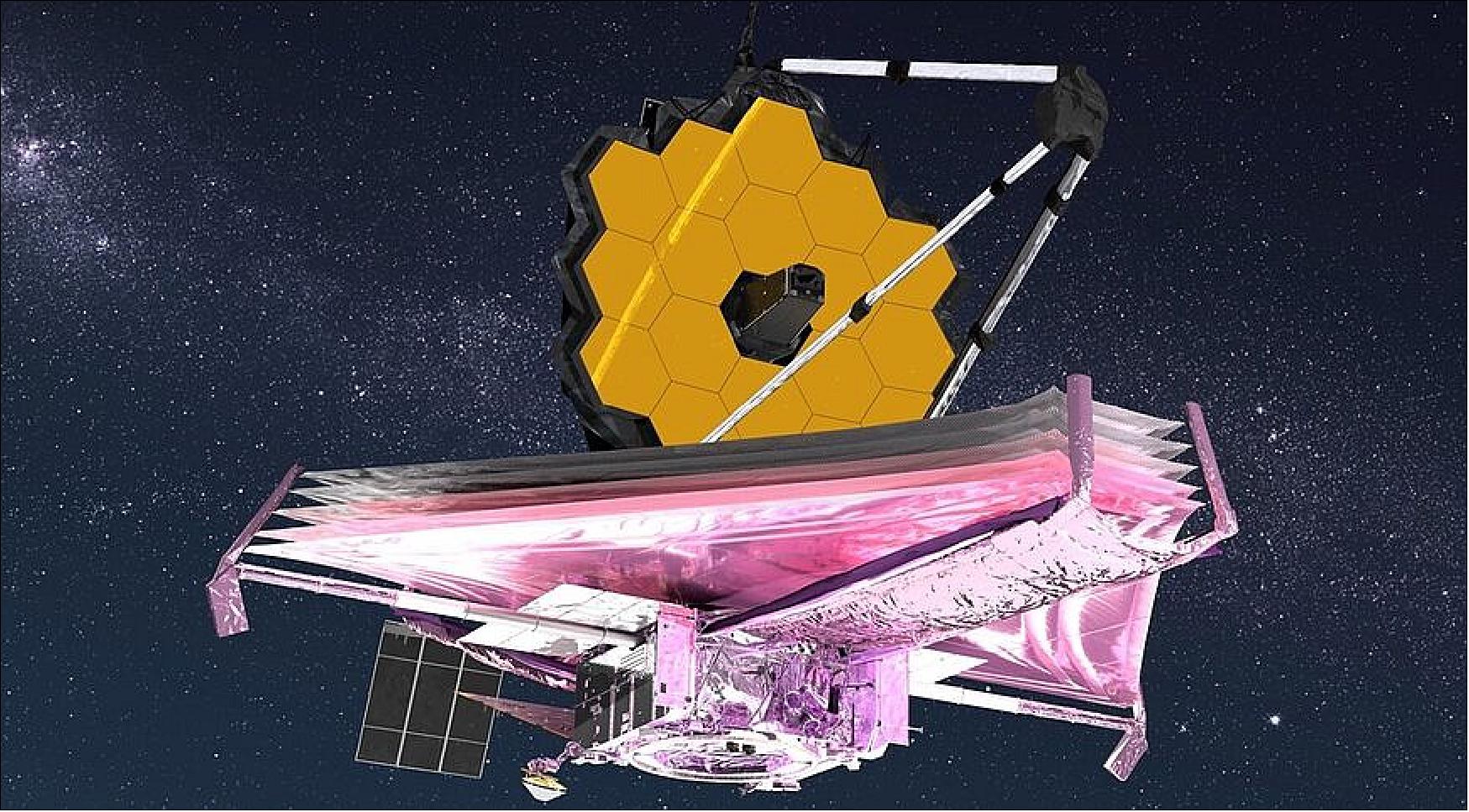
- NASA announced late Jan. 3 that it had completed the tensioning of three of the five layers of aluminum-coated Kapton that comprise the sunshield, which blocks sunlight from reaching the telescope and its instruments to cool them. That tensioning process, involving a series of motors, pulleys and cables, stretches the layers into the final shape and ensures proper separation between the layers.
- That work appeared to be going faster than expected. During a briefing with reporters around midday Jan. 3, Bill Ochs, JWST project manager at NASA's Goddard Space Flight Center, said tensioning of the outermost of the five layers had started, with plans to work inward layer by layer.
- "Today we are focused on tensioning layer 1. Layer 1 will take most of the day," he said. "Tomorrow through Wednesday we will deploy layers 2 through 5."
- With three of the five layers already deployed, though, NASA now expects to complete the final two layers, and thus the overall sunshield deployment process, Jan. 4. "This was the hardest part to test on the ground, so it feels awesome to have everything go so well today," said James Cooper, JWST sunshield manager at Goddard, in a NASA statement late Jan. 3. "The Northrop and NASA team is doing great work, and we look forward to tensioning the remaining layers."
- The tensioning was originally scheduled to start the day after the deployment of two booms on either side of the spacecraft that extended the sunshield to its full area. However, that deployment took longer than expected Dec. 31, and managers decided to give controllers the day off Jan. 1 to rest.
- Engineers then spent Jan. 2 resolving two minor issues with the spacecraft. One involved what Ochs described as a "preset max duty cycle" setting in the solar arrays that kept them from producing enough power to meet all the spacecraft needs. As a result, the spacecraft was using its battery in addition to power from the arrays.
- Amy Lo, vehicle engineering lead for JWST and prime contractor Northrop Grumman, said at the media briefing that controllers "rebalanced" the array by adjusting settings on each of its five individual panels. "We got the arrays to where they ought to be in order to provide the power that we need on Webb. We're power-positive, the arrays look good," she said.
- The other issue involved motors used for the tensioning process whose temperatures were higher than expected although still within conservative engineering margins. Controllers adjusted the orientation of the spacecraft temporarily to reduce the amount of sunlight hitting, and heating up, the motors. "They're nice and cool," Lo said of the motors. "We've got a lot of margin now on our temperature."
- Once the sunshield is fully tensioned, spacecraft controllers will turn their attention to JWST's mirrors. Ochs said the tripod holding the secondary mirror could be deployed late in the week, followed over the weekend by two wings holding segments of the primary mirror as well as an aft radiator.
- Getting the sunshield in place, though, will be a major step toward completing the full deployment of JWST. Ochs estimated that, once the sunshield is fully tensioned, the mission will have retired 70–75% of the 344 single-point failures in the spacecraft.
- "When I get asked, ‘What keeps you up the most at night?' obviously it's the sunshield deployment," he said. "I don't expect any drama. I always tell folks, the best thing for operations is boring, and that's what we anticipate over the next three days, to be boring. I think we'll all breathe a sigh of relief once we get to the final layer, layer 5, tensioning. But I don't expect drama."
• December 29, 2021: After a successful launch of NASA's James Webb Space Telescope Dec. 25, and completion of two mid-course correction maneuvers, the Webb team has analyzed its initial trajectory and determined the observatory should have enough propellant to allow support of science operations in orbit for significantly more than a 10-year science lifetime. (The minimum baseline for the mission is five years.) 58)
- The analysis shows that less propellant than originally planned for is needed to correct Webb's trajectory toward its final orbit around L2, a point of gravitational balance on the far side of Earth away from the Sun. Consequently, Webb will have much more than the baseline estimate of propellant – though many factors could ultimately affect Webb's duration of operation.
- Webb has rocket propellant onboard not only for midcourse correction and insertion into orbit around L2, but also for necessary functions during the life of the mission, including "station keeping" maneuvers – small thruster burns to adjust Webb's orbit — as well as what's known as momentum management, which maintains Webb's orientation in space.
- The extra propellant is largely due to the precision of the Arianespace Ariane 5 launch, which exceeded the requirements needed to put Webb on the right path, as well as the precision of the first mid-course correction maneuver – a relatively small, 65-minute burn after launch that added approximately 45 mph (20 m/s) to the observatory's speed. A second correction maneuver occurred on Dec. 27, adding around 6.3 mph (2.8 m/s) to the speed.
- The accuracy of the launch trajectory had another result: the timing of the solar array deployment. That deployment was executed automatically after separation from the Ariane 5 based on a stored command to deploy either when Webb reached a certain attitude toward the Sun ideal for capturing sunlight to power the observatory – or automatically at 33 minutes after launch. Because Webb was already in the correct attitude after separation from the Ariane 5 second stage, the solar array was able to deploy about a minute and a half after separation, approximately 29 minutes after launch.
- From here on, all deployments are human-controlled so deployment timing – or even their order — may change. Explore what's planned here.
• December 25, 2021: At 7:50 p.m. EST (corresponding to 00:50 UTC on Dec. 26), Webb's first mid-course correction burn began. It lasted 65 minutes and is now complete. This burn is one of two milestones that are time critical — the first was the solar array deployment, which happened shortly after launch. 59)
- This burn adjusts Webb's trajectory toward the second Lagrange point, commonly known as L2. After launch, Webb needs to make its own mid-course thrust correction maneuvers to get to its orbit. This is by design: Webb received an intentional slight under-burn from the Ariane-5 that launched it into space, because it's not possible to correct for overthrust. If Webb gets too much thrust, it can't turn around to move back toward Earth because that would directly expose its telescope optics and structure to the Sun, overheating them and aborting the science mission before it can even begin.
- Therefore, we ease up to the correct velocity in three stages, being careful never to deliver too much thrust — there will be three mid-course correction maneuvers in total.
- After this burn, no key milestones are time critical, so the order, location, timing, and duration of deployments may change.
• December 25, 2021: From one space flier to another, ESA astronaut Matthias Maurer shares a message of support for the James Webb Space Telescope (Webb) launch, from ESA's Columbus science laboratory on the International Space Station. 60)
- Matthias is currently living and working in space for his first mission known as Cosmic Kiss. He describes the mission of Webb as part of humankind's biggest adventure, as we explore the cosmos to understand our place within it.
- Webb is the next great space science observatory following Hubble, designed to answer outstanding questions about the Universe and to make breakthrough discoveries in all fields of astronomy. It is an international partnership between the European Space Agency ESA, US space agency NASA, and the Canadian Space Agency CSA, and has been launched on an Ariane 5 rocket from Europe's Spaceport in French Guiana.
- Webb is designed to see farther into our origins: from the formation of stars and planets to the birth of the first galaxies in the early Universe, just as the International Space Station enables us to learn more about our home planet.
• Development status of the JWST project
• Feature Stories of the Solar System and Beyond
Observatory
The Observatory architecture is comprised of three elements: OTE (Optical Telescope Element), ISIM (Integrated Science Instrument Module), and the spacecraft (bus and sunshield). A key aspect of the JWST architecture is the use of semi-rigid primary mirror segments mounted on a very stable and rigid backplane composite structure. The architecture is referred to as "semi-rigid" because it has a modest amount of flexibility that allows for on-orbit compensation of segment-to-segment radius of curvature variations. 61) 62) 63) 64) 65) 66) 67) 68) 69)
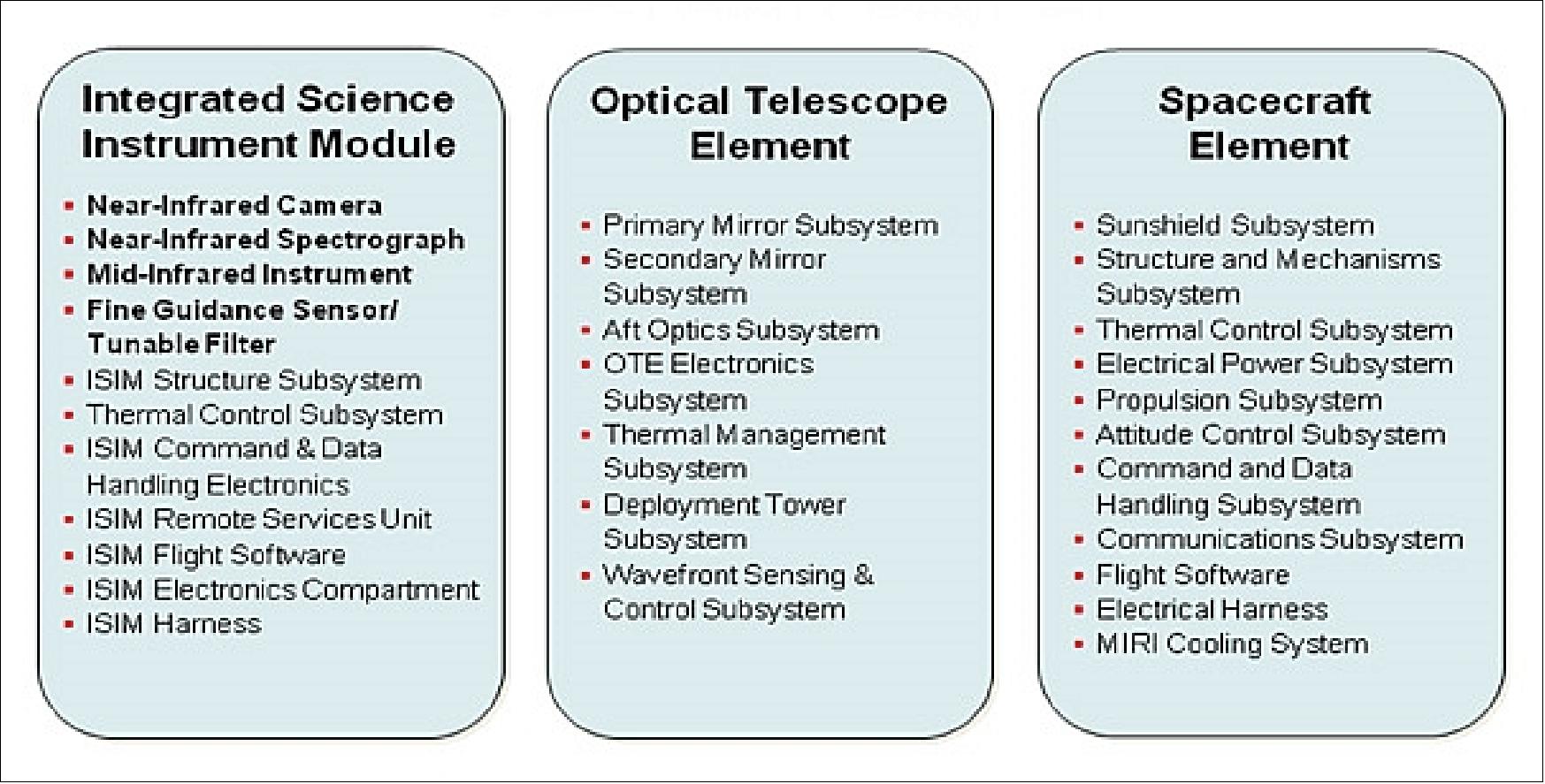
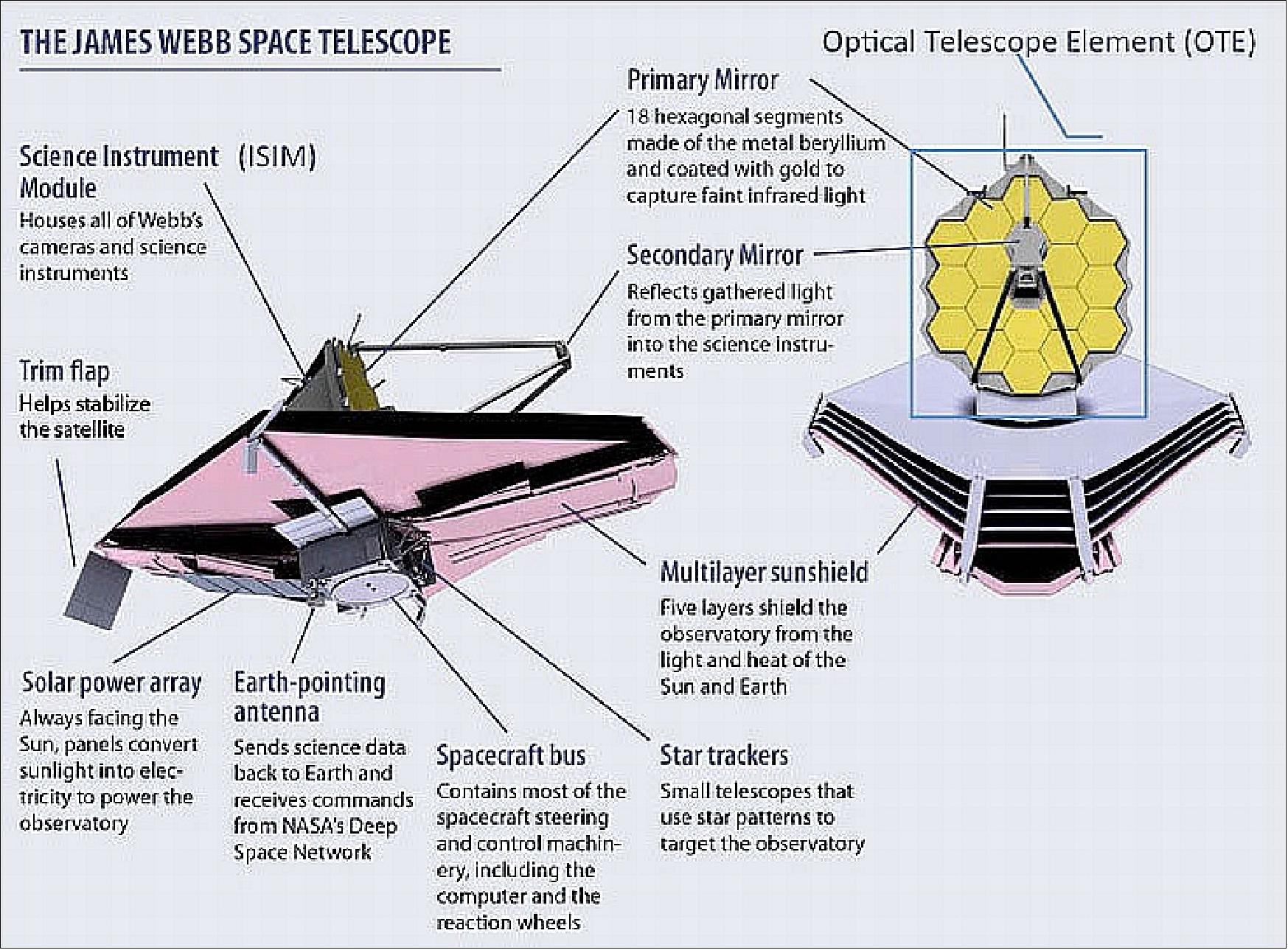
Item | Feature | Benefit |
OTE | - TMA (Three Mirror Anastigmatic) design, f/20, 25 m2 collecting area | - Superior image quality over the ISIM FOV, provides science resolution and sensitivity |
Primary mirror | - Primary mirror deploys in two steps (2-chord fold) | - Highly reliable deployment |
Secondary mirror | - Tripod configuration for support structure | - Provides rigidity, minimizes obscuration and scattered light into the field of view |
Aft optics | Fixed baffle | Reduces stray light and houses the tertiary mirror and the FSM |
ISIM | - Simple semi-kinematic mount; 8 m2 of thermal radiators, and 19.9 m3 volume. | - Provides a simple interface for the ISIM to decouple ISIM development from the OTE |
Tower | - Integral 1 Hz passive vibration isolators | - Reduces S/C dynamic noise onto OTE/ISIM |
Sunshield | - 5 layer "V" groove radiator design reduces solar energy to a few 10's of mW | - Provides a stable thermal environment for passively cooling the OTE and the ISIM |
S/C bus | - Chandra-based attitude control subsystem | - Flight-proven low noise dynamic environment that minimizes line-of-sight jitter |
Parameter | Capability | Parameter | Capability |
Wavelength | 0.6 - 29 µm. Reflective gold coatings | Orbit | Lissajous orbit about L2 |
Sensitivity | - SNR=10, integration time = τi, R=λ/Δλ and Zodicial of 1.2 times that at north ecliptic pole | Celestial sphere coverage | - 100% annually |
Spatial | - Encircled Energy of 75% at 1 µm for 150 mas radius | Mission life | - 5-year minimum lifetime |
Telescope FOV | - 166 arcmin x 166 arcmin FOV | Launch | 2019 |
OTE (Optical Telescope Element)
The OTE is of course the key element of the observatory with a primary mirror aperture diameter of 6.5 m. A lightweight design is mandatory to keep the launch costs in bounds. Early in the JWST program, an AMSD (Advanced Mirror System Demonstrator) project was launched to address the feasibility and readiness level of the required enabling technologies.
The following requirements were placed on JWST's optics (based on an "optical telescope element" study of 1996:
• The mirror should be sensitive to 1-5 µm (0.6-30 µm extended)
• It should be diffraction limited to 2 µm
• It will have to operate in the temperature range of 30-60 K
• It should have an areal density of < 15 kg/m2.
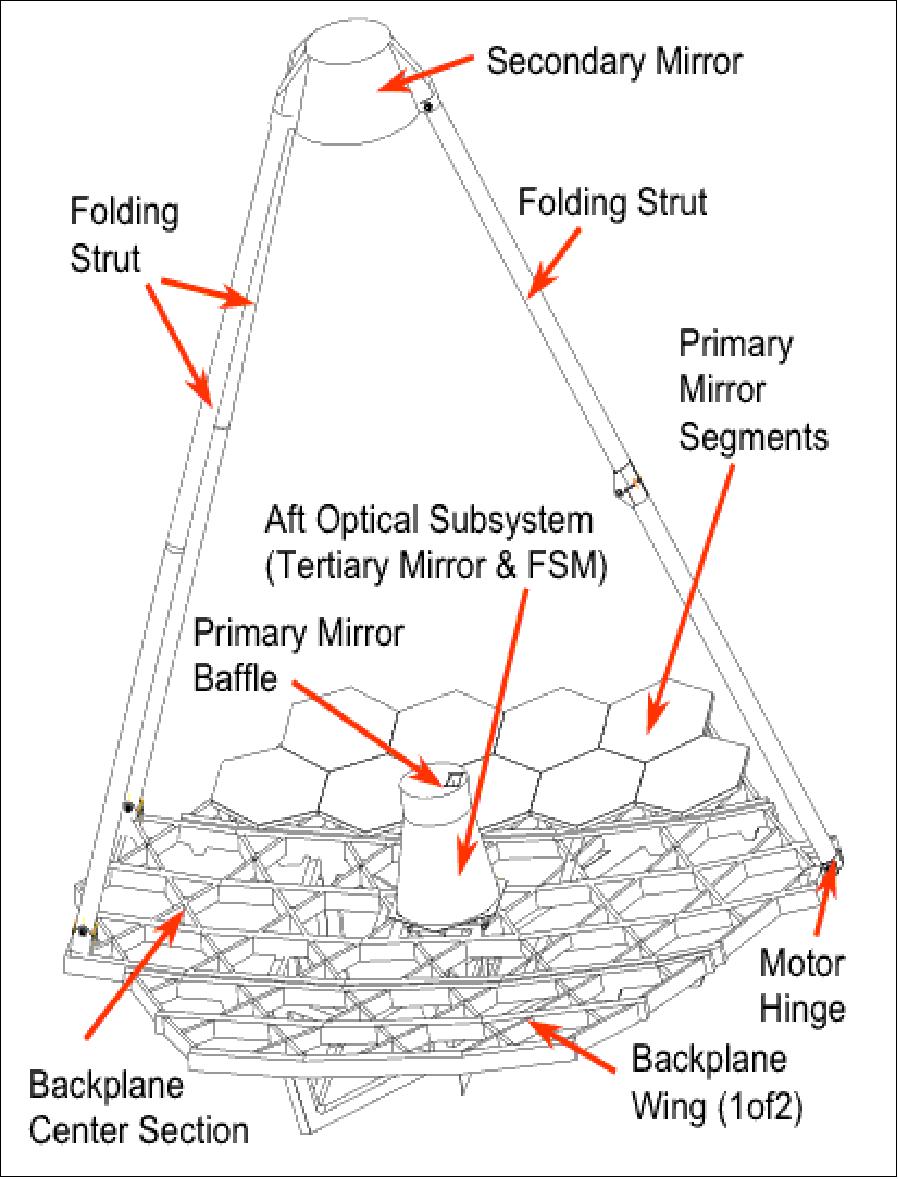
The JWST prime contractor, NGAS (Northrop Grumman Aerospace Systems) in consultation with the JWST Telescope Team, selected the beryllium-based mirror technology design made by BATC (Ball Aerospace & Technologies Corporation) as the primary mirror material with the following features: 71) 72)
• 1.318 m point-to-point light-weighted beryllium semi-rigid mirror (element size)
• 13.4 kg/m2 beryllium substrate areal density
• 19.3 kg/m2 areal density for the mirror system - including mirror, reaction structure, flexures, and actuators
• A SBMD (Subscale Beryllium Model Demonstrator) element achieved a 19 nm rms "surface roughness" at 38 K.
Beryllium was chosen over glass as the mirror material because it is lighter and has a low coefficient of thermal expansion at cryogenic temperatures. Since JWST is an infrared telescope, it must operate at cryogenic temperatures (< 40 K) so that the heat of the telescope does not interfere with the radiation it captures. Beryllium mirrors have a heritage in past astronomy missions such as in IRAS (InfraRed Astronomical Satellite, launch Jan. 25, 1983), COBE (Cosmic Background Explorer, launch Nov. 18, 1989) and the Spitzer Space Telescope (launch Aug. 25, 2003). The material properties of beryllium are known to temperatures of 10 K.
Aside from its lightweight features, the primary mirror must be segmented, so that it can be folded up to fit into the nose cone of a rocket. Once on orbit, the telescope will be deployed, using motors to unfold the primary mirror and other important assemblies. Then the telescope will be cooled down from room temperature to about 37 K by the ambient environment on its way to L2 - a temperature change of about 300 K is experienced which obviously causes misalignments and figure errors of the optics system. Note: Passive cooling is attained by placing the observatory at L2 and keeping the telescope and its instrumentation in perpetual shadow by means of a large deployable sunshade.
The primary mirror design consists of 18 hexagonal segments (1.315 m flat-to-flat side), in two rings around the center, resulting in a 6.5 m flat-to-flat diameter with a collecting area of 25 m2. A TMA (Three Mirror Anastigmatic) design is employed with a Strehl ratio of ~0.84 at λ = 2 µm providing a very low background noise. The telescope has an effective f/number of f/16.67, and an effective focal length of 131.4 m.
The segments of the primary mirror act as a single mirror when properly phased relative to each other. The phasing is achieved via a 6 DoF (Degree of Freedom) rigid body motion of the individual segments, and an additional control for the segment mirror radius of curvature. The 18 segments have three separate segment types (A, B, C) with slightly different aspheric prescriptions depending on placement as shown in Figure 44. The numbers 1 to 6 represent the six-fold symmetry of the hexagonal packing of the primary mirror.
Figure 45 shows the rear portion of the mirror segments and the seven actuators. The architecture is "semi-rigid" because it has a modest amount of flexibility that allows for on-orbit compensation of segment-to-segment radius of curvature (ROC) variations. This ROC adjustment is made independent of any attachment to the backplane structure to prevent mirror distortion.
The six actuators providing rigid body motion are arranged in three bipods to form a kinematic attachment to the backplane. Each bipod attaches to a triangular shaped structure which is attached to the isogrid structure of the mirror segment. This structure spreads the loads over the surface of the mirror. The other end of the actuators attaches through a secondary structure and flexure to the backplane. The seventh actuator controls the segment radius of curvature and is independent of the rigid body actuators. The actuators operate at cryogenic and ambient temperatures, and have both coarse and fine positioning capability. This configuration enables simple rigid body motion of the segments without distorting the segment surface. 73)
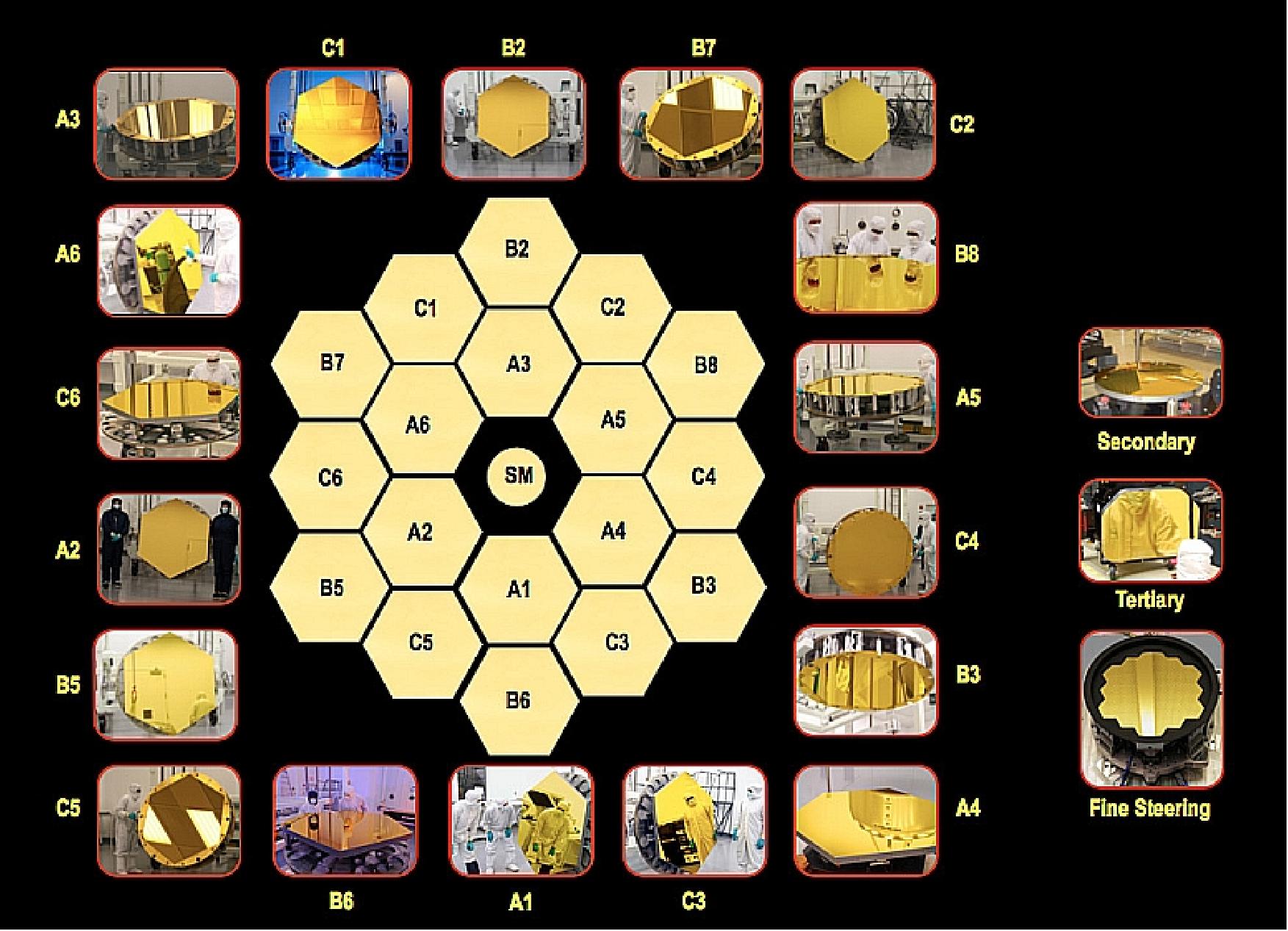
Legend to Figure 44: JWST completes the gold coating of it's telescope mirrors with segment C1. A microscopically thin layer of gold maximizes the reflectivity of these mirrors to infrared light.
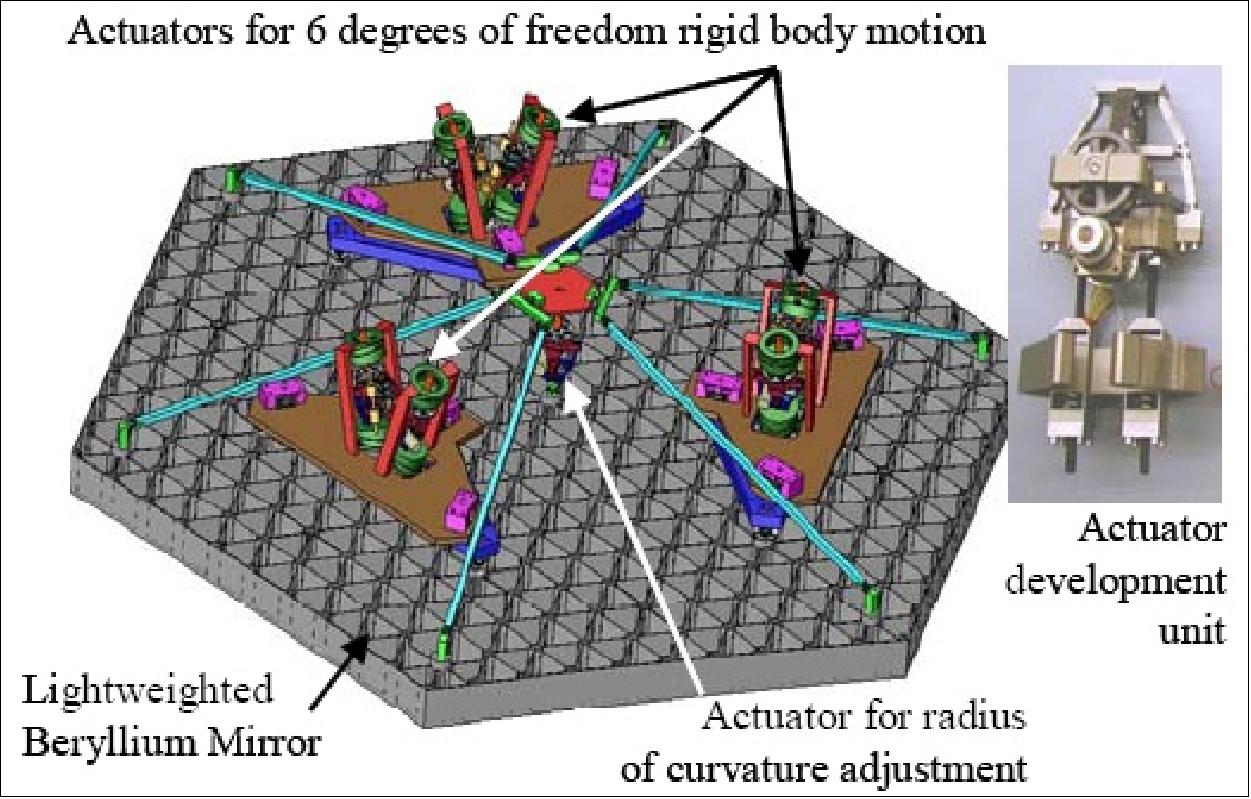
WFS&C (Wavefront Sensing and Control) subsystem: A WF&C semi-rigid structure is being used for phasing (to counteract the misalignments). WFS&C consists of actuators mounted on the telescope primary mirror segments and on the secondary mirror, to deform and displace the critical telescope optics in ways that are very effective in compensating the likely on-orbit deformations. The WFS&C software processes images from the cameras to measure the optical aberrations. The software then computes actuator commands to correct the aberrations.
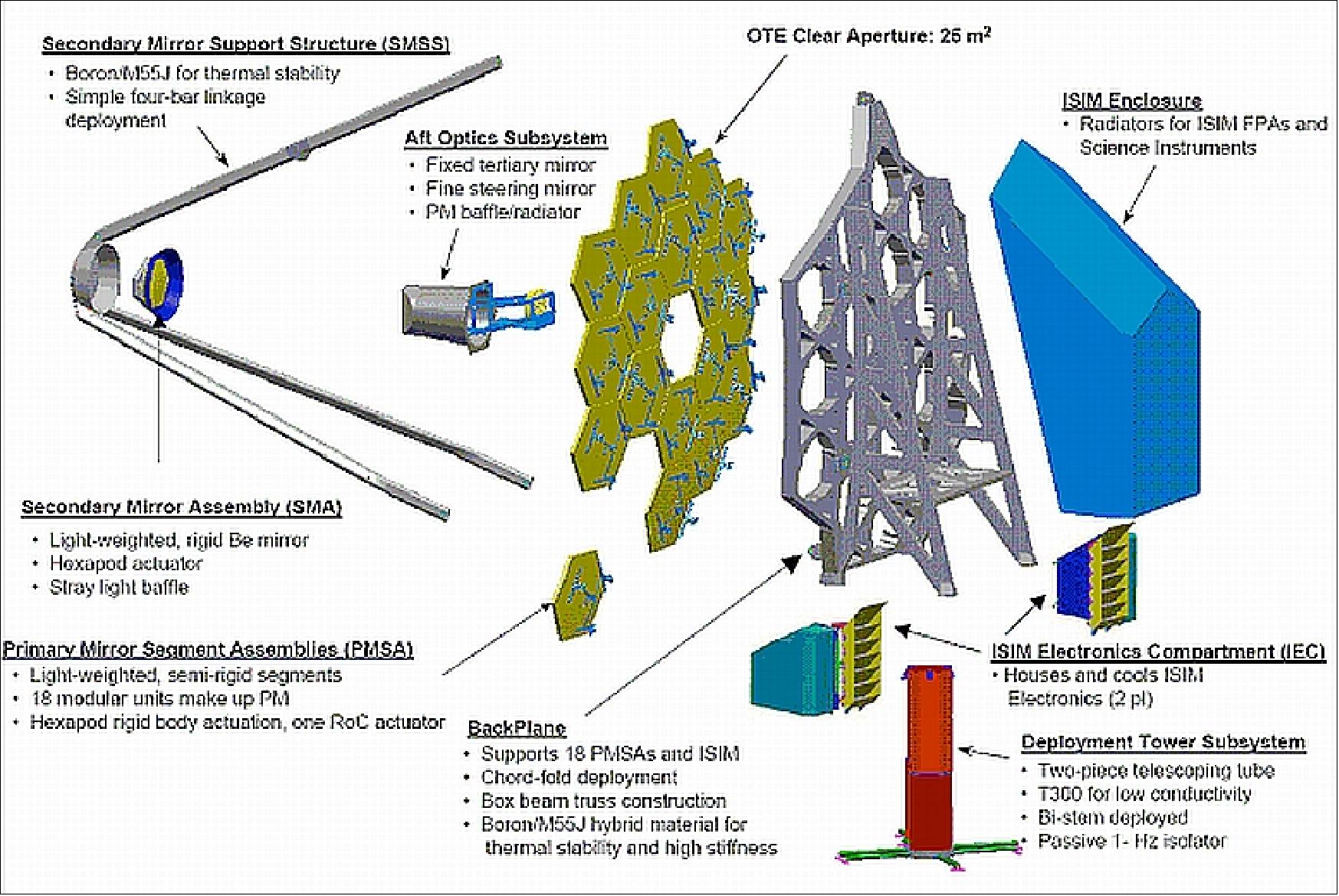
Operating temperatures: The large sunshade will protect the telescope from heating by direct sunlight, allowing it to cool down to temperatures of < 45 K. The near-infrared instruments will work at about 30 K through a passive cooling system. The mid-infrared detectors will work at a temperature of 7 K, using stored cryogen (active cooling).
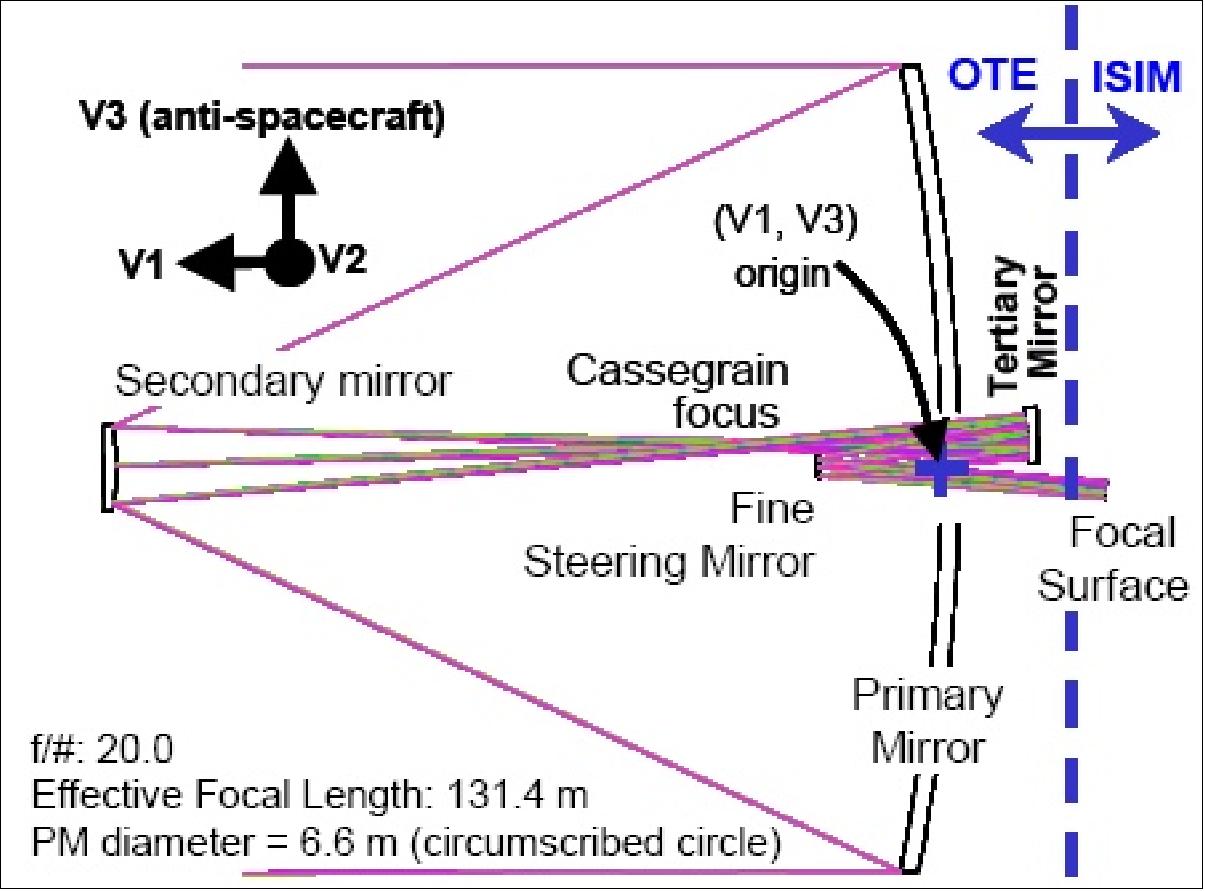
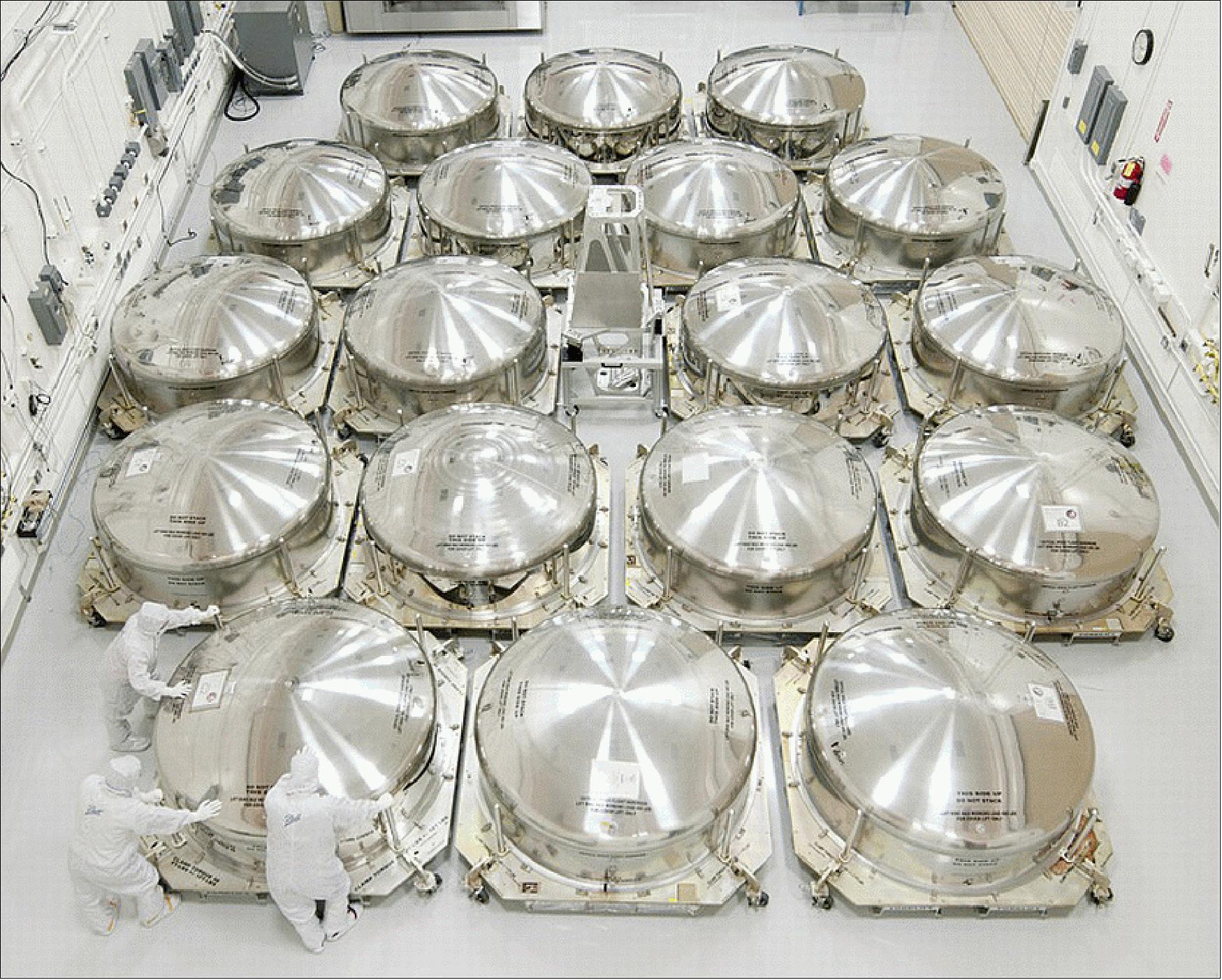
ISIM (Integrated Science Instrument Module)
The ISIM provides structure, environment, control electronics and data handling for three modular science instruments: NIRCam, NIRSpec, and MIRI, and the observatory FGS (Fine Guidance Sensor). ISIM is being provided by NASA/GSFC. In addition to designing the ISIM structure, NASA Goddard provides other infrastructure subsystems critical for the operation of the instruments, including the ISIM Thermal Control Subsystem; ISIM Control and Data Handling Subsystem; ISIM Remote Services Unit; ISIM Flight Software; ISIM Electronics Compartment, and ISIM Harness Assemblies. 75) 76) 77) 78) 79)
ISIM is a distributed system consisting of cold and warm modules.
• The cryogenic instrument module is integrated with the OTE and the sensor complement, all of which are passively cooled to the cryogenic temperature of 39 K. This passively cooled cryogenic (39 K) section houses the instruments NIRCam, NIRSpec, MIRI and the FGS (Fine Guidance Sensor). The MIRI instrument is further cooled by a cryocooler to 7 K.
• The second area is the IEC (ISIM Electronics Compartment), which provides the mounting surfaces and a thermally-controlled environment for the instrument control electronics (region 2 maintained at 298 K). The ICE package is mounted onto the exterior of the ISIM structure.
• The third area (warm module) is the ISIM Command and Data Handling (ICDH) subsystem, which includes ISIM flight software, and the MIRI cryocooler compressor and control electronics (region 3 maintained at 298 K). The warm region of ISIM is located in the spacecraft on the warm side of the Observatory. This more benign environment allows for relaxed thermal requirements on major portions of the electronics with higher power dissipation, and it avoids unnecessary heat loads in the cold section.
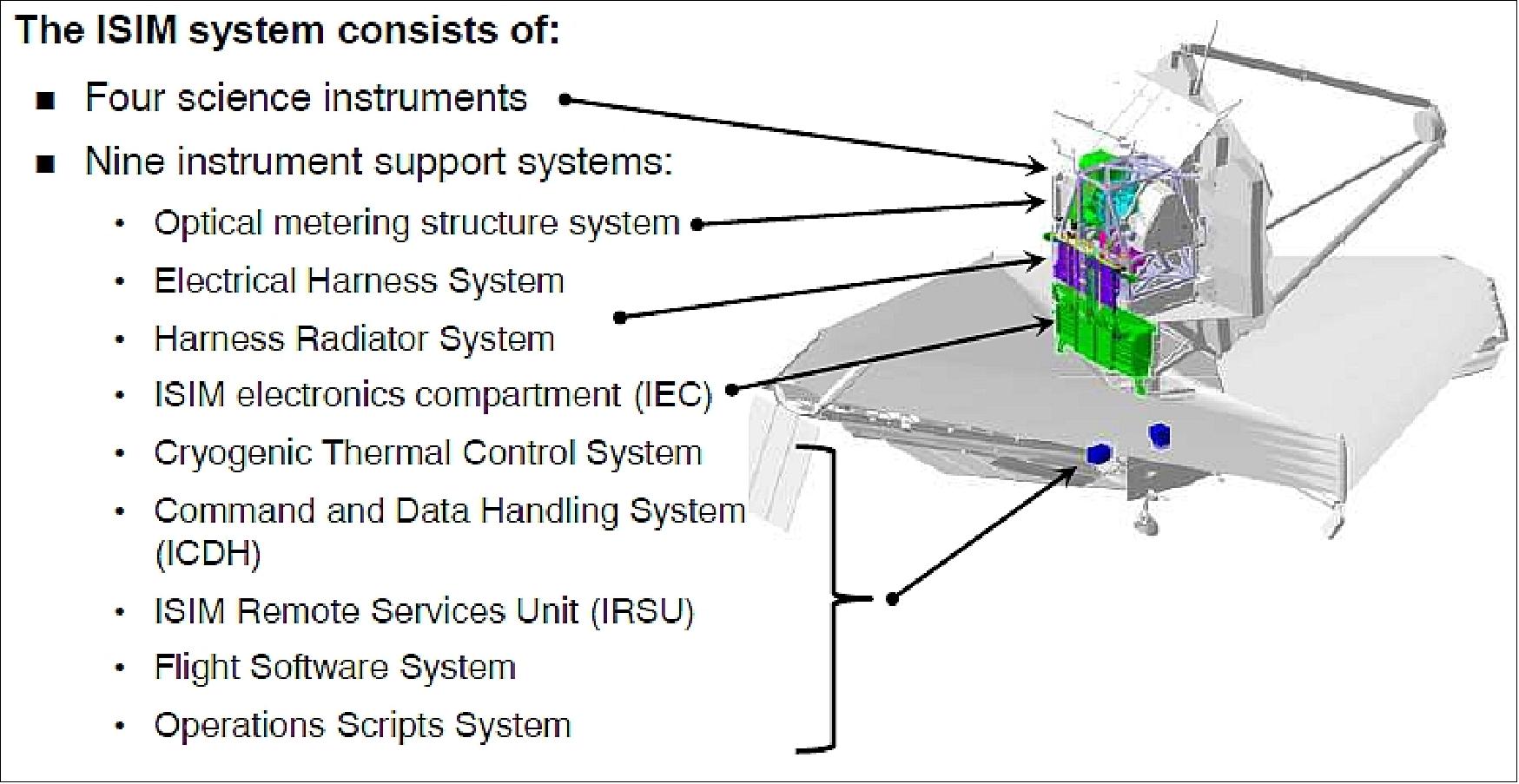
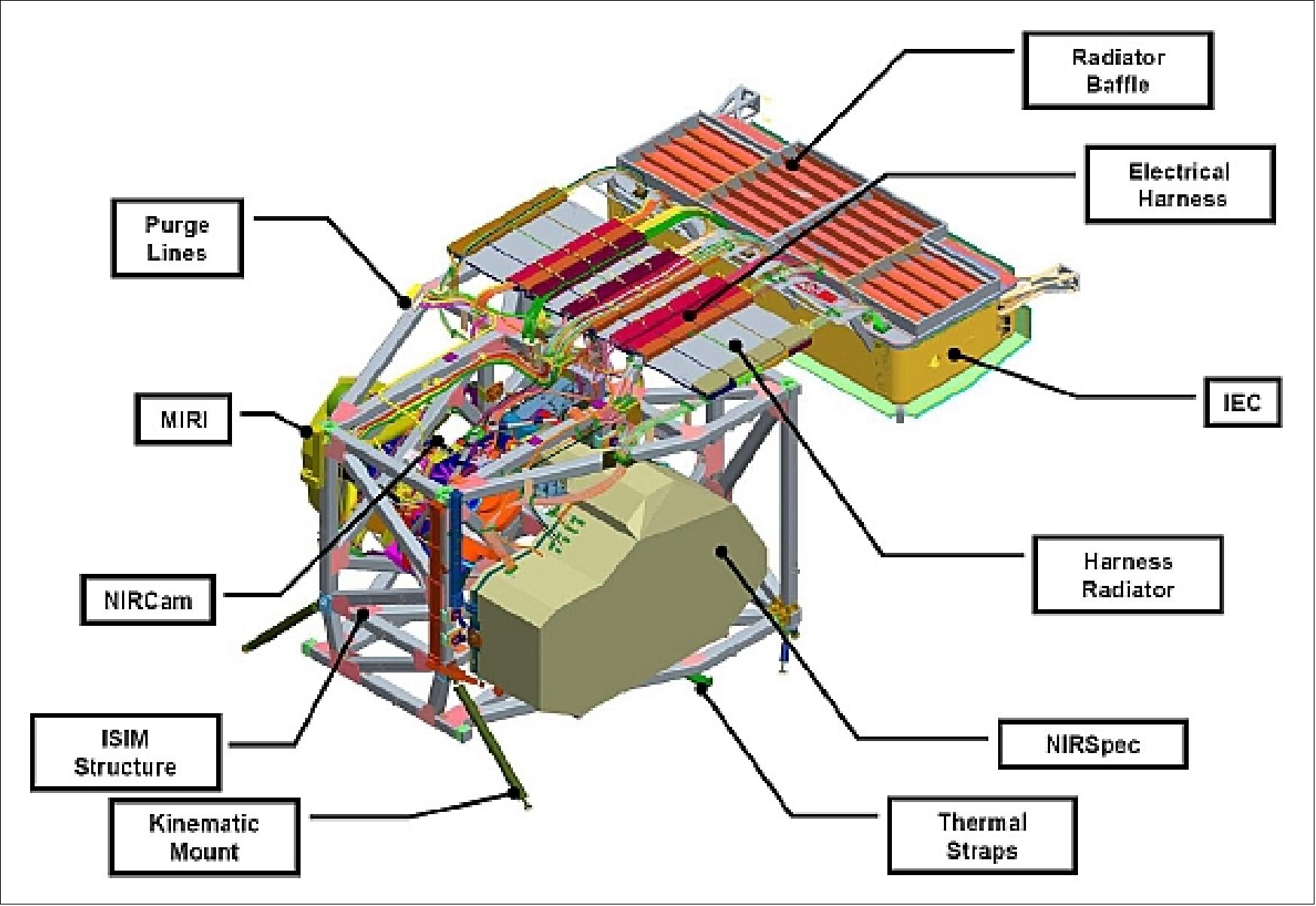
Each ISIM instrument reimages the OTE focal plane onto its FPA (Focal Plane Array) assembly, allowing for independent selection of detector plate scale for sampling of the optical PSF (Point Spread Function). A fine steering mirror (FSM) is used for accurate optical pointing and image stabilization. The FSM is located at the image of the pupil, after the tertiary mirror but forward of the focal plane interface to the ISIM. The FSM, coupled with the low structural noise spacecraft, suppresses line-of-sight jitter to allow diffraction-limited performance at 2 µm. The V1, V2, and V3 coordinate systems are defined by the vertex of the primary mirror as shown in Figure 47.
The four scientific instruments onboard JWST are contained in the ISIM (Integrated Science Instrument Module) which is mounted to the BSF (Back Plane Support) behind the primary mirror. ISIM contains four instruments: MIRI,FGS/IRISS, NIRCam, and NIRSpec. The IEC (ISIM Electronics Compartment) is also mounted to the BSF and holds a number of high-power boxes, totaling 200 W of dissipation, at room temperature on the cold side of the sunshield. This is an order of magnitude above the summed dissipation of the remainder of the cold side. Its proximity to the cryogenic instruments is driven by the noise-sensitive science data that must be processed by electronics with the IEC. 81)
The IEC has been designed to hold room-temperature electronics boxes in close proximity to the cryogenic telescope and instrument module and to direct the 200 W dissipation so that is does not have a negative affect on the observatory performance. This is made possible through multiple radiative isolators in series, conductive isolation, and directional baffles. Analysis has shown that this design will meet the requirements levied on the IEC by the observatory, allowing the IEC to function as an integral part of the James Webb Space Telescope.
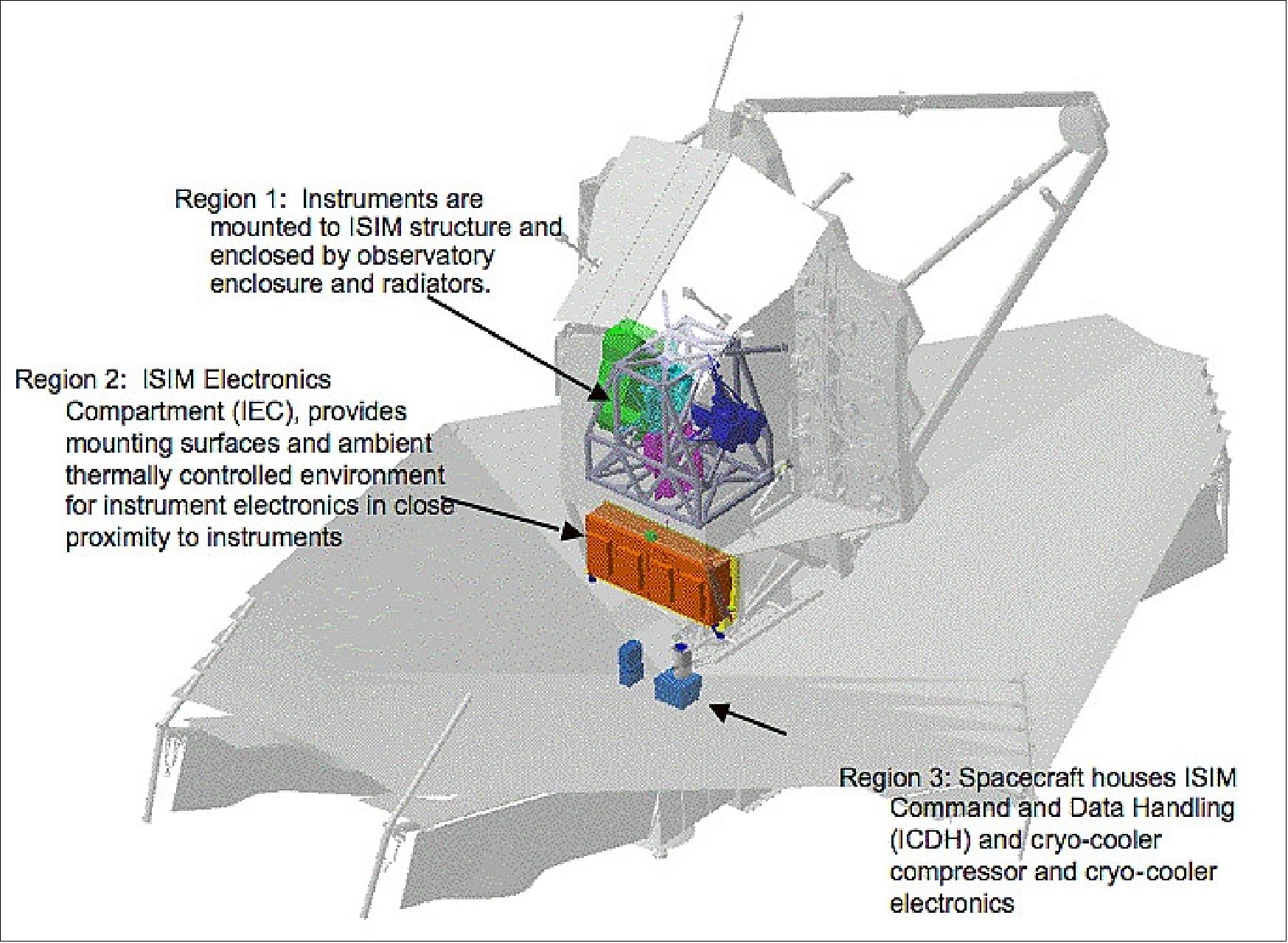
Instrument | Spectral range (µm) | Optical elements | FPA | Plate scale | FOV (Field of View) |
NIRCam (Short | 0.6 - 2.3 | Fixed filters | Two 2 x 2 mosaics of 2048 x 2048 arrays | 32 | 2.2' x 4.4' |
NIRCam (Long | 2.4 - 5.0 | Fixed filters | Two | 65 | 2.2' x 4.4' |
NIRSpec (prism, | 0.6 - 5.0 | Transmissive slit mask: | Two | 100 | 3.4' x 3.1' |
NIRSpec (Grating, | 1.0 - 5.0 | ||||
NIRSpec (IFU, | 1.0 - 5.0 | IFU (Integrated Field Unit) | 3.0" x 3.0" | ||
MIRI (Imaging) | 5 - 28 | Broad-band filters, | 1024 x 1024 | 110 | 1.4' x 1.9' |
MIRI (Prism | 5 -10 | R ~ 100 | |||
MIRI | 5 - 28 | Integral field spectrograph | Two 1024 x 1024 | 200-470 depending on band | 3.6" x 3.6" to |
FGS | 1.5 – 2.6 | Order-blocking | 2048 x 2048 | 68 | 2.3' x 2.3' |
The ISIM instruments are located in an off-axis position, which yield excellent image quality over the 9.4 arcminute field, as shown by the contours of residual wavefront error as a function of field location in Figure 54. The cold portion of the ISIM is integrated with the OTE.
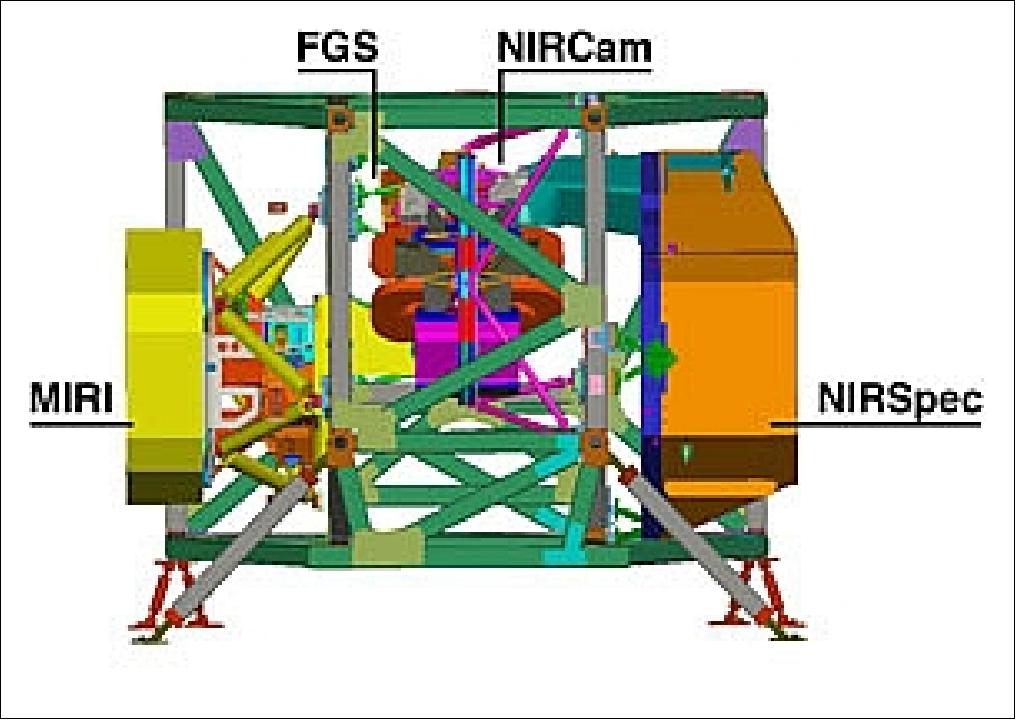
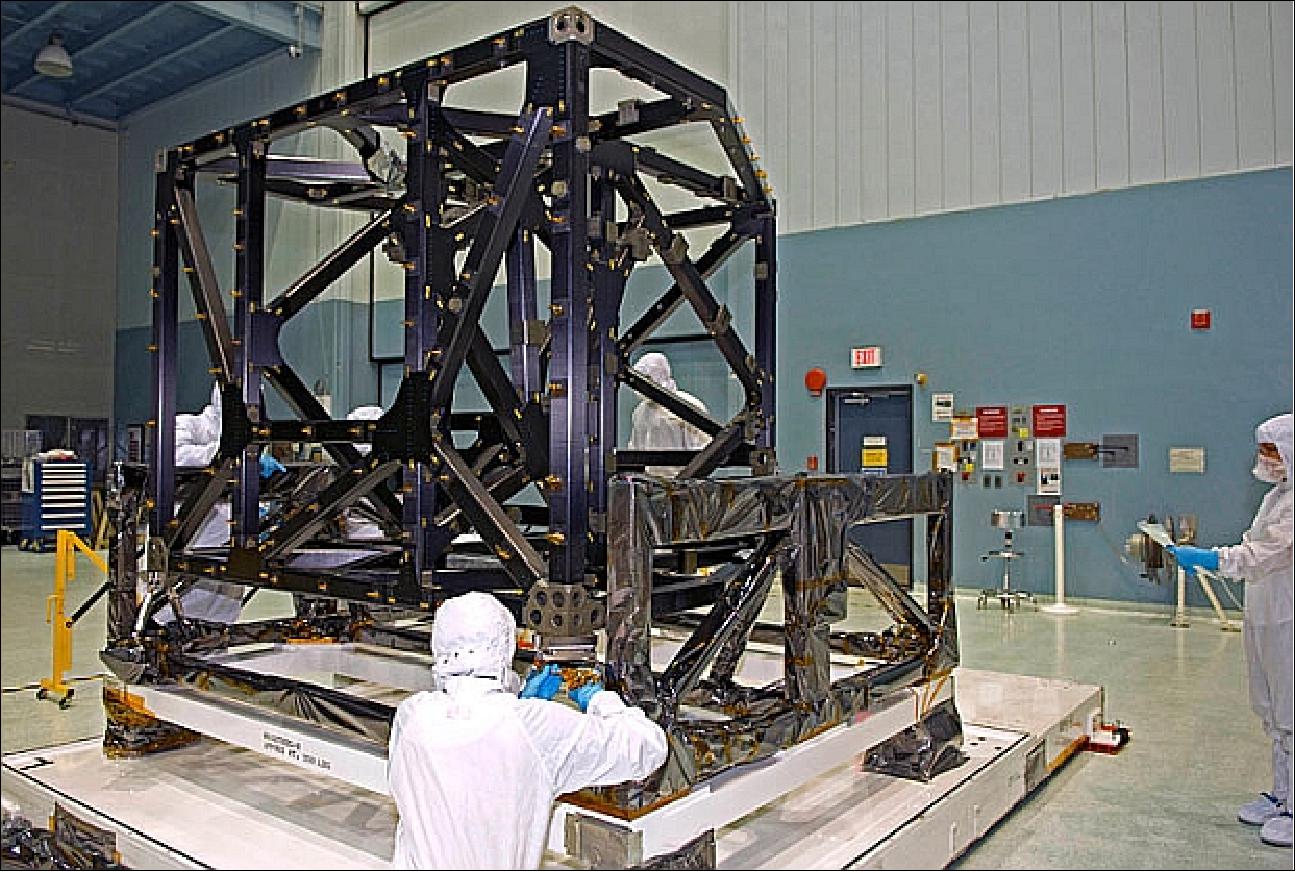
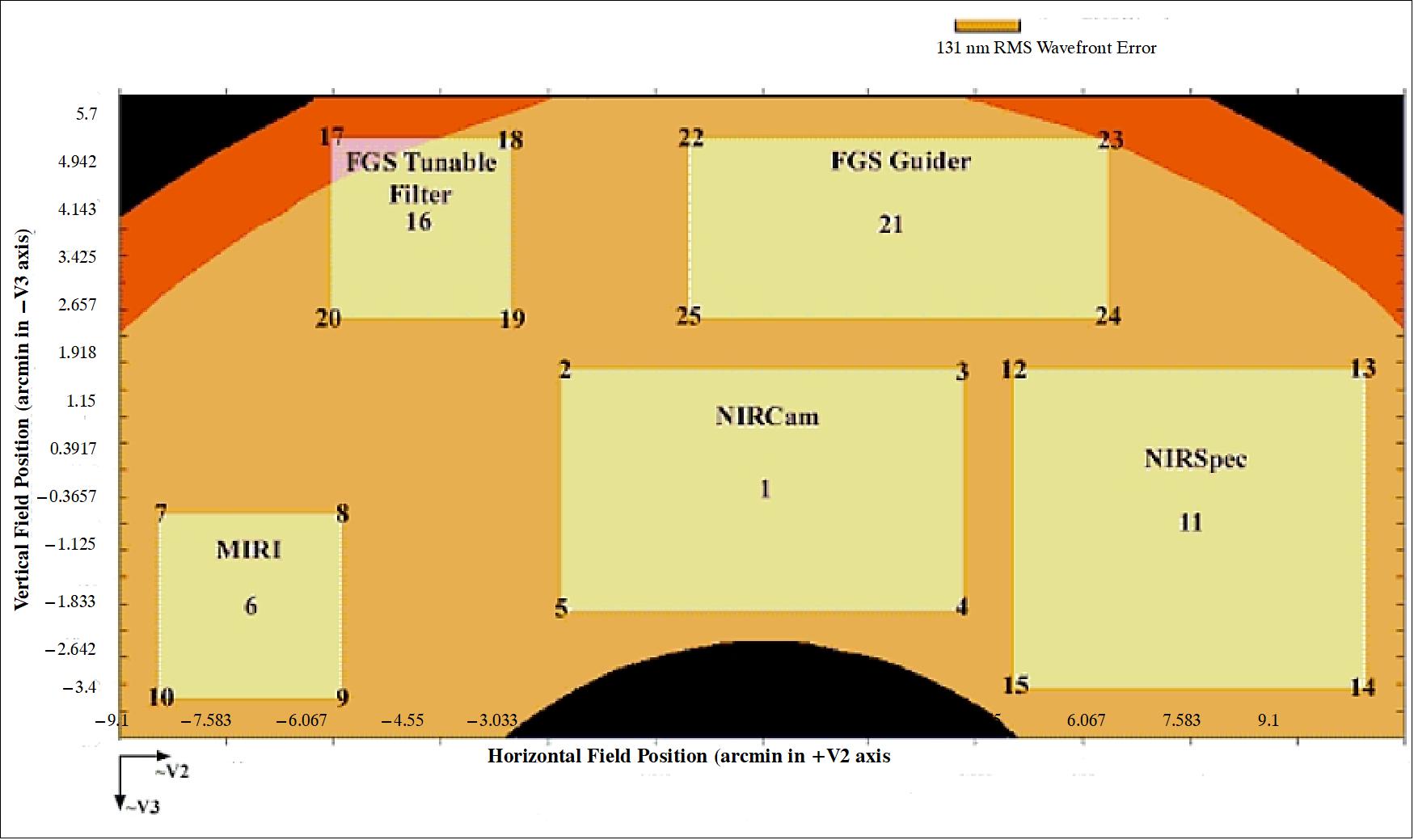
Legend to Figure 54: Placement of the ISM instruments in the telescope field of view. The field of view of each instrument is fully contained within the instrument allocation regions. The numbers indicate the wavefront error contribution by the optical telescope element (in nm) at each location.
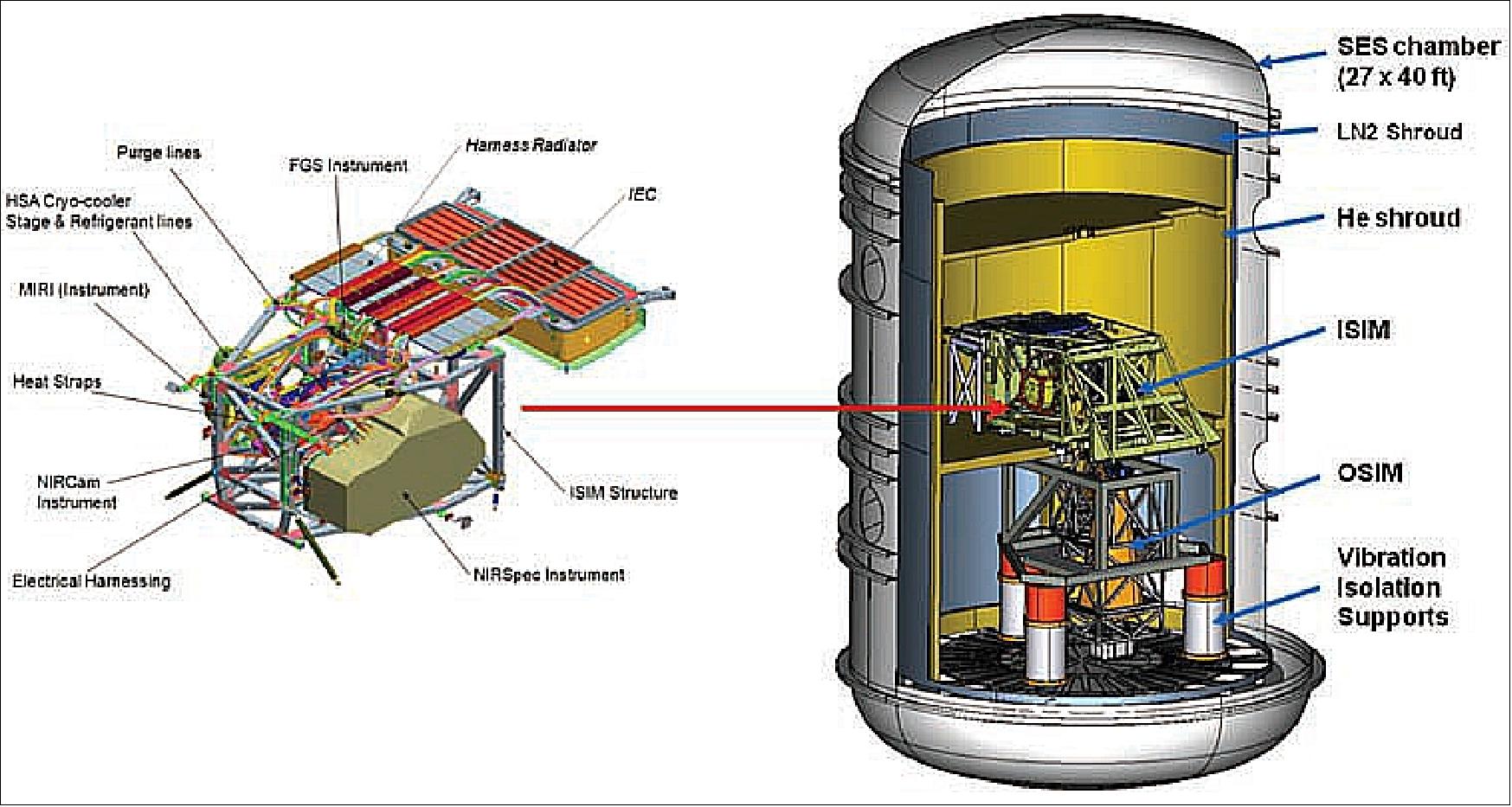
Legend to Figure 55: A high fidelity simulation of the JWST telescope beam is fed from below into the ISIM by an Optical SIMulator (OSIM) that is mounted on vibration isolators. The SES vacuum vessel is equipped with nitrogen and helium shrouds to enable testing at the 40 K nominal flight operating temperature. 83)
The ISIM structure and assembly has a total mass of ~ 1400 kg which is about 23% of the JWST mass.
ISIM Status
• Summer 2015: The ISIM enters this final testing sequence in its full flight configuration. After some precursor integration and test activities, which included two very successful cryo-vacuum campaigns (called CV1-RR and CV2, the latter of which was in a nearly-final configuration), the ISIM underwent a series of activities to upgrade its instruments and systems to full flight readiness. These activities included: 84)
- Completion of the upgrade of the near-infrared detector arrays in NIRCam, NIRSpec, and FGS/NIRISS to a newer, more robust design that eliminates a dark current degradation mechanism suffered by the earlier generation arrays.
- Installation of new Microshutter Arrays in the NIRSpec with improved stability against the acoustic loads of launch.
- Installation of new grisms in the NIRISS instrument, including a new grism for exoplanet spectroscopy with 2-3 times higher throughput than the original optic.
- Upgraded electronics boards in several instruments for improved performance or reliability.
- Installation of the flight cold head of the MIRI cryocooler system (the Heat Exchanger Stage Assembly, mounted to the ISIM structure).
The first phase of this final environmental test sequence, vibration testing, was completed in June 2015, with vibration of the "ISIM prime" module. Sinusoidal sweep testing was carried out in each of three axes, with amplitudes up to ~2.5g in some frequency bands, in order to verify workmanship by subjecting the system to the low frequency structural dynamic spectrum of the launch environment.

Note: As of the launch of the JWST spacecraft on December 25 2021, the JWST file has been split into additional files, to make the file handling manageable for all parties concerned, in particular for the user community.
Sensor Complement (NIRCam, NIRSpec, MIRI, FGS/NIRISS)
NIRCam (Near-Infrared Camera)
NIRCam funded by NASA with the University of Arizona as prime contractor (PI: Marcia J. Rieke). CSA is participating in the development of the NIRCam instrument. The industrial partner is Lockheed-Martin Advanced Technology Center, Palo Alto, CA. The NIRCam objectives are: 85) 86) 87) 88) 89) 90)
• To find "first light" sources. NIRCam surveys will become the backbone of the first light searches and for galaxy evolution studies.
• To assist the space telescope in initial (after deployment) and periodic alignment tests throughout the mission. This requires wavefront sensing to assure perfect alignment and shape of the different primary mirror segments.
• The camera also includes features for studying star formation in the Milky Way and for discovering and characterizing planets around other stars.
The various roles place additional constraints on the camera design. First, the camera must accommodate extra optics and pupil analyzers to enable the wavefront sensing. Secondly, the modules incorporating the wavefront sensing must be fully redundant as the mission depends critically on this functionality. Hence, the NIRCam design includes two identical imaging modules each of which includes dual filter wheels. The dual filter wheels are configured so that one wheel holds bandpass filters while the other wheel holds pupil analyzers thus permitting wavefront analysis as a function of wavelength.
NIRCam employs a compact refractive optics design using dichroics (to split the incoming radiation in 2 wavelengths) to enable simultaneous observation of a field at λ < 2.5 µm and at λ > 2.5 µm. The short wavelength module is Nyquist-sampled at 2 µm while the long wavelength module is Nyquist-sampled at 4 µm.
Wavelength range | 0.6 - 5.0 µm |
Spectral resolution | Selection of R~4 and R~10 discrete filters, R~100 using 2 tunable filters |
FOV (Field of View) | Imaging: 2.16 x 2.16 arcmin at two wavelengths simultaneously |
Spatial resolution | Imaging: 0.0317 arcsec/pixel, λ<2.5µm; 0.068 arcsec/pixel, λ > 2.5µm |
Coronagraphy | Choice of coronagraphic spots and pupils in all instrument sections |
Parameter | Imaging module 1 | Imaging module 2 | Tunable filter module short λ | Tunable filter module long λ |
Wavelength range (µm) | 0.6 to 2.3 | 0.6 to 2.3 | 1.2 to 2.5 | 2.5 to 4.5 |
Nyquist sampling (µm) | 2 / 4 | 2 / 4 | 4 | 4 |
Pixel format | 4096 x 4096 (short λ) | 4096 x 4096 (short λ) | 2048 x 2048 | 2048 x 2048 |
FOV (arcmin) | 2.3 x 2.3 | 2.3 x 2.3 | 2.3 x 2.3 | 2.3 x 2.3 |
Spectral resolution | 4, 10 | 4, 10 | 100 | 100 |
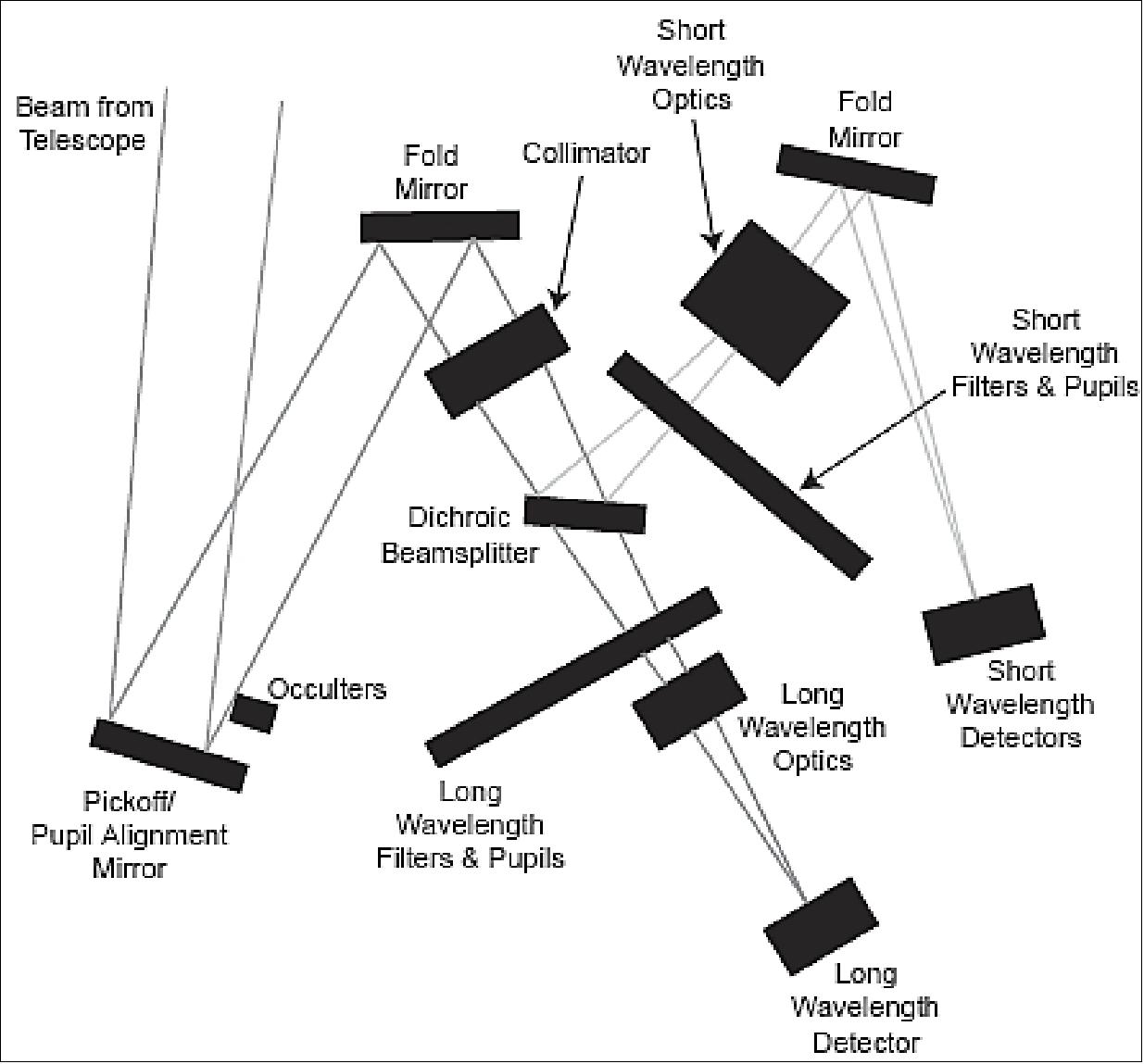
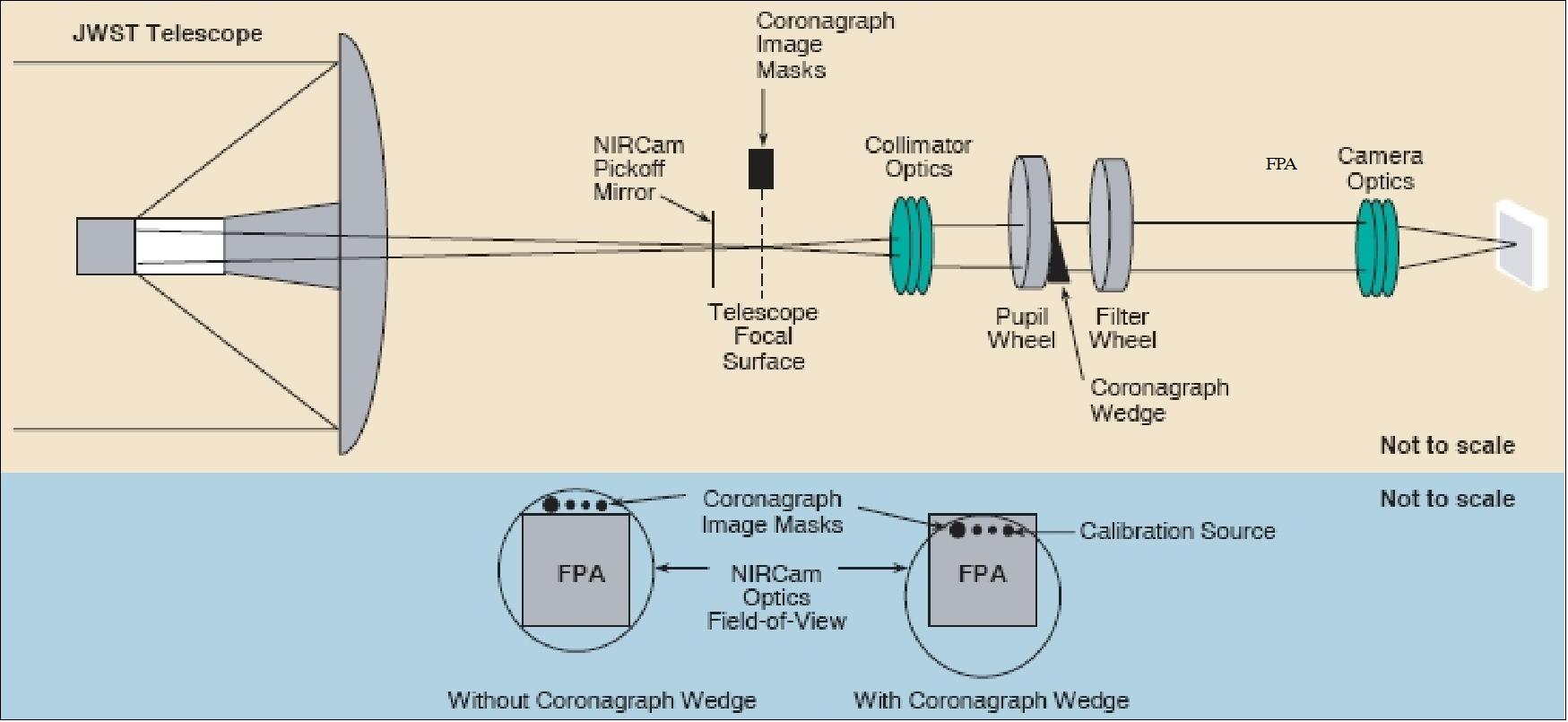
Legend to Figure 58: An optical wedge in the pupil wheel brings the coronagraphic spots into the field of view. The spots are matched with Lyot stops.
Coronagraphy: To enable the coronagraphic imaging of nearby stars, each of the two identical optical trains in the instrument also contains a traditional focal plane coronagraphic mask plate held at a fixed distance from the FPAs (Focal Plane Assemblies), so that the coronagraph spots are always in focus at the detector plane. Each coronagraphic plate is transmissive, and contains a series of spots of different sizes to block the light from a bright object. Each coronagraphic plate also includes a neutral density spot to enable centroiding on bright stars, as well as point sources at each end that can send light through the optical train of the imager to enable internal alignment checks. Normally these coronagraphic plates are not in the optical path for the instrument, but they are selected by rotating into the beam a mild optical wedge that is mounted in the pupil wheel (Figure 58), which translates the image plane so that the coronagraphic masks are shifted onto the active detector area (Ref. 74).
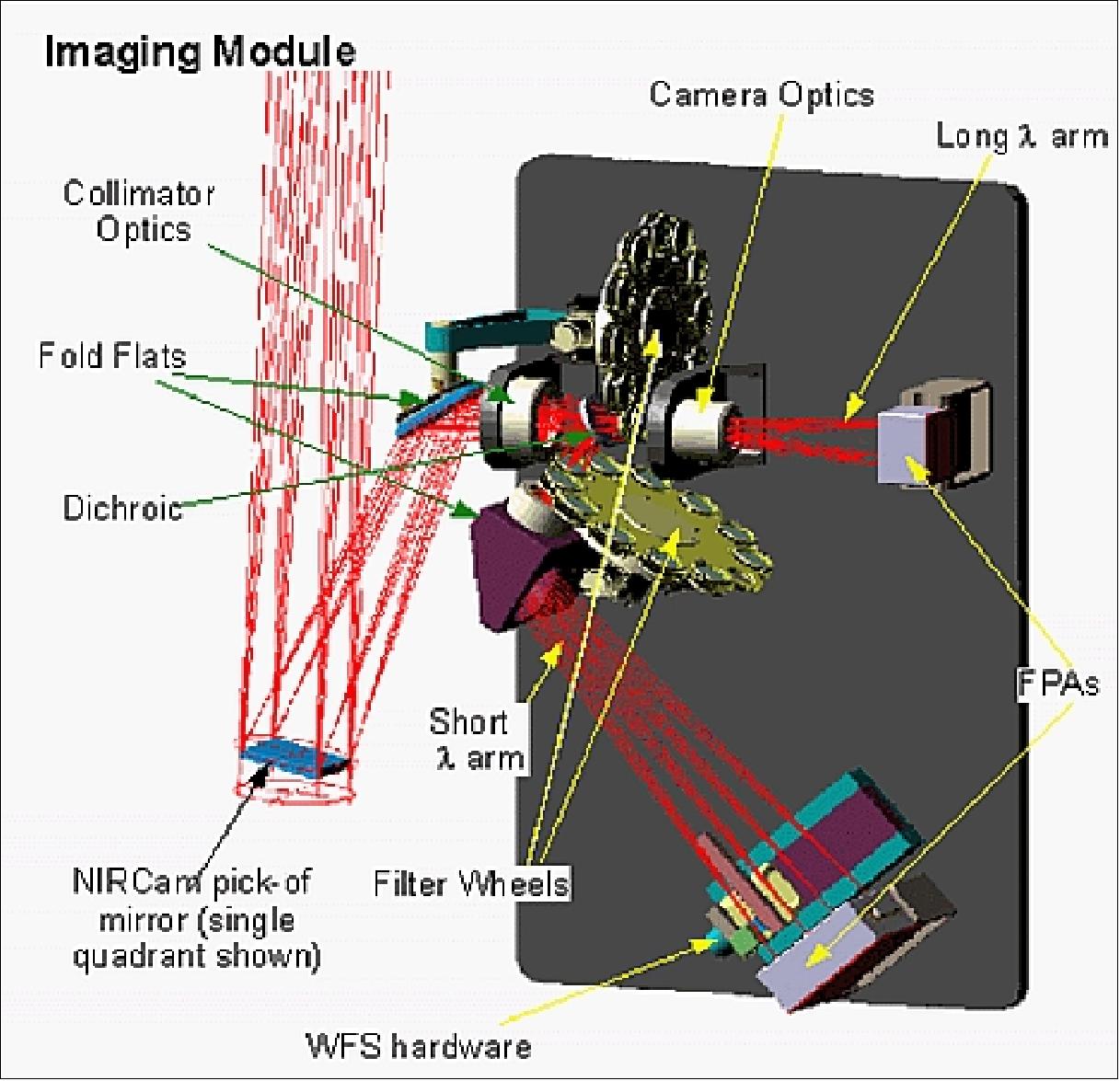
The NIRCam filters and pupil selections are given in Table 6. All of the camera's filter wheels are identical, 12 position dual wheels. NIRCam also includes a set of broadband filters whose wavelengths and widths have been carefully chosen to support accurate photometric redshift estimation.
Position | Shortwave imaging | Longwave imaging | Tunable filter | |||
Filter wheel (µm) | Pupil wheel | Filter wheel (µm) | Pupil wheel | Filter wheel | Pupil wheel | |
1 | B1: 0.7 | Imaging pupil | B5: 2.7 | Imaging pupil | Blocker-1 | Imaging pupil |
2 | B2: 1.1 | Flat field source | B6: 3.6 | Flat field source | Blocker-2 | Flat field source |
3 | B3: 1.5 | Outward pinholes | B7: 4.4 | Outward pinholes | Blocker-3 | Outward pinholes |
4 | B4: 2.0 | Coron pupil 1 | I4: 2.4-2.6 | Coron pupil 1 | Blocker-4 | Coron pupil 1 |
5 | I1: 1.55-1.7 | Coron pupil 2 | I5: 2.8-3.2 | Coron pupil 2 | Blocker-5 | Coron pupil 2 |
6 | I2: 1.7-1.94 | HeI 1.083 µm | I6: 3.2-3.5 | TBD | Blocker-6 | Cal pattern 1 |
7 | I3: 2.0-2.22 | WFS-1 (Wavefront Sensing) | I7-CO2: 4.3 | TBD | Blocker-7 | Cal pattern 2 |
8 | B8: 0.8-1.0 | WFS-2 | I8-CO: 4.6 | TBD | Blocker-8 | Cal pattern 3 |
9 | Hα: 0.656 | WFS-3 | Brα: 4.05 | TBD | Blocker-9 | Cal pattern 4 |
10 | [Fell] 1.64 | WFS-4 | H2: 2.41 | TBD | 1%-1 | TBD |
11 | Pα: 1.875 | WFS-5 | H2: 2.56 | TBD | 1%-2 | TBD |
12 | H2: 2.12 | WFS-6 | H2: 4.69 | TBD | 1%-3 | TBD |
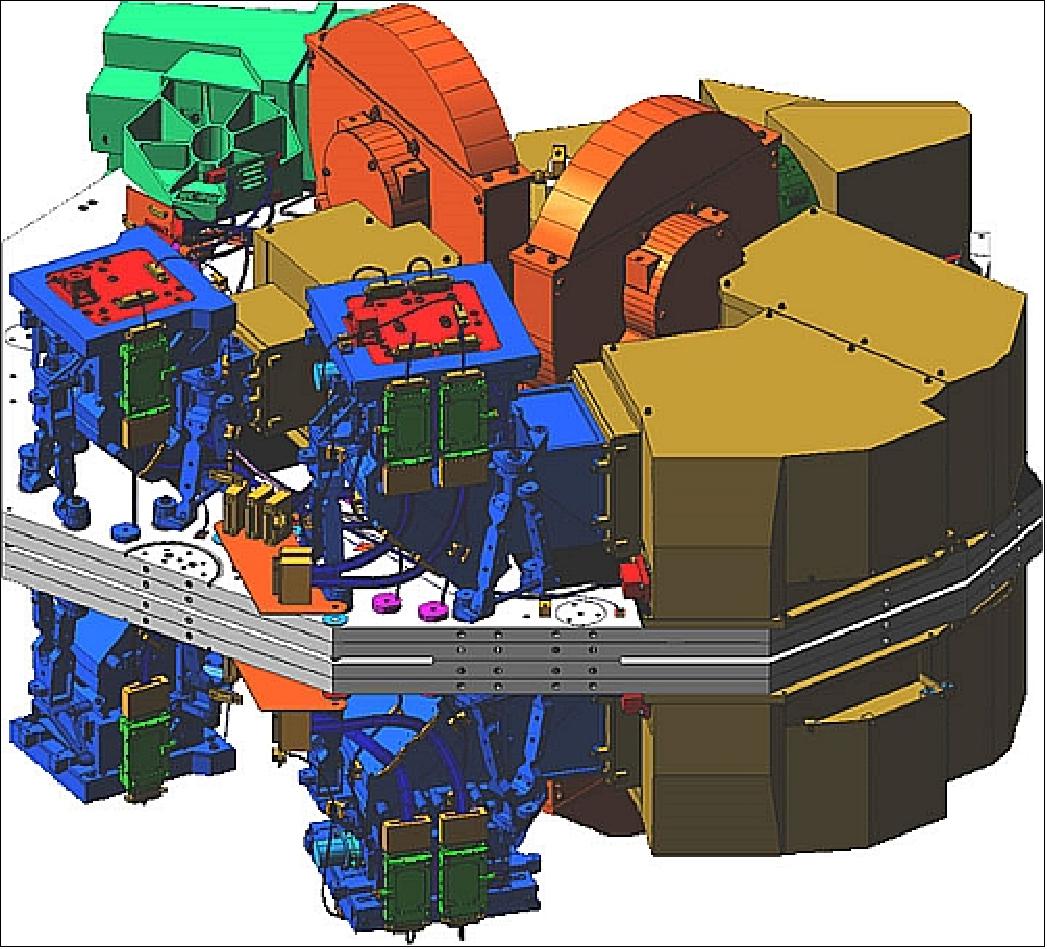
The expected point-source sensitivity is ~3.5 nJy for wavelengths from 0.7 - 5 µm in a 100,000 second exposure at a SNR (Signal-to-Noise Ratio) of 10. All ten detectors arrays needed for NIRCam are using Teledyne Technologies (former Rockwell Scientific )HgCdTe 2k x 2k devices (HAWAII-2RG detector technology, also referred to as H2RG). The short wavelength bands will be sampled at 4096 x 4096 pixels (0.0317 arcsec/pixel), while the long wavelength bands are being sampled by 2048 x 2048 pixels (0.0648 arcsec/pixel). The focal plane array includes detector and cryogenic electronics. 91) 92)
Note: The term "Jy" refers to the "Jansky," the unit of radio‐wave emission strength, in honor of Karl G. Jansky (1905‐1950) an American engineer whose discovery of radio waves (1931) from an extraterrestrial source inaugurated the development of radio astronomy. Jansky published his findings in 1932 while working at Bell Telephone Laboratories in Murray Hill, NJ.
The "Jy" is a unit of radiative flux density (or radio‐wave emission strength) which is commonly used in radio and infrared astronomy. 1 Jy = 10‐26 W/(m2 Hz). The units of Jy (Hz)‐1/2 then refer to the noise power.
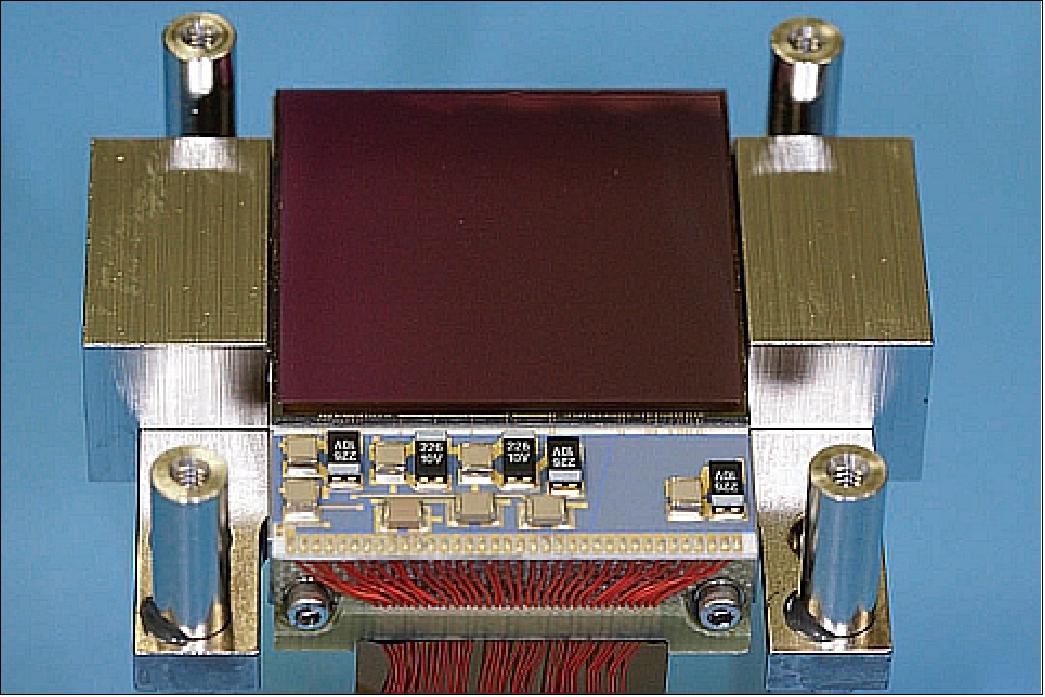
Legend to Figure 61: The Teledyne H2RG detectors are being used in 3 instruments of JWST, namely in NIRCam, NIRSpec, and in FGS/NIRISS.
The NIRCam coronagraph: Each NIRCam module will be equipped with a simple Lyot coronagraph consisting of a selection of focal plane occulters and pupil masks (Lyot stops). The requirements are:
1) Provide imaging to within 0.6 arcsec (4λ/D) of the star at λ = 4.6 μm and to within 0.3 arcsec at λ = 2.1 μm for the detection of extrasolar planets seen in emission.
2) Provide imaging to within 0.8 arcsec (6λ/D) of the star at λ = 4.3 μm, 0.64 arcsec at λ = 3.35 μm, and 0.4 arcsec at λ = 2.1 μm for observations of circumstellar disks seen in reflected light.
3) The occulters must be rigidly mounted and must not interfere with imaging during non-coronagraphic observations, requiring placement outside the normal field of view.
4) Ideally, suppress the diffraction pattern produced by the JWST obscurations to a level equal to or below the scattered light created by the uncorrectable optical surface errors, given the budgeted ~131 nm rms of wavefront error prior to the coronagraphic occulters.
5) Provide sufficient throughput to image 1 Gyr-old Jupiter-mass planets around the nearest late-type stars with 1-2 hours of exposure time.
6) Tolerate 2% pupil misalignments due to pupil wheel positioning errors and telescope-to-instrument rotational offsets.
7) Tolerate 10-40 marcsec (milliarcsecond) of pointing error at λ = 4.6 μm without a significant decrease in performance.
NIRCam Status
• Jan. 6, 2015: The MIRCam instrument surpassed expectations during tests in late 2014. NIRCam performed significantly better than requirements during the first integrated, cryogenic testing program at GSFC (Goddard Space Flight Center), Maryland. 93)
- In April 2014, NASA installed the instrument alongside others in the ISIM (Integrated Science Instrument Module), which finished cryogenic and vacuum testing late last year.
• Flight NIRCam ready for integration into ISIM.
NIRSpec (Near-Infrared multi-object Spectrograph)
NIRSpec is funded by ESA (Project Scientist: Peter Jakobsen of ESA/ESTEC) with Airbus Defince and Space (formerly EADS Astrium GmbH) as prime instrument contractor (the detector arrays and a microshutter are supplied by NASA/GSFC). The key objectives are the study of galaxy formation, clustering, chemical abundances, star formation, and kinematics, as well as active galactic nuclei, young stellar clusters, and measurements of the initial mass function of stars (IMF). 94) 95) 96) 97) 98) 99) 100)
The region of sky to be observed is transferred from the JWST optical telescope element (OTE) to the spectrograph aperture focal plane (AFP) by a pick-off mirror (POM) and a system of foreoptics which includes a filter wheel for selecting band passes and introducing internal calibration sources. The nominal scale at the AFP is 2.516 arcsec/mm.
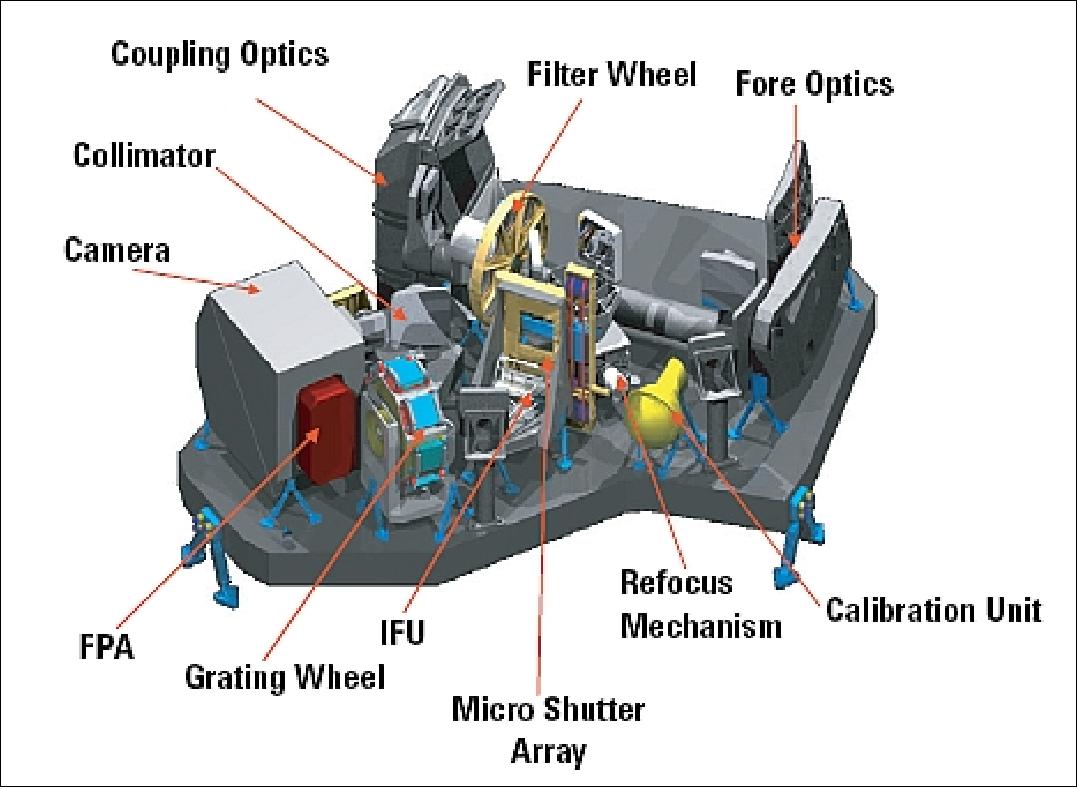
The NIRSpec baseline design uses a micro-electromechanical system (MEMS), consisting of an array of about 1000 x 500 microshutters, to select hundreds of different objects in a single field of view.
The NIRSpec instrument will be the first slit-based astronomical MOS (Multi-Object Spectrograph) in space providing spectra of faint objects over the near-infrared 1.0-5.0 µm wavelength range at spectral resolutions of R=100, R=1000 and R=2700. The instrument's all-reflective wide-field optics, together with its novel MEMS-based programmable microshutter array slit selection device and its large format low-noise HgCdTe detector arrays (2 detectors of 2 k x 2 k pixels), combine to allow simultaneous observations of > 100 objects within a FOV of 3.4 arcmin x 3.6 arcmin with unprecedented sensitivity. 101) 102) 103)

NIRSpec is required to select various spectral band widths and split these up into its comprised wavelengths. These functions are achieved by the FWA (Filter Wheel Assembly) and the GWA (Grating Wheel Assembly). The filters of the FWA select a different bandwidth of the spectrum each while the gratings on the GWA yield specific diffractive characteristic for spectral segmentation. A high spectral sensitivity as well as the ability to detect the spectra of various objects at the same time result in high requirements regarding the positioning accuracy of the optics of both mechanisms in order to link the detected spectra to the 2-dimensional images of the observed objects. 104)
The spectrometer uses diffractive gratings to spatially separate the incoming light and analyze several objects simultaneously. The NIRSpec mechanism yields 6 different gratings and one prism to work with various spectral resolutions and in different ranges of the infrared spectrum. A TAM (Target Acquisition Mirror) allows allocation of the spectra and the corresponding stellar objects. These 8 optical elements are integrated on a GWA (Grating Wheel Assembly) as shown in Figure 64. It exchanges the diffractive optic within the instrument's beam path with high precision to allow correlation of different spectra taken from the same object.
To avoid the overlap of various orders of diffraction on the detector, a set of spectral filters was designed to select the desired wavelength range. These filters are mounted on a mechanism quite similar to the GWA. It moves one filter into the beam path to build a fitting combination of grating in use and preselected range of wavelength. This FWA (Filter Wheel Assembly) holds four edge filters and two band filters for various wavelengths, one clear filter for target acquisition and a mirror assembly for in-orbit calibration and pupil alignment during integration of the mechanism (Figure 65).
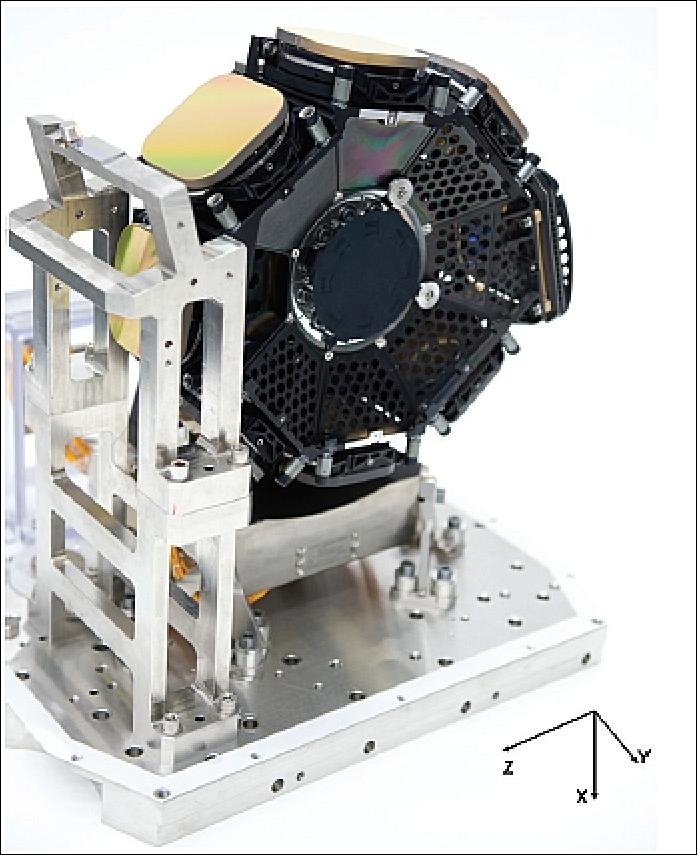
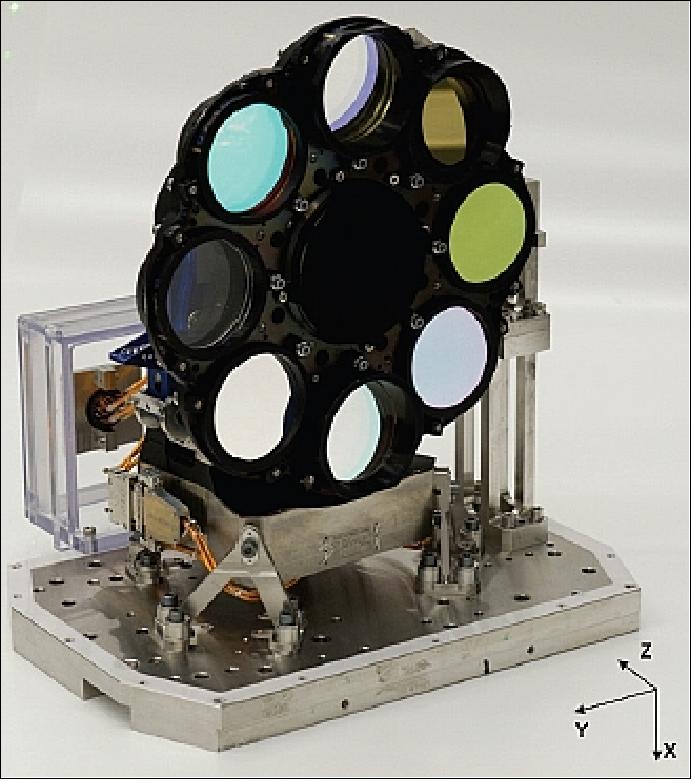
Mechanical alignment: Since both FWA and GWA are mechanisms actively influencing the beam path of the instrument, precise and repeatable alignment of the currently used optic, it is essential to ensure a stable image on the detector. Especially the GWA alignment is crucial since its optic works in reflection where every tilt of the optic is carried over directly into the alignment of the instrument. The FWA on the other hand uses planar elements working in transmission inducing but a fraction of their misalignment into an aberration of the beam (Ref. 104).
NIRSpec includes also an IFU (Integral Field Unit) device with the objective to study of the dynamics of high redshift galaxies. This device provides in addition a NIRSpec backup acquisition mode for spectroscopy. The IFU permits a 2-D spectral characterization of astronomical objects with unprecedented depths, especially in the 2-5 µm wavelength range. The IFU covers a FOV of 3 arcsec x 3 arcsec and provides five fixed slits for detailed spectroscopic studies of single objects. The NIRSpec-IFU is expected to be capable of reaching a continuum flux of 20 nJy (AB>28) in R=100 mode, and a line flux of 6 x 10-19 erg s-1 cm-2 in R=1000 mode at an SNR> 3 in an exposure period of 104 s.
The FPA (Focal Plane Array) consists of sub-units, each 2 k x 2 k, forming an array of 2 k x 4 k sampled at 100 marcsec (milliarcsecond) pixels. The detectors are thinned HgCdTe arrays (ASICs) built by the Rockwell Science Center and referred to as SIDECAR (System for Image Digitization, Enhancement, Control and Retrieval). Each of the two ASICs has 2048 x 2048 pixels, pixel size of 18 µm, pixel scale = 100 mas (micro arcseconds), the data are locally digitized. 105)
The NIRSpec also contains a calibration unit with a number of continuum and line sources.

Multiobject spectroscopy: A special MEMS device, referred to as MSA (MicroShutter Array), is being developed at NASA/GSFC to be used as a programmable field selector for NIRSpec. The objective is to provide a means to observe numerous objects simultaneously and to eliminate the confusion caused by all other sources. MSA consists of microshutter arrays arranged in a 2 x 2 quadrant mosaic. Each quadrant represents a closely packed array of 175 x 384 of shutters each of which may be addressed independently - allowing only the light from objects of interest into the instrument. The MSA covers a FOV of 3.6 arcmin x 3.6 arcmin (each microshutter has a FOV of 0.2 x 0.4 arcsec) - allowing the simultaneous observation of about 100 objects.
The microshutters themselves are MEMS devices produced on a thin silicon nitride membrane on 100 µm x 200 µm pitch (spectral x spatial direction). They are actuated magnetically and latched and addressed electrostatically. The MSA object selection feature represents an enabling technology development with a first introduction in spaceborne astronomy. 106)
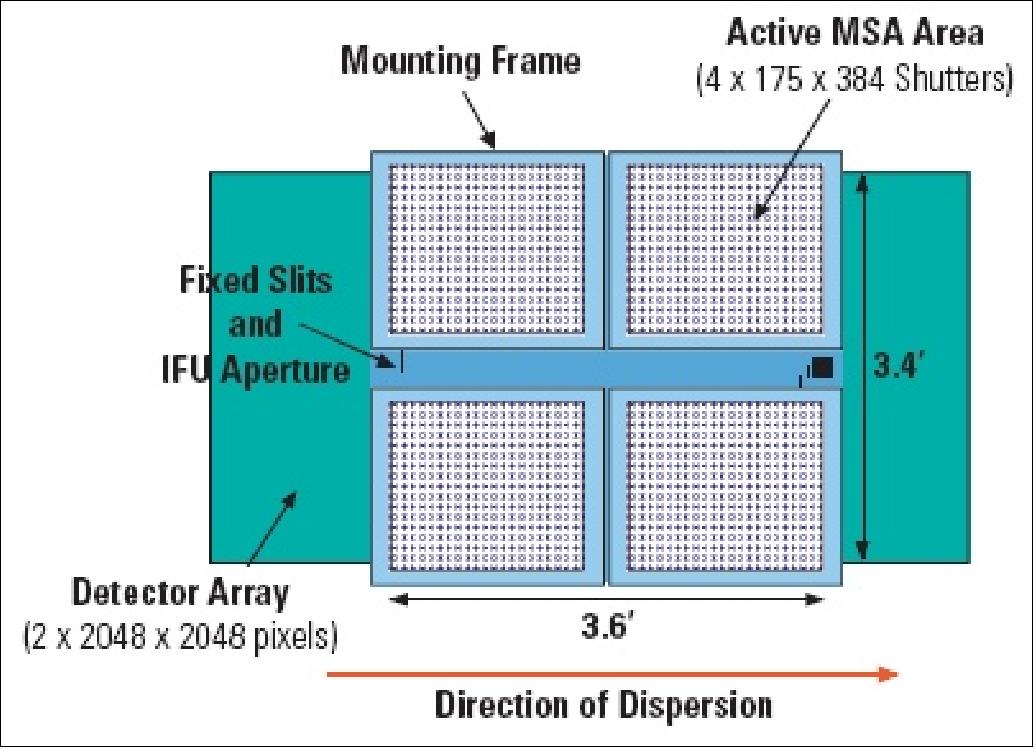
The MSA microshutter array consists of ust under a quarter of a million individually controlled microshutters. By programming the array to only open those shutters coinciding with pre-selected objects of interest, light from these objects is isolated and directed to the spectroscopic stage of NIRSpec to produce the spectra.
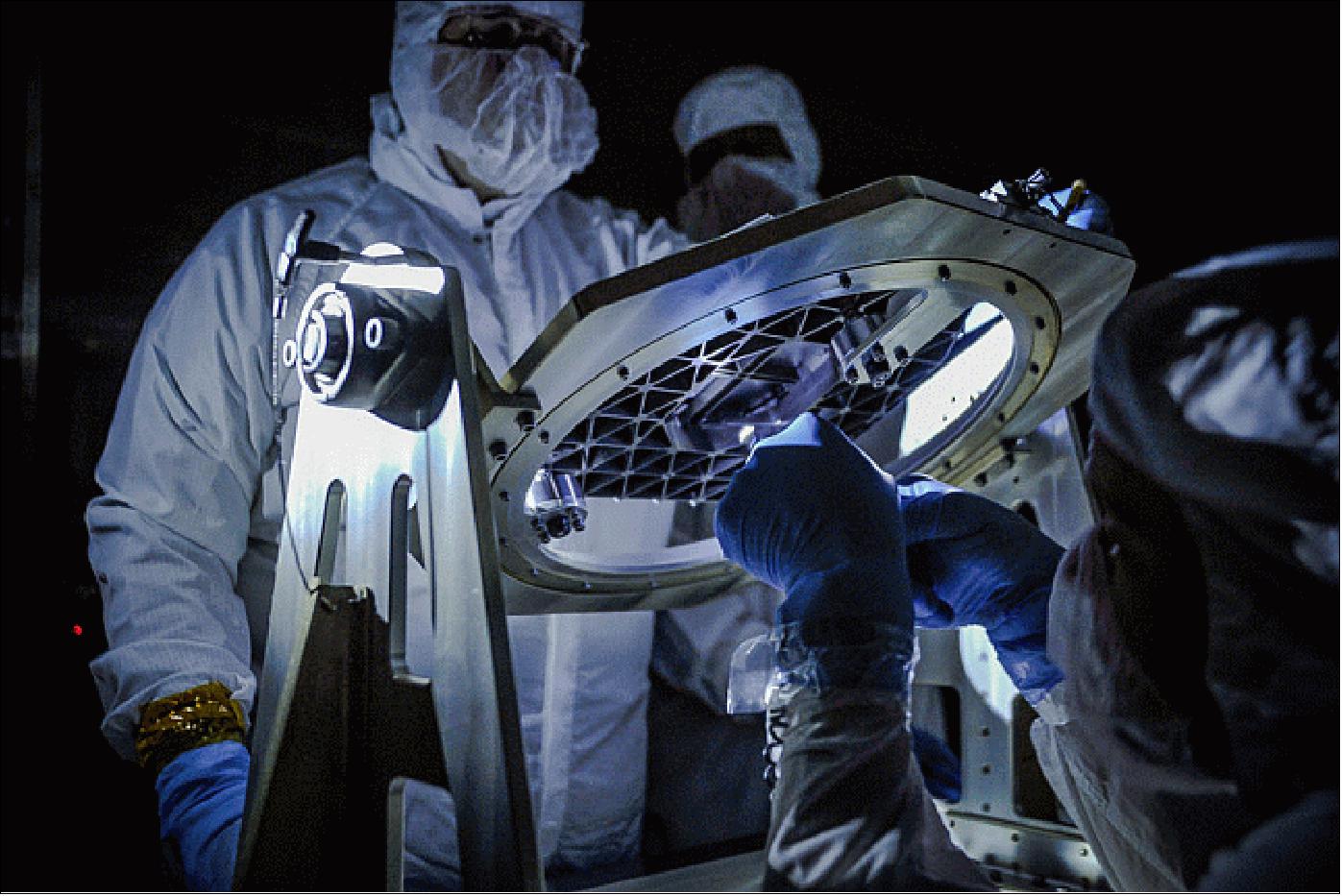
Legend to Figure 68: The inspection light source is held by the technician at the front of the picture. Four array quadrants are located within the octagonal frame in the center of a titanium mosaic base plate.
The team, led by Principal Investigator Harvey Moseley of GSFC has demonstrated that electrostatically actuated microshutter arrays — that is, those activated by applying an specific voltage — are as functional as the current technology's magnetically activated arrays. This advance makes them a highly attractive capability for potential Explorer-class missions designed to perform multi-object observations. 109)
Considered among the most innovative technologies to fly on the Webb telescope, the microshutter assembly is created from MEMS technologies and comprises thousands of tiny shutters, each about the width of a human hair. Assembled on four postage-size grids or arrays, the 250,000 shutters open or close individually to allow only the light from targeted objects to enter Webb's NIRSpec, which will help identify types of stars and gases and measure their distances and motions. Because Webb will observe faint, far-away objects, it will take as long as a week for NIRSpec to gather enough light to obtain good spectra.
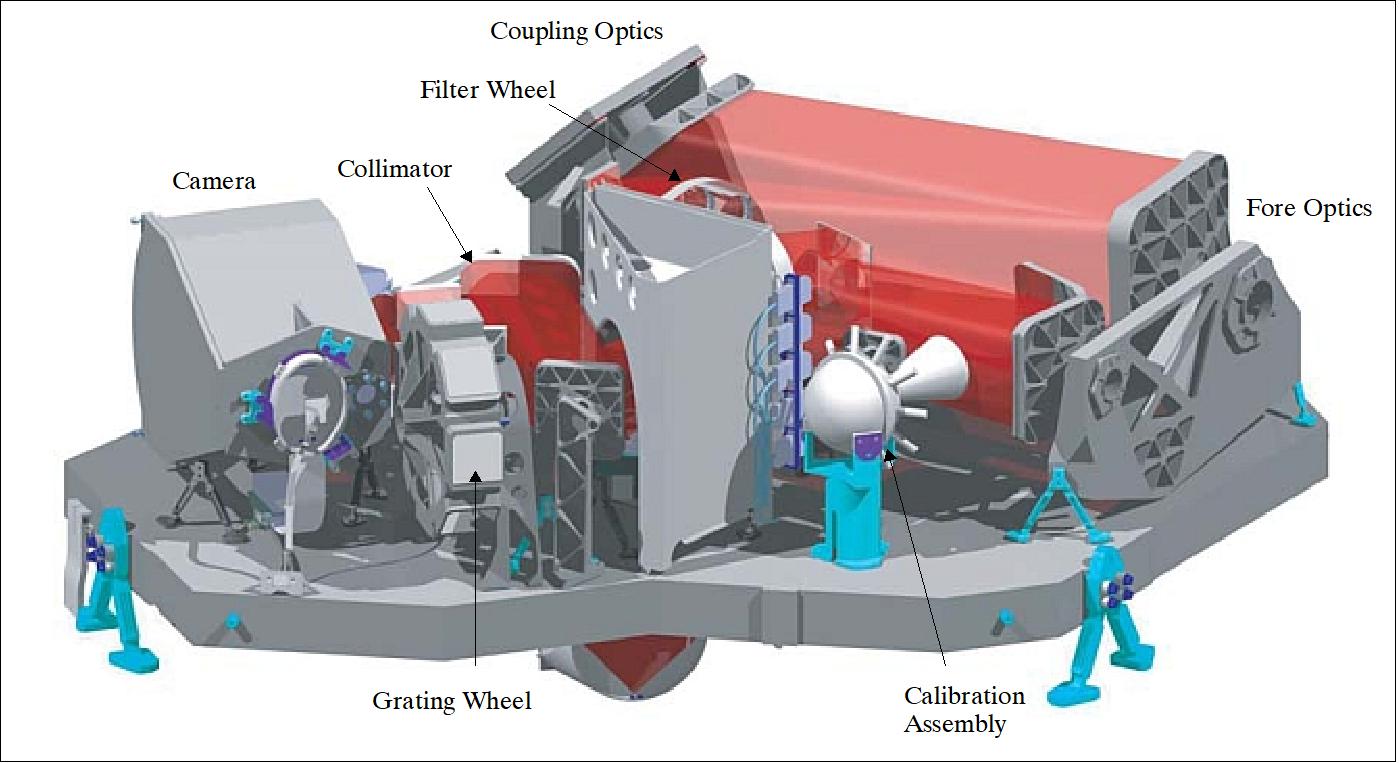
The NIRSpec instrument has a size of about 1.90 m x 1.3 m x 0.7 m and an estimated mass of about 196 kg.
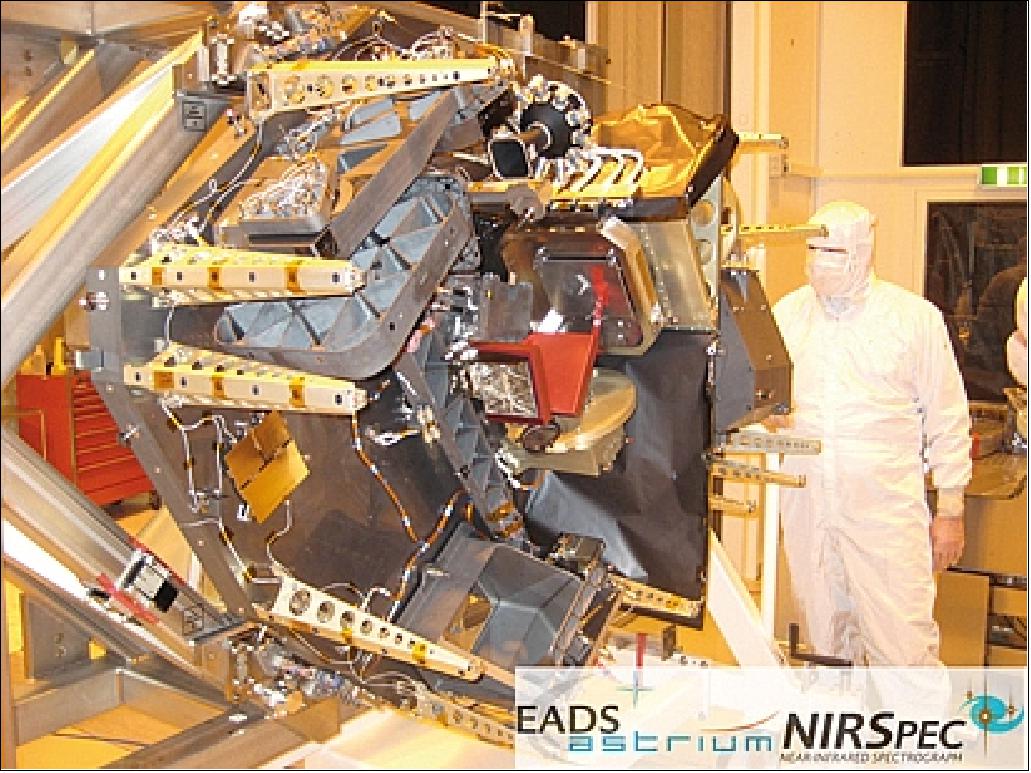
The spectrograph structure is built from silicon carbide (SiC) - a monolithic ceramic providing the properties to meet the extremely high demands for dimensional stability and geometrical accuracy for the optical assembly. Geometrical distortions between NIRSpec and the ISIM, generated by very high temperature differences between cryogenic operational and ambient on ground environment are balanced by so called Kinematic Mounts made from titanium alloy. The need to exchange these parts without losing optical performance of the already aligned instrument led to the development of a highly sophisticated exchange procedure. 110)
The existing Kinematic Mounts already integrated on the Flight Model of NIRSpec were declared non-flight-worthy due to a detection of a manufacturing issue within the tapered areas, dedicated for flexural bending. Consequently a remanufacturing of the three OBKs (Optical Bench Kinematic Mounts) was decided and the development of an exchange philosophy considering all aspects of safety and technical requirements was developed in a joint team of ESA and Airbus Defence and Space.
Due to the detailed planning, preparation and practice, the actual exchange on the NIRSpec flight hardware was performed in five days without any procedure variation. The exchange was successfully performed as trained before.
The dye penetrant investigations performed in between the individual OBK exchange activities confirmed no damage of the SiC interfaces of the OBBP (Optical Bench Base Plate). These results were backed by acoustic monitoring which showed that no shock was introduced and no crack was initiated inside the SiC structure.
The results of the online optical measurements showed that the relative position and the PAR (Pupil Alignment Reference) remained stable within the measurement accuracy better than 3 acrsec angular and 10 µm relative PAR center displacement.
Status of NIRSpec
• July 20, 2015: Engineers from Airbus and ESA (European Space Agency) work inside NASA Goddard Space Flight Center's large clean room to remove the cover on Webb Telescope's NIRSpec (Near InfraRed Spectrometer) instrument in preparation for the replacement of the MSA (Micro Shutter Array) and the FPA (Focal Plane Assembly). 111)
• Feb. 2015: The past two months have seen a team of engineers engaged in the intricate activity of replacing key components of the NIRSpec (Near InfraRed Spectrograph) on the James Webb Space Telescope. The instrument is now ready for the next series of extensive environmental tests devised to ensure that JWST's instruments can withstand the stresses and strains of launch and operation in space. 112) 113) 114)
- In the summer of 2014, the JWST Integrated Science Instrument Module (ISIM), fitted with all four instruments (NIRSpec, MIRI, NIRCam, and FGS/NIRISS), successfully completed cryogenic testing in a '24/7' campaign that lasted 116 days.
- However, the positive outcome of this important test campaign did not mean that ISIM and the instruments were ready for integration onto JWST's telescope. It has been known for over a year that additional work would be necessary to get some of the instruments into their final flight configuration. As a consequence, a period of a few months was allocated for these activities, immediately after the completion of the cryogenic test campaign.
- In particular, NIRSpec needed to have its detectors, microshutter assembly and optical assembly cover replaced. Also, the NIRCAM and FGS/NIRISS teams had to exchange some components in their instruments. MIRI was the only instrument that remained integrated with the ISIM. However, MIRI's configuration was also updated by installing the flight model cooler Cold Head Assembly (CHA) and exchanging some of the cooler lines and their supports.
- The first generation of JWST's highly sensitive near-infrared detectors were found to suffer from a design flaw that resulted in a progressive degradation of their performance. New detectors have now been installed in all three near-infrared instruments.
- Another crucial component of NIRSpec are its MSA (Microshutter Assembly), a new technology developed for JWST by NASA. - One of the defining and pioneering features of NIRSpec is its ability to analyze the light from more than 100 astronomical objects at the same time. This is made possible by an assembly of four microshutter arrays, totalling almost a quarter of a million individual shutters.
- One of the defining and pioneering features of NIRSpec is its ability to analyze the light from more than 100 astronomical objects at the same time. This is made possible by an assembly of four MSAs, totalling almost a quarter of a million individual shutters.
- The cryogenic test revealed that several thousand of the individual microshutters had become inoperable and could not be opened. This susceptibility to acoustic noise was not expected and had gone undetected because of the difficulty of reproducing the environment to which the microshutters are actually subjected in this instrument. As a result of this problem, the performance of the microshutters in NIRSpec was strongly degraded. The NIRSpec Engineering Test Unit (ETU) provided the most realistic test environment for the MSA. These various tests provided a wealth of information that helped NASA to identify the cause of the 'failed closed' shutters issue.
- The new MSA contains three 'original design' arrays and one 'new design' array. In addition to most arrays being pre-screened at array level, the complete new MSA flight model was acoustically tested in the NIRSpec ETU before it was installed in the flight version of NIRSpec.
• April 4, 2014: An important milestone for JWST was passed on 25 March with the installation of the NIRSpec instrument on the ISIM (Integrated Science Instrument Module) at NASA/GSFC. All four science instruments are now in place on the ISIM, ready for the next series of tests. 115)
• Feb. 2014: The NIRSpec instrument is being installed on the ISIM (Integrated Science Instrument Module) at Goddard in preparation for an extensive series of tests with the full instrument complement. In addition, new detectors have been selected for NIRSpec, to be installed later this year. 116)
• Sept. 30, 2013: The NIRSpec instrument has arrived at the NASA/GSFC. 117)
• In early September 2013, the NIRSpec instrument, built by Astrium GmbH, was formally handed over to ESA. This marks an important milestone in Europe's contribution to the JWST mission. Having undergone rigorous testing in Europe, NIRSpec will be shipped to NASA later this month for integration into JWST's instrument module, followed by further testing and calibration as the whole observatory is built up. 118)
MIRI (Mid-Infrared Camera-Spectrograph)
MIRI is a joint instrument development of NASA and ESA. The instrument optics module and optical bench will be provided by the European MIRI Consortium funded by the ESA member states. NASA/JPL will provide the remainder of the instrument, notably the detector and cryostat subsystems. Within the joint instrument science team, Gillian S. Wright of the UKATC (UK Astronomy Technology Center), Edinburgh, is the PI of the European MIRI Consortium while George H. Rieke at the Steward Observatory of the University of Arizona (UA) is the MIRI PI for NASA. ESA coordinates the activities of the European MIRI Consortium (21 institutes from 10 countries) while EADS Astrium Ltd. functions as the main instrument contractor. The MIRI instrument has a mass of ~ 103 kg. 119) 120) 121) 122) 123) 124) 125) 126) 127)
Note: The ROE (Royal Observatory Edinburgh) comprises the UKTAC (UK Astronomy Technology Center) of the Science and Technology Facility Council (STSC), the Institute of Astronomy of the University of Edinburgh and the ROE Visitor Center.
Further participating European organizations in the MIRI project are: Astron, The Netherlands; CCLRC, Rutherford Appleton Laboratory (RAL), UK; CEA Service d'Astrophysique, Saclay, France; Centre Spatial De Liège, Belgium; CSIC (Consejo Superior de Investigaciones Científicas), Spain; DSRI (Danish Space Research Institute), Denmark; Dublin Institute for Advanced Studies, Ireland; IAS (Institut d'Astrophysique Spatiale), Orsay, France; INTA (Instituto Nacional de Técnica Aeroespacial), Spain; LAM (Laboratoire d'Astrophysique de Marseille), France; MPIA (Max-Planck-Institut fur Astronomie), Heidelberg, Germany; Observatoire de Paris, France; PSI (Paul Scherrer Institut), Switzerland; University of Amsterdam, The Netherlands; University of Cologne, Germany; University of Leicester, UK; University of Leiden, The Netherlands; University of Leuven, Belgium; University of Stockholm, Sweden.
As part of the European cooperation with NASA on the JWST program, MIRI was set up as a 50 : 50 partnership between ESA and NASA, with the European Consortium (EC) in charge of the optical bench assembly and the JPL (Jet Propulsion Laboratory) in charge of the detector system, the cooling system, and the flight software (Figure 71). In addition to the responsibilities shown, GSFC (Goddard Space Flight Center) provides the harness between the optical module and the ICE (Instrument Control Electronics). The formal delivery of the MIRI Optical System, including the detectors chain provided by JPL, to NASA is the responsibility of ESA.
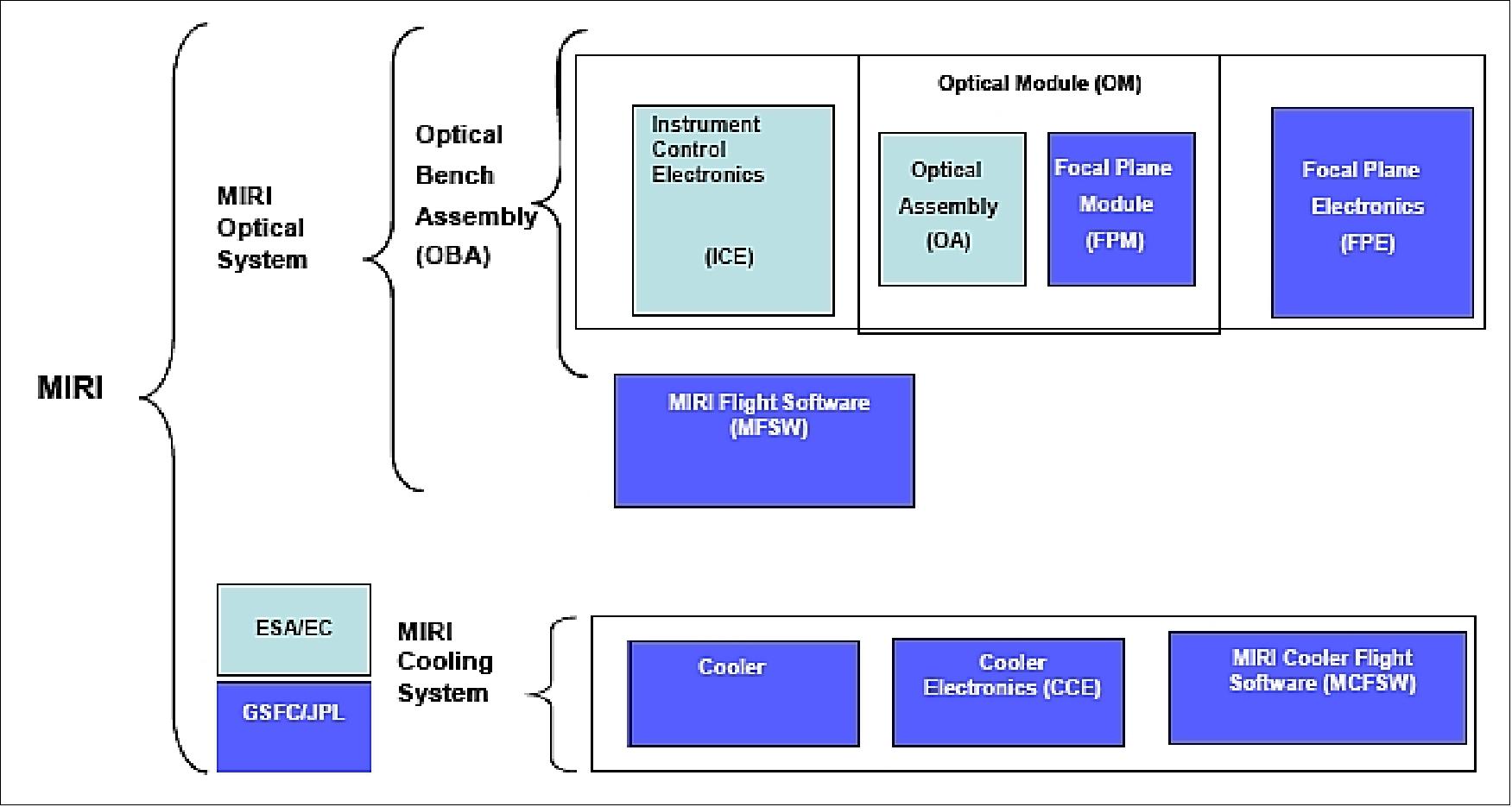
In contrast to other science missions, where each scientific instrument has its own dedicated computer, on JWST there is one unit for all instruments where the flight software for each instrument resides – the ICDH (Instrument Control and Data Handling) electronics. Failure modes and event upsets are handled in this unit. The ICDH interfaces via an IEEE-1553B (MIL-STD-1553B) bus to the dedicated control electronics for the instrument mechanisms (ICE) and, via a remote services unit, for the FPE (Focal Plane Electronics) unit as shown in Figure 72.
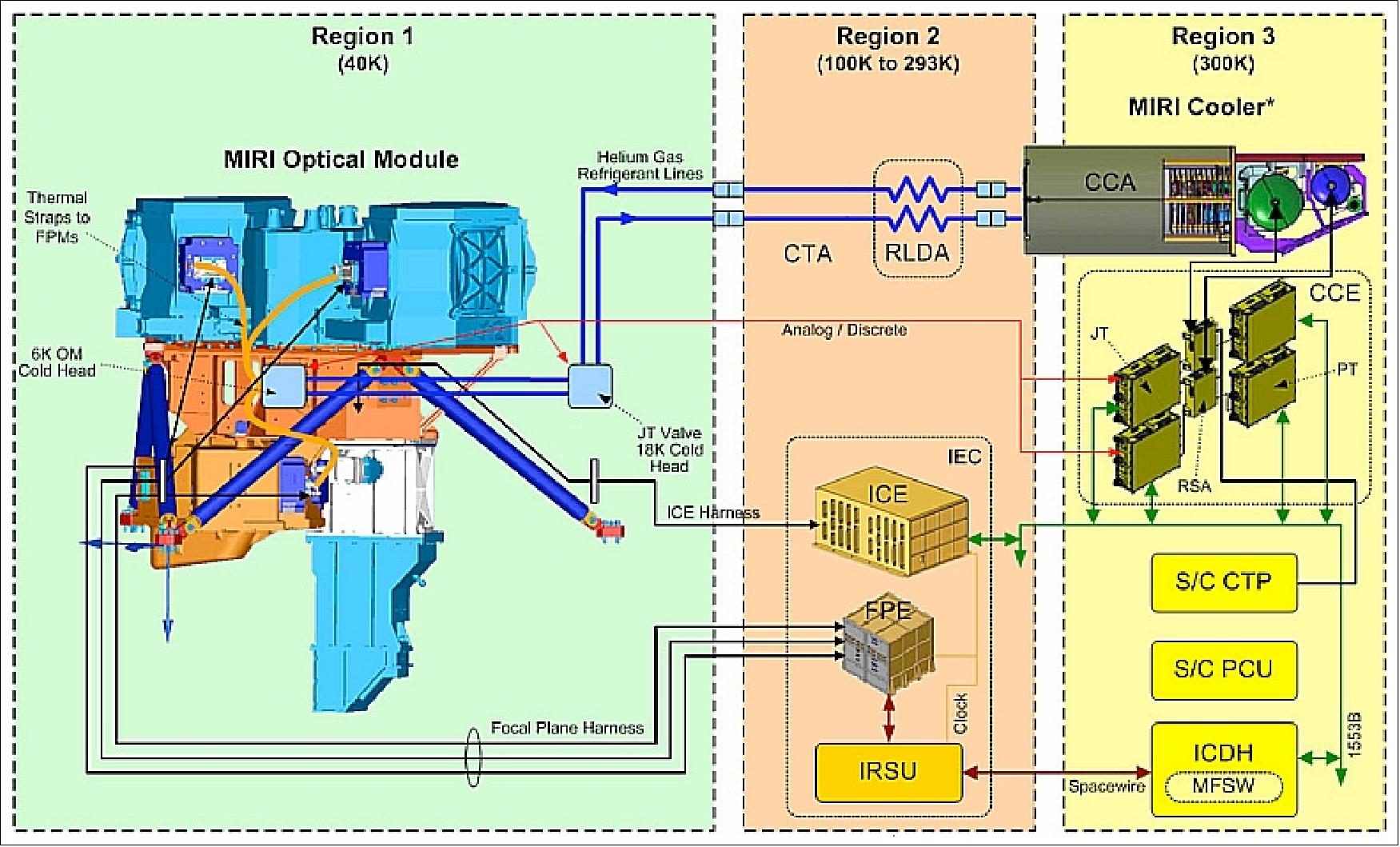
MIRI's principal science objectives relate to the origin and evolution of all cosmic constituents, in particular to galaxy formation, star formation, and planet formation on a wide range of spatial and temporal scales. MIRI is to provide imaging, coronagraphy and low- and medium-resolution spectroscopy in the mid-infrared band (the 5-28 µm), representing a broad wavelength response in the thermal infrared. To achieve an optimized detection sensitivity, MIRI requires a high photon conversion efficiency as well as spectral and spatial passbands matched to the observation targets.
The MIRI design features an imager and a dual spectrometer (Figure 74). Light enters from the telescope through the IOC (Input Optics and Calibration) module. The IOC is part of the MIRI Optical Bench Assembly. It is designed to pick-off the MIRI field of view from the JWST Fine Steering Mirror and to relay the relevant parts of this FOV into the spectrometer and into the imager subsystems. The IOC additionally provides in-flight calibration fluxes to the imager and is mounted onto the MIRI primary structure (deck) and is operated at about 6 K. The IOC is being provided by CSL (Centre Spatial de Liege) of Liege University, Belgium.
The imager and the two spectrometer modules are based on all reflecting designs. The optical configuration of MIRI supports four science modes:
1) Photometric imaging in a number of bands from 5.6-25.5 µm within a FOV of 1.9 arcmin x 1.4 arcmin
2) Coronagraphy with a spectral range 10-27 µm in 4 bands (10.65, 11.4, 15.5, and 23 µm)
3) Low-resolution (R = 100) resolving power slit spectroscopy of single objects in the spectral range 5-11 µm
4) Medium-resolution (~100 km/s velocity resolution) integral field spectroscopy in the spectral range 5-28.5 µm over FOVs growing with wavelength from 3.5 x 3.5 to 7 arcsec x 7 arcsec.
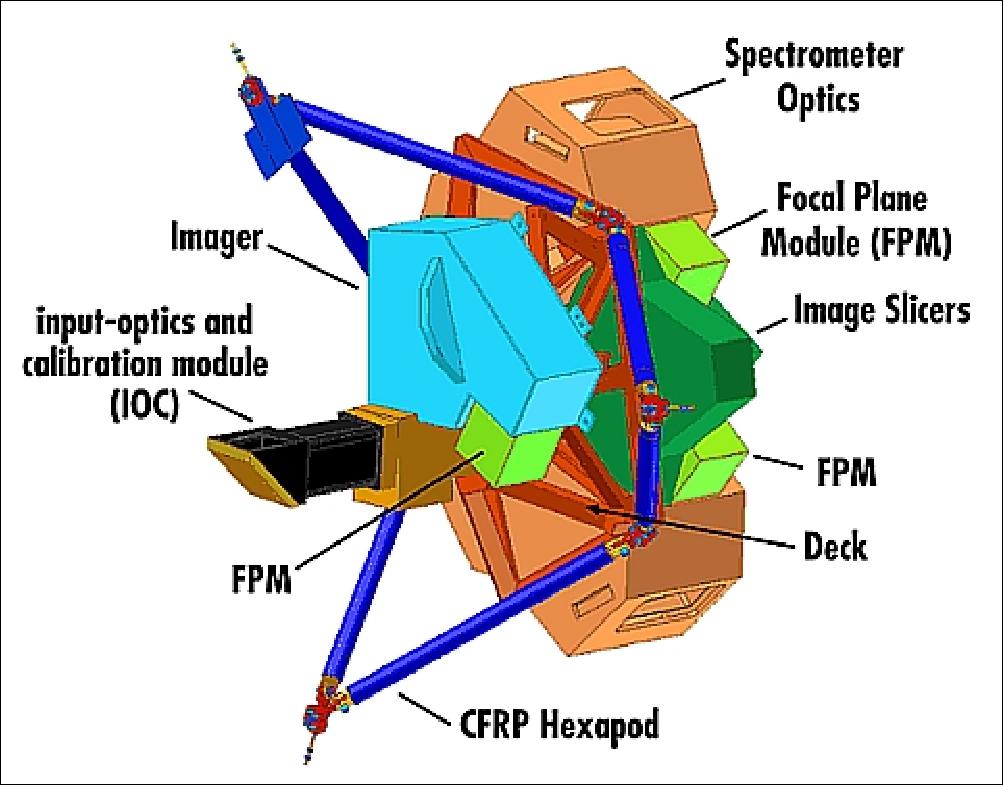
The optical concept splits the instrument into two separate channels operating over the 5 to 28 µm wavelength range, one for imaging (over a 1.9 x 1.4 arcmin FOV) and one for medium resolution spectroscopy (up to 8 x 8 arcmin FOV). The functional split into two parts was chosen because it was found that it simplified the internal optical interfaces, and the complexity of the layout and of the mechanisms. Both the imager and spectrometer channels are fed by common optics from a single pick-off mirror placed close to the telescope focal plane, and fed also by a common calibration subsystem. - The pick-off mirror in front of the JWST OTE focal plane directs the MIRI FOV towards the imager. A small fold mirror adjacent to the imager light path picks off the small (up to 8 x 8 arcsec) FOV of the spectrometer. A second tilting fold in the spectrometer optical path is used to select either light from the telescope or from the MIRI calibration system.
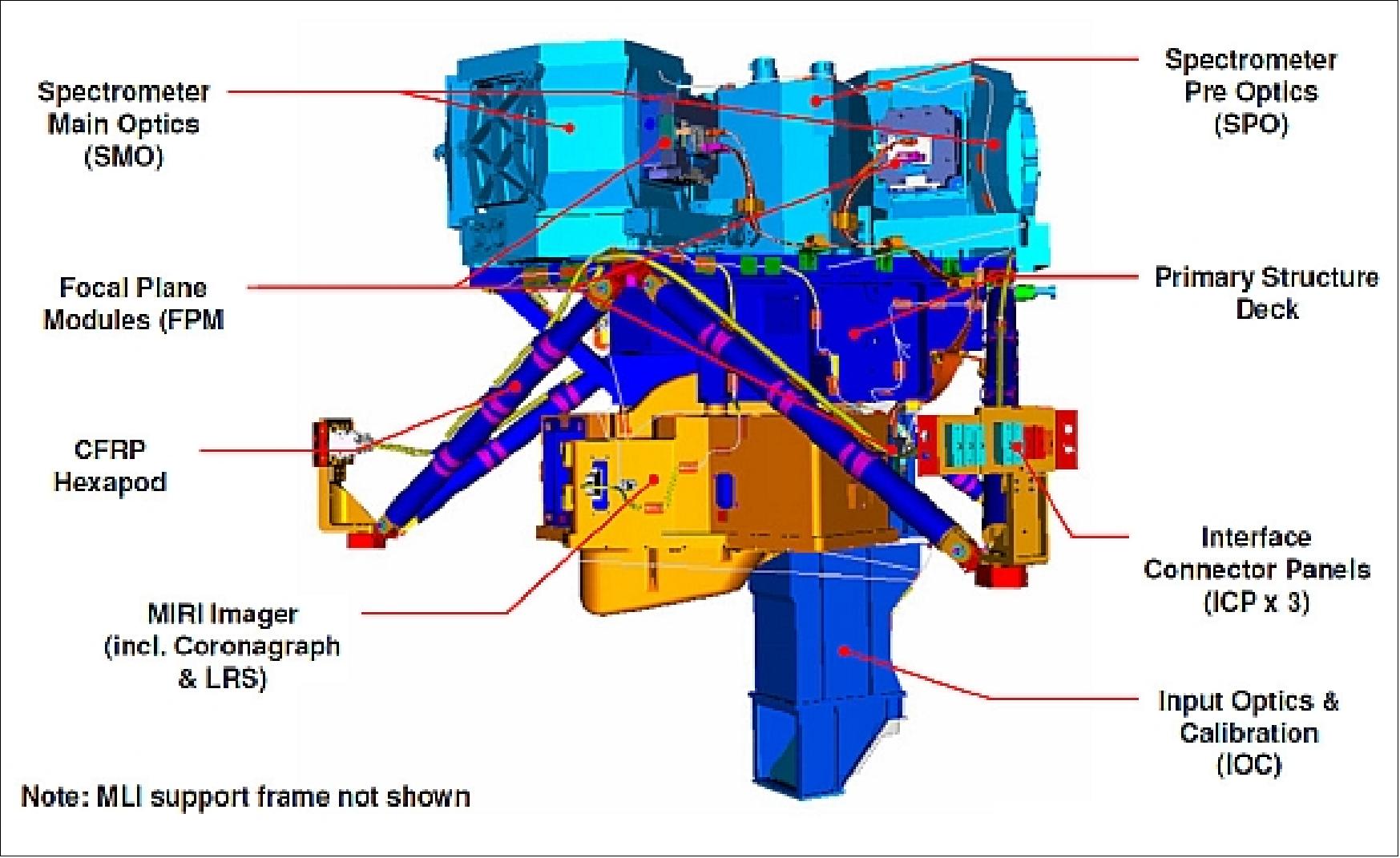
The MIRI spectrometer is comprised of two parts, the SPO (Spectrometer Pre-Optics), built by UKATC, and the SMO (Spectrometer Main Optics), built by Astron, The Netherlands. The two parts of the spectrometer combine together using a spectrograph filter wheel which is made by MPIA (Max Planck Institute of Astronomy). The SPO houses the image slicers and the dichroic/grating wheels. Light enters the SPO directly from the IOC. Light passes from the image slicer, through a series of mirrors, to the FPM. The FPM in turn is located in the SMO. 128) 129)
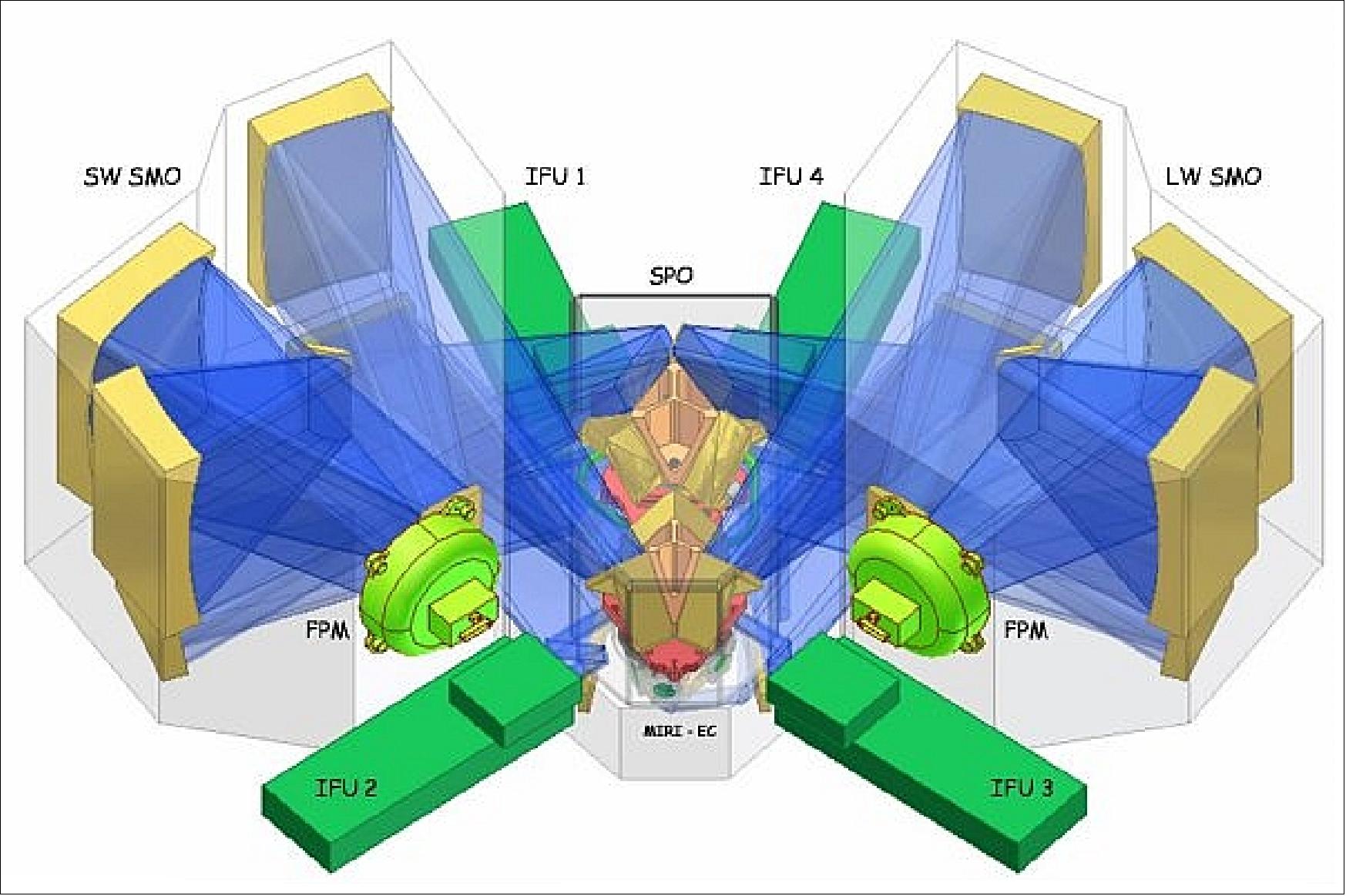
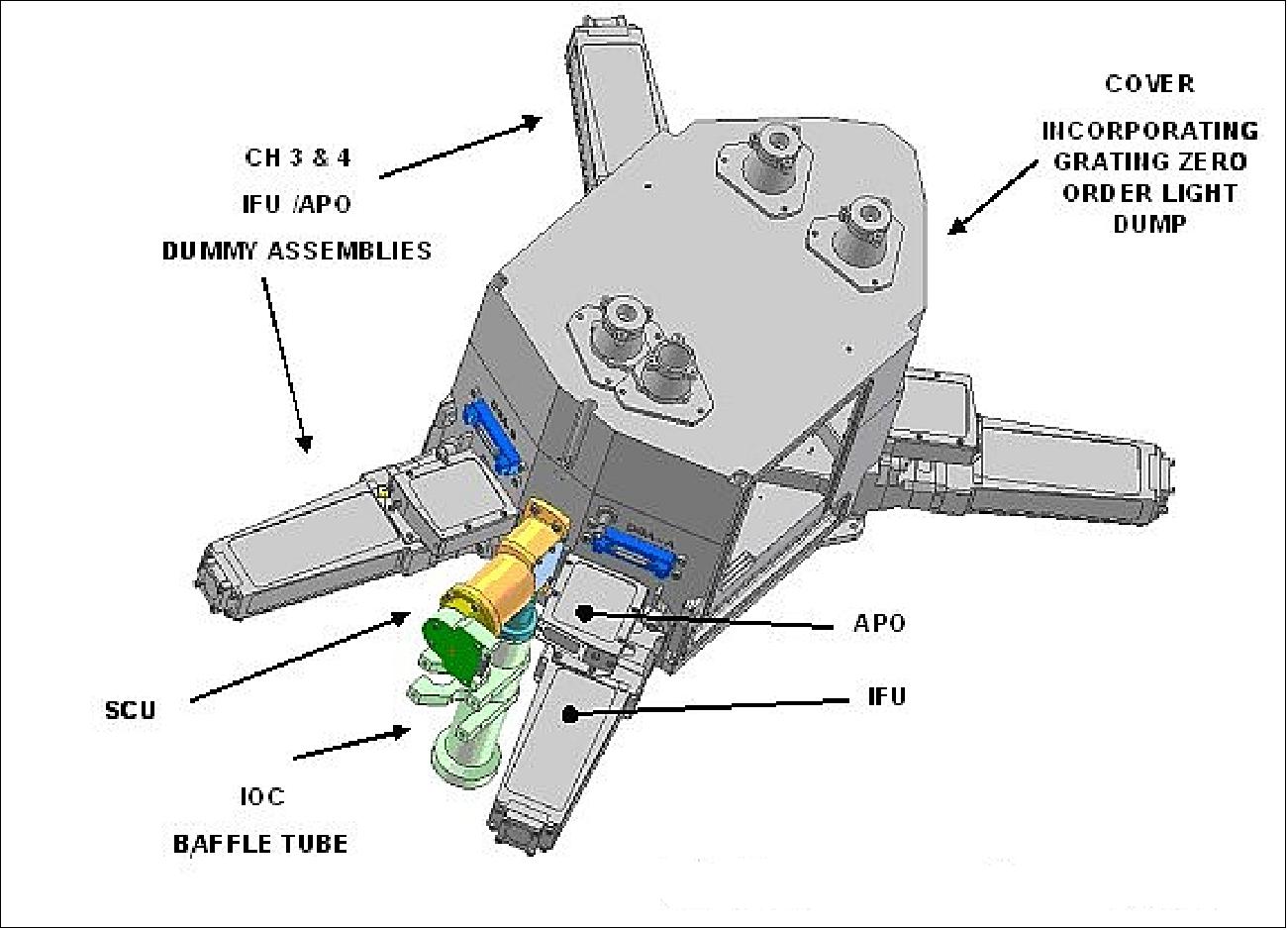
The light is divided into four spectral ranges by the dichroics, and two of these ranges are imaged onto each of the two detector arrays. Along the way to the appropriate array, the light is dispersed by a diffraction grating. The gratings are mounted on mechanical turrets with three for each spectral range. A full spectrum is obtained by taking exposures at the three settings of each mechanical turret - the turrets are ganged together and operated with a single mechanism, and the dichroics allow the same spot on the sky to be distributed to all four spectrometer arms. Thus, only three exposures are required to obtain a complete spectrum.
Channel | 1 | 2 | 3 | 4 |
Nr of slices (N) | 21 | 17 | 16 | 12 |
Wavelength range (µm) | 5.5-7.7 | 7.7-11.9 | 11.9-18.3 | 18.3-28.3 |
Slice width (arcsec) | 0.176 | 0.277 | 0.387 | 0.645 |
FOV (arcsec) | 3 x 3.87 | 3.5 x 4.42 | 5.2 x 6.19 | 6.7 x 7.73 |
Resolving power | 2400-3700 | 2400-3600 | 2400-3600 | 2000-2400 |
The imager module has a combined FOV for the imager and coronagraph/low-resolution spectrometer modes. The coronagraph masks are placed at a fixed location on one edge of the imager field.
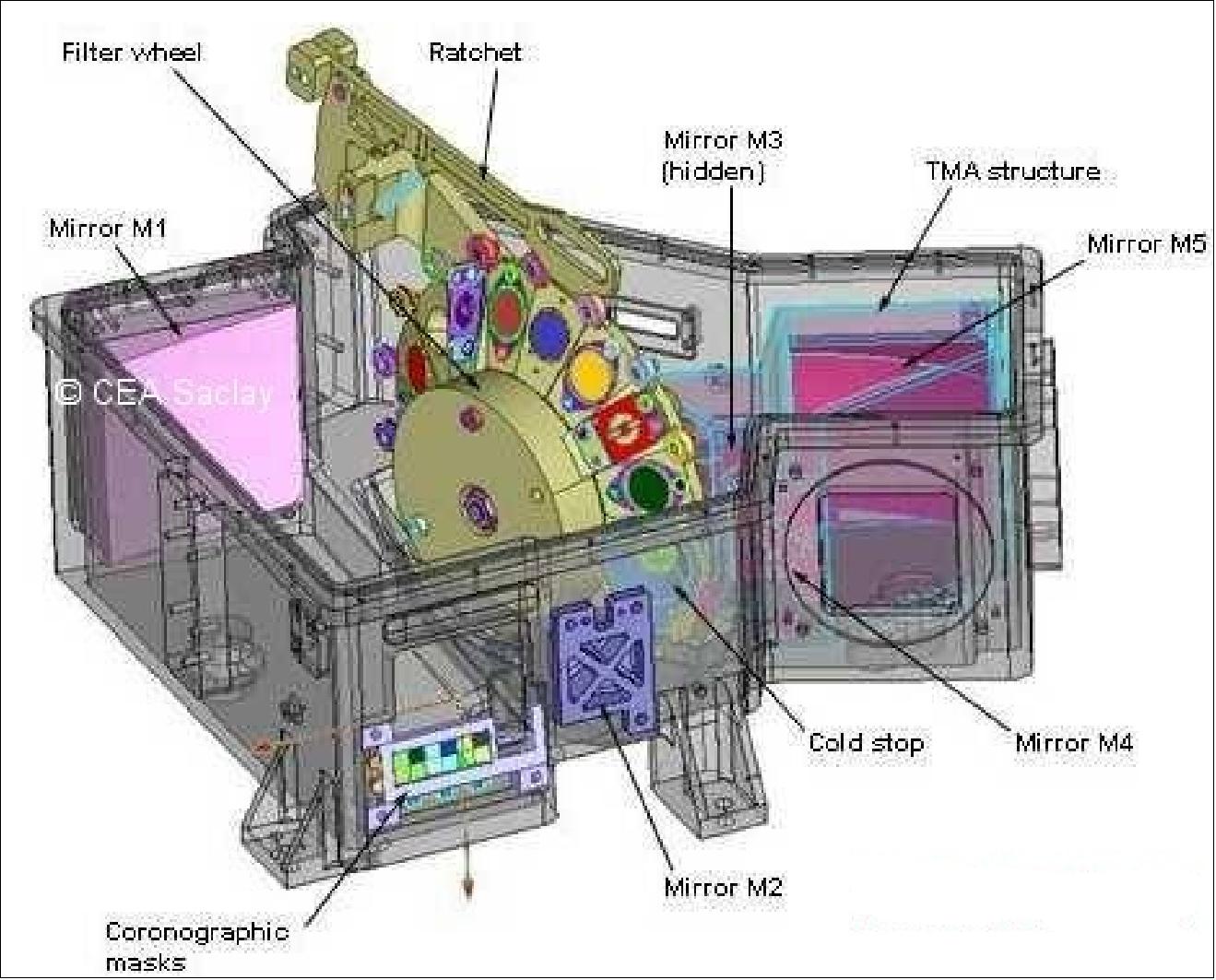
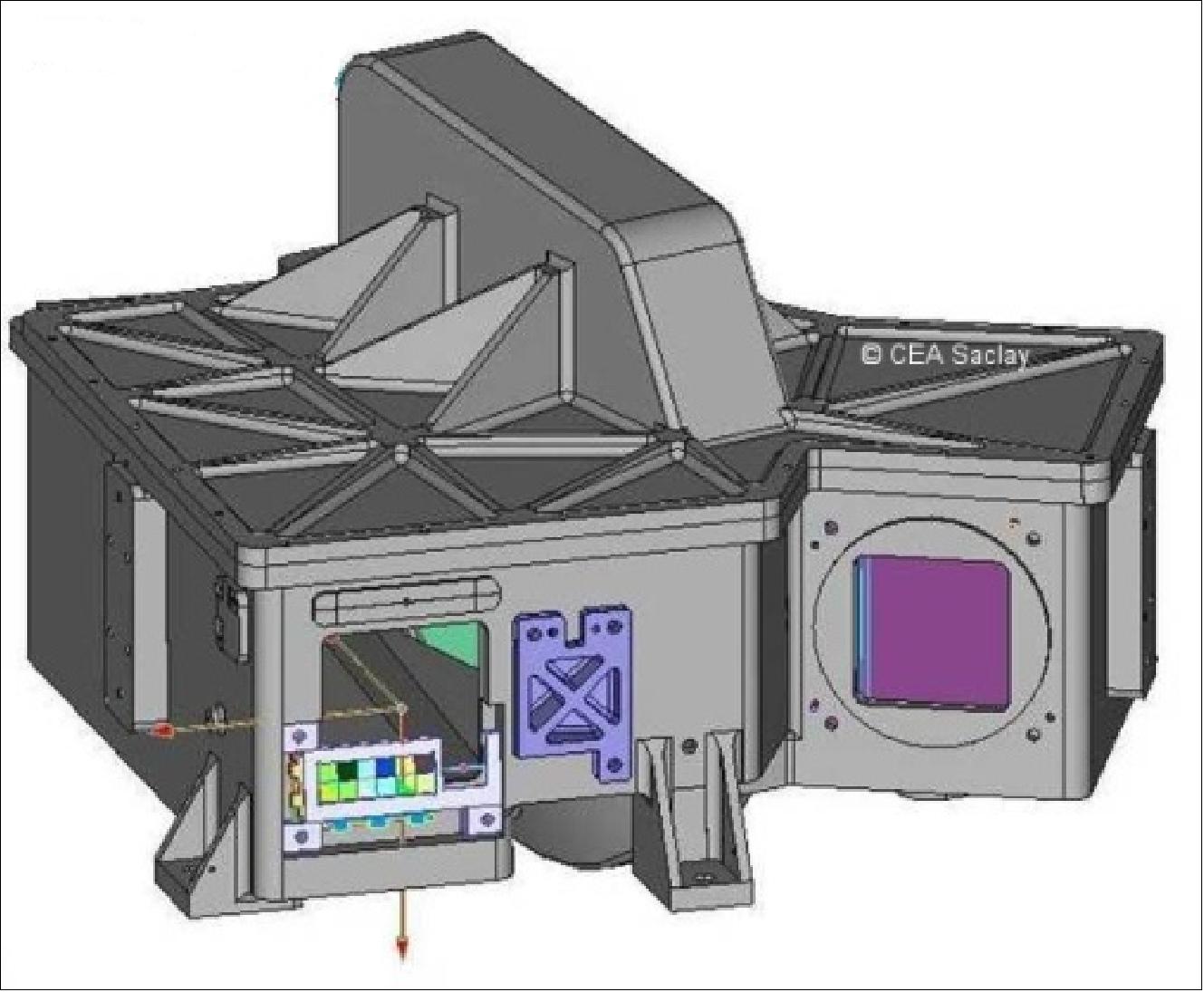
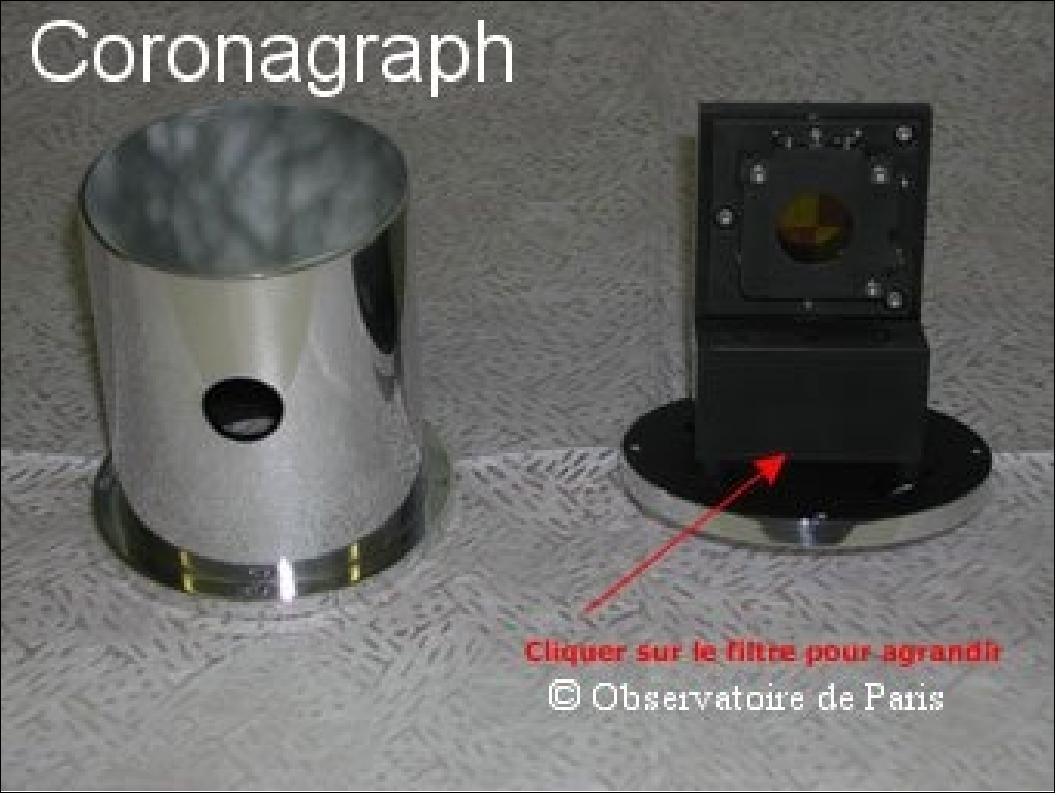
The instrument uses phase mask coronagraphs. They reject the light of a central source by introducing phase shifts using a quadrant-design plate at the instrument input focal plane. These shifts cause the light from the source to interfere destructively at the detector array. Unlike conventional occulting Lyot coronagraphs, phase plates allow measurements to be obtained very close to the central object. Further from the central object, they provide performance similar to that of a conventional occulting coronagraph. The 4-quadrant phase mask is dividing an Airy disk (image of a point source) in the center of the field into 4 domains; and it applies a phase difference of p to two of them, so that the image is eliminated by destructive interference.
The dichroic filter wheel comprises three working positions to move gratings and dichroics simultaneously. Each is located on separate wheel discs. The two wheels feed light in to the four spectrometer channels inside MIRI.
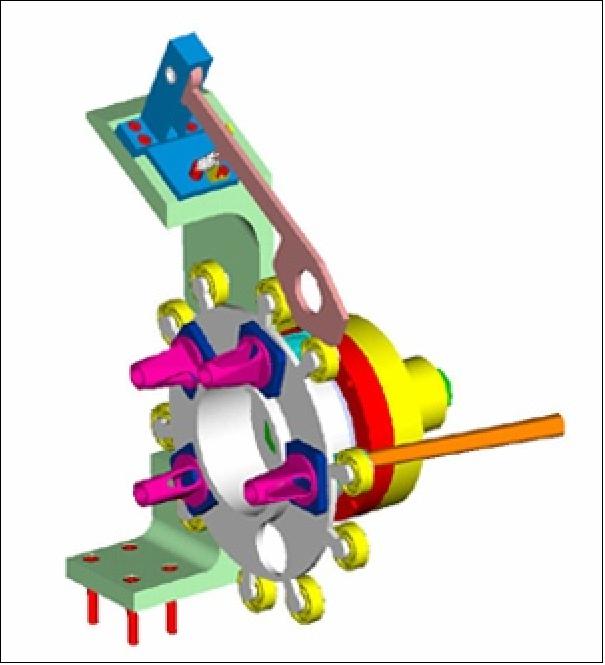
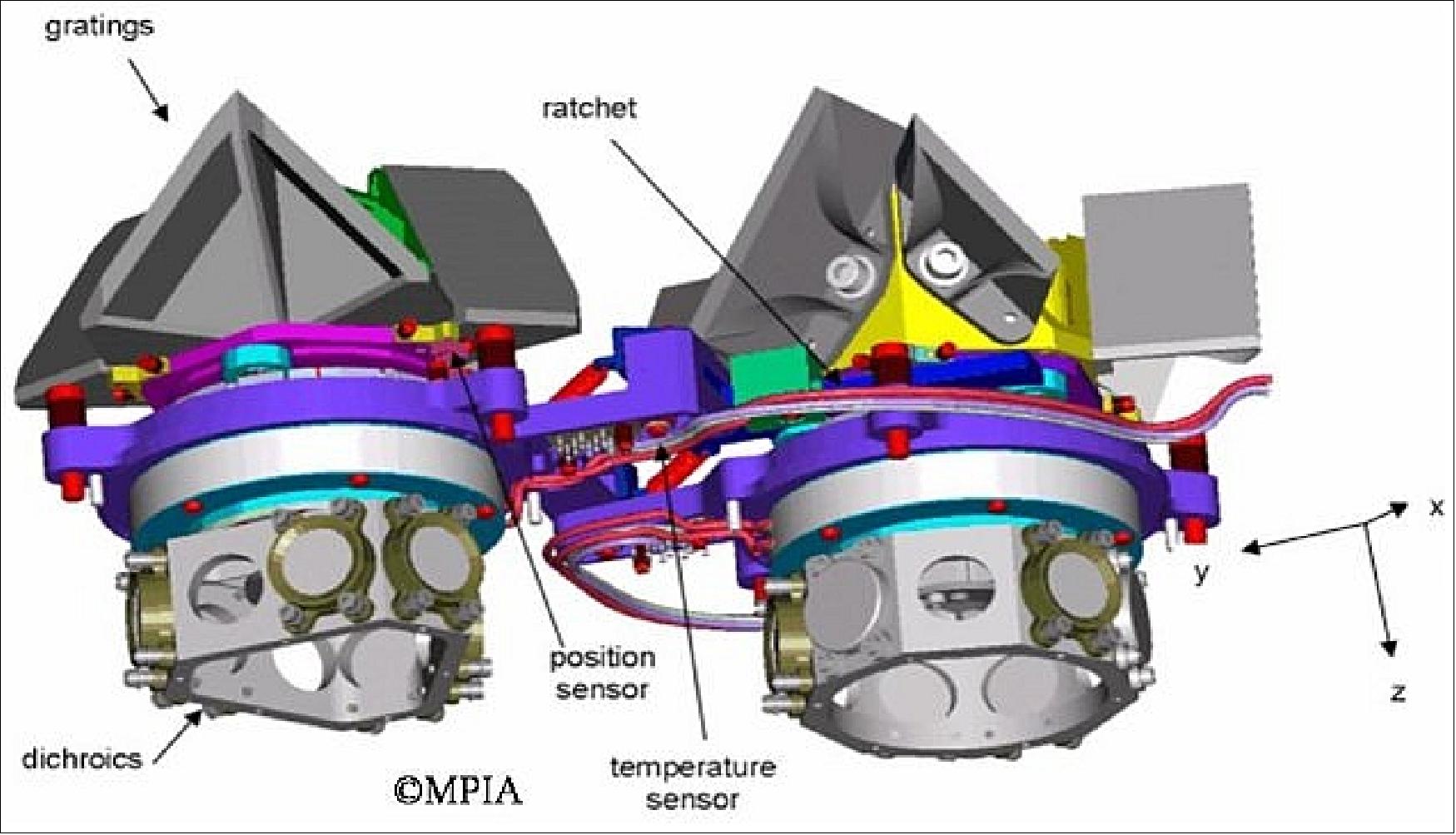
The filter wheel has 18 positions: 10 imaging filters, 4 coronagraphic diaphragms/filters, 1 neutral density filter, 1 double prism, 1 lens and 1 clear/blind position (counterweight of prism). The system has to operate in the cryo-vacuum of 7 K up to 10 years. The design is of ISOPHOT wheel mechanisms heritage flown on ESA's ISO (Infrared Space Observatory) mission. The filter wheel assembly houses a wheel disc carrying all the optical elements. Rotation is realized by a central two-phase torque motor (allows for bi-directional movement).
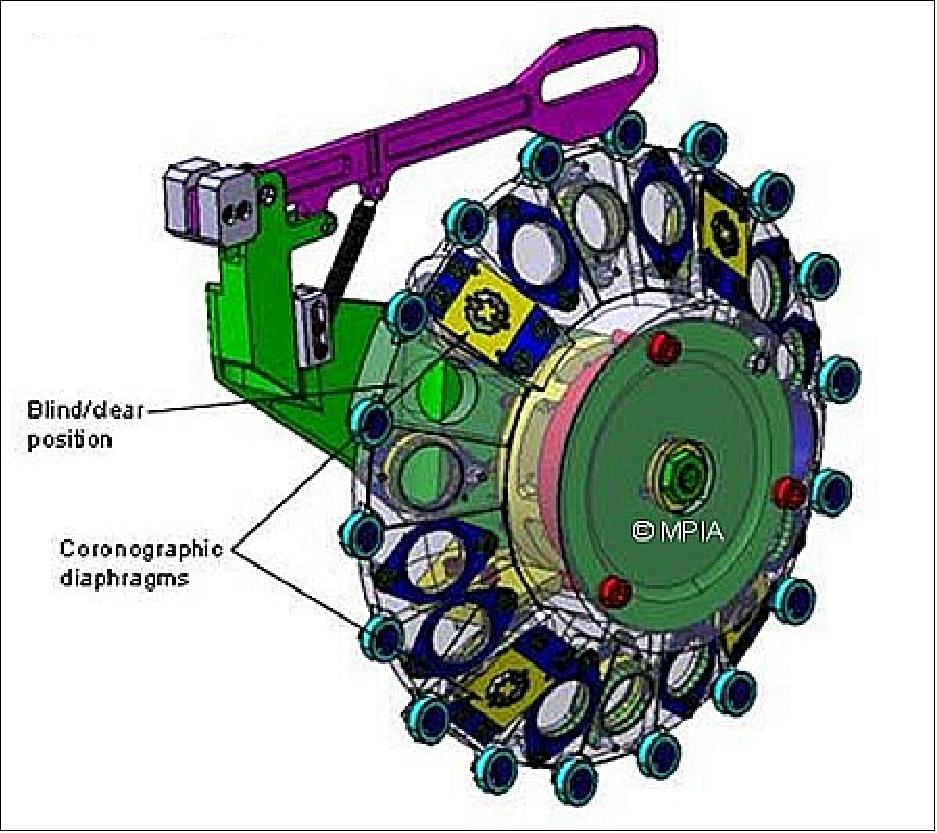
The FPS (Focal Plane System) consists of three FPM (Focal Plane Module) units (two in the spectrometer and one in the imager), a single FPE (Focal Plane Electronics) unit, and a set of low noise FPE/FPM cryogenic harnesses that connect the FPMs to the FPE. Each FPM houses a single SCA (Sensor Chip Assembly) containing a 1024 x 1024 Si:As IBC detector array and readout electronics. The IBC (Impurity Band Conduction) technology of Raytheon Vision Systems has been selected for very sensitive, cryogenically cooled infrared detectors. These arrays are manufactured as a hybrid structure, referred to as SCA (Sensor Chip Assembly), consisting of a detector array connected with indium bumps to a ROIC (Readout Integrated Circuit). The Si:As IBC detector material offers the highest performance for longwave detection in low-background systems. 130) 131)
Wavelength band (µm) | Support mode | Sensitivity (10σ, 10,000 s) |
5.6 | Imaging | 0.19 mJy |
12.8 | Imaging | 1.4 mJy |
25.5 | Imaging | 29 Jy |
6.4 | Line spectroscopy | 1.2 x 10-20 W m-2 |
22.5 | Line spectroscopy | 5.6 x 10-20 W m-2 |
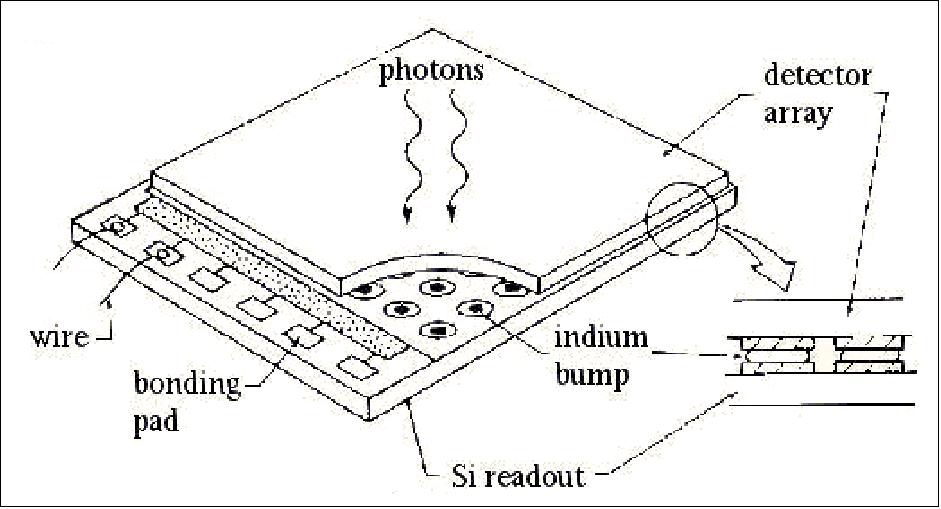
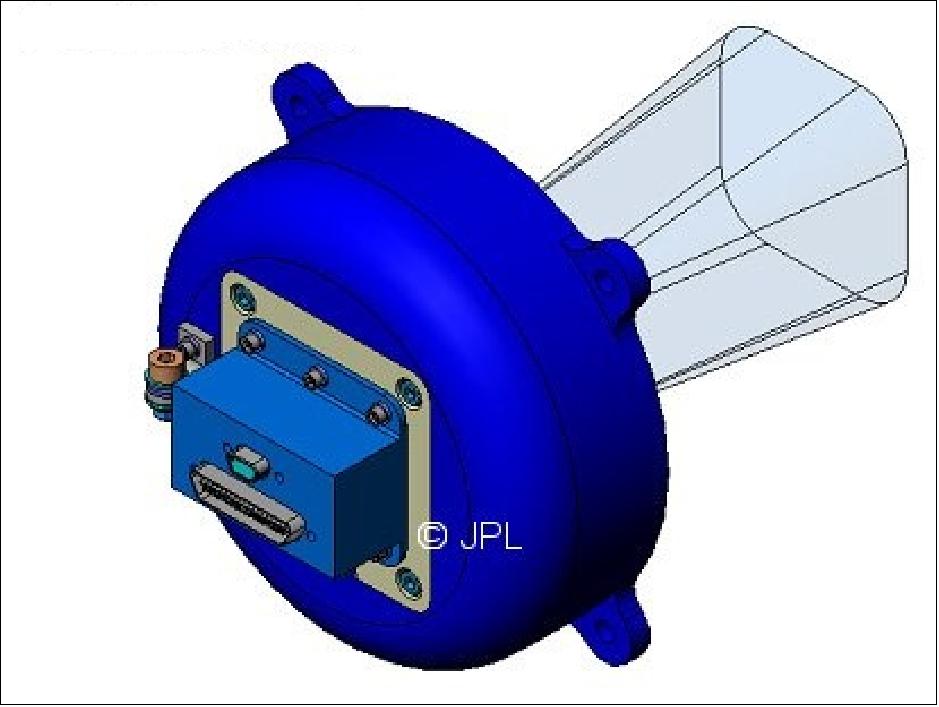
MIRI cryocooler: The MIRI instrument (optical bench, all focal planes) is cooled to ~7 K by a super-frigid mechanical helium cryocooler system of NASA/JPL built by NGAS (Northrop Grumman Aerospace Systems), Redondo Beach, CA. The cryocooling is achieved by means of a cryostat. Two hydrogen vessels are being used, the larger one for the optical bench, and the smaller one for the detectors. The vessels are designed to hold 1000 liter of solid hydrogen at 7 K.
Active cooling is provided by a dedicated three stage Stirling-cycle PT (Pulse-Tube) to precool a circulating helium flow loop, with a Joule-Thomson (JT) expansion stage to provide continuous cooling to 6.2 K to a single point on the MIRI optical bench. Significant development of the cryocooler occurred as part of the ACTDP (Advanced Cryocooler Technology Development Program) prior to selection as the flight cryocooler for MIRI. 132) 133) 134)
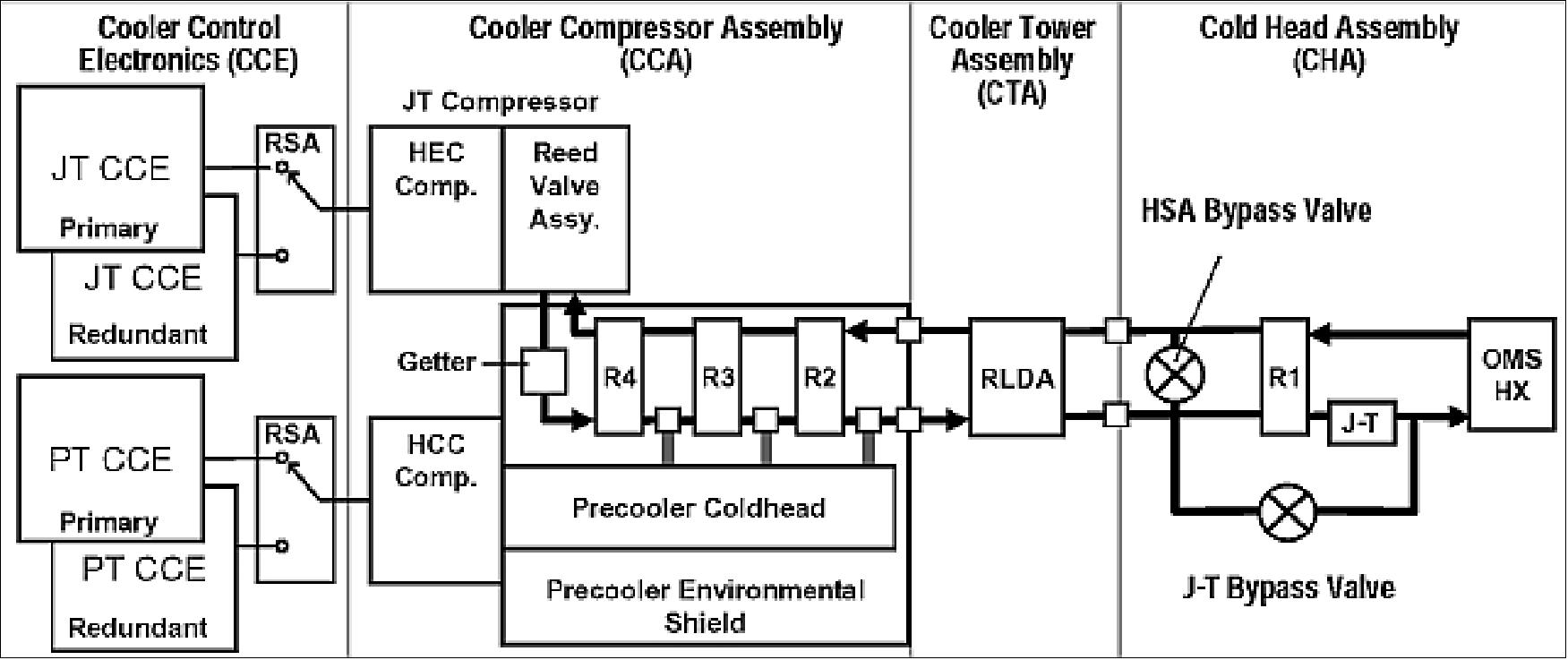
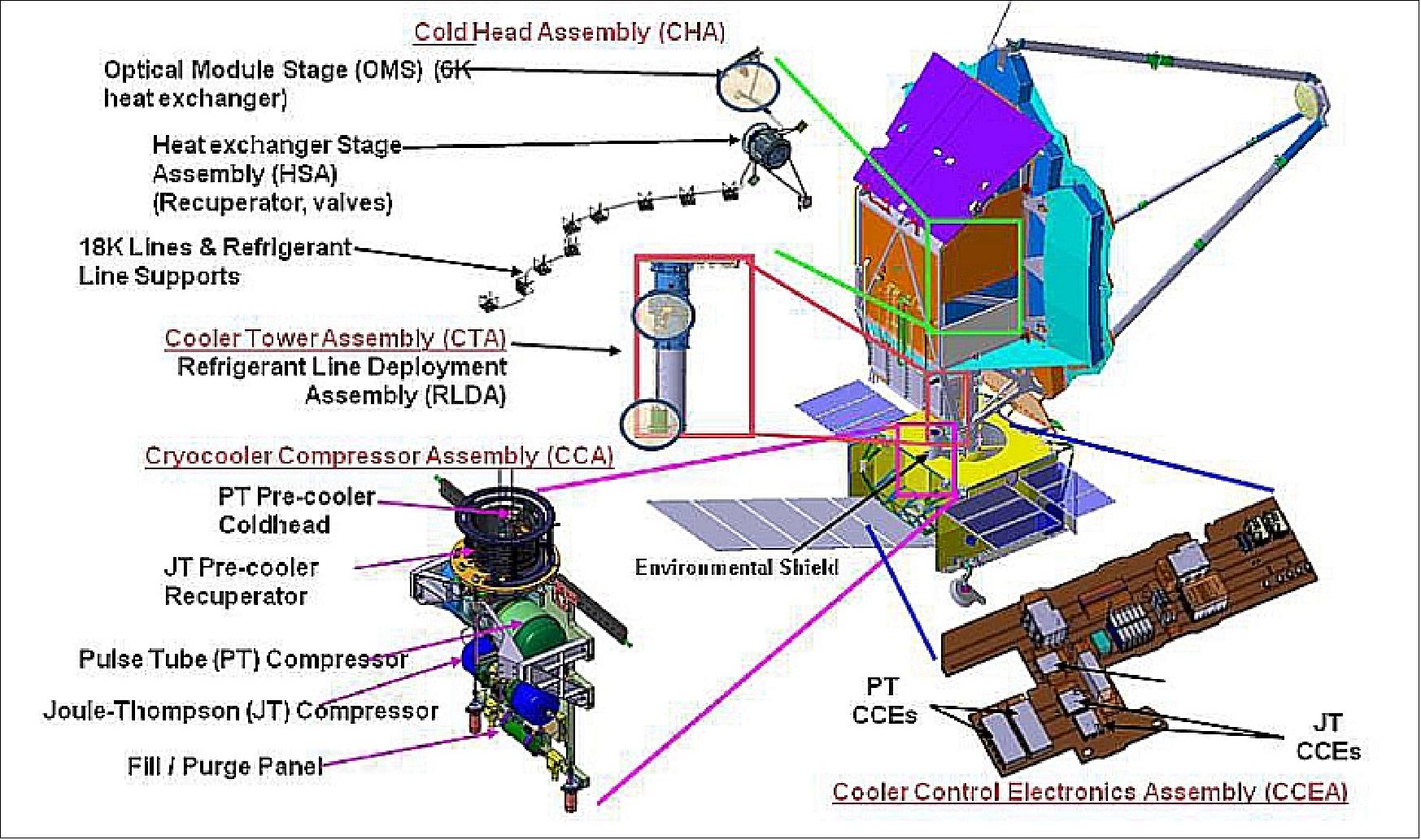
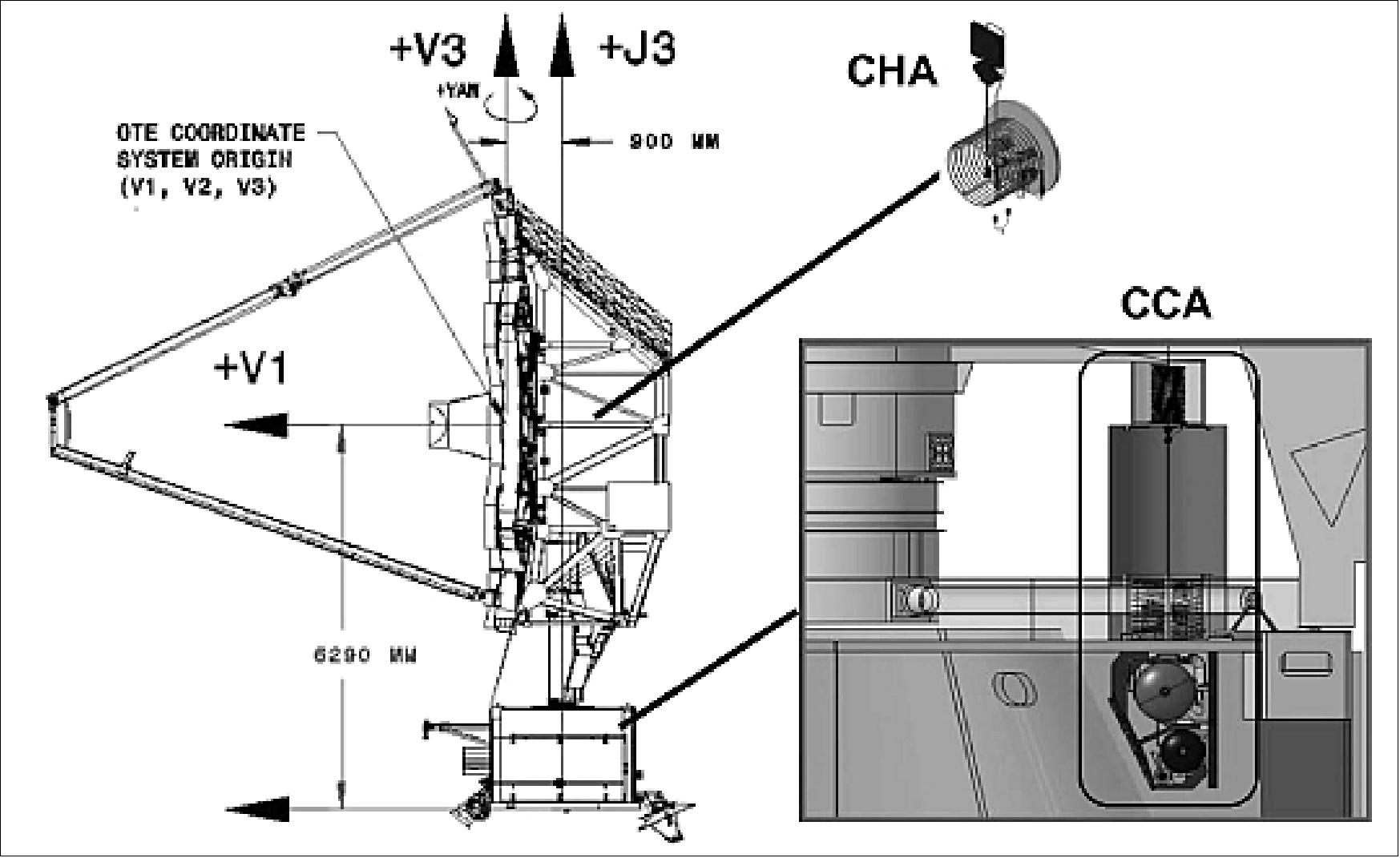
Legend to Figure 87: The drawing on the left side shows the spacecraft bus (bottom) and the OTE. The CCA (Cooler Compressor Assembly) and the CHA (Cold Head Assembly) are shown as expanded CAD renderings on the right hand side. The CCA is shown in context of the spacecraft bus and tower structures in the immediate vicinity. The CCE (Cryocooler Control Electronics) and the CTA (Cooler Tower Assembly) are not shown.
Status of MIRI
• Feb. 2014: MIRI has performed beautifully during its first cryo-vacuum test campaign carried out at NASA's Goddard Space Flight Center towards the end of 2013. An examination of data recorded during those tests confirms that the instrument is in good health and performing well. 135)
• July 2013: The ISIM, with the two instruments (MIRI and FGS/NIRISS), is now being prepared for the first series of cryogenic tests, planned for later this summer. These will include optical, electrical and electromagnetic interference tests, all under cold vacuum conditions. The tests will be conducted in the SES (Space Environment Simulator) vacuum chamber at GSFC. 136)
• On April 29, 2013, MIRI was the second instrument to be installed into the ISIM (after FGS/NIRISS).
• MIRI arrived at GSFC on 28 May 2012, having been despatched from the Rutherford Appleton Laboratory in the United Kingdom, where it had been assembled. Engineers from ESA, the MIRI European Consortium and NASA were on hand to take delivery of this, the first of JWST's four instruments to arrive at GSFC.
FGS (Fine Guidance Sensor)
The FGS is a sensitive camera that provides dedicated, mission-critical support for the observatory's ACS (Attitude Control System). The camera can image two adjacent fields of view, each approximately 2.4 arcmin x 2.4 arcmin in size, and can also be configured to read out small subarrays (8 x 8 pixels) at a rate of 16 times/s. Even with these short integration times, the FGS is sensitive enough to reach 58 µJy at 1.25 µm (~Jab = 19.5). This combination of sky coverage and sensitivity ensures that an appropriate guide star can be found with 95% probability at any point in the sky, including high galactic latitudes.
The objectives of FGS are to provide constant directional data for the telescope, enabling it to maintain stability for improved image acquisition. Specific requirements are: 137) 138)
1) To obtain images for target acquisition. Full-frame images are used to identify star fields by correlating the observed brightness and position of sources with the properties of cataloged objects selected by the observation planning software.
2) To acquire preselected guide stars. During acquisition, a guide star is first centered in an 8 x 8 pixel window. Small angle maneuvers are then executed to translate this window to a pre-specified location within the FOV, so that an observation with one of the science instruments will be oriented correctly.
3) To provide the ACS with centroid measurements of the guide stars at an update rate of 16 Hz. These measurements will be used to enable stable pointing at the milli-arcsecond level.
Note: In the course of building and testing of the TFI (Tunable Filter Imager) flight model, numerous technical issues arose with unforeseeable length of required mitigation effort. In addition to that, emerging new science priorities caused that in summer of 2011 a decision was taken to replace TFI with a new instrument, called NIRISS (Near Infrared Imager and Slitless Spectrograph). 139) 140)
FGS/NIRISS (Near-Infrared Imager and Slitless Spectrograph)
FGS is one of the four science instruments on board the JWST, a contribution of CSA (Canadian Space Agency). The FGS-NIRISS science team is jointly led by John Hutchings of NRC (National Research Council) of Canada, Victoria, British Columbia, Canada and René Doyon, University of Montréal. - The FGS consists of two Guider channels and one Near-Infrared Slitless Spectrometer (NIRISS) channel. COM DEV Space Systems of Ottawa Canada is CSA's prime contractor for the FGS instrument. The NIRISS channel makes use of grisms and filters optimized for first-light science and exo-planet observations. This is a recent change in the configuration of the instrument which until the summer of 2011 made use of a tunable filter. The block diagram of the updated instrument configuration is shown in Figure 88. 141) 142)
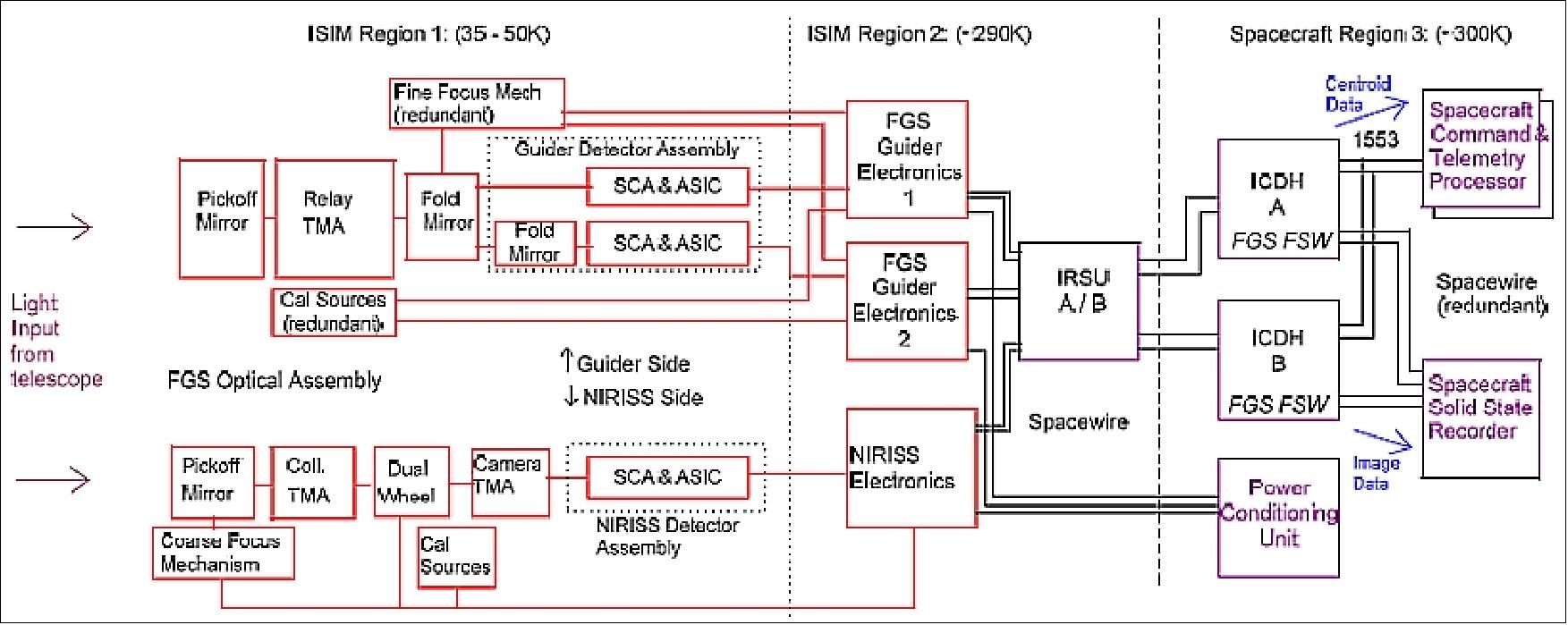
The FGS prime function is to work with the ACS (Attitude Control Subsystem) of the Observatory to provide fine guiding. The guiding side of FGS (FGS-Guider) is a near-infrared (IR) camera operating in broadband light over the full 0.6-5 µm bandpass of its two Hawaii-2RG detectors. The FGS-Guider features an all reflective optical design with two redundant 2.3 arcmin x 2.3 arcmin FOV each capable of reading a small (8 x 8) subarray window to select any star in the FOV and to report its centroid every 64 ms (16 Hz) to the ACS, which in turn sends an error signal to the fine steering mirror of the telescope. At this sampling rate, the FGS-Guider is required to have a NEA (Noise Equivalent Angle) less than 4 marcsec (one axis) on a star with an integrated signal of 800 electrons, equivalent to approximately a JAB = 19:5 star. This limiting magnitude guarantees more than 95% of the sky coverage with at least three stars within the FGS-Guider FOV. 143) 144)
FGS features two modules: an infrared camera dedicated to fine guiding of the observatory and a science camera module, the NIRISS (Near-Infrared Imager and Slitless Spectrograph) covering the wavelength range between 0.7 and 5.0 µm with a FOV of 2.2 arcmin x2.2 arcmin.
A schematic optical layout of NIRISS is shown in Figure 89. The optical design is an all reflective design with gold-coated diamond-turned aluminum mirrors. The average WFE ( Wavefront Error) over the FOV of the instrument (telescope excluded) is less than 79 nm RMS.
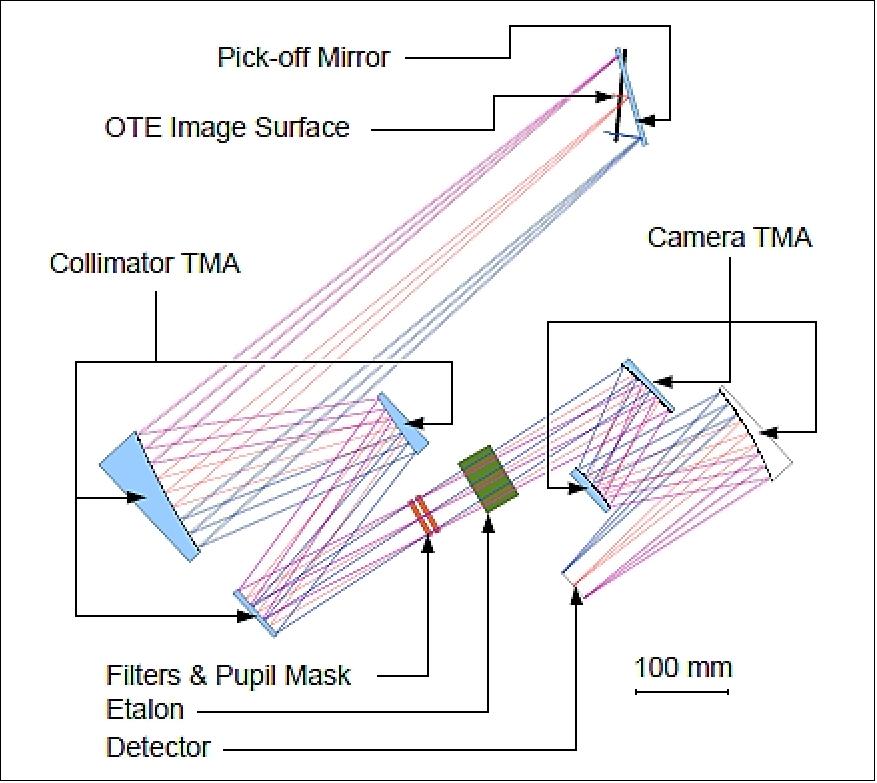
NIRISS has a dual pupil and filter wheel assembly. Collimated light first passes through a selected position in the pupil wheel and then through the selected position in the filter wheel. Figure 90 shows the elements of the pupil and filter wheels. The PAR (Pupil Alignment Reference) shown in Figure 1 is used during ground testing to verify the positioning of NIRISS in the ISIM (Integrated Science Instrument Module). Its presence decreases the throughput of the "CLEARP" element by about 10%. 145)
The Dual Wheel is comprised of pupil and filter wheels, bearings, gears, static hub, rear motor/resolver plate and the support bracket. The equipment includes drive motors, resolvers and variable reluctance sensors. Each wheel (~280 mm diameter) is capable of rotating the optical elements to one of 9 desired positions, supported by a preloaded duplex pair of angular contact bearings. All moving parts use MoS2 dry lubricants compatible with the cryogenic environment. A stepper motor with a single-stage planetary gearhead is used to drive each wheel independently, through a reduction gear train. The optical parts are held in place by a metallic spring gasket with a precision holder machined from Ti 6Al-4V ELI annealed, stress-relieved prior to final machining and cryo-cycled prior to installing optical elements. A black tiodize coating is used for stray light control. 146) 147)
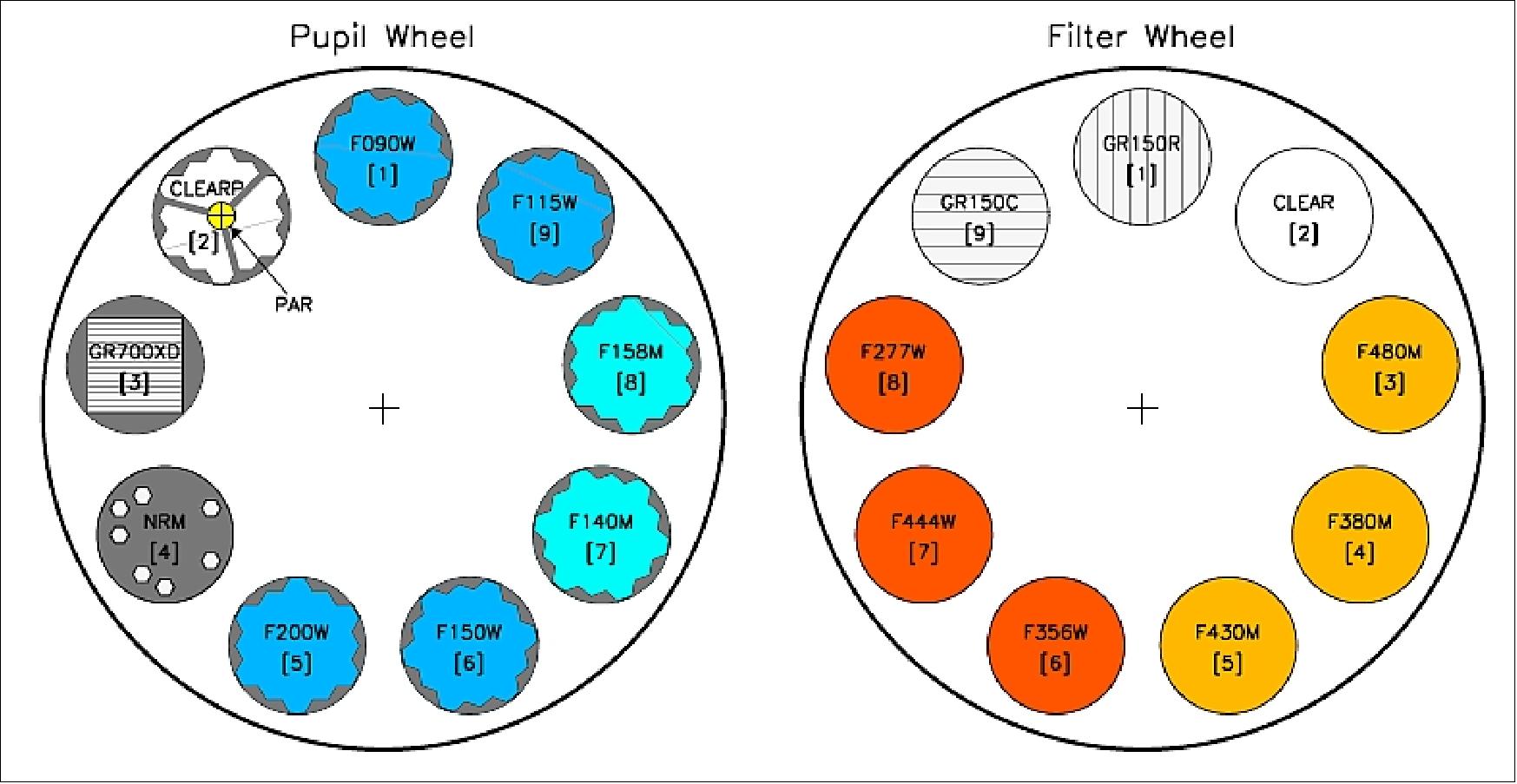
Detector: The NIRISS detector consists of a single SCA (Sensor Chip Assembly) with the following characteristics:
- 2048 x 2048 pixel HgCdTe array. Each pixel is 18 microns on a side.
- Dark rate: < 0.02 e-/s
- Noise: 23 e- (correlated double sample)
- Gain: 1.5 e-/ADU
- 2.2 arcmin x 2.2 arcmin FOV
- Plate scale in x: 0.0654 arcsec/pixel; plate scale in y: 0.0658 arcsec/pixel
• The 2048 x 2048 pixels of the SCA are divided into 2040 x 2040 photosensitive pixels and a 4-pixel wide border of non-photosensitive reference pixels around the outside perimeter. The reference pixels do not respond to light, but are sampled and digitized in exactly the same way as the light sensitive pixels. The reference pixels can be used to monitor and remove various low-frequency bias drifts.
• The composition of the detector is tuned to provide a long-wavelength cutoff at approximately 5.3 microns.
• The SCA is fabricated and packaged into a FPA (Focal Plane Assembly ) that includes a HAWAII-2RG readout integrated circuit (ROIC), which is controlled by a SIDECAR ASIC (Application Specific Integrated Circuit). The ASIC is a custom-built chip that clocks the array, sets the bias voltages, and performs the analog-to-digital conversion of the pixel voltages.
• The SCA is fabricated and packaged into a focal-plane assembly (FPA) that includes a HAWAII-2RG readout integrated circuit (ROIC), which is controlled by a SIDECAR Application Specific Integrated Circuit (ASIC). The ASIC is a custom-built chip that clocks the array, sets the bias voltages, and performs the analog-to-digital conversion of the pixel voltages.
• A full-frame read of the SCA is digitized through four readout amplifiers. Each amplifier reads a strip that is 512 x 2048 pixels. 148)
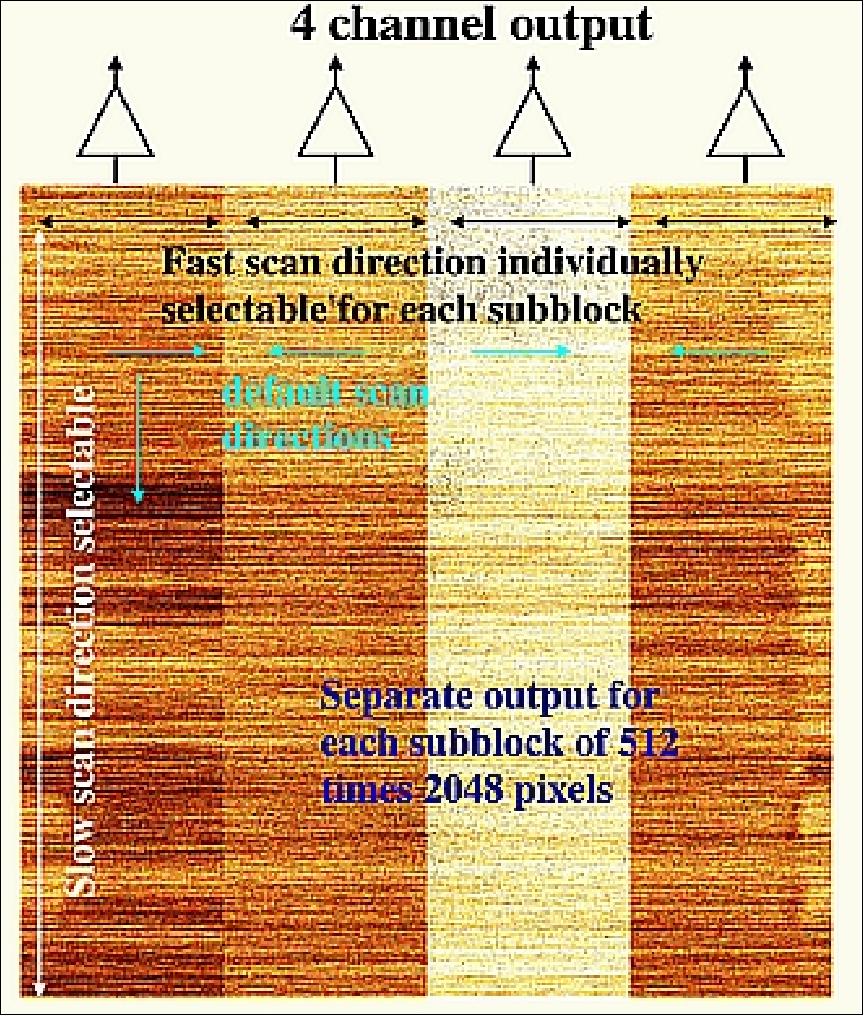
Observation modes: NIRISS has four observing modes (Ref. 143):
1) BBI (Broadband Imaging) featuring seven of the eight NIRCam broadband filters
2) Low resolution WFSS (Wide-Field Slitless Spectroscopy) at a resolving power of ~150 between 1 and 2.5 µm
3) Medium-resolution SOSS (Single-Object Spectroscopy). The single-object cross-dispersed slitless spectroscopy enabling simultaneous wavelength coverage between 0.7 and 2.5 µm at R~660, a mode optimized for transit spectroscopy of relatively bright (J > 7) stars
4) sparse AMI (Aperture Interferometric Imaging) between 3.8 and 4.8 µm enabling high-contrast (~ 10-4) imaging of M < 8 point sources at angular separations between 70 and 500 marcsec.
Broadband imaging: NIRISS offers the same broadband imaging capability as NIRCam except that NIRISS does not carry the NIRCam F070W filter. The new blocking filters procured for NIRISS, used in combination with NIRCam short wavelength fitters, have measured inband transmission of 95% typically. As shown in Figure 92, NIRISS and NIRCam are predicted to have similar sensitivities within 10%. This sensitivity calculation takes into account the coarser pixel sampling (65 marcsec) of NIRISS at short wavelengths compared to NIRCam (32 marcsec). NIRISS is not expected to be used for broadband imaging unless parallel observing is eventually offered by the Observatory. If so, NIRISS could be easily used in parallel with NIRCam for a wide variety of programs including deep extragalactic surveys aiming at probing the galaxy population of the early universe.
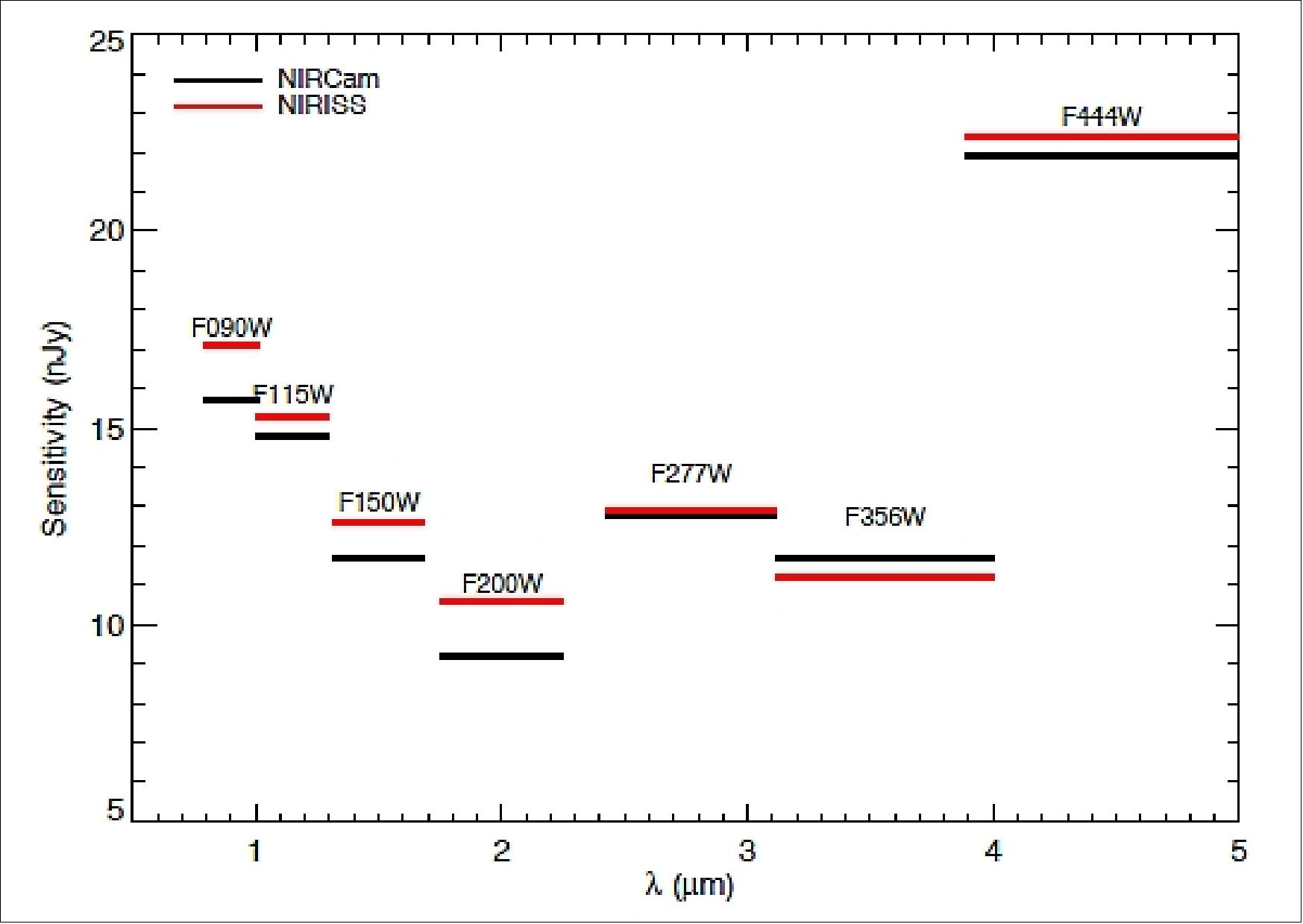
WFSS (Wide-Field Slitless Spectroscopy): The WFSS mode of NIRISS operation is optimized for Ly α emitters (1-2.5 µm) and makes use of a pair of grisms GR150V and GR150H. In order to break wavelength-position degeneracy two prisms are at 90º angle to each other and are used in two separate imaging sessions. In this scheme, the intersection of the two perpendicular dispersion lines indicates undeviated wavelength and true sky position of the source.
It is implemented through the two GR150R & GR150C grisms operated in slitless mode at R = 150 (2 pixels), enabling low-resolution multi-object spectroscopy between 1 and 2.5 µm in first order. The grisms are resin-replicated on a low refractive index material (Infrasil 301) to minimize Fresnel loss. They were manufactured by Bach Research. The peak efficiency of a flight-like GR150 grism, i.e. manufactured with the same replication process (same substrate prism, same master), was measured to be ~80% (see Figure 93). Wavefront error measured at 90 K on both grism surfaces showed some distortion due to stress induced by CTE (Coefficient of Thermal Expansion) mismatch between the resin and the glass substrate. However, within uncertainties, the distortion was measured to be identical on both sides at 90 K. This distortion effectively turns the grism into a weak meniscus lens which, to first order, has no defocus. Cryogenic (90 K) monochromatic PSF measurements were also secured to estimate the TWFE (Transmitted Wavefront Error) of the GR150 grisms; the results indicate that they should have less than 30 nm (RMS) of TWFE. The image quality in the WFSS mode is therefore expected to be as good as in broadband imaging i.e. with a typical Strehl ratio of ~0.5 at 1.3 µm.
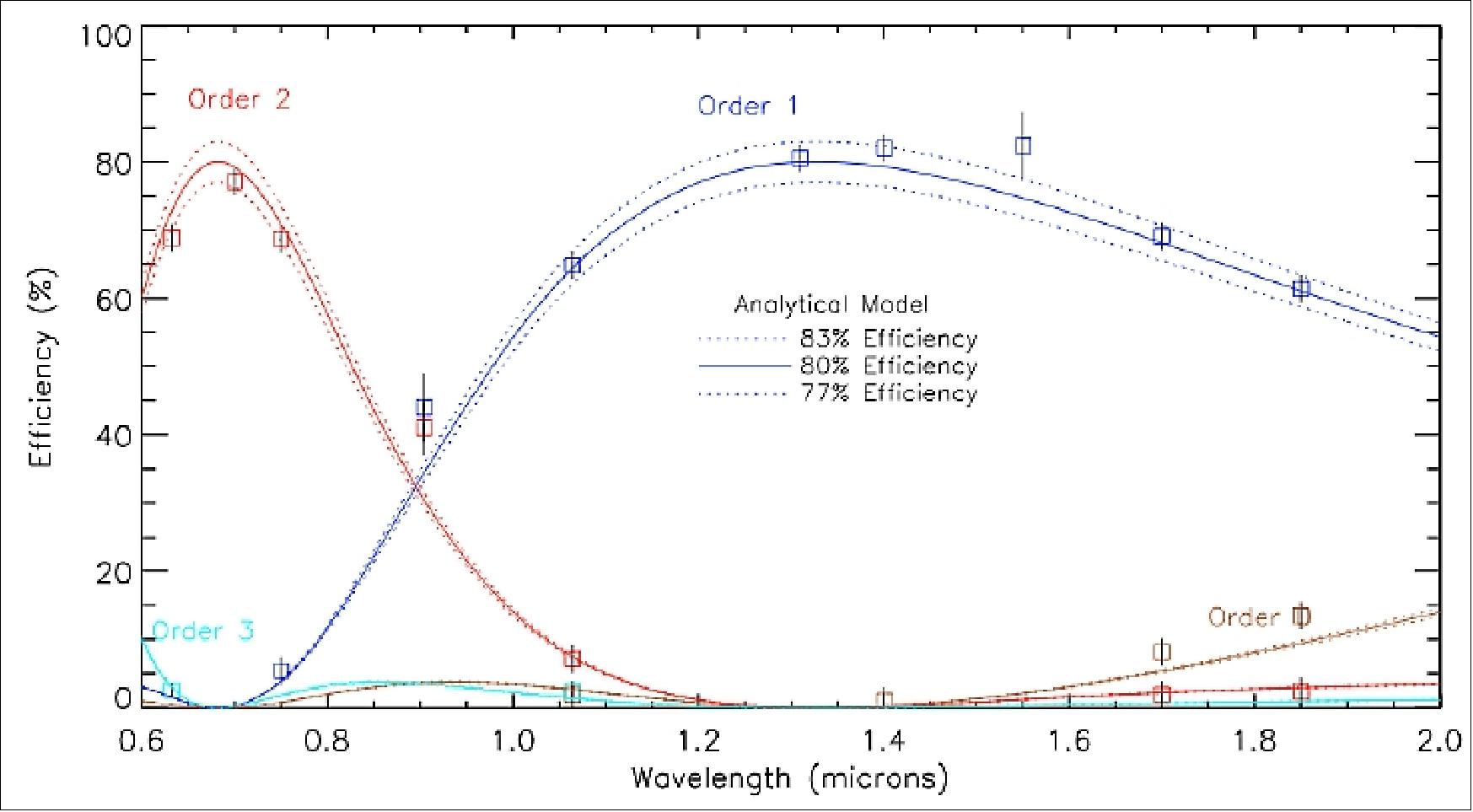
SOSS (Single-Object Slitless Spectroscopy): This mode of NIRISS operation is optimized for relatively bright stars (e.g. exoplanet transiting systems) in 0.6-2.5 µm spectral range in the first order of dispersion. It is based on a GR700XD grism made of the directly ruled ZnSe. A ZnSe cross-dispersion prism is placed in front of the grism for an optimal separation of the first and second order spectra.
To optimize this mode for very high signal-to-noise ratio observations of bright objects, the entrance face of the ZnSe prism has a built-in cylindrical weak lens that defocusses the spectrum over ~25 pixels along the spatial direction, keeping the point spread function nearly diffraction-limited in the spectral direction. As a result, the spectrum is undersampled at most wavelengths along the spectral direction which, given the non-uniform detector pixel response in the presence of pointing jitter noise, constitutes a potential source of systematic effect for achieving high-precision differential spectrophotometry. To mitigate/minimize this problem, the GR700XD grism is slightly rotated by ~ 2º with respect to the detector. Given that the PSF (Point Spread Function) is spread over 25 pixels in the spatial direction, this rotation effectively provides Nyquist sampling at all wavelengths. Furthermore, since the GR700XD grism is operated in slitless mode, there are no flux variations induced by a slit. All these features, designed for achieving high-precision differential spectrophotometry, combined with the very stable thermal environment expected at L2, will make the NIRISS SOSS mode a powerful capability for atmospheric characterization of transiting exoplanets.
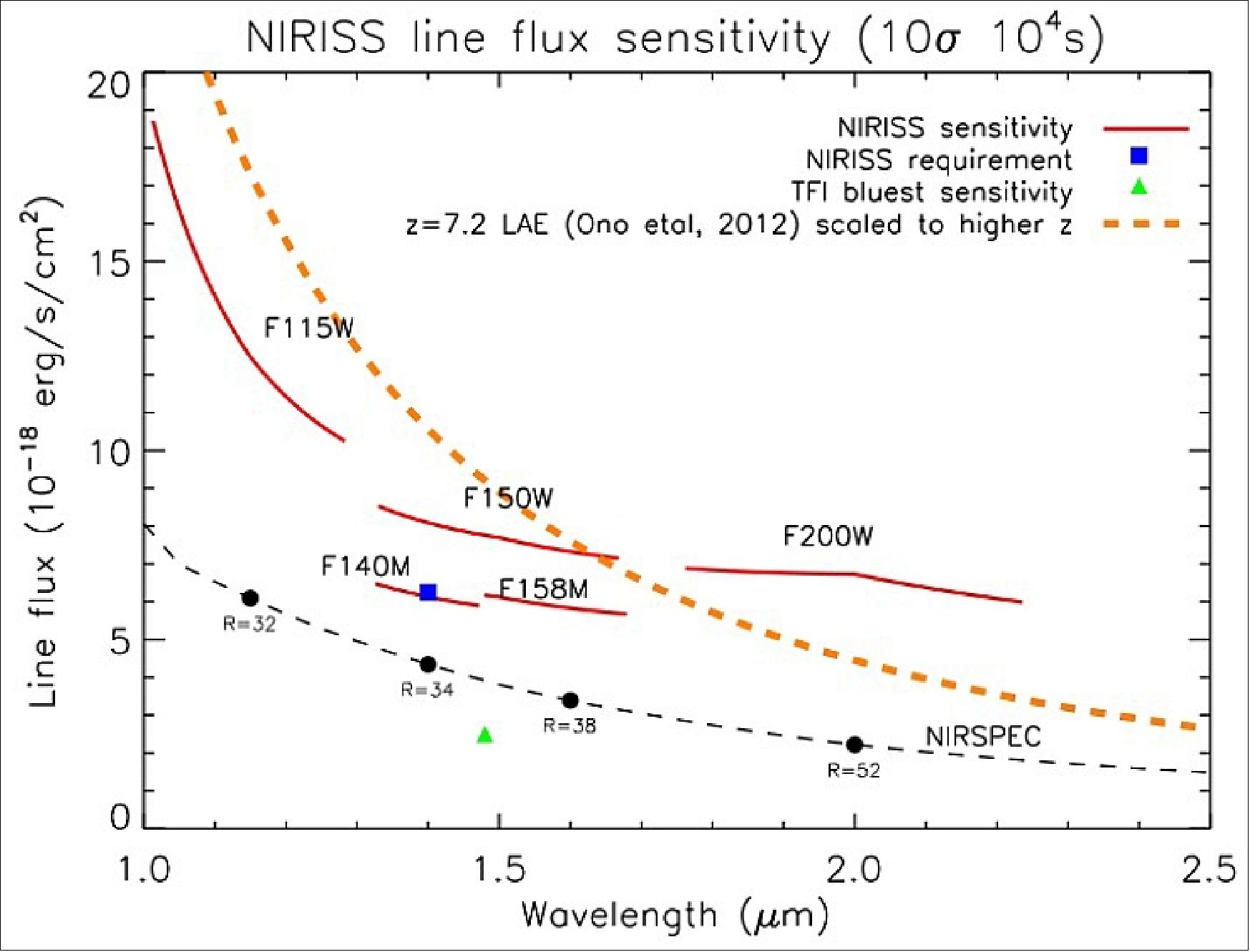
Legend to Figure 94: The dashed line is the predicted NIRSpec sensitivity for the multi-slit low-resolution (R ~100) mode; the solid circles superimposed on the dashed line is the spectral resolution of NIRSpec at that wavelength. The green triangle is the sensitivity that TFI would have had at its shortest wavelength (1.45 µm; zLyα = 10:9); TFI would have been typically a factor ~3 more sensitive than NIRISS at the expense of sampling a very narrow redshift range at a given wavelength and limited to probe zLyα > 10:9.
AMI (Aperture Masking Interferometry): The NIRISS PW includes a seven-aperture non-redundant mask (NRM; Figure 95) used for aperture masking interferometry (AMI). The AMI technique enables high-contrast imaging at inner working angle theoretically as small as 1 λ/2D. This mode is particularly appealing for faint companion detection (brown dwarfs & exoplanets) around relatively bright stars. AMI has been successfully used on the ground for a variety of applications, for example to unveil the spiral structure of the stellar wind of the Wolf-Rayet star WR98A (Monnier et al. 1999), detect brown dwarfs (Lloyd et al., 2006) and to put mass limits on the presence of brown dwarfs and exoplanets within the inner 10 AU of the multi-planetary system HR8799.
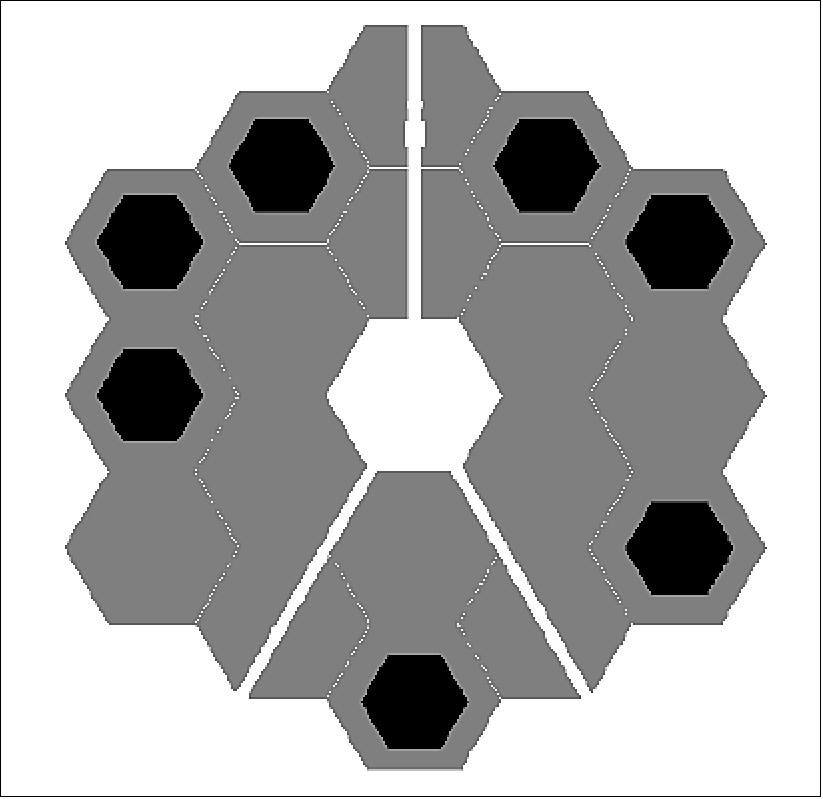
The main scientific application of AMI with NIRISS is for high-contrast imaging of point sources but it can also be used for aperture synthesis applications like probing the inner structure of nearby active galactic nuclei. For the former, simulations suggest that contrast of ~ 2 x 10-4 within one λ/D at 4.3 µm should be achieved on a M = 8 star in 104 seconds. This level of contrast is sufficient to detect 5-10 MJup gas-giant exoplanets around bright nearby young (10-100 Myrs) stars. For comparison, contrast at the level of ~ 10-3 within one λ/D at L0 has been achieved on Keck. Since AMI is particularly sensitive to amplitude errors, a space-based environment is ideal for AMI. The NIRISS simulations take into account the instrumental effect of bad pixels, intra-pixel response and flat field errors and assume one calibrator/reference star; using more than one calibrator should improved the performance. As seen in Figure 12, AMI is probing a unique discovery space between 70 and 500 marcsec which is very complementary to NIRCam and MIRI, both virtually "blind" to companions at separations less than ~0.5 arcsec.
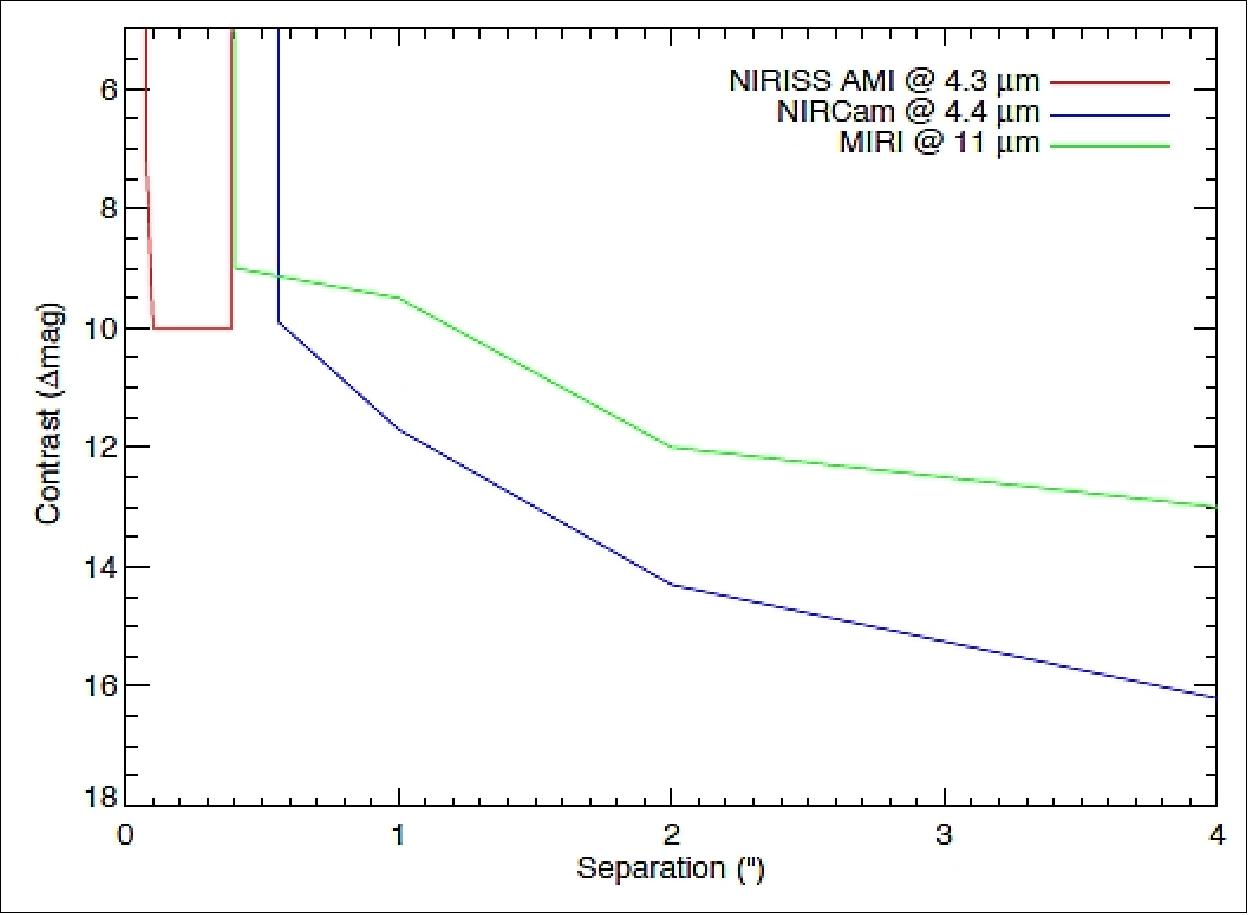
NIRISS mode | Filters | Grism | Mask |
BBI (Broadband Imaging) | F090W, F115M, F150W, F200W, F277W, F444W, F356W |
|
|
WSS (Wide-Field Slitless Spectroscopy) | F115W, F150W, F200W, F140M, F158M | GR150H or GR150V |
|
SOSS (Single Object Slitless Spectroscopy) | Open | GR700XD |
|
AMI (Aperture Interferometric Imaging) | F380M, F430M, F444W |
| NMR (Non Redundant Mask) |
Pupil Alignment (used only during on- ground testing) | Open |
| PAR (Pupil Alignment Reference) |
FGS/NIRISS Integration and Status
• August 27, 2015: Preparations for the third cryo-vacuum test (CV3) of the ISIM (Integrated Science Instrument Module) at NASA's Goddard Space Flight Center continued throughout the summer. For the first time, the flight configuration of the ISIM was vigorously shaken – not stirred! – and bombarded by intense acoustical waves to simulate the harsh conditions of launch. Both NIRISS and FGS sailed through their "system functional tests" before and after these perturbations with no issues. Additional tests to confirm the electromagnetic compatibility of the subsystems of ISIM under conditions that simulate normal operations were also completed successfully. Now that the robustness of the ISIM has been demonstrated, it's "full speed ahead" for the beginning of CV3 in late October! 149)
• Feb. 12, 2015: FGS/NIRISS became the first instrument to be reinstalled in the ISIM (Integrated Science Instrument Module) following the "Half-Time Show." All the planned hardware changes were successfully completed and both instruments passed their electronic check-outs at room temperature with flying colors. FGS/NIRISS is ready for the final series of tests at NASA's Goddard Space Flight Center! 150)
• Oct. 29, 2013: NIRISS completed its first suite of tests under cryogenic conditions in the large vacuum chamber at NASA's Goddard Space Flight Center. The tests featured "first light" observations for all the observing modes of NIRISS. Although a few glitches occurred, initial analysis of the test data show that NIRISS is performing marvelously.
• March 1, 2013: NIRISS and the FGS became the first flight instruments to be attached to the ISIM (Integrated Science Instrument Module), which is currently located in the large clean room at NASA/GSFC (Ref.138).
• Dec. 21, 2012: NIRISS and the FGS successfully completed room-temperature functional tests at NASA/GSFC.
• Nov. 15, 2012: NIRISS and the FGS became the first JWST instruments to be accepted formally by NASA during the Delivery Review Board meeting at the Goddard Space Flight Center.
• The Canadian Space Agency delivered NIRISS and the Fine Guidance Sensor to NASA's Goddard Space Flight Center on July 30, 2012.
• The end-to-end functional and performance cryogenic vacuum testing of NIRISS was successfully completed at the beginning of 2012. The new, compared to TFI, components of the Dual Wheel went through separate qualification process afterwards.
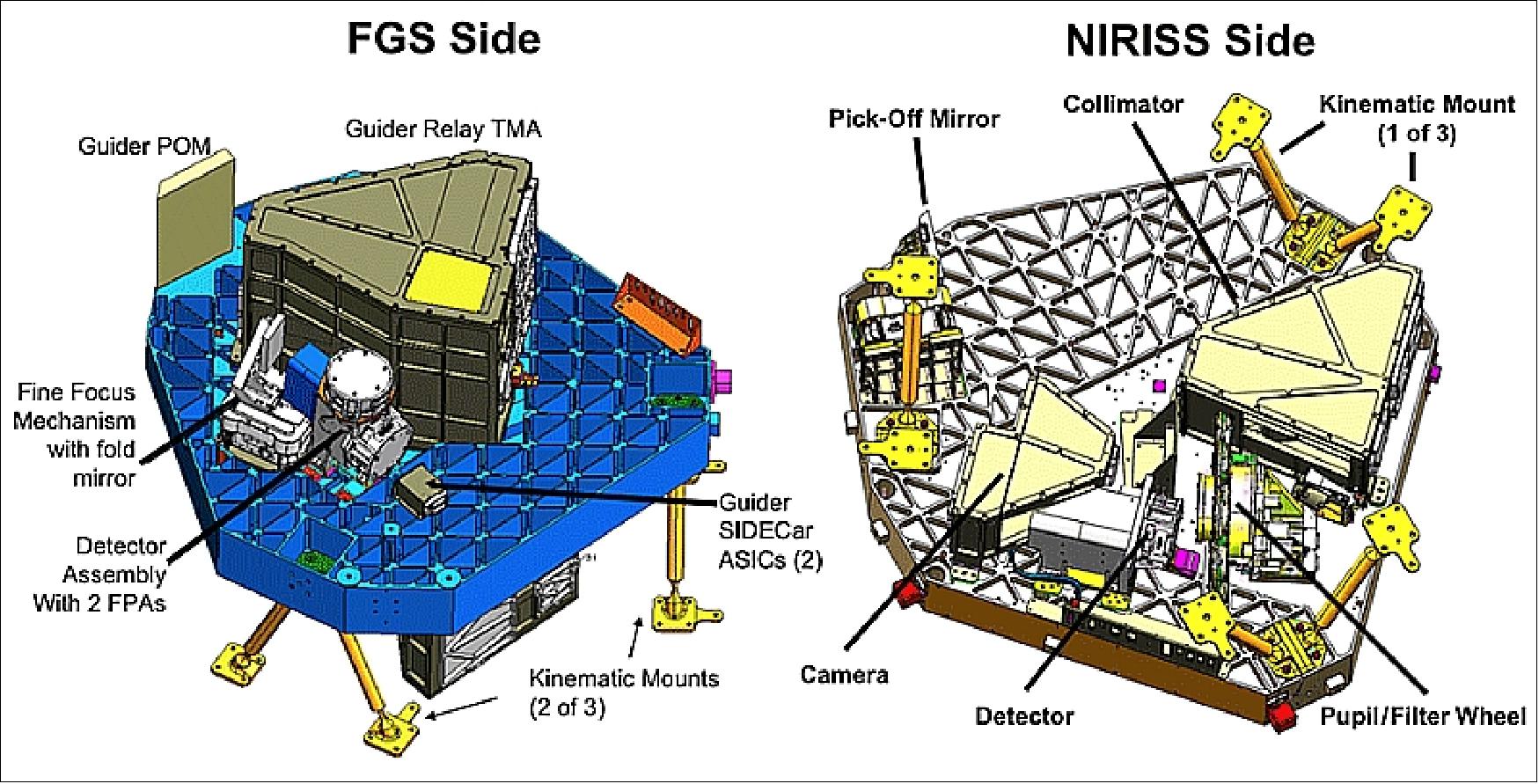
Legend to Figure 97: The left image shows the components of FGS. Light from the telescope is redirected by the POM (Pick-Off Mirror), and refocused by the TMA (Three-Mirror Assembly) onto the Fine Focus Mechanism before entering the detector assembly. The FGS has two detectors, called FPAs (Focal Plane Assemblies), which record the light . — The right image shows the components of NIRISS. Light from the telescope is redirected into NIRISS by its Pick-Off Mirror. The collimator makes the light rays parallel to each other so they pass correctly through various combinations of filters or light-splitting grisms in the Pupil and Filter Wheel. Finally, the light is focused by the camera onto the detector (Ref. 140).
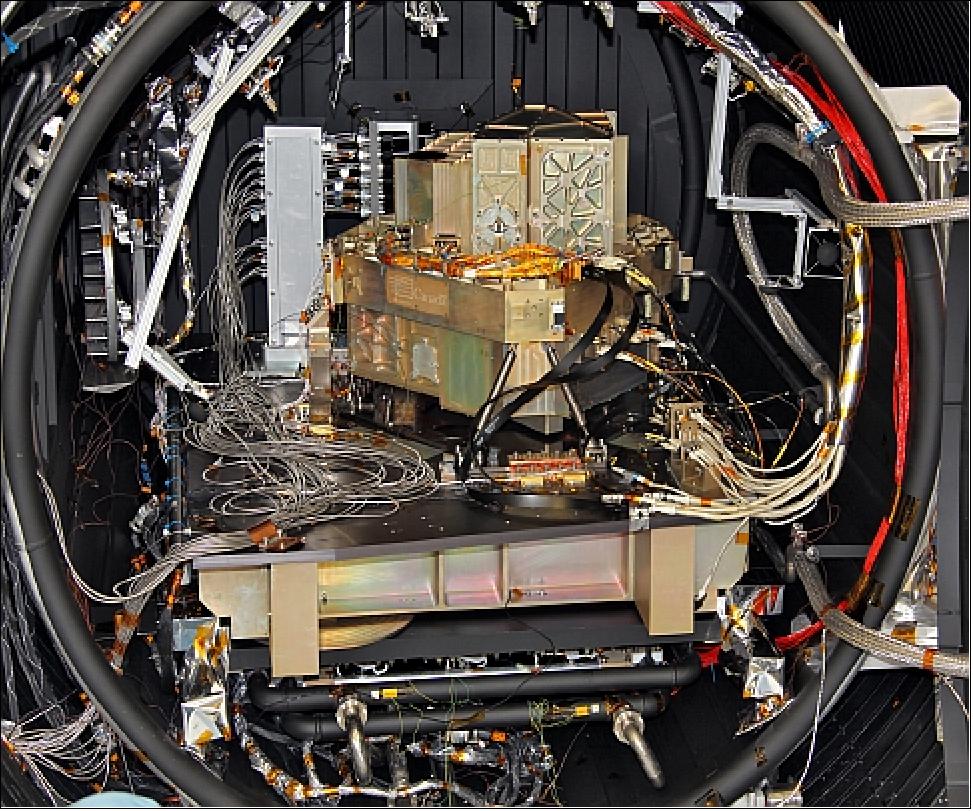
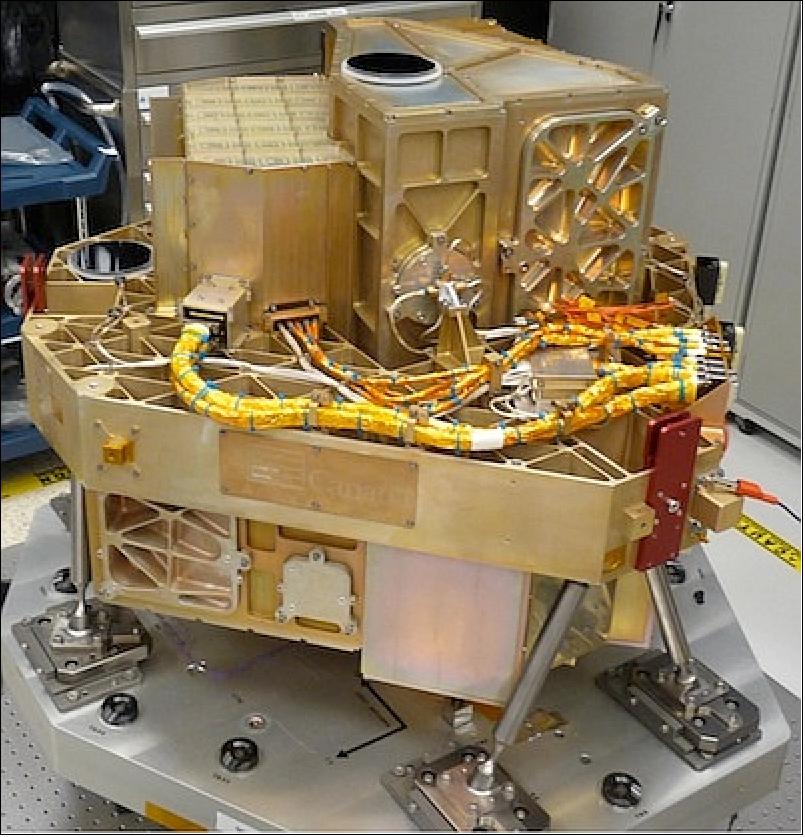
Spacecraft Bus and Sunshield
The JWST spacecraft bus provides the necessary support functions for the operation of the JWST observatory. The bus is the home for six major subsystems: 152)
• ACS (Attitude Control Subsystem)
• EPS (Electrical Power Subsystem)
• C&DHS (Command and Data Handling Subsystem)
• RF communications subsystem
• Propulsion subsystem
• TCS (Thermal Control Subsystem)
The spacecraft is 3-axis stabilized. Two star trackers (+ 1 for redundancy) point the observatory toward the science target prior to guide star acquisition, and they provide roll stability about the telescope line of sight (V1 axis.) Six reaction wheels (two are redundant) are mounted on isolators near the center of gravity of the bus to reduce disturbances to the observatory. These reaction wheels offload the fine steering control (operation from a 16 Hz update from the FGS) to maintain the fine steering mirror near its central position to limit differential distortion-induced blurring onto the target star. 153) 154)
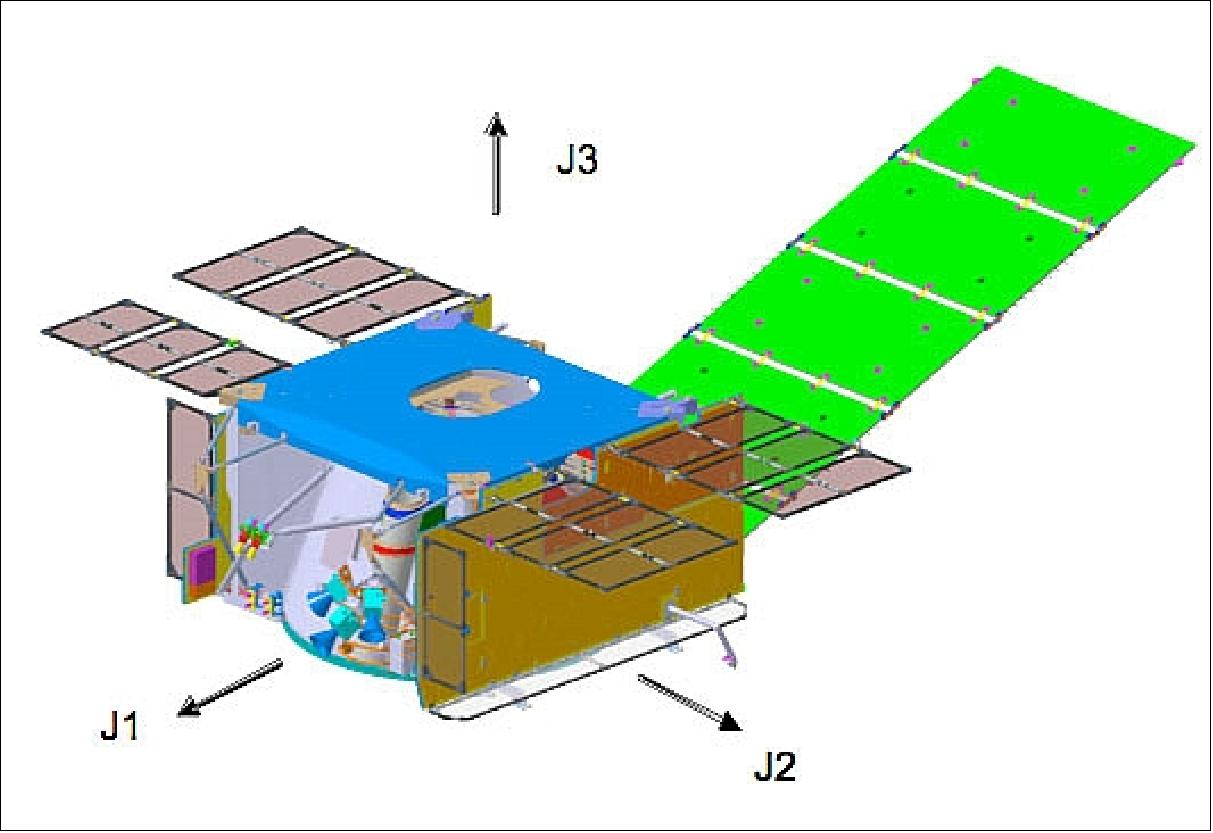
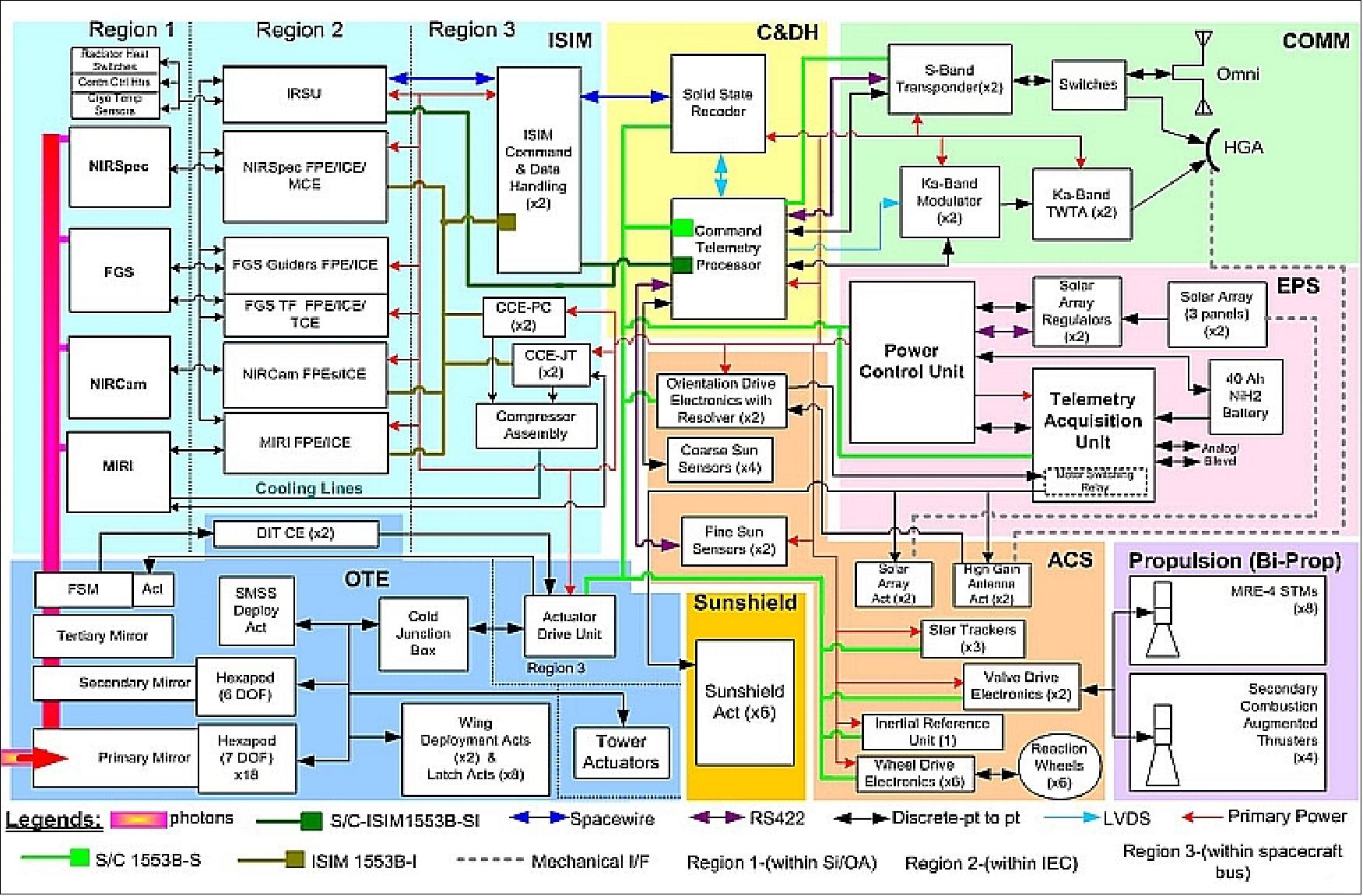
A propulsion subsystem, containing the fuel tanks and thrusters, is used to support trajectory maneuvers to L2 and to maintain the halo orbit at L2.
The avionics design of JWST employs the FPE (Focal Plane Electronics) onboard network which uses the SpaceWire specification and a transport layer (not part of SpaceWire). SpaceWire is used to provide point‐to‐point links to ISIM (Integrated Science Instrument Module). A MIL‐STD‐1553 data bus is being used to communicate with the ICEs (Instrument Control Electronics) of each instrument, and FGS (Fine Guidance Sensor).
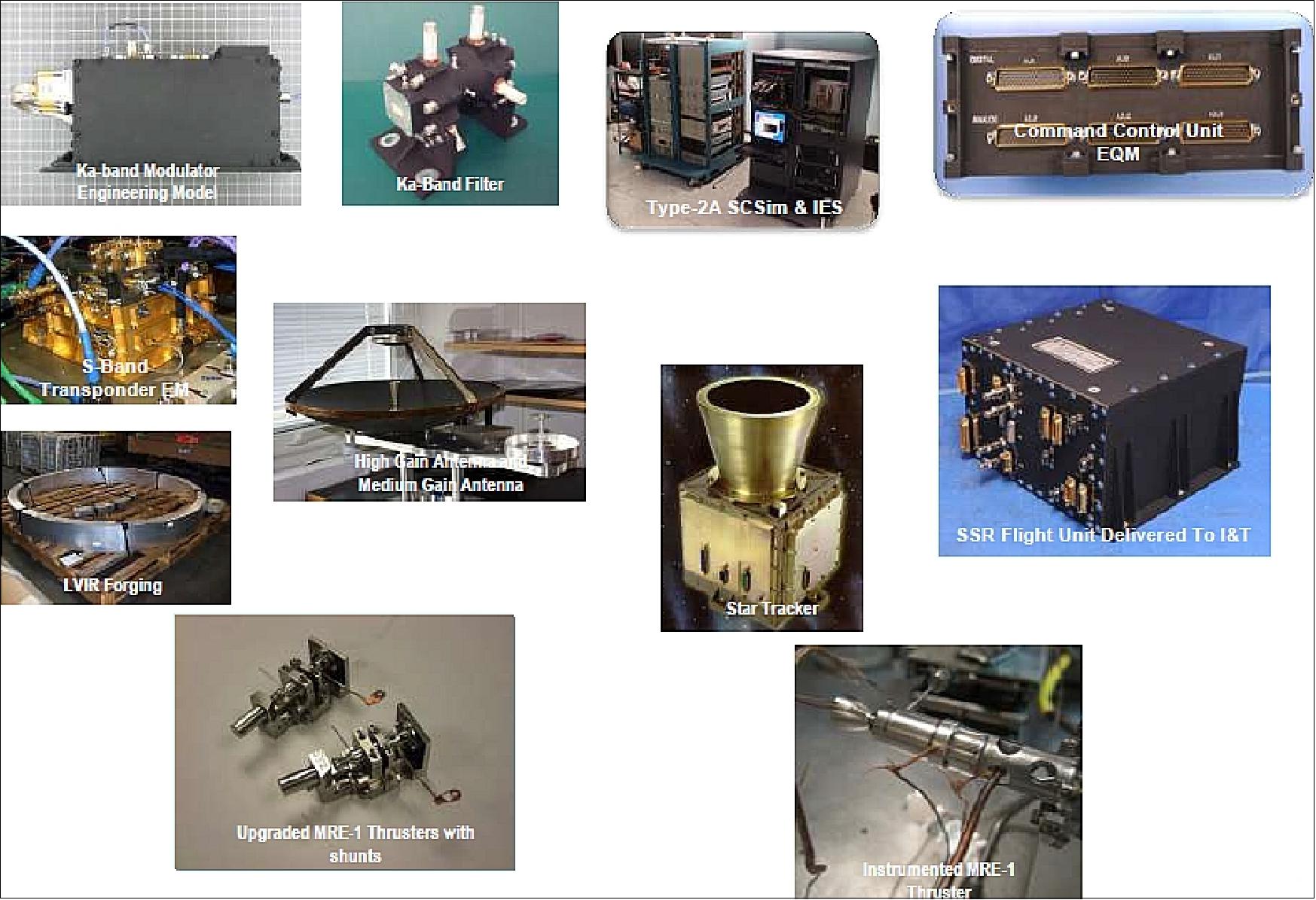
RF communications: JWST will be using CCTS (Common Command and Telemetry System), a modified multimission COTS system of Northrop Grumman which is based on Raytheon's ECLIPSE product line (Raytheon was responsible for developing this system for Northrop Grumman. ECLIPSE is a commercial off-the-shelf command and telemetry product that is configured to support both satellite flight operations and integration and test for JWST. 155)
Onboard storage is provided by a solid-state recorder with a capacity of 58.9 GB (manufacturer: SEAKR Engineering, Inc.). Operating like a digital video recorder, the spacecraft flight unit records all science data together with continuous engineering "state of health" telemetry for the entire observatory 24 hours a day, seven days a week. The data is downloaded to the ground station when the telescope communicates with Earth during a four-hour window every 12 hours. 156)
A high gain antenna provides Ka-band and S-band communications. The Ka-band downlink from L2 is used for science data at the selectable rates of 7, 14, or 28 Mbit/s. A pair of omni-directional antennas (S-band) provide near hemispherical coverage for emergency communications. The S-band nominal downlink is 40 kbit/s and the uplink is 16 kbit/s.
Note: Unlike Hubble, JWST was never meant to be repaired. But in May 2007, NASA announced that it is considering installing a grapple attachment anyway, just to be safe.
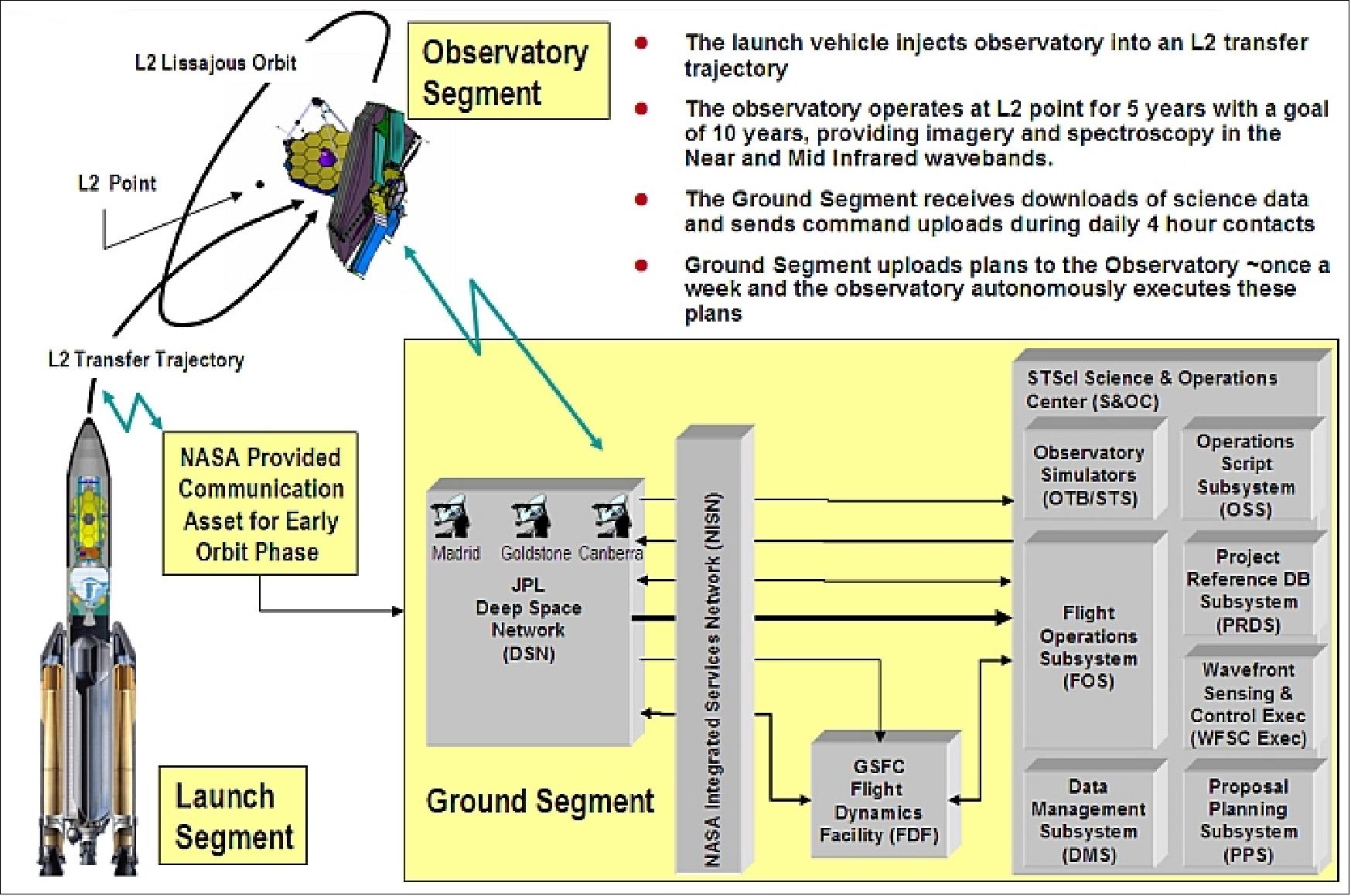
JWST Sunshield
The sunshield provides a very stable passively cooled cryogenic environment to the OTE and ISIM instrumentation - taking full advantage of the steady thermal conditions of the JWST halo orbit at L2. Thermal stability is further enhanced by the two-chord fold architecture of the primary mirror. The folding architecture allows simple thermal straps across the hinge lines and results in a uniform temperature distribution on the primary mirror structure. With these features, the observatory can maintain its optical performance and optical stability for any pointing within its FOR (Field of Regard) without relying on active thermal control or active wavefront control. The sunshield deployment concept is based on Northrop Grumman's precision antenna mesh system. 158) 159)
The FOR (Field of Regard) is the region of the sky in which observations can be conducted safely at a given time. For JWST, the FOR is a large annulus that moves with the position of the Sun and covers about 40% of the sky at any time. This coverage is lower than the ~80% that is accessible by Hubble. The FOR, as is shown in Figure 104, allows one to observe targets from 85º to 135º of the Sun. Most astronomical targets are observable for two periods separated by 6 months during each year. The length of the observing window varies with ecliptic latitude, and targets within 5º of the ecliptic poles are visible continuously, and provides 100% accessibility of the sky during a year period. The sunshield permits the observatory to pitch toward and away from the sun by approximately 68º, while still keeping the telescope in the shade (Figure 105). The continuous viewing zone is important for some science programs that involve monitoring throughout the year and will also be useful for calibration purposes. Outside the continuous viewing zone every area in the sky is observable for at least 100 days per year. The maximum time on target at a given orientation is 10 days.
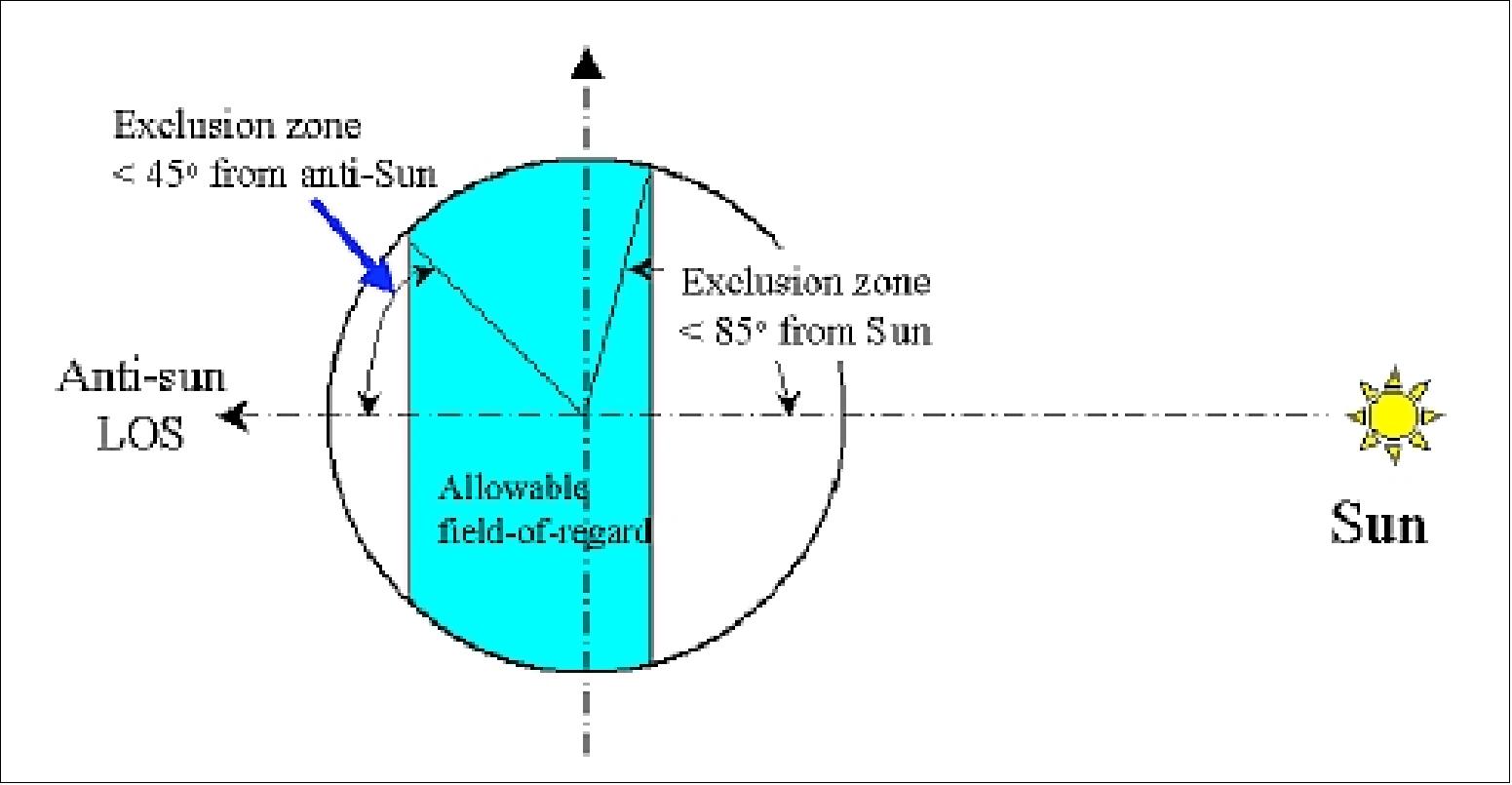
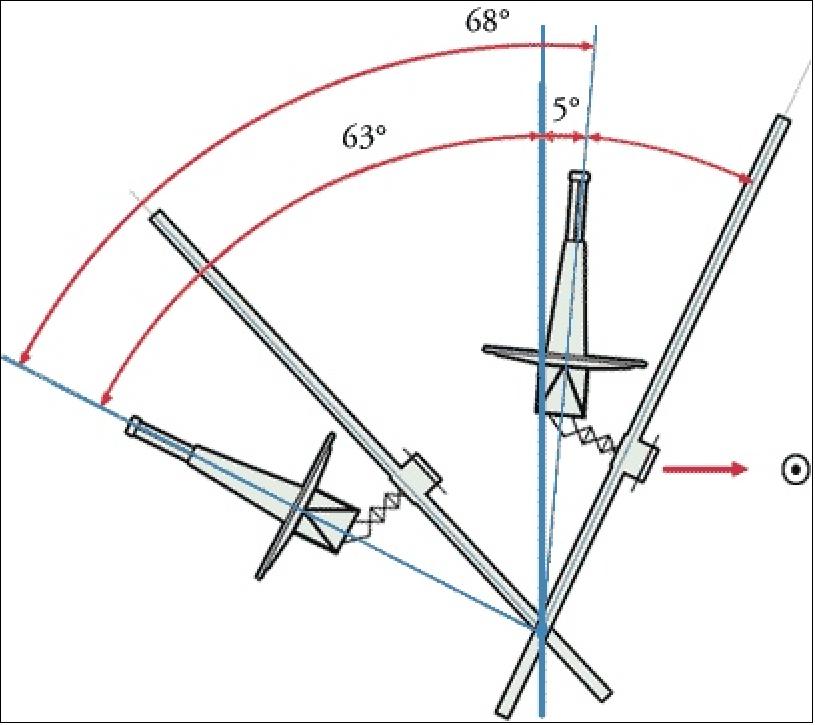
The sunshield has dimensions of about 20 m x 14 m providing ample shielding from light of the sun and the Earth. The sunshield provides a 5 layer, "V" groove radiator design of lightweight reflecting material. It reduces the 300 kW of radiation it receives from the sun on its sunward side, to a mere 23 mW (milliwatt) at the back, sufficient to sustain a 300 K temperature drop from front to back. With a back sunshield temperature of ~ 90 K, the primary mirror, the optical truss, and the instrument payload can radiate their heat to space (at 2.7 K) and reach cryogenic temperatures of 30-50 K. These low temperatures and the total blocking of direct or reflected sunlight are crucial to the scientific success of JWST. 160)
The five sunshield layers of ultra-thin membrane are constructed from DuPont Kapton® E. The first layer, at the hot side, is 50.8 µm thick. The remaining four layers are each 25.4 µm thick, similar in thickness to a human hair. The membranes use a vapor-deposited aluminum coating to produce a highly reflective surface and can sustain a 300 K temperature drop. Z-folded at launch, the sunshield will be signaled to begin deploying two days into launch, as the spacecraft heads toward its orbit. 161)
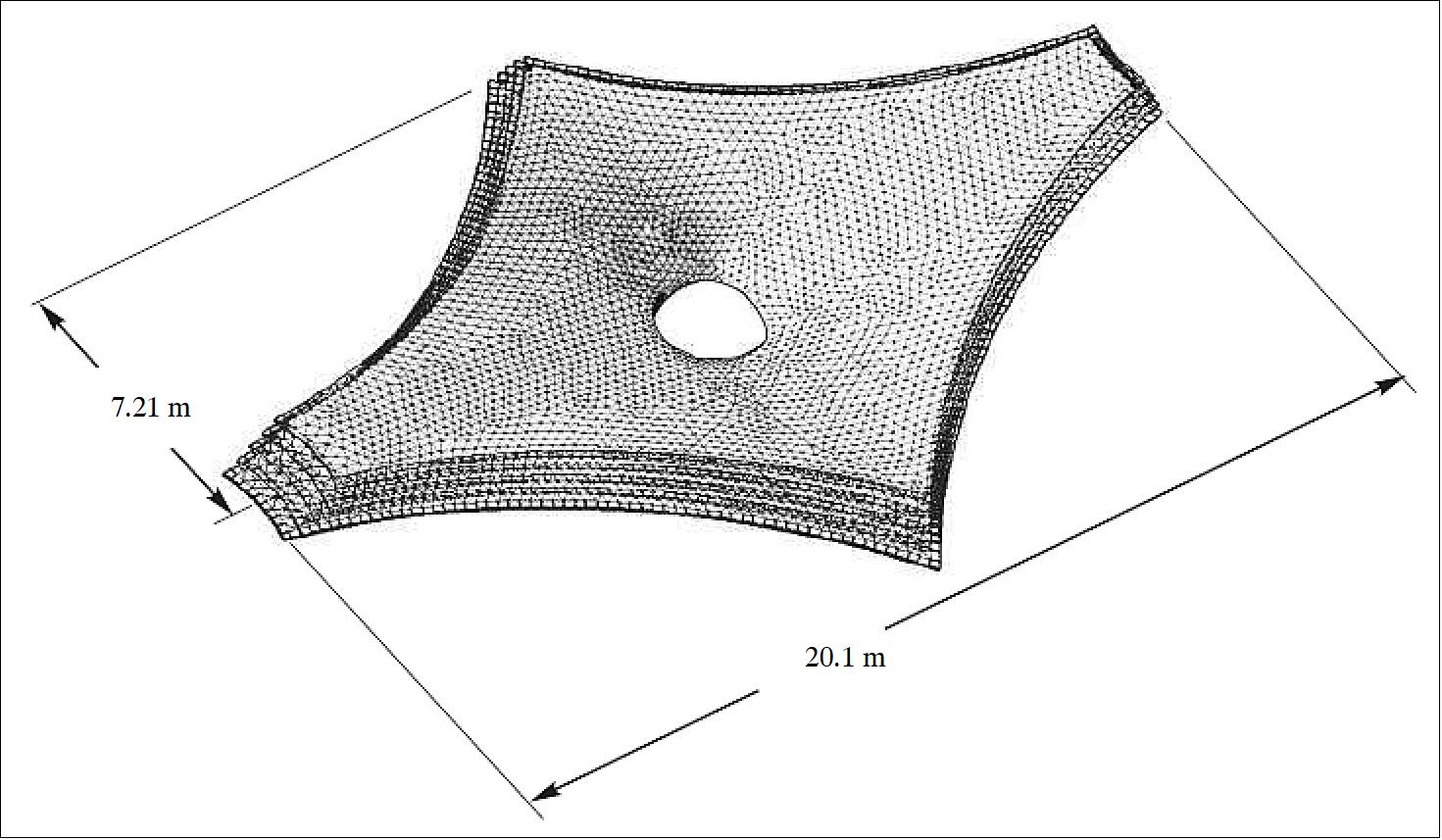
Historically, membranes have been designed to induce a biaxial-tension stress state, thus guaranteeing that wrinkles do not form. The large-scale geometry of the JWST sunshield, along with its complex design features, may hinder such a biaxial stress state. Therefore, the ability to accurately predict the response of the membrane becomes critical to mission success. This article addresses the analytical problems involved in meeting those objectives and looks ahead to the challenges remaining in manufacturing the sunshield.
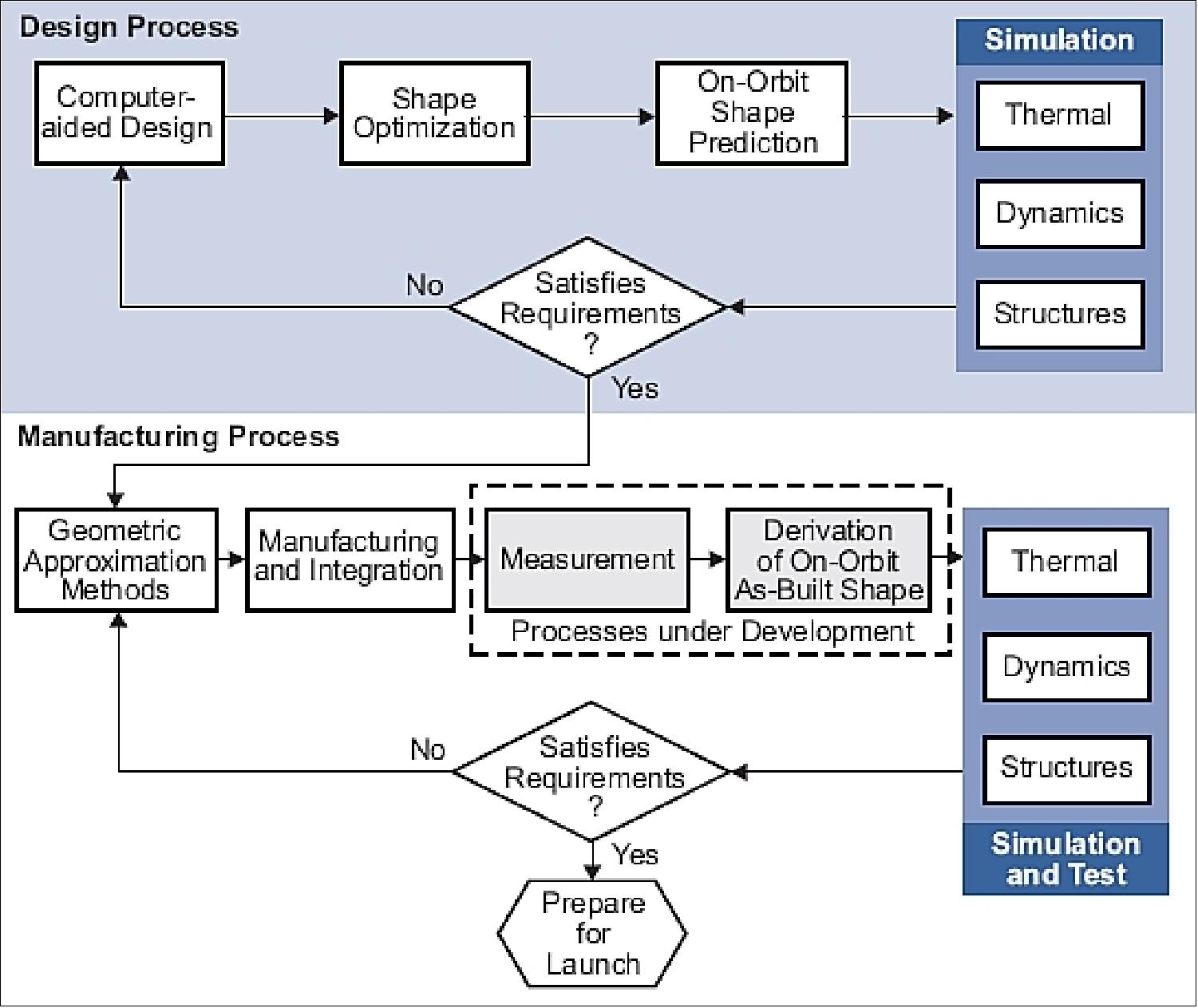
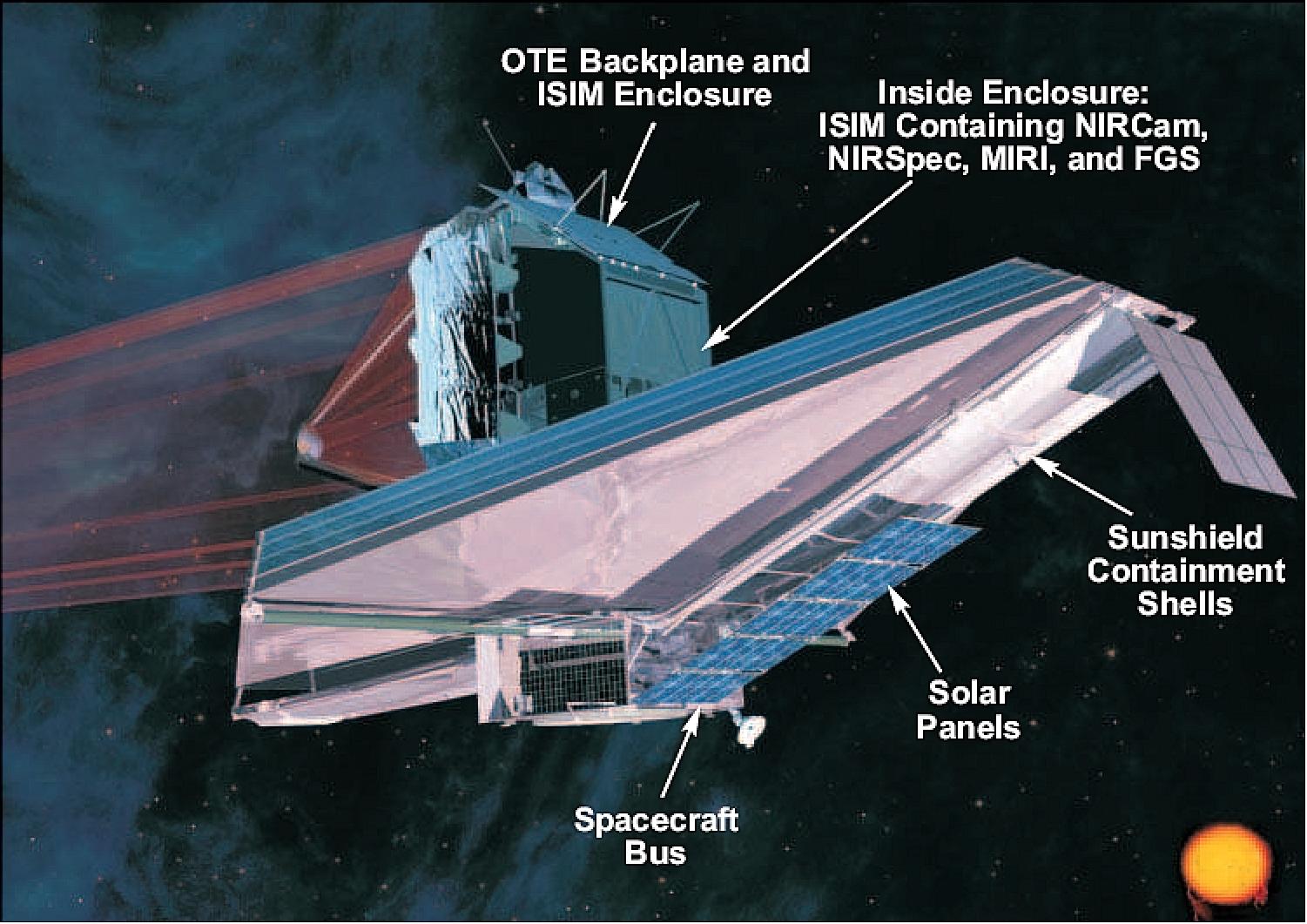
Total mass of spacecraft | ~ 6200 kg, including observatory, on-orbit consumables and launch vehicle adaptor |
Mission duration | 5 years (10 year goal) |
Diameter of primary mirror | 6.5 m |
Clear aperture of primary mirror | 25 m2 |
Primary mirror material | Beryllium |
Mass of primary mirror | 705 kg |
Mass of a single primary mirror segment | 20.1 kg for a single beryllium mirror, 39.48 kg for one entire PMSA (Primary Mirror Segment Assembly) |
Focal length | 131.4 m |
Number of primary mirror segments | 18 |
Optical resolution | ~0.1 arcsecond |
Wavelength coverage | 0.6 - 28 µm |
Size of sunshield | 21.2 m x 14.2 m |
Telescope operating temperature | ~45 K |
Launch vehicle | Ariane 5 ECA (an ESA sponsored flight from Kourou) |
Launch | 2021 |
Introduction of JWST Spinoff Technologies
In the timeframe 2010/12, new technologies developed for NASA's JWST (James Webb Space Telescope) have already been adapted and applied to commercial applications in various industries including optics, aerospace, astronomy, medical and materials. Some of these technologies can be explored for use and licensed through NASA's Office of the Chief Technologist at NASA's Goddard Space Flight Center, Greenbelt, MD. - Note: NASA's JWST is also simply referred to as the Webb. 162) 163)
1) Optics Industry: Telescopes, Cameras and More
The optics industry has been the beneficiary of a new stitching technique that is an improved method for measuring large aspheres. An asphere is a lens whose surface profiles are not portions of a sphere or cylinder. In photography, a lens assembly that includes an aspheric element is often called an aspherical lens.
Stitching is a method of combining several measurements of a surface into a single measurement by digitally combining the data as though it has been "stitched" together.
Because NASA depends on the fabrication and testing of large, high-quality aspheric (nonspherical) optics for applications like the JWST, it sought an improved method for measuring large aspheres. Through SBIR (Small Business Innovation Research) awards from NASA/GSFC, QED Technologies, of Rochester, New York, upgraded and enhanced its stitching technology for aspheres.
QED developed the SSI-A® (Subaperture Stitching Interferometer for Aspheres) metrology technology, which earned the company an "R and D 100" award, and also developed a breakthrough machine tool called the aspheric stitching interferometer. The equipment is applied to advanced optics in telescopes, microscopes, cameras, medical scopes, binoculars, and photolithography.
2) Aerospace and Astronomy
In the aerospace and astronomy industries, the JWST program gave 4D Technology its first commercial contract to develop the PhaseCam interferometer system, which measures the quality of the JWST telescope's mirror segments in a cryogenic vacuum environment. This is a new way of using interferometers in the aerospace sector.
• The PhaseCam interferometer verified that the surfaces of the JWST telescope's mirror segments were as close to perfect as possible, and that they will remain that way in the cold vacuum of space. To test the Webb mirror segments, they were placed in a "cryovac" environment, where air is removed by a vacuum pump and temperatures are dropped to the extreme cold of deep space that the space craft will experience. A new dynamic interferometric technique with very short exposures that are not smeared by vibration was necessary to perform these measurements to the accuracy required, particularly in the high-vibration environment caused by the vacuum chamber's pumps. - The interferometer resulting from this NASA partnership can be used to evaluate future mirrors that need to be tested in vacuum chambers where vibration is a problem.
• Restoring Hubble: Integrated circuits used in camera repair. Webb investments in cryogenic ASICs (Application-Specific Integrated Circuits) led to the development of the ASICs that are now flying on the Hubble Space Telescope. This is a unique example of "future heritage": a program in development (Webb) invented a technology for a program well into the operations phase (Hubble). Webb's investments into this technology allowed the ASICs to be programmable, which was important in the repair of Hubble's Advanced Camera for Surveys that has produced stunning views of our universe.
• Astronomical Detectors: The benefits of the near-infrared detectors developed for Webb's instruments have already spread far and wide in the world of science. "Infrared sensors based on the technology developed for Webb are now the universal choice for astronomical observations, both from space and the ground," said Dr. James Beletic, Senior Director at Teledyne. This technology is also being used for Earth science and national security missions. An early pathfinder version of Webb's HAWAII-2RG 4 Megapixel array has been used in several NASA missions including Hubble, Deep Impact/EPOXI, WISE, and the OCO-2 (Orbiting Carbon Observatory-2), and the HAWAII-2RG is already in use at dozens of ground-based observatories around the world. The availability of these high-performance detectors developed for Webb has been critical to a breathtaking collection of missions, both present and future (Ref. 163).
3) Medical Industry: Eye Health
New "wavefront" optical measurement devices and techniques were created for making the JWST telescope mirrors. Those have led to spinoffs in the medical industry where precise measurements are critical in eye health, for example.
• The technology came about to accurately measure the JWST primary mirror segments during manufacturing. Scientists at AMO WaveFront Sciences, LLC of Albuquerque, N.M. developed a new "wavefront" measurement device called a Scanning Shack Hartmann Sensor.
• The optical measuring technology developed for the JWST, called "wavefront sensing" has been applied to the measurement of the human eye and allowed for significant improvements.
• "The Webb telescope program has enabled a number of improvements in measurement of human eyes, diagnosis of ocular diseases and potentially improved surgery," said Dan Neal, Director of Research and Development AMO (Abbott Medical Optics Inc.) in Albuquerque, N.M. The Webb improvements have enabled eye doctors to get much more detailed information about the shape and "topography" of the eye in seconds rather than hours.
4) Materials Industry: Measuring Strength
The JWST technologies have opened the door to better measurement in testing the strength of composite materials. Measuring strain in composite materials is the same as measuring how much they change in certain environments. Measuring step heights allows one to understand very small changes in a surface profile and doing all of this at high speed allows the device to work even in the presence of vibration that would normally blur the results.
"Technology developed for the Webb telescope has also helped 4D Technologies, Inc. to develop unique technology to measure strain in composite materials, to measure step heights in precision machined surfaces, and for high speed wavefront detection," said James Millerd, President, 4D Technology Corporation, Tucson, AZ.
The Webb telescope technologies have also been beneficial to the economy. The technologies have enabled private sector companies such as 4D to generate significant revenue and create high-skill jobs. Much of 4D's growth from a two man start-up to over 35 people can be traced to projects originally developed for the telescope. 4D has also been able to adapt these technologies for a wide range of applications within the astronomy, aerospace, semiconductor and medical industries.
References
1) "The James Webb Space Telescope," NASA homepage, URL: http://www.jwst.nasa.gov/
2) P. A. Sabelhaus, J. Decker, "James Webb Space Telescope (JWST) Project Overview," Proceedings of the 2006 IEEE/AIAA Aerospace Conference, Big Sky, MT, USA, March 4-11, 2006
3) JWST Project History of STScI (Space Telescope Science Institute) URL: http://www.stsci.edu/jwst/overview/history/index_html
4) http://www.jwst.nasa.gov/science.html
5) Jonathan P. Gardner, John C. Mather, Mark Clampin, Rene Doyon, Matthew A. Greenhouse, Heidi B. Hammel, John B. Hutchings, Peter Jakobsen, Simon J. Lilly, Knox S. Long, Jonathan I. Lunine, Mark J. Mccaughrean, Matt Mountain, John Nella, George H. Rieke, Marcia J. Rieke, Hans-Walter Rix, Eric P. Smith, George Sonneborn, Massimo Stiavelli, H. S. Stockman, Rogier A. Windhorst, Gillian S. Wright, "The James Webb Space Telescope," Space Science Reviews, Vol. 123, No 4, April 2006, pp. 485-606, URL: http://link.springer.com/content/pdf/10.1007%2Fs11214-006-8315-7.pdf
6) http://webbtelescope.org/webb_telescope/
7) http://www.esa.int/esaSC/120370_index_0_m.html
8) http://sci.esa.int/science-e/www/area/index.cfm?fareaid=29
9) http://www.asc-csa.gc.ca/eng/satellites/jwst/default.asp
10) http://www.stsci.edu/jwst/
11) http://www.stsci.edu/jwst/operations
12) "James Webb Space Telescope JWST Sensitivity," STScI, URL: http://www.stsci.edu/jwst/science/sensitivity
13) Jason&Kalirai, "Frontier Science Opportunities with JWST," STScI, June 6-8, 2011, URL: http://www.stsci.edu/jwst/doc-archive/white-papers/fronter-science-opportunites-with-jwst.pdf
14) "Ariane5 goes down in history with successful launch of Webb," Ariane Group Press Release, 25 December 2021, URL: https://www.ariane.group/en/news/ariane-5-goes-down-in-history-with-successful-launch-of-webb/
15) "Liftoff in images: Webb on Ariane 5," ESA Science & Exploration, 25 December 2021, URL: https://www.esa.int/Science_Exploration/Space_Science/Liftoff_in_images_Webb_on_Ariane_5
16) "NASA's Webb Telescope Launches to See First Galaxies, Distant Worlds," NASA Press Release 21-175, 25 December 2021, URL: https://www.nasa.gov/press-release/nasas-webb-telescope-launches-to-see-first-galaxies-distant-worlds
17) "Webb launch campaign highlights," ESA Science & Exploration, 26 December 2021, URL: https://www.esa.int/ESA_Multimedia/Videos/2022/01/Webb_launch_campaign_highlights
18) http://www.stsci.edu/jwst/overview/design/deployment.html
19) "James Webb Space Telescope Deployment," STScI, URL: http://www.stsci.edu/jwst/overview/design/deployment
20) "NASA Reveals Webb Telescope's First Images of Unseen Universe," NASA/JPL News, 12 July 2022, URL: https://www.jpl.nasa.gov/news/nasa-reveals-webb-telescopes-first-images-of-unseen-universe?utm_source=iContact&utm_medium=email&utm_campaign=nasajpl&utm_content=LatestNews-Webb-20220712
21) "First images from Webb telescope reveal unseen Universe," ESA Science & Exploration, 12 July 2022, URL: https://www.esa.int/Science_Exploration/Space_Science/Webb/First_images_from_Webb_telescope_reveal_unseen_Universe
22) "NASA's Webb Captures Dying Star's Final ‘Performance' in Fine Detail," Webb Telescope News Release ID:2022-033, 12 July 2022, URL: https://webbtelescope.org/contents/news-releases/2022/news-2022-033.html
23) "Webb captures dying star's final ‘performance' in fine detail," ESA Science & Exploration, 12 July 2022, URL: https://www.esa.int/Science_Exploration/Space_Science/Webb/Webb_captures_dying_star_s_final_performance_in_fine_detail
24) "First Images from the James Webb Space Telescope," NASA JWST, 11 July 2022, URL: https://www.nasa.gov/webbfirstimages
25) "Webb delivers deepest image of Universe yet," ESA Science & Exploration, 12 July 2022, URL: https://www.esa.int/Science_Exploration/Space_Science/Webb/Webb_delivers_deepest_image_of_Universe_yet
26) "NASA's Webb Sheds Light on Galaxy Evolution, Black Holes," NASA, Webb First Images, 12 July 2022, URL: https://www.nasa.gov/image-feature/goddard/2022/nasa-s-webb-sheds-light-on-galaxy-evolution-black-holes
27) "Webb sheds light on galaxy evolution, black holes," ESA Science & Exploration, 12 July 2022, URL: https://www.esa.int/Science_Exploration/Space_Science/Webb/Webb_sheds_light_on_galaxy_evolution_black_holes
28) Rob Garner, "NASA's Webb Reveals Steamy Atmosphere of Distant Planet in Detail," Webb First Images, 12 July 2022, URL: https://www.nasa.gov/image-feature/goddard/2022/nasa-s-webb-reveals-steamy-atmosphere-of-distant-planet-in-detail
29) "Webb reveals steamy atmosphere of distant planet in exquisite detail," ESA Science & Exploration, 12 July 2022, URL: https://www.esa.int/Science_Exploration/Space_Science/Webb/Webb_reveals_steamy_atmosphere_of_distant_planet_in_exquisite_detail
30) "NASA Shares List of Cosmic Targets for Webb Telescope's First Images," NASA News Release, 8 July 2022, URL: https://tinyurl.com/3nhsp6b7
31) Alise Fisher, "NASA's Webb Telescope NIRSpec Instrument Ready for Science," NASA JWST, 7 July 2022, URL: https://blogs.nasa.gov/webb/2022/07/07/nasas-webb-telescope-nirspec-instrument-ready-for-science/
32) Thaddeus Cesari, Patrick Lynch, "Webb's Fine Guidance Sensor Provides a Preview," NASA JWST, 6 July 2022, URL: https://blogs.nasa.gov/webb/2022/07/06/webbs-fine-guidance-sensor-provides-a-preview/
33) "NASA's Webb to Uncover Riches of the Early Universe," Webb Space Telescope, Press Release 2022-015, 22 June 2022, URL: https://webbtelescope.org/contents/news-releases/2022/news-2022-015.html
34) "First Images From NASA's Webb Space Telescope Coming Soon," NASA Feature, 1 June 2022, URL: https://www.nasa.gov/feature/goddard/2022/first-images-from-nasa-s-webb-space-telescope-coming-soon
35) "Geology from 50 Light-Years: Webb Gets Ready to Study Rocky Worlds," Webb Telescope News, 26 May 2022, URL: https://webbtelescope.org/contents/news-releases/2022/news-2022-017.html
36) Thaddeus Cesari, "Examining the Heart of Webb: The Final Phase of Commissioning," NASA James Webb Space Telescope, 5 May 2022, URL: https://blogs.nasa.gov/webb/2022/05/05/examining-the-heart-of-webb-the-final-phase-of-commissioning/
37) Thaddeus Cesari, "NASA's Webb In Full Focus, Ready for Instrument Commissioning," NASA Webb, 28 April 2022, URL: https://blogs.nasa.gov/webb/2022/04/28/nasas-webb-in-full-focus-ready-for-instrument-commissioning/
38) "Webb in full focus," ESA Science & Exploration, 28 April 2022, URL: https://www.esa.int/About_Us/Week_in_images/Week_in_images_25-29_April_2022
39) "Webb Telescope's Coldest Instrument Reaches Operating Temperature," NASA Feature, 13 April 2022, URL: https://www.nasa.gov/feature/jpl/webb-telescope-s-coldest-instrument-reaches-operating-temperature
40) "Webb's coldest instrument reaches operating temperature," ESA Science & Exploration, 13 April 2022, URL: https://www.esa.int/Science_Exploration/Space_Science/Webb/Webb_s_coldest_instrument_reaches_operating_temperature
41) "Webb's instruments: meet MIRI," ESA Science & Exploration, 11 April 2022, URL: https://www.esa.int/ESA_Multimedia/Videos/2022/04/Webb_s_instruments_meet_MIRI
42) Thaddeus Cesari, "Webb Completes First Multi-Instrument Alignment," NASA Webb, 1 April 2022, URL: https://blogs.nasa.gov/webb/2022/04/01/webb-completes-first-multi-instrument-alignment/
43) "NASA's Webb Reaches Alignment Milestone, Optics Working Successfully," NASA Press Release 22-024, 16 March 2022, URL: https://www.nasa.gov/press-release/nasa-s-webb-reaches-alignment-milestone-optics-working-successfully
44) "Spectra detectives," ESA Science & Exploration, 11 March 2022, URL: https://www.esa.int/ESA_Multimedia/Videos/2022/03/Spectra_detectives
45) Alise Fisher, "Checking Out the Mechanisms in Webb's NIRSpec Instrument," NASA Webb, 3 March 2022, URL: https://blogs.nasa.gov/webb/2022/03/03/checking-out-the-mechanisms-in-webbs-nirspec-instrument/
46) Alise Fisher, "Webb Mirror Alignment Continues Successfully," NASA Webb, 25 February 2022, URL: https://blogs.nasa.gov/webb/2022/02/25/webb-mirror-alignment-continues-successfully/
47) "Webb sees its first star - 18 times," ESA Science & Exploration, 11 February 2022, URL: https://www.esa.int/Science_Exploration/Space_Science/Webb/Photons_received_Webb_sees_its_first_star_18_times
48) Alise Fisher, "Photons Received: Webb Sees Its First Star – 18 Times," NASA Webb, 11 February 2022, URL: https://blogs.nasa.gov/webb/
49) Alise Fisher, "Following Webb's Arrival at L2, Telescope Commissioning Set to Begin," NASA Webb, 31 January 2022, URL: https://blogs.nasa.gov/webb/2022/01/31/following-webbs-arrival-at-l2-telescope-commissioning-set-to-begin/
50) Alise Fisher, "Orbital Insertion Burn a Success, Webb Arrives at L2," NASA JWST, 24 January 2022, URL: https://blogs.nasa.gov/webb/2022/01/24/orbital-insertion-burn-a-success-webb-arrives-at-l2/
51) Alise Fisher, "Webb Begins Its Months-Long Mirror Alignment," NASA JWST, 12 January 2022, URL: https://blogs.nasa.gov/webb/2022/01/12/webb-begins-its-months-long-mirror-alignment/
52) "NASA's Webb Telescope Reaches Major Milestone as Mirror Unfolds," NASA Press Release 22-004, 8 January 2022, URL: https://www.nasa.gov/press-release/nasa-s-webb-telescope-reaches-major-milestone-as-mirror-unfolds
53) "MIRI Instrument Marks a First Milestone in Space," NASA JWST, 5 January 2022, URL: https://blogs.nasa.gov/webb/2022/01/05/miri-instrument-marks-a-first-milestone-in-space/
54) "Secondary Mirror Deployment Confirmed," NASA James Webb Space Telescope, 5 January 2022, URL: https://blogs.nasa.gov/webb/2022/01/05/secondary-mirror-deployment-confirmed/
55) "Sunshield Successfully Deploys on NASA's Next Flagship Telescope," NASA Press Release 22-002, 4 January 2022, URL: https://www.nasa.gov/press-release/sunshield-successfully-deploys-on-nasa-s-next-flagship-telescope
56) "Webb sunshield fully deployed," ESA News, 5 January 2022, URL: https://www.esa.int/Newsroom/Webb_sunshield_fully_deployed
57) Jeff Foust, "JWST begins sunshield tensioning," SpaceNews, 4 January 2022, URL: https://spacenews.com/jwst-begins-sunshield-tensioning/
58) Karen Fox, "NASA Says Webb's Excess Fuel Likely to Extend its Lifetime Expectations," NASA Webb, 29 December 2021, URL: https://blogs.nasa.gov/webb/2021/12/29/nasa-says-webbs-excess-fuel-likely-to-extend-its-lifetime-expectations/
59) Karen Fox, "The First Mid-Course Correction Burn," NASA, 25 December 2021, URL: https://blogs.nasa.gov/webb/2021/12/25/the-first-mid-course-correction-burn/
60) "Best wishes to Webb from space," ESA Science & Exploration, 25 December 2021, URL: https://www.esa.int/ESA_Multimedia/Videos/2021/12/Best_wishes_to_Webb_from_space
61) Maggie Masetti, "The Observatory," NASA, URL: http://www.jwst.nasa.gov/observatory.html
62) John Nella, Charles Atkinson, Allen Bronowicki, Ed Bujanda, Andy Cohen, Don Davies, Martin Mohan, John Pohner, Paul Reynolds, Scott Texter, Debra F. Simmons, Dean Waldie, Rob Woods, Richard Lynch, Ray Lundquist, Mike Menzel, Bob Smith, Pam Sullivan, Paul Atcheson, Paul. Lightsey, "James Webb Space Telescope (JWST) Observatory Architecture and Performance," Space 2004, San Diego, CA, Sept. 28-30, 2004, AIAA-2004-5986
63) J. Nella, P. Atcheson, C. Atkinson, D. Au, M. Blair, A. Bronowicki, D. Fitzgerald, J. Heidenga, P. Lightsey, T. Kelly, G. Matthews, J. Pohner, P. Reynolds, D. Shuckstes, S. Texter, D. Waldie, R. Whitley, "Next Generation Space Telescope (NGST) Observatory Architecture and Performance," Proceedings of SPIE Symposium Astronomical Telescopes and Instrumentation, `Conference IR Space Telescopes and Instruments,' Waikoloa, Hawaii, Aug. 22-28, 2002, Vol. 4850, URL: http://www.stsci.edu/jwst/trw-spie.pdf
64) L. Meza, F. Tung, S. Anandakrishnan, V. Spector, T. Hyde, "Line of Sight Stabilization for the James Webb Space Telescope," Proceedings of the 28th Annual AAS Rocky Mountain Guidance and Control Conference, Breckenridge, CO, USA, Feb. 5-9, 2005, AAS 05-002
65) Jon Arenberg, "JWST Development Status," 213th AAS (American Astronomical Society) Meeting, Long Beach, CA, USA, Jan. 4-8, 2009, URL: http://www.stsci.edu/jwst/externaldocs/presentations/JWST-STScI-000443.pdf
66) Phil Sabelhaus, "Project Status for the James Webb Space Telescope Partner's Workshop," JWST Partner's Workshop, Ottawa, Canada, May 19, 2009, URL: http://www.jwst.nasa.gov/ottawa/012897.PPT
67) Phil Sabelhaus, "James Webb Space Telescope (JWST) Project Status for the AAS Town Hall," January 5, 2010, URL:http://www.stsci.edu/jwst/externaldocs/presentations/AAS_jan2010_townhall_Sabelhaus.pdf
68) Rob Garner, "The James Webb Space Telescope Observatory," NASA, July 28, 2013, URL: http://www.nasa.gov/mission_pages/webb/observatory/index.html#.Uftl4KzODWJ
69) Geoff Yoder, "JWST Program Office," NASA, April 17, 2013, URL: http://science.nasa.gov/media/medialibrary/2013/04/22/secure-YODER-APS_JWST.pdf
70) "The Webb Update #6 - April 2009," URL: http://www.jwst.nasa.gov/newsletter6.html#isim
71) Webb Telescope's Mirrors," URL: http://www.jwst.nasa.gov/mirror.html
72) H. Philip Stahl, "TRL-6 Qualification of JWST Mirror Segments," Mirror Technology SBIR/STTR Workshop, Albuquerque, NM, USA, June 16-18, 2009, URL: http://ntrs.nasa.gov/archive/nasa/casi.ntrs.nasa.gov/20090028784_2009028438.pdf
73) Rob Gutro, "The Amazing Anatomy of James Webb Space Telescope Mirrors," NASA/GSFC, March 20, 2014, URL: http://www.nasa.gov/content/goddard/the-amazing-anatomy-of-james-webb-space-telescope-mirrors/#.Uy7r6M52H5o
74) M. Stiavelli, R. van der Marel, G. Kriss, K. Long, M. Meixner, P. McCullough, K. Flanagan, E. Nelan, M. Regan, H .S. Stockman, J. Valenti, "JWST Primer," Version 2.0, May 2009, URL: http://www.stsci.edu/jwst/doc-archive/handbooks/JWST_Primer_v20.pdf
75) http://www.jwst.nasa.gov/instruments.html
76) Jonathan Kuhn, Tim Carnahan, Andrew Bartoszyk, Steve Hendricks, Charles Kaprielian, Cengiz Kunt, "JWST ISIM Primary Structure and Kinematic Mount Configuration," FEMCI (Finite Element Medeling Continuous Improvement), Workshop, Greenbelt, MD, USA, May 6, 2004, URL: http://femci.gsfc.nasa.gov/workshop/2004/presentations/04_Kuhn/Kuhn_JWST_ISIM.pdf
77) Jamie Dunn, "James Webb Space Telescope Integrated Science Instrument Module Status," JWST Partner's Workshop, Ottawa, Canada, May 19, 2009, URL: http://www.jwst.nasa.gov/ottawa/012901.PPT
78) "James Webb Space Telescope begins to take shape at Goddard," Sept. 15, 2009, URL: http://www.sciencecodex.com/james_webb_space_telescope_begins_to_take_shape_at_goddard
79) JWST Primer," STScI, Verion 1.0, October 2004, URL: http://guaix.fis.ucm.es/~agpaz/Instrumentacion_Espacio_2010/Espacio_Docs/JWST/jwst_primer.pdf
80) Bill Ochs, "James Webb Space Telescope Mission Status," GCA, Dec. 5. 2012, URL: http://www.goddard-contractors-association.org/presentations/12-4-2012%20Bill%20Ochs%20JWST.pdf
81) Matthew Garrison, Keith Parrish, Charles Perrygo, "ISIM Electronics Compartment Design for the James Webb Space Telescope," URL: https://tfaws.nasa.gov/TFAWS06/Proceedings/Thermal%20Systems%20Design/Papers/TFAWS06-1003_Paper_Garrison.pdf
82) http://www.jwst.nasa.gov/isim.html
83) Matt Greenhouse, "James Webb Space Telescope, ISIM Nears Readiness for Space Simulation Testing," NASA, April 2013, URL: http://www.jwst.nasa.gov/resources/WebbUpdate_April2013.pdf
84) Randy Kimble, "ISIM Enters Final Sequence of Pre-Delivery Environmental Tests," NASA Webb Update, Issue No 18, Summer 2015, URL: http://jwst.nasa.gov/resources/WebbUpdate_Summer2015.pdf
85) Marcia Rieke, Stefi Baum, Chas. Beichman, David Crampton, René Doyon, Daniel Eisenstein, Thomas Greene, Klaus-Werner Hodapp, Scott Horner, Doug Johnstone, Larry Lesyna, Simon Lilly, Michael Meyer, Peter Martin, Donald McCarthy, George Rieke, Thomas Roellig, John Stauffer, John Trauger, Erick Young, "NGST NIRCam Scientific Program and Design Concept," Proceedings of SPIE, Vol. 4850, 2003, pp. 478-485, URL: http://ircamera.as.arizona.edu/nircam/spie_latest.pdf
86) http://www.stsci.edu/jwst/instruments/nircam/
87) http://ngst.gsfc.nasa.gov/instruments.html
88) http://ircamera.as.arizona.edu/nircam/
89) John E. Krist, Charles A. Beichman, John T. Trauger, Marcia J. Rieke, Steve Somerstein, Joseph J. Green, Scott D. Horner, John A. Stansberry, Fang Shi, Michael R. Meyer, Karl R. Stapelfeldt, Thomas L. Roellig, "Hunting Planets and Observing Disks with the JWST NIRCam Coronagraph," SPIE Optics and Photonics Conference, San Diego, CA, USA, Aug. 26-30, 2007, URL: https://web.archive.org/web/20170721192936/http://ircamera.as.arizona.edu:80/nircam/nircam_coronagraph_spie_2007.pdf
90) Larry G. Burriesci, "NIRCam Instrument Overview," URL: http://ircamera.as.arizona.edu/nircam/materials/SPIE_Aug05/5904-3_Burriesci.pdf
91) E. T. Young, M. J. Rieke, D. N. B. Hall, J. Garnett, M. Loose, A. Magoncelli, G. Winters, "Detectors for the NIRCam Instrument on JWST," AAS (American Astronomical Society) 207th Meeting, Jan. 8-12, 2006, Washington, D.C., paper 115.11
92) "Near Infrared Camera (NIRCam)," URL: http://www.jwst.nasa.gov/nircam.html
93) "NIRCam's Optical System Excels In Integrated Tests For James Webb Telescope," Lockheed Martin, Jan. 6, 2015, URL: http://www.lockheedmartin.com/us/news/press-releases/2015/january/space-nircam.html
94) "Near-Infrared Spectrograph (NIRSpec)," STScI, URL: http://www.stsci.edu/jwst/instruments/nirspec
95) P. Jakobsen, S. Arribas , T. Boeker, A. Bunker, S. Charlot, D. Crampton, P. Ferruit, M. Franx, R. Maiolino, G. de Marchi, H. Moseley, B. Rauscher, M. Regan, H.-W. Rix, J. Valenti, "NIRSpec - Near-IR Multi-Object Spectrograph for JWST," AAS 207th Meeting, Jan. 8-12, 2006, Washington, D.C., paper 115.13
96) S. Arribas, T. Boeker, A. Bunker, S. Charlot, D. Crampton, P. Ferruit, M. Franx, P. Jakobsen, R. Maiolino, G. de Marchi, H. Moseley, B. Rauscher , M. Regan, H-W. Rix, J. Valenti , "The Integral Field Unit of the NIRSpec Spectrograph for JWST," AAS 207th Meeting, Jan. 8-12, 2006, Washington, D.C., paper 115.15
97) NIRSpec Instrument Engineering Test Unit model is completed," ESA, Oct. 14, 2009, URL: http://sci.esa.int/science-e/www/object/index.cfm?fobjectid=45740
98) S. H. Moseley, R. Arendt, R. A. Boucarut, T. Hadjimichael, M. Jhabvala, T. King, G. Kletetschka, A. S. Kutyrev, M. Li, D. Rapchun, R. F. Silverberg, "Microshutter Arrays for JWST NIRSpec," AAS 207th Meeting, Jan. 8-12, 2006, Washington, D.C., paper 5.07
99) Peter Jakobsen, "NIRSpec - The Near-IR Multi Object Spectrograph on JWST," Oct. 22, 2007, URL: http://www.stsci.edu/jwst/instruments/nirspec/docarchive/NIRSpec_Jakobsen.pdf
100) R. Geyl, E. Ruch, H. Vayssade, H. Leplan, J. Rodolfo, "NIRSpec Optics Development – Final Report," Proceedings of ICSO 2010 (International Conference on Space Optics), Rhodes, Greece, Oct. 4-8, 2010, URL: http://www.congrexprojects.com/custom/icso/Papers/Session%2012a/FCXNL-10A02-2017303-1-ICSO_Geyl_NIRSpec%20optics%20development_v2.pdf
101) R. Silverberg, K. A. Blumenstock, A. Ewin, J. Hein, C. Kotecki, M. J. Li, J. Loughlin, S. Manthripragada, S. H. Moseley, D. B. Mott, D. S. Schwinger, R. Wesenberg, R. K. Fettig, D. E. Franz, A. S. Kutyrev, A. J. Bier, T. C. Chen, D. A. Rapchun, Y. Zheng, C. Zincke, "Microshutter Arrays for the NGST Near-Infrared Multi-Object Spectrometer," Sofia/USRA Workshop on Far-IR, Sub-mm&mm Detector Technology, Monterey, CA, April 1-3, 2002, URL: http://www.sofia.usra.edu/det_workshop/papers/session6/6-05silverberg_edjw021115.pdf
102) B. Mott, T. Böker, C. Cabelli, G. De Marchi, P. Ferruith, J. Garnett, R. J. Hill, M. Loose, B. J. Rauscher, M. W. Regan, A. Waczynski, Y. Wen, S. Wong, M. Zandian, D. Alexander, C. K. Brambora, R. Derro, C. Dunn, T. Ellis, M. B. Garrison, B. Howe, P. Jakobsen, T. E. Johnson, M. Jurado, G. Lee, S. S. Manthripragada, J. M. Marsh, C. Marshall, R. J. Martineau, J. Nieznanski, W. D. Roher, K. B. Shakoorzadeh, M. T. Smith, P. Strada, P. Wallis, W. Xia-Serafino, J. R. York, "Large Format HgCdTe Arrays for the James Webb Space Telescope," IEEE LEOS (Lasers & Electro-Optics Society) Newsletter, Vol. 20, No 5, Oct. 2006, pp. 41-42, URL: http://photonicssociety.org/newsletters/oct06/41-42.pdf
103) Jacques Rodilfo, "Polishing, coating and integration of SiC mirrors for space telescopes," Proceedings of the 7th ICSO (International Conference on Space Optics) 2008, Toulouse, France, Oct. 14-17, 2008
104) Thomas Leikert, Torsten Gross, Hans-Ulrich Wieland, Kai Weidlich, "Alignment and Testing of the NIRSpec Filter and Grating Wheel Assembly," Proceedings of the 14th European Space Mechanisms & Tribology Symposium – ESMATS 2011, Constance, Germany, Sept. 28–30 2011 (ESA SP-698), URL: http://www.esmats.eu/esmatspapers/pastpapers/pdfs/2011/leikert.pdf
105) http://ngst.gsfc.nasa.gov/microshutters.html
106) S. H. Moseley, R. A. Arendt, R. A. Boucarut, M. Jhabvala, T. King, G. Kletetschka, A. S. Kutyrev, M. Li, S. E. Meyer, D. Rapchun, R. F. Silverberg, "Microshutter arrays for the JWST near-infrared spectrometer," Proceedings of the SPIE, `Optical, Infrared, and Millimeter Space Telescopes,' Vol. 5487, Glasgow, Scotland, UK, June 21-25, 2004, pp. 645-652, doi: 10.1117/12.552431, J. C. Mather, Editor, October 2004
107) "Low light test on micro-shutter array," ESA, Sept. 5, 2014, URL: http://www.esa.int/Highlights/Week_In_Images_01_05_September_2014
108) "NASA Engineers Conduct Low Light Test on New Technology for Webb Telescope," NASA, Sept. 4, 2014, URL: http://www.nasa.gov/content/goddard/nasa-engineers-conduct-low-light-test-on-new-technology-for-webb-telescope/#.VBBEn6NmP5p
109) Lori Keesey, "Revolutionary Microshutter Technology Hurdles Significant Challenges," NASA, July 29, 2014, URL: http://www.nasa.gov/content/goddard/revolutionary-microshutter-technology-hurdles-significant-challenges/
110) Matthias Funke, Ralf Ehrenwinkler, Michael Jentsch, Delphine Jollet, "Highly critical exchange of primary structure parts at the fully integrated NIRSpec-instrument for JWST," Proceedings of the13th European Conference on Spacecraft Structures, Materials & Environmental Testing (SSMET), Braunschweig, Germany, April 1-4, 2014, ESA SP-727
111) "The NIRSpec instrument is prepped for Micro-Shutter Array and Focal Plane Assembly replacement," NASA, July 20, 2015, URL: http://svs.gsfc.nasa.gov/cgi-bin/details.cgi?aid=11962
112) "Improved vision for the James Webb Space Telescope," ESA, Feb. 25, 2015, URL: http://www.esa.int/Our_Activities/Space_Science/Improved_vision_for_James_Webb_Space_Telescope
113) "#07: Summer 2014 - first combined test of all four instruments," JWST, ESA, Feb. 24, 2015, URL: http://sci.esa.int/jwst/55427-07-summer-2014-first-combined-test-of-all-four-instruments/
114) "#08: New detectors and microshutters for NIRSpec," ESA Feb. 25, 2015, URL: http://sci.esa.int/jwst/55459-08-new-detectors-and-micro-shutters-for-nirspec/
115) "NIRSpec Dances into Place," ESA, April 4, 2014, URL: http://sci.esa.int/jwst/53954-06-nirspec-dances-into-place/
116) "NIRSpec prepared for integration in ISIM," ESA, Feb. 5, 2014, URL: http://sci.esa.int/jwst/53647-nirspec-prepared-for-integration-in-isim/
117) "NIRSpec arrives at NASA Goddard," ESA, Sept. 30, 2013, URL: http://sci.esa.int/jwst/52896-nirspec-arrives-at-nasa-goddard/
118) "ESA completes second instrument for James Webb Space Telesciope," ESA, Sept. 6, 2013, URL: http://www.esa.int/Our_Activities/Space_Science/ESA_completes_second_instrument_for_James_Webb_Space_Telescope
119) http://www.stsci.edu/jwst/instruments/miri/
120) Kimberly Banks, Melora Larson, Cagatay (Murat) Aymergen, Burt Zhang, "James Webb Space Telescope Mid-Infrared Instrument Cooler systems engineering," Proceedings of SPIE, May 26, 2010, Vol. 7017 70170A-10, URL: http://ircamera.as.arizona.edu/MIRI/miricooler.pdf
121) G. S. Wright, G. Rieke, L Colina, E. van Dishoeck, G. Goodson, T. Greene, P. Lagage, A. Karnik, S. Lambros, D. Lemke, M. Meixner, H. Norgaard, G. Oloffson, T. Ray, M. Ressler, C. Waelkens, D. Wright, A. Zhender, "The JWST MIRI instrument concept," URL: http://www.stfc.ac.uk/ukatc/resources/pdf/miri5487-28.pdf
122) http://www.roe.ac.uk/ukatc/consortium/miri/index.html
123) G. H. Rieke, G. S. Wright, "The Mid-Infrared Instrument for JWST," AAS 207th Meeting, Jan. 8-12, 2006, Washington, D.C., paper 115.18
124) Ramón Navarro, Ton Schoenmaker, Gabby Kroes, Ad Oudenhuysen, Rieks Jager, Lars Venema, "JWST-MIRI Spectrometer Main Optics Design and MAIT Results," Proceedings of the 7th ICSO (International Conference on Space Optics) 2008, Toulouse, France, Oct. 14-17, 2008
125) Astrid Heske, Gillian S. Wright, "MIRI on JWST – Challenges in Science, Technology and Partnership," Proceedings of the 2010 IEEE Aerospace Conference, Big Sky, MT, USA, March 6-13, 2010
126) Maggie Masetti, "Mid-Infrared Instrument (MIRI)," NASA, URL: http://www.jwst.nasa.gov/miri.html
127) http://ircamera.as.arizona.edu/MIRI/instrument.htm
128) http://www.roe.ac.uk/ukatc/consortium/miri/index.html
129) M. Wells, G .Hawkins, G. Olofsson, "The Design and Fabrication of Multiple Dichroic Beamsplitters for the MIRI Spectrometer (4.8-29 µm)," Proceedings of SPIE, Vol. 5487, 2004, pp. 794-803
130) P. J. Love, A. W. Hoffman, N. A. Lum, K. J. Ando, N. J. Therrien, J. P. Rosbeck, W. D. Ritchie, R. S. Holcombe, E. Corrales, "1024 x 1024 Si:As IBC detector arrays for JWST MIRI," Proceedings of SPIE Optics and Photonics Conference, `Optical Engineering and Instrumentation,' Vol. 5902, San Diego, CA, July 31-Aug. 4, 2005, paper: 5902-09
131) A. W. Hoffman, P. J. Love, J. P. Rosbeck, "Mega-Pixel Detector Arrays: Visible to 28 µm," Proceedings of SPIE, `Focal plane arrays for space telescopes,' San Diego, CA, Aug. 4-6, 2003, Vol. 5167, (SPIE, Bellingham, WA, 2004)
132) D. Durand, R. Colbert, C. Jaco, M. Michaelian, T. Nguyen, M. Petach, E. Tward, "NGST Advanced Cryocooler Technology Development Program (ACTDP) Cooler System," 14th International Cryocooler Conference (ICC-14), June 14-16, 2006, Annapolis MD, USA URL: http://conferences.library.wisc.edu/index.php/icc14/article/download/4/4
133) R .G. Ross, Jr., "A Study of the Use of 6K ACTDP Cryocoolers for the MIRI Instrument on JWST," 13th International Cryocooler Conference, March 29-April 1, 2004, New Orleans, LA, USA, URL: http://trs-new.jpl.nasa.gov/dspace/bitstream/2014/37865/1/04-0675.pdf
134) D. Durand, D. Adachi, D. Harvey, C. Jaco, M. Michaelian, T. Nguyen, M. Petach, J. Raab, "Mid InfraRed Instrument (MIRI) Cooler Subsystem Design," 15th International Cryocooler Conference, Inc., Long Beach, CA, USA, June 9-12, 2008, URL: http://conferences.library.wisc.edu/index.php/icc15/article/download/181/181
135) "MIRI keeps cool under low pressure," ESA, Feb. 3, 2014, URL: http://sci.esa.int/jwst/53646-miri-keeps-cool-under-low-pressure/
136) MIRI integrated into the James Webb Space Telescope (JWST)," ESA, July 8, 2013, URL: http://sci.esa.int/jwst/52000-journal-01-miri-integrated-into-the-james-webb-space-telescope/
137) Fine Guidance Sensor/Near InfraRed Imager and Slitless Spectrograph (FGS/NIRISS)." NASA, URL: http://www.jwst.nasa.gov/fgs.html
138) "James Webb Space Telescope, FGS - Fine Guidance Sensor," STScI, URL: http://www.stsci.edu/jwst/instruments/fgs/
139) Michael Maszkiewicz, "Near- Infrared Imager and Slitless Spectrograph (NIRISS): a new instrument on James Webb Space Telescope (JWST)," Proceedings of the ICSO (International Conference on Space Optics), Ajaccio, Corsica, France, Oct. 9-12, 2012, paper: ICSO-037, URL: http://congrex.nl/icso/2012/papers/FP_ICSO-037.pdf
140) Fine Guidance Sensors/Near-Infrared Imager and Slitless Spectrograph (FGS/NIRISS)," URL: http://webbtelescope.org/webb_telescope/technology_at_the_extremes/webb_instruments.php
141) Neil Rowlands, Sandra Delamer, Craig Haley, Eric Harpell, Maria B. Vila, Gerry Warner, Julia Zhou, "Cryogenic performance test results for the flight model JWST fine guidance sensor," Proceedings of. SPIE, Vol. 8442, 8442{130 (2012), doi: 10.1117/12.926672
142) Neil Rowlands, "The JWST Fine Guidance Sensor (FGS) Overview and Current Status," Proceedings of the 65th International Astronautical Congress (IAC 2014), Toronto, Canada, Sept. 29-Oct. 3, 2014, paper: IAC-14-A7.2.5
143) René Doyon, John Hutchings, Mathilde Beaulieu, Loic Albert, David Lafrenière, Chris Willott, Driss Touahri, Neil Rowlands, Micheal Maszkiewicz, Alex Fullerton, Kevin Volk, André Martel, Pierre Chayer, Anand Sivaramakrishnan, Roberto Abraham, Laura Ferrarese, Ray Jayawardhana, Doug Johnstone, Micheal Meyer, Judith Pipher, Marcin Sawicki, "The JWST Fine Guidance Sensor (FGS) and Near-Infrared Imager and Slitless Spectrograph (NIRISS)," Proceedings of SPIE, 'Space Telescopes and Instrumentation 2012: Optical, Infrared, and Millimeter Wave,' Vol. 8442, 84422R © 2012 SPIE, doi:10.1117/12.926578
144) "Fine Guidance Sensor/Near InfraRed Imager and Slitless Spectrograph (FGS/NIRISS)," NASA, URL: http://jwst.nasa.gov/fgs.html
145) "James Webb Space Telescope, NIRISS Instrument Design," STScI, URL: http://www.stsci.edu/jwst/instruments/niriss/instrumentdesign
146) Andrew S. Gibson, Ashley McColgan, Johanne C. Heald, Eric Harpell, Mike J. Anderson, Rajeev Sharma, "Overview of Design and Validation of the Fine Guidance Sensor Mechanisms for JWST," Proceedings of the 15th ESMATS (European Space Mechanisms and Tribology Symposium) 2013, Noordwijk, The Netherlands, Sept. 25-27, 2013, ESA, SP-718, URL: http://www.esmats.eu/esmatspapers/pastpapers/pdfs/2013/gibson2.pdf
147) Andrew S. Gibson, Ashley McColgan, Johanne C. Heald, Macso Gentilhomme, Begoña Vila, Zul Dhanji, Mike J. Anderson, Rajeev Sharma, "Life-Test Investigation and Status of the NIRISS Dual Wheel Cryogenic Mechanism for JWST ," Proceedings of the 15th ESMATS (European Space Mechanisms and Tribology Symposium) 2013, Noordwijk, The Netherlands, Sept. 25-27, 2013, ESA, SP-718, URL: http://www.esmats.eu/esmatspapers/pastpapers/pdfs/2013/gibson.pdf
148) Neil Rowlands, Gerry Warner, Charles Berndt, Loic Albert, Pierre Chayer, "Pixel classification for the JWST fine guidance sensor," Proceedings of SPIE, Vol. 8453, 845313 · © 2012 SPIE, doi:10.1117/12.926678
149) "James Webb Space Telescope FGS - Fine Guidance Sensor," August 27, 2015, URL: http://www.stsci.edu/jwst/instruments/fgs
150) "James Webb Space Telescope - Near-InfraRed Imager and Slitless Spectrograph," Feb. 12, 2015, URL: http://www.stsci.edu/jwst/instruments/niriss
151) "Instruments: Fine Guidance Sensor/Near InfraRed Imager and Slitless Spectrograph (FGS/NIRISS)," NASA, URL: http://www.nasa.gov/mission_pages/webb/instruments/FGS.html
152) http://www.jwst.nasa.gov/bus.html
153) D. D. Fitzgerald Simmons, R. C. Smith, "Spacecraft Design to Support a Large Cryogenic Telescope Science Mission Near the Second Lagrange Point of the Earth-Sun System," Space 2004 Conference and Exhibit 28 - 30 September 2004, San Diego, CA, AIAA 2004-5989
154) Mark Clampin, "JWST Observatory Status," NASA, APS July 16-17, 2013, URL: http://science.nasa.gov/media/medialibrary/2013/07/24/Clampin-JWST.pdf
155) "Customized Telemetry System For The James Webb Space Telescope Successful," NASA, Nov. 15, 2007, URL: http://www.nasa.gov/centers/goddard/news/topstory/2007/jwst_telemetry.html
156) "First Spacecraft Flight Recorder for NASA's JWST Delivered to Northrop Grumman," Space Daily, April 11, 2012, URL: http://www.spacedaily.com/reports/First_Spacecraft_Flight_Recorder_for_NASA_JWST_Delivered_to_Northrop_Grumman_999.html
157) "JWST Functional Flow Diagrams and Schematic Block Diagrams," URL: http://spacese.spacegrant.org/uploads/Functional%20Analysis/JWST_FFBD_rev2.ppt
158) "The Sunshield," NASA, URL: http://www.jwst.nasa.gov/sunshield.html
159) James Webb Space Telescope Sunshield," STScI, URL: http://www.stsci.edu/jwst/overview/design/sunshield
160) http://www.stsci.edu/jwst/overview/design/sunshade.html
161) Ryan A. Fellini, Yury L. Kropp, "James Webb Space Telescope Sunshield: Challenges in Analysis of Gossamer Structures," Technology Review Journal, Spring/Summer 2008, URL: http://www.is.northropgrumman.com/about/ngtr_journal/assets/TRJ-2008/SS/08SS_Fellini.pdf
162) Rob Gutro, "JWST Spinoff Technologies Already Seen in Some Industries," NASA, April 18, 2012, URL: http://www.nasa.gov/topics/technology/features/webb-spinoffs.html
163) "Webb Spinoffs," NASA, URL: http://www.jwst.nasa.gov/resources/JWST_spinoffs_v122011.pdf
The information compiled and edited in this article was provided by Herbert J. Kramer from his documentation of: "Observation of the Earth and Its Environment: Survey of Missions and Sensors" (Springer Verlag) as well as many other sources after the publication of the 4th edition in 2002. - Comments and corrections to this article are always welcome for further updates (eoportal@symbios.space).
Concept Launch Mission Status Observatory Sensor Complement Spacecraft Bus and Sunshield
Spinoff Technologies References Back to Top